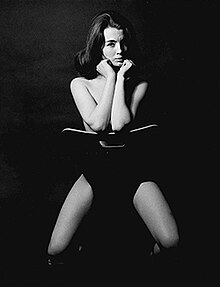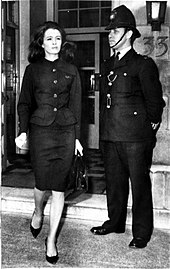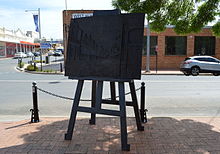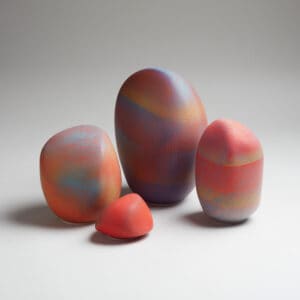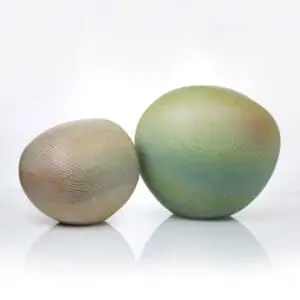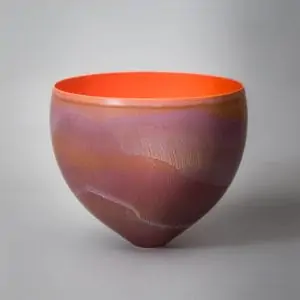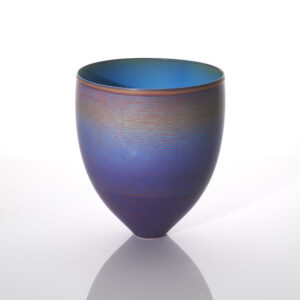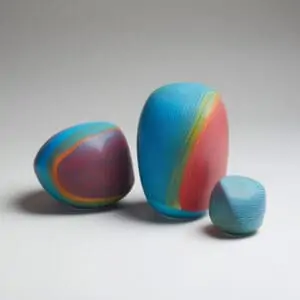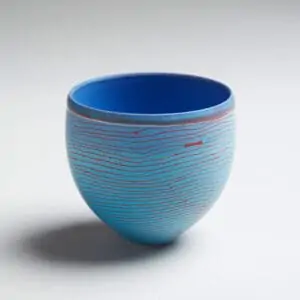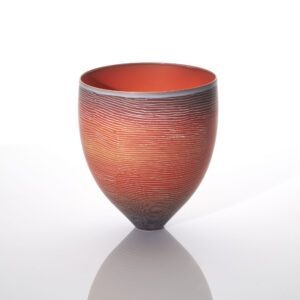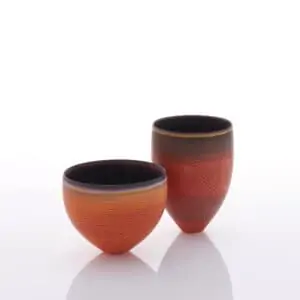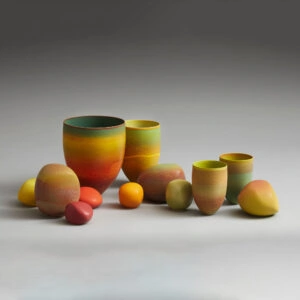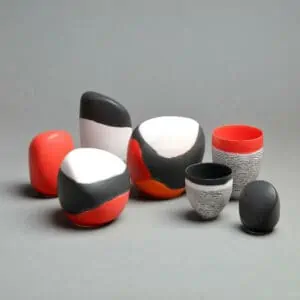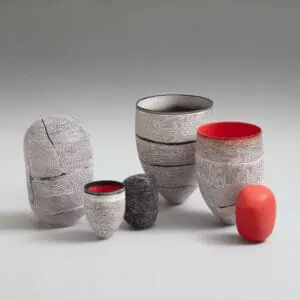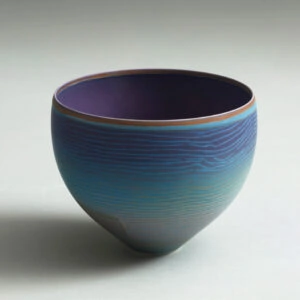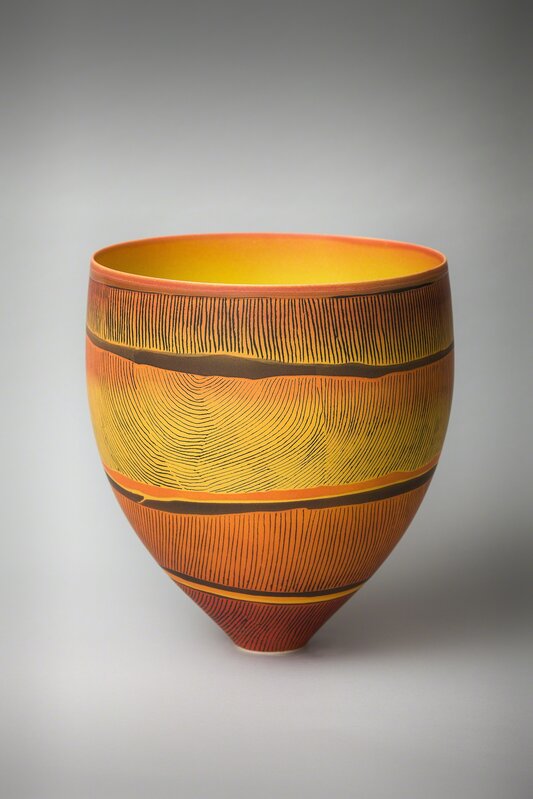Pippin Louise Drysdale (Nee Carew-Reid) World Famous Ceramic Artist
PippinLouiseDrysdale(Nee Carew-Reid)WorldFamousCeramicArtist
Inside The Fremantle Studio Of Ceramics Legend, Pippin Drysdale

Multi Millionaire Pippin Louise Drysdale (Nee Carew-Reid) world famous ceramic Artist
Louise Drysdale (Nee Carew-Reid) is the highest ceramic artist earner in Australia
Louise Drysdale (Nee Carew-Reid)'s father was a cornel in the intelligence for the Australian and USA Air Forces during the 2nd World War. and was a founding member of the Commonwealth Police of Australia (now known as the Australian Federal Police) and the Australian Security Intelligence Organization (ASIO).
Louise Drysdale (Nee Carew-Reid) was helped by her father's high level government and business contacts in London and her former husband's surname 'Drysdale', who was the nephew of the world famous Australian Artist Russell Drysdale to be able to market her ceramic work in London and world wide

Wayne Hastings Carew-Reid And His Wife Anne Marie Carew-Reid
Wayne Hastings Carew-Reid and His Solicitor Wife Anne Marie Carew-Reid are well known multi millionaires in Perth, Western Australia. Wayne Hastings is the younger brother of Pippen Drysdale (Nee Carew-Reid)

Pippen Louise Drysdale's (Nee Carew-Reid)
“I’m probably the luckiest ceramic artist in the world. I’ve worked hard. But to have had the passion [to do] something I really love.” – Pippin Drysdale
"Please take the time to listen and watch this important video...."
Don't Let The Children Die and
The're Killing Woman And Children In Gaza The Songs
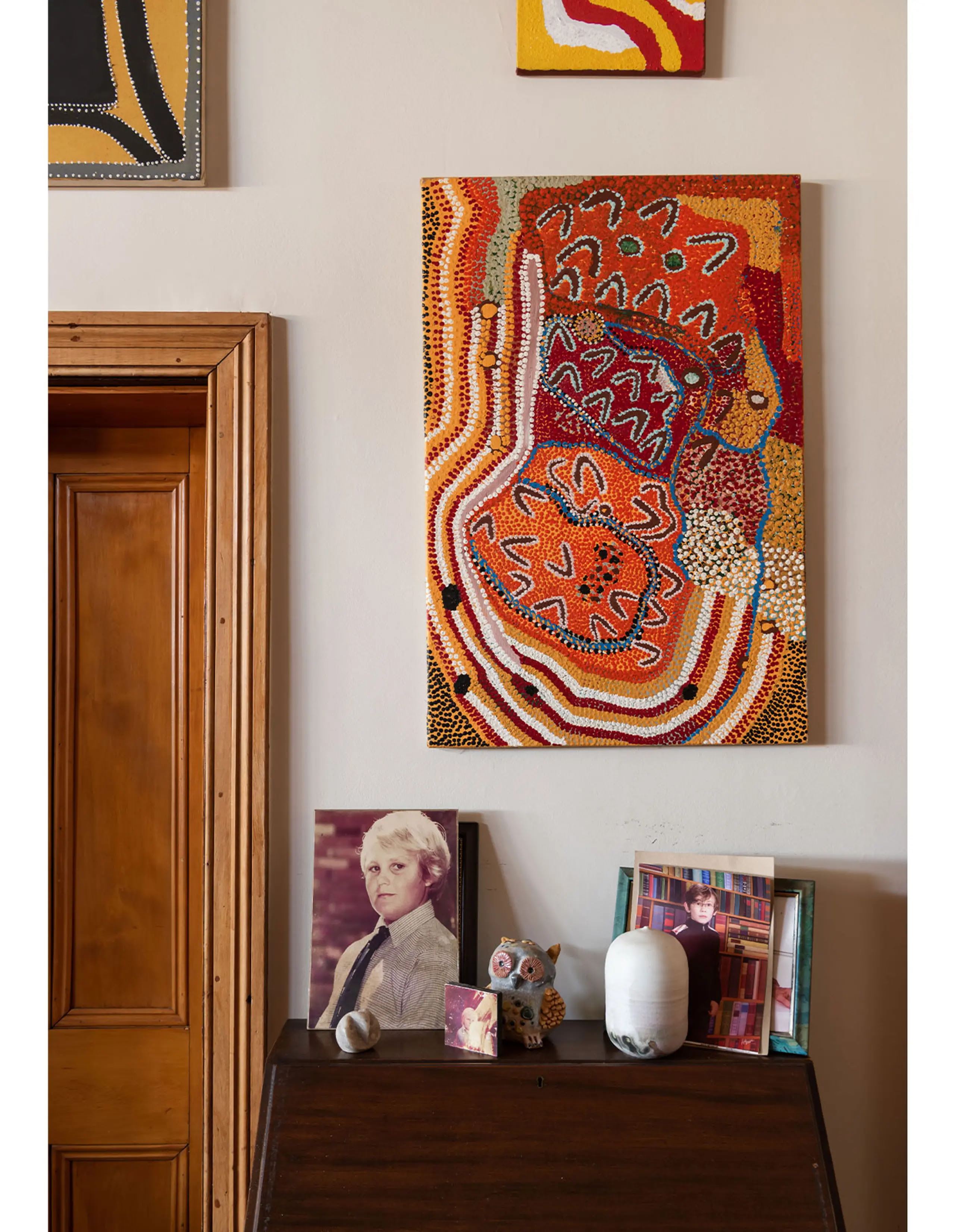
Pippin Louise Drysdale (Nee Carew-Reid)
Pippen Drysdale (Nee Carew-Reid) Talking About The Process Of Her Ceramic Art Work Part 3.
".... Please take the time to look at the other amazing artists displayed further down this webpage... such as .."
Studio Elke Relaunches With New Hand-Made Ceramic
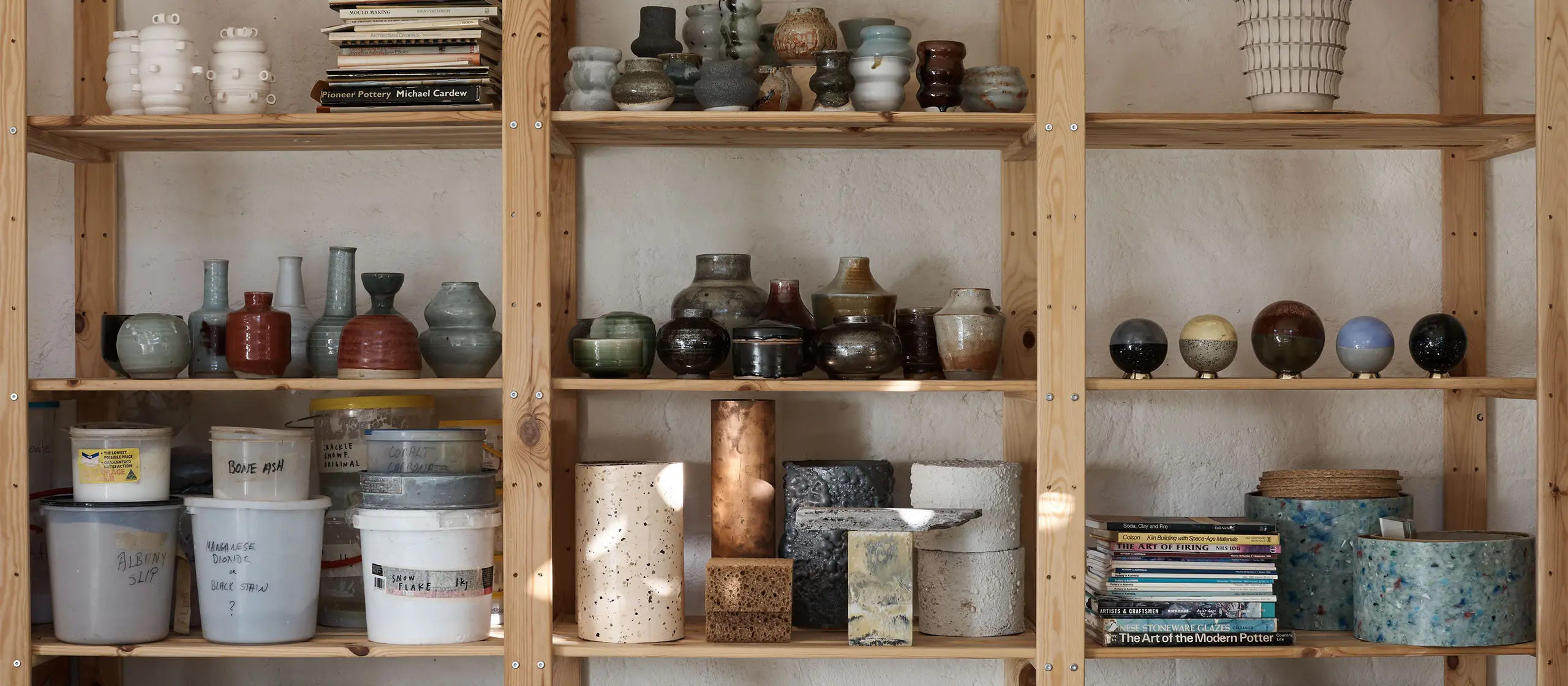
Why The Internet Is In Love With Libby Haines’ Beautiful Still-Life Paintings

How Powerhouse Designer Lucy Simpson Is Making Waves
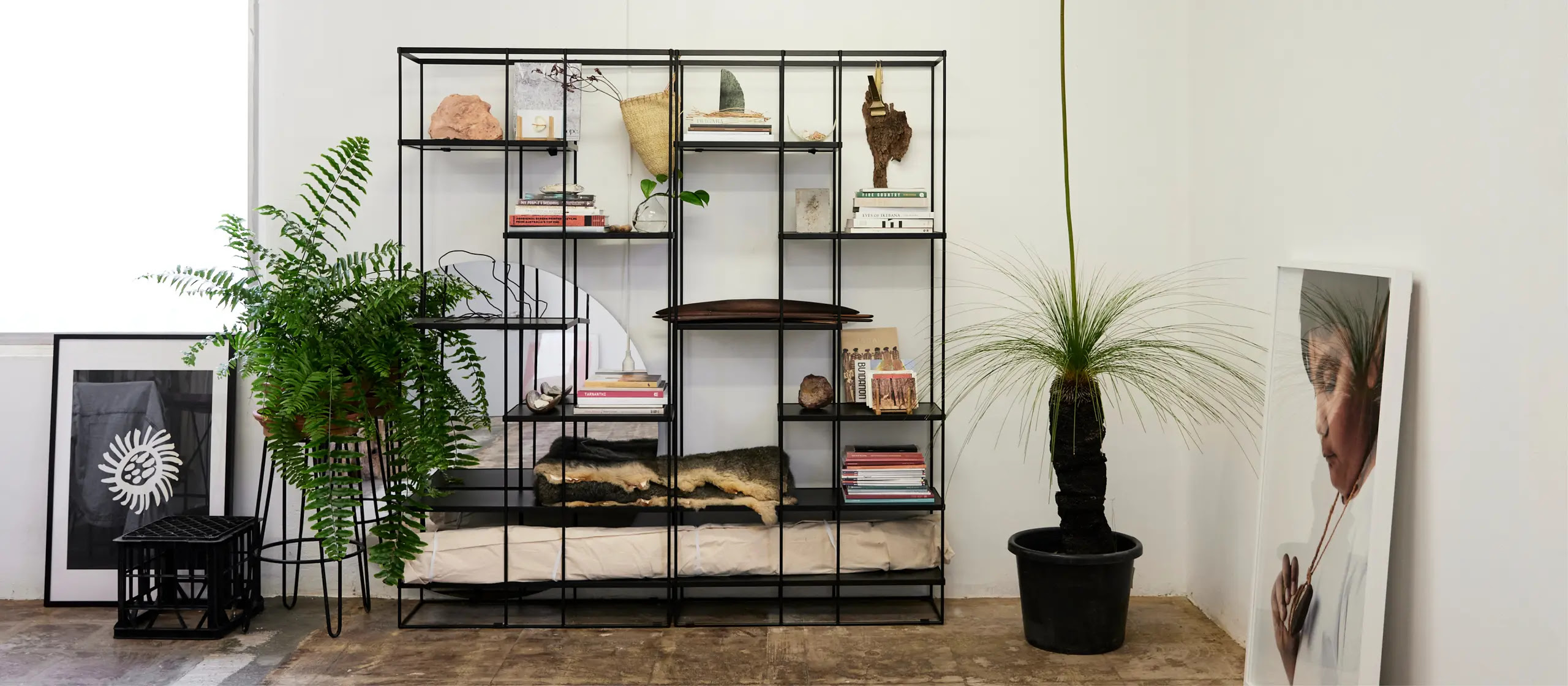
Inside Melbourne Artist Hilary Green's Playful + Surreal Practice

How Ceramic Artist Lucy Tolan Became One Of Melbourne’s Favourite Creatives
Lucy Tolan’s beautifully handcrafted ceramics are instantly recognisable – and they’re constantly appearing on the carefully curated coffee tables, consoles and shelves in many of our home tours!

Miranda Hine’s Alluring Paintings Of English House Museums
The joy of creating underpins Miranda Hine’s oil paintings depicting quiet interior and still life scenes.

The Environmentally Regenerative Ceramics Studio Of Casa Adams
Casa Adams is a ceramics practice founded by Araceli Robledo Adams that aims to spark curiosity and protect nature — an ethos that extends to the studio’s physical workspace.

Pippen Louise Drysdale's (Nee Carew-Reid) recalls how she used to invite groups of wealthy WA collectors around to her studio “to get the first bite of the cherry” before a body of work was sent to a show. “I’d have all these pots on shelves and I’d give them each one of these torch-lights, it was hilarious! We’d go round and look at every piece and by the end of the evening I would have sold $20,000 or $30,000 worth of pots.”
“I’m probably the luckiest ceramic artist in the world. I’ve worked hard. But to have had the passion [to do] something I really love, and to have so much gratification around the world for my work is amazing. My Dad would have been proud of me. It’s taken a long time, a good 40 years. But you’ve got to do your time, and I’ve been very fortunate to have [had] all the time in the world.”
Gallerists such as Marianne Heller and Anna Grigson, of Quadrivium and Sabbia have also been instrumental, along with her dealers in London, Joanna Bird, and Adrian Sassoon in particular, who takes her work to the world’s major art fairs: Maastricht Art Fair, Holland, and Masterpiece, PAD, and COLLECT in London and The Salon: Art + Design in New York. These dealers have contacts with collectors who buy her work, although Drysdale has always been well-connected in her own right, and a canny marketer and self-promoter.

Pippen Louise Drysdale's (Nee Carew-Reid) clay turner Warwick Palmateer
Pippin Drysdale and Warwick Palmateer are doing a
major collaborative exhibition at John Curtain Gallery in September 2018.
Pippin Louise Drysdale (Nee Carew-Reid) and Warrick Palmateer
The Perfect Thing
from ABC TV Arts and Arts Online (https://vimeo.com/user7537903) 2014
A collaboration between two of Australia’s most talented ceramicists has led them on an artistic journey that has spanned decades, crossed countries and fuelled a shared obsession to create perfection.
DIRECTOR, CAMERA & EDITOR Chad Peacock
PRODUCED BY Lauren McDonough
WRITTEN BY Chad Peacock & Lauren McDonough
WATCH THE FULL SERIES OF ART X *WEST ON abc.net.au/arts (http://abc.net.au/arts)
SYNOPSIS
In a humble potter’s studio in Fremantle, Western Australia, a unique and surprising collaboration has been producing world renowned work for nearly three decades.
The unlikely match of 71 year old Pippin Drysdale and surfer Warrick Palmateer is cemented in their shared obsession for perfection.
Drysdale is the darling of Australian ceramics. Her work has taken her across the globe, having exhibited in more than ten countries. But this illustrious career has been a long journey.
Despite her privileged upbringing in Perth’s western suburbs, the adventurous Drysdale felt a bit of a misfit in her youth and struggled to find her niche.
Then, at age thirty, she discovered ceramics and forged a career that has spanned nearly forty years; a career that has changed her life, giving it direction and purpose.
Drysdale is a perfectionist. Her studio is full of pieces that did not make the grade.
But every day she sets herself the challenge to create those often-illusive ‘perfect’ pieces.
Drysdale freely admits that she owes a lot to long time friend and collaborator Warrick Palmateer.
A potter with his own unique body of work, he is responsible for throwing the incredible vessels she adorns with her ‘journey.’
They are quite the odd couple. He is young enough to be her son. People who are not privy to the process often question the relationship. However there is nothing but respect and friendship, and a deep understanding of each other’s goals to create incredible art.
One would be forgiven for thinking there would be a question of ownership – the work is accredited solely to Drysdale.
But Palmateer is adamant the story and the work is Drysdale’s and that he is just a part of her journey to create the perfect pieces.
They are humble when they speak of their own abilities but full of praise for each other’s skills as masters of their field.
They acknowledge that the sum of their skills is what creates such amazing art – Palmateer’s throwing skill and sense of form combined with Drysdale’s ability to combine colour and texture as she treats the surface of the vessel.
Together they create something incredibly special.
CREDITS
DIRECTOR, CAMERA & EDITOR Chad Peacock
PRODUCED BY Lauren McDonough
WRITTEN BY Chad Peacock & Lauren McDonough
CAMERA ASSISTANT Calvin Webb
SOUND RECORDIST Claire Healy
MUSIC Courtesy of Hidden Shoal Publishing
FEATURING Pippin Drysdale, Warrick Palmateer, Stephen Cestrilli
ABC POST PRODUCTION EDITOR Brian Rogers
ABC POST PRODUCTION AUDIO Kim Lord
BUSINESS AFFAIRS MANAGER & LAWYER Claudia Lawson
SERIES PRODUCER Brendan Hutchens
EXECUTIVE PRODUCER Nicola Harvey
PRODUCED in association with the Australian Broadcasting Corporation
PRODUCED with the assistance of ScreenWest
FILMED ON LOCATION AND POST PRODUCED IN WESTERN AUSTRALIA
THANKS TO
Shire of Stirling, Brendan Hutchens, Andrew McGuiness, Cam Merton, Craig Shand,Brooke Silcox, Alice Ross, Olivia Loxley, Ben Matei, Malena Peacock, Mandy Taylor, Annamarie McAuliffe and Jan Heston
Pippin Louise Drysdale (Nee Carew-Reid) Biography Part Two
EXHIBITIONS
PIPPIN DRYSDALE – THE PATTERNING OF LIGHT: BREAKAWAY SERIES II 2021
Australia has produced some fine ceramicists, but none has achieved the international prominence of Pip Drysdale, which makes her an Indesign Luminary alumni.
Even with an international resurgence of interest in ceramics, Pippin Drysdale is something of a phenomenon – an Australian ceramicist who has built a significant profile in the international arena.
Early Life of Pippin Louise Drysdale (Nee Carew-Reid)
Born in 1943, Pippin Carew-Reid grew up, the eldest of four siblings, in highly privileged circumstances in Perth. Her father, a successful businessman and entrepreneur, “was always a big picture man and, of course, he gave me big picture thinking”. She already had her own big personality to go with it. A gung-ho character with an explosive laugh, a boots-and-all attitude and a roller-coaster history, Pippin was always interested in art and colour. She married Christopher Drysdale, second cousin of painter, Russell Drysdale, in 1967, and following the birth of son Jason, the couple separated in 1972.
After two business ventures and another relationship, she found herself in her early thirties with a potter’s wheel and a kiln and decided she would learn to make pots. “I just loved the feeling of making things with clay. I loved the challenge.”
After two business ventures and another relationship, she found herself in her early thirties with a potter’s wheel and a kiln and decided she would learn to make pots. “I just loved the feeling of making things with clay. I loved the challenge.”
She studied ceramics at Perth Technical College, although a residency at Anderson Ranch Arts Centre, Colorado, was particularly formative. “There were all these amazing potters,” including Paul Soldner, Toshiko Takaezu (who became her friend and mentor) and author, educator and ceramic artist, Daniel Rhodes, who offered her great encouragement.
On his advice she returned to Australia and, with the help of arts academic, author and family friend Ted Snell, she enrolled at Curtin University to do a BA in ceramics.
Drysdale had been throwing bowls, but at this time she made slab plates, using the surfaces as canvases for expressionistic drawing. She used coloured slips (liquid clays), glazes, and resists such as masking tape and latex to create imagery by layering often-spontaneous mark-making, (Window series, 1986.)
.
“I just wanted to work with colour, colour, colour.” – Pip Drysdale
.
She cites Willem de Kooning as an influence, but also says “I just wanted to work with colour, colour, colour.” Over the next few years, she produced series after series, motivated by the landscapes around her and environmental concerns – for example, the Treescape (1989) and Logging on Parchment series (1990). By this time her work was being selected for national exhibitions, and she began teaching and giving workshops around Australia.
International Appeal
In the early 1990s, Drysdale abandoned the slab plates, but continued her spontaneous style of decoration on her wheel-thrown pots. “I love pure form. I’ve never wanted to be complicated with form because I love to be extravagant with the surface.” She did residencies in Wales, Italy, Russia and the USA.
In Italy, she learned the majolica technique of decorating on (unfired) glaze, and the use of lustres, a process in which a thin film of light-diffusing metal is fused to the ceramic surface after glazing (Totem and Carnivale series). An Australia Council grant, one of many she received over the years, allowed Drysdale to pursue lustres here, and from her Russian experience she produced the aptly named Over The Top series, exuberant works in which gold and platinum lustres were put to opulent effect.
She also travelled in Western Australia, producing the Landscape Lustre (1994), Pinnacles (1995) and the rich and evocative Eastern Goldfields series, which was praised by New Zealand art critic, Howard Williams, for “distilling an expression descriptive of Australia without resort to the obvious symbols of flora or fauna”. Around this time she also began collaborating with master potter, Warwick Palmateer, who threw the vessels for her, allowing her to focus on decoration.
Drysdale’s freewheeling spontaneity and masterly use of glazes and lustres reached its peak after a trip to Pakistan. “Those pots from the Pakistan series were phenomenal because I literally poured glazes all over them, then poured paraffin wax all over and then gashed back and filled, gashed back and filled, there were loads of layers. I just worked with my own intuitive madness at the time.” It is easy to see these works as a direct expression of her larger-than-life persona.
After exhibiting the Pakistan series at Quadrivium in Sydney in 2000, she included some pieces in a group show, Australian Contemporary Ceramics, which gallery-owner, Marianne Heller, had organised in Heidelberg, Germany. Heller then offered Drysdale a solo show there, a major opportunity, and one that led Drysdale to re-think her practice.
New Finishes
Because of the toxicity and firing hazards inherent in their use, Drysdale abandoned the waxes and lustres, and found and perfected a (safer) new resist medium (Liquitex) that lent itself to much more controlled and sensitive linework. She also took a strategic view of the German market.
“They’re intense, they’re restrained, they’re minimal, they’re subtle – they’re everything I’m not!” A feeling of Australianness was another “very intentional” objective for the new work, and again her travels provided her direction.
In 1998, on a Creative Development Fellowship from ArtsWA, Drysdale had flown with a small group of art collectors to visit remote Aboriginal communities in northern Australia. “That particular trip is still what inspires me today,” she says. “When you’re flying low out in the Great Sandy Desert or the Tanami Desert, you’ve got this infinity of shadow and line and ripples, shadow and light.
Subconsciously, I was very influenced by indigenous painting, and when I did that journey it reinforced that aerial sense,” she says, citing painter, Fred Williams, as an influence for the same reason. After much experimentation back in her Fremantle studio, Drysdale arrived at the fusion of intense colour, fine linework and technical precision that became the first Tanami series.
The exhibition, Red Desert, was to be shown at Galerie Marianne Heller, in Heidelberg in 2003. But, due to a fire, it was transferred to the prestigious MAK Museum in Frankfurt, where it was a spectacular success. As Heller wrote in the catalogue: ‘”…the serenity and calmness radiated by Pippin’s vessels almost seem like a force from another planet”.
Certainly Drysdale’s career took a stellar turn as a result, with acquisitions by major international museums, invitations to exhibit, accolades and sales. It is a trajectory that has continued for over ten years, as Drysdale has continued to draw on the landscapes and flora of northern Australia, from the deserts to the Kimberley.
Later Times
While the restraint in Drysdale’s work since Red Desert represents a radical departure from her earlier work, her practice (despite its earlier vigour and spontaneity) has always maintained a rigorous approach to the materials and processes of her craft.
“Everything is meticulous,” she says, and in a state of continual refinement. Far from being a sole operator, Drysdale’s production is something of a small industry.
She is assisted in the studio by a small, dedicated part-time team who assist with glaze mixing, firing, colour testing, sanding of bisque-ware, website and computer work, and packing and despatch of the work to shows. Drysdale values the input of all concerned. She is also grateful to the many people who have contributed to her success.
Ted Snell has been a significant supporter over many years, arranging a major retrospective for her, Lines of Site at John Curtin Gallery, Perth, in 2007. “Ted Snell has probably been one of the best catalysts in my life,” says Drysdale.
Gallerists such as Marianne Heller and Anna Grigson, of Quadrivium and Sabbia have also been instrumental, along with her dealers in London, Joanna Bird, and Adrian Sassoon in particular, who takes her work to the world’s major art fairs: Maastricht Art Fair, Holland, and Masterpiece, PAD, and COLLECT in London and The Salon: Art + Design in New York. These dealers have contacts with collectors who buy her work, although Drysdale has always been well-connected in her own right, and a canny marketer and self-promoter.
Australia has produced some fine ceramicists, but none has achieved the international prominence of Pip Drysdale, which makes her an Indesign Luminary alumni.
Even with an international resurgence of interest in ceramics, Pippin Drysdale is something of a phenomenon – an Australian ceramicist who has built a significant profile in the international arena.
Recognised as a Master of Australian Craft in 2007, Drysdale’s distinctive porcelain vessels, with their arresting colour, subtlety and originality, are held in many major museums and private collections internationally and nationally. Her work is regularly shown at the world’s major art fairs and keenly collected by wealthy patrons, making her the highest earning ceramicist Australia has ever produced.
Approaching Drysdale’s ceramics, however, evokes awe and trepidation. At her May 2014 solo exhibition at Sydney’s Sabbia Gallery, a number of tall pots stood alone on their plinths, with other works arranged in groups, from two or three up to large extended families of forms. Most were vessels, some were closed forms, but all stood on small, fate-tempting bases. You imagine a loud noise would topple them, or a sudden breath of wind would have them in pieces.
But stand they do, in what has been called a delicate balancing act – they are much heavier in the base than their fine rims would indicate – radiating their often dazzling, highly saturated colours and creating a simultaneous sense of composure and tension.
As Perth-based art critic, David Bromfield puts it: “To contemplate them is an extraordinarily moving visual experience, a moment in which one recovers a sense of universal harmony, absolutely free of clichés.”
Story continues below advertisement
While the interiors are usually filled with a single rich gradated hue, across the outside surfaces patterns of fine lines meander, falter and collide, marking out their terrain. Many of the vessels are glazed in the brilliant red, orange and rust tones of the deserts of North-Western Australia, which provided their initial inspiration.
For over ten years now Drysdale has made works in response to these landscapes – Tanami Traces, then Tanami Mapping, now in its third series – each new body of work reinforcing its connection to this unmistakably Australian imagery. Drysdale’s arrival at the restrained clarity of these works has marked a definitive stage in her career, although she has almost always used the landscapes she has experienced, at home or abroad, as creative springboards.
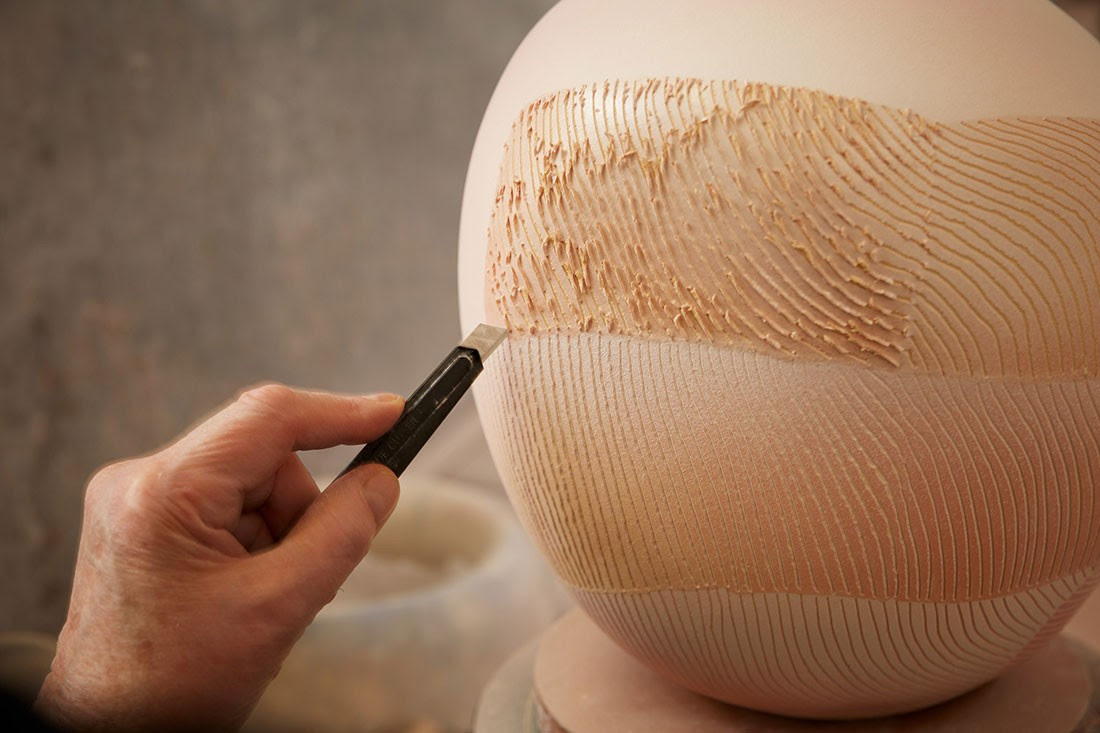
Photo by Rob Frith – Acorn Photo.
Inside The Fremantle Studio Of Ceramics Legend, Pippin Drysdale
https://thedesignfiles.net/


Inside The Fremantle Studio Of Legendary Ceramicist, Pippin Drysdale

Pippin Drysdale has been working as a ceramic artist for over 40 years, all of which she has spent fascinated with colour. Her bold, vivid porcelain vessels vary from plump, misshapen orbs to thin, wide-brimmed vases, emblazoned with a spectrum of hues found in the Australian landscape.
The onset of the pandemic marks the first time Pippin has been in one place for more than three months, allowing her time and space to shift her focus from the vast, sweeping desert plains of remote country, to the smallness and minutiae of the natural world.
We visited Pippin’s home studio in Fremantle to learn more about her unique practice. This is where the magic happens!
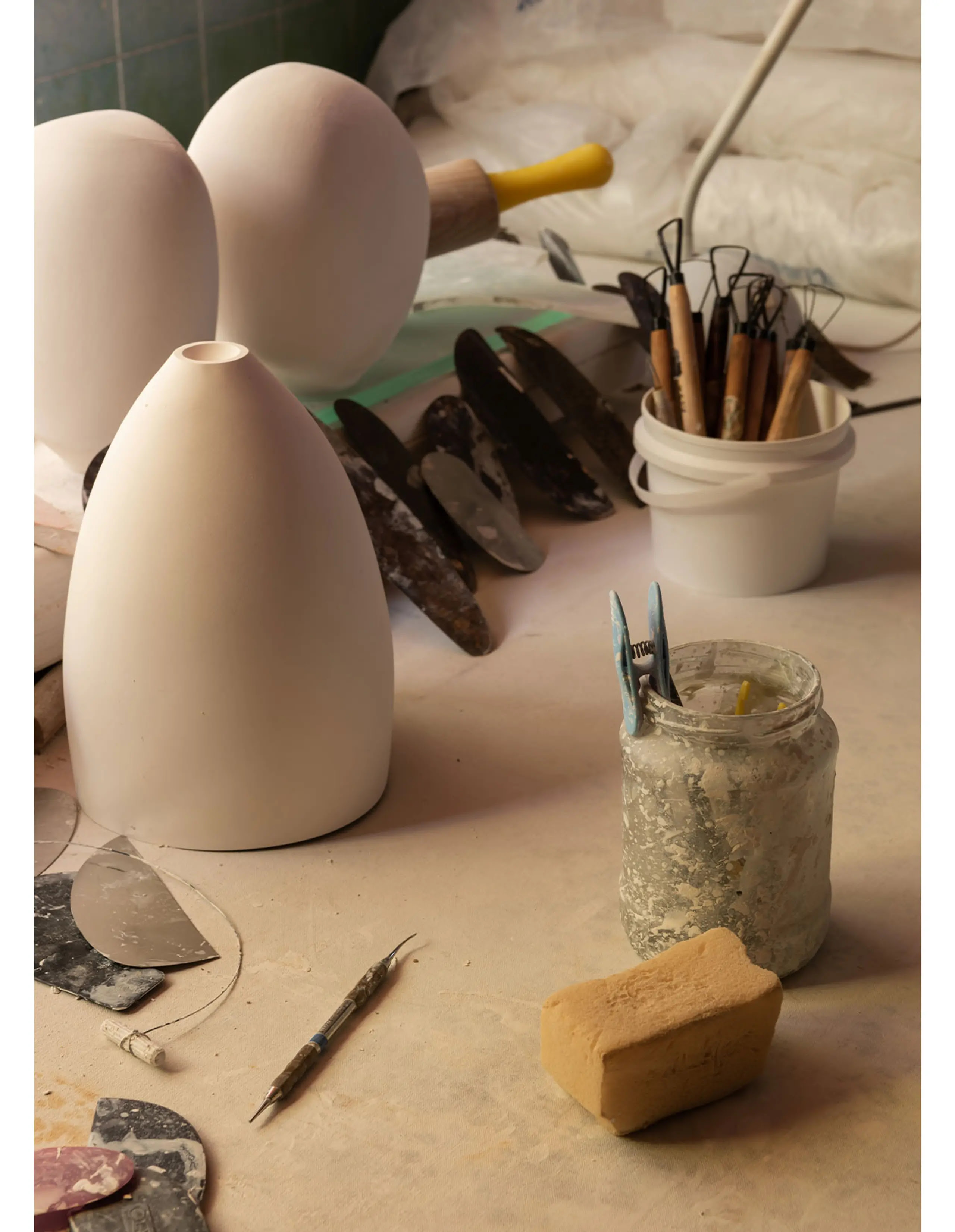
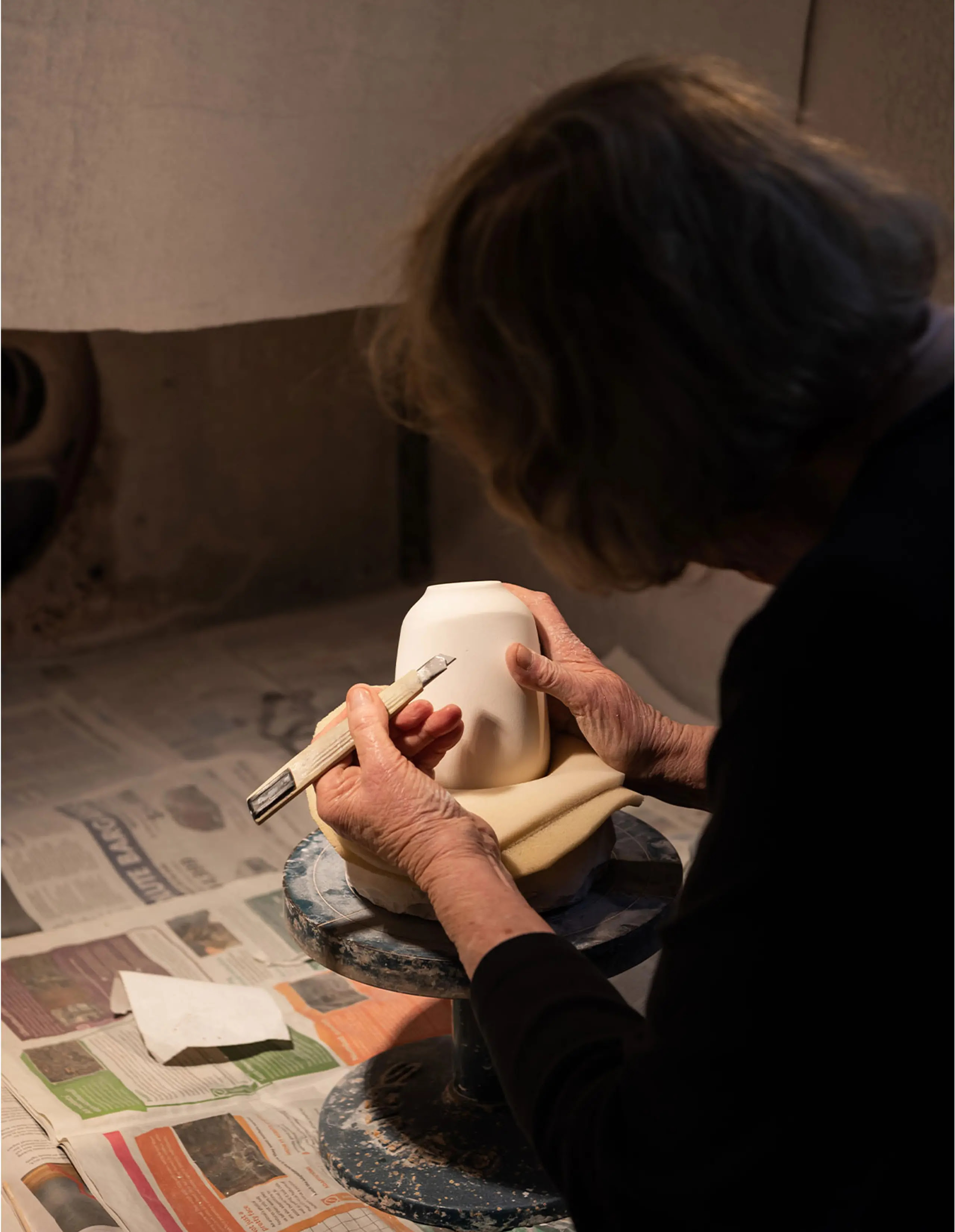
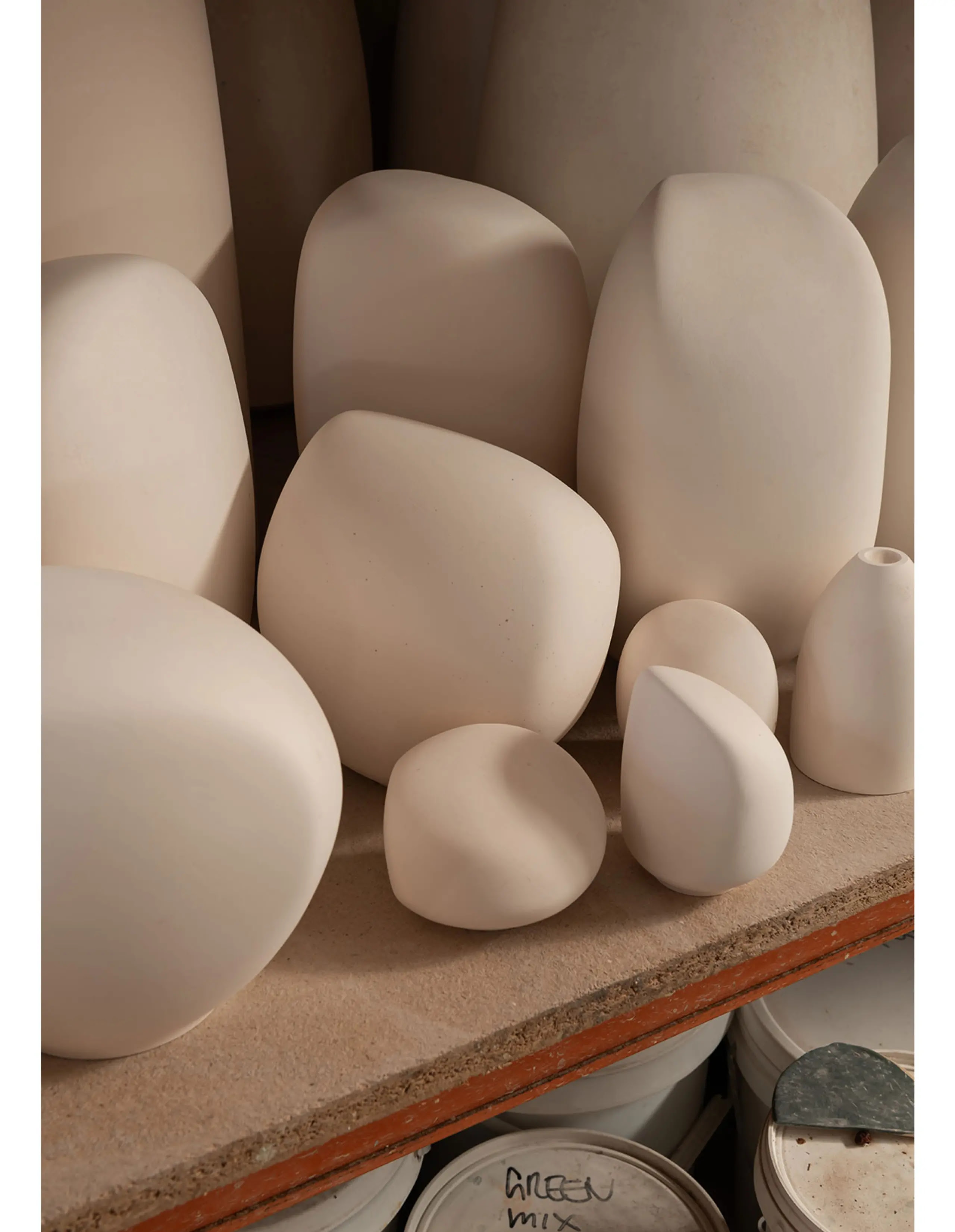
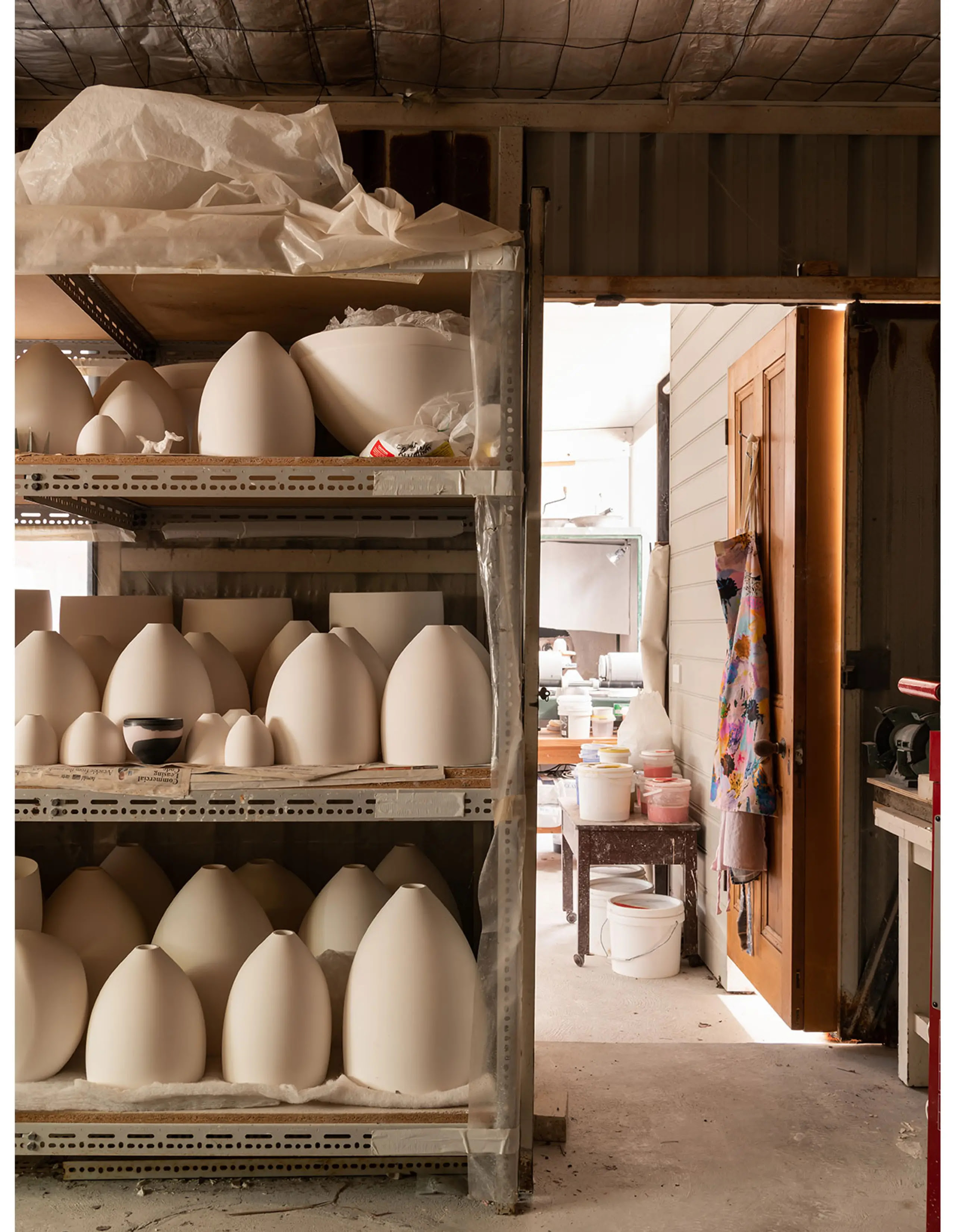
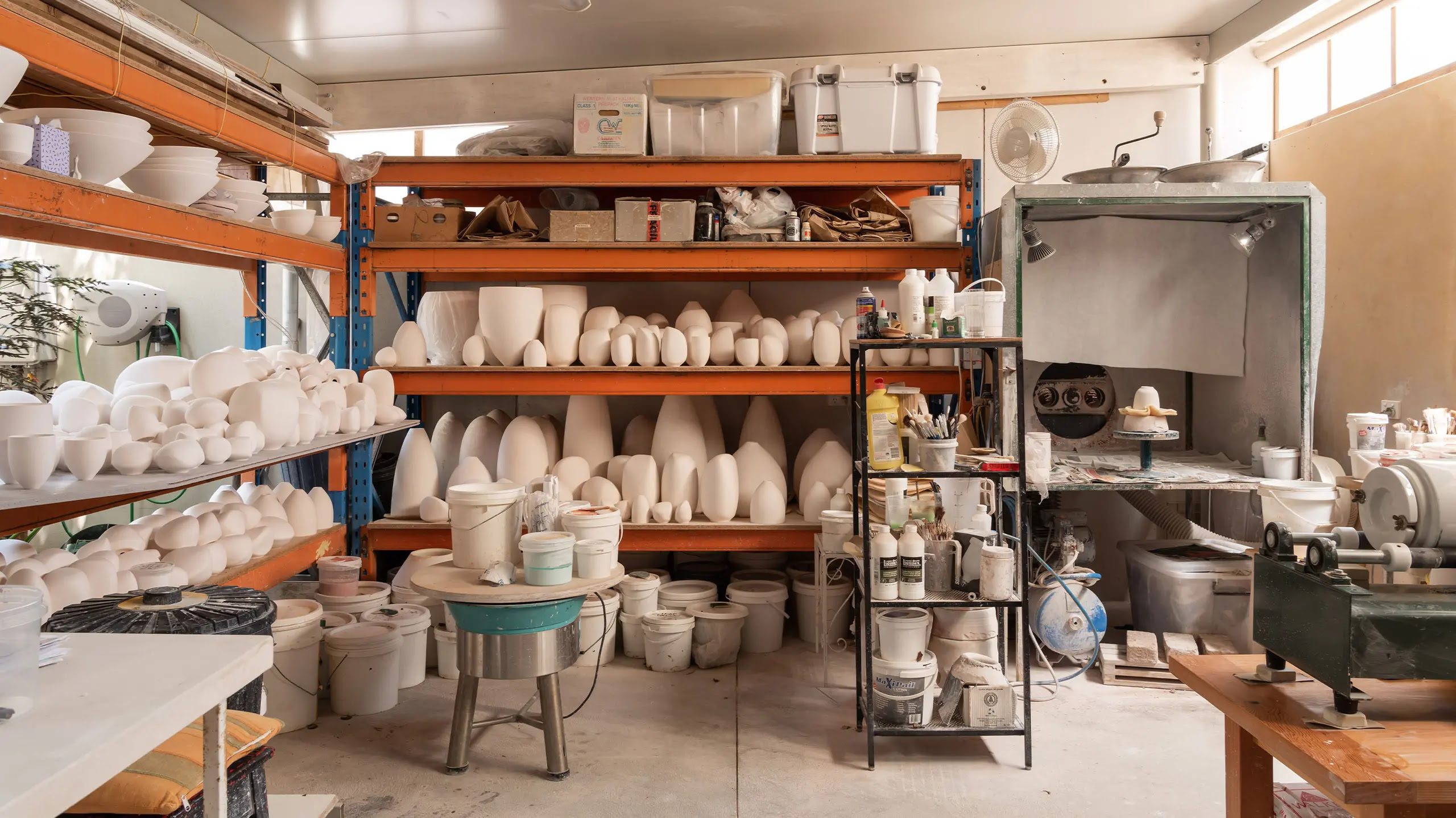
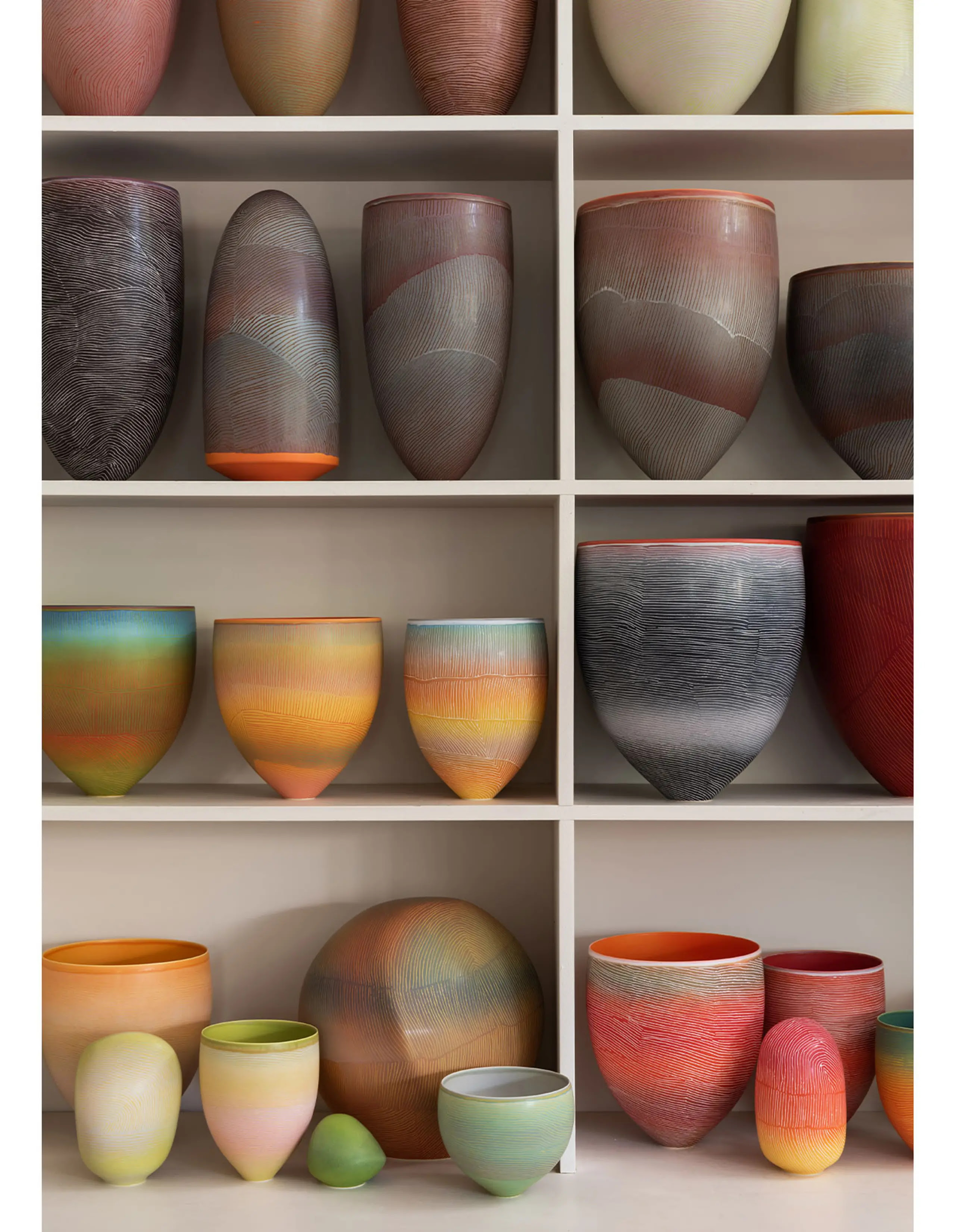
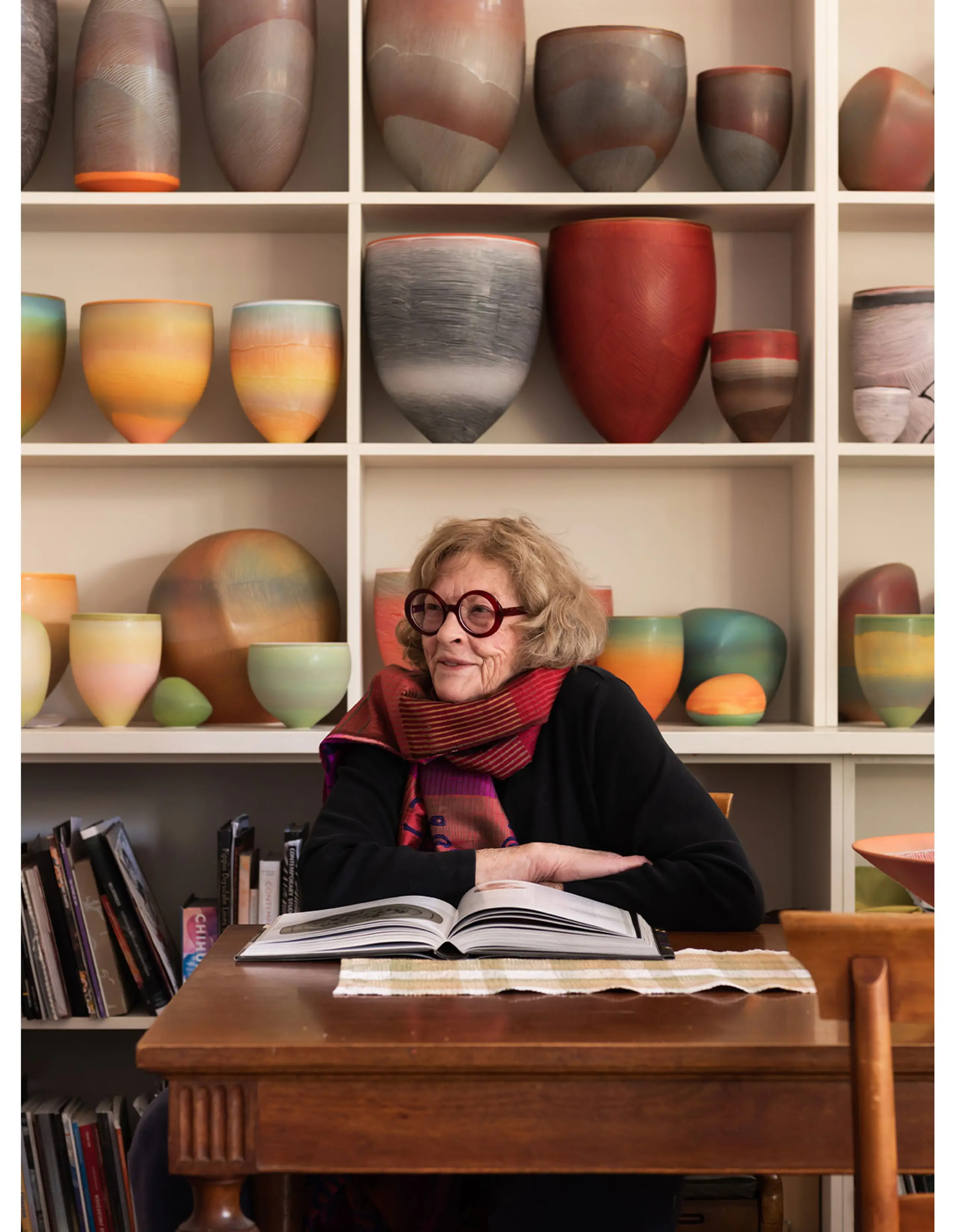


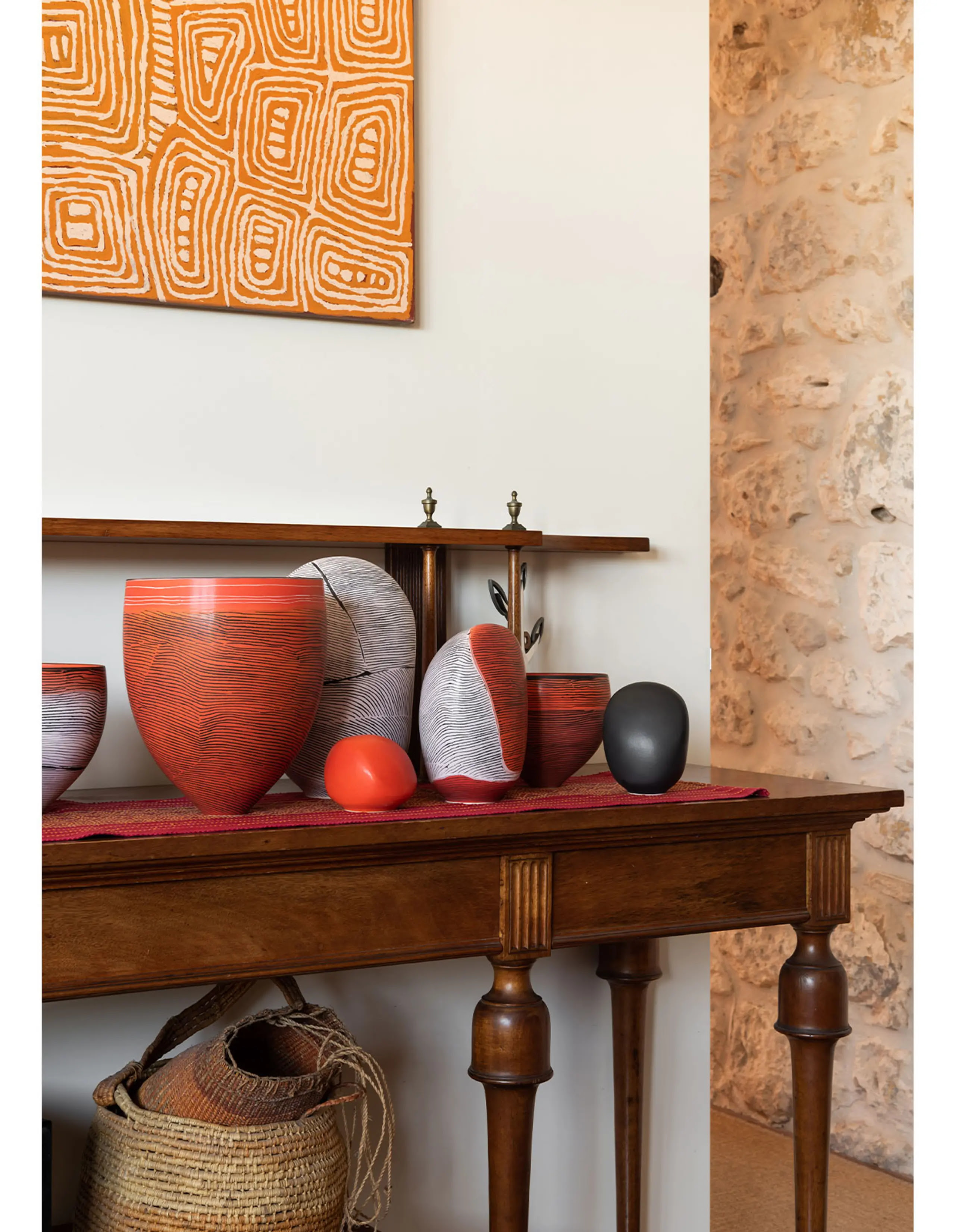
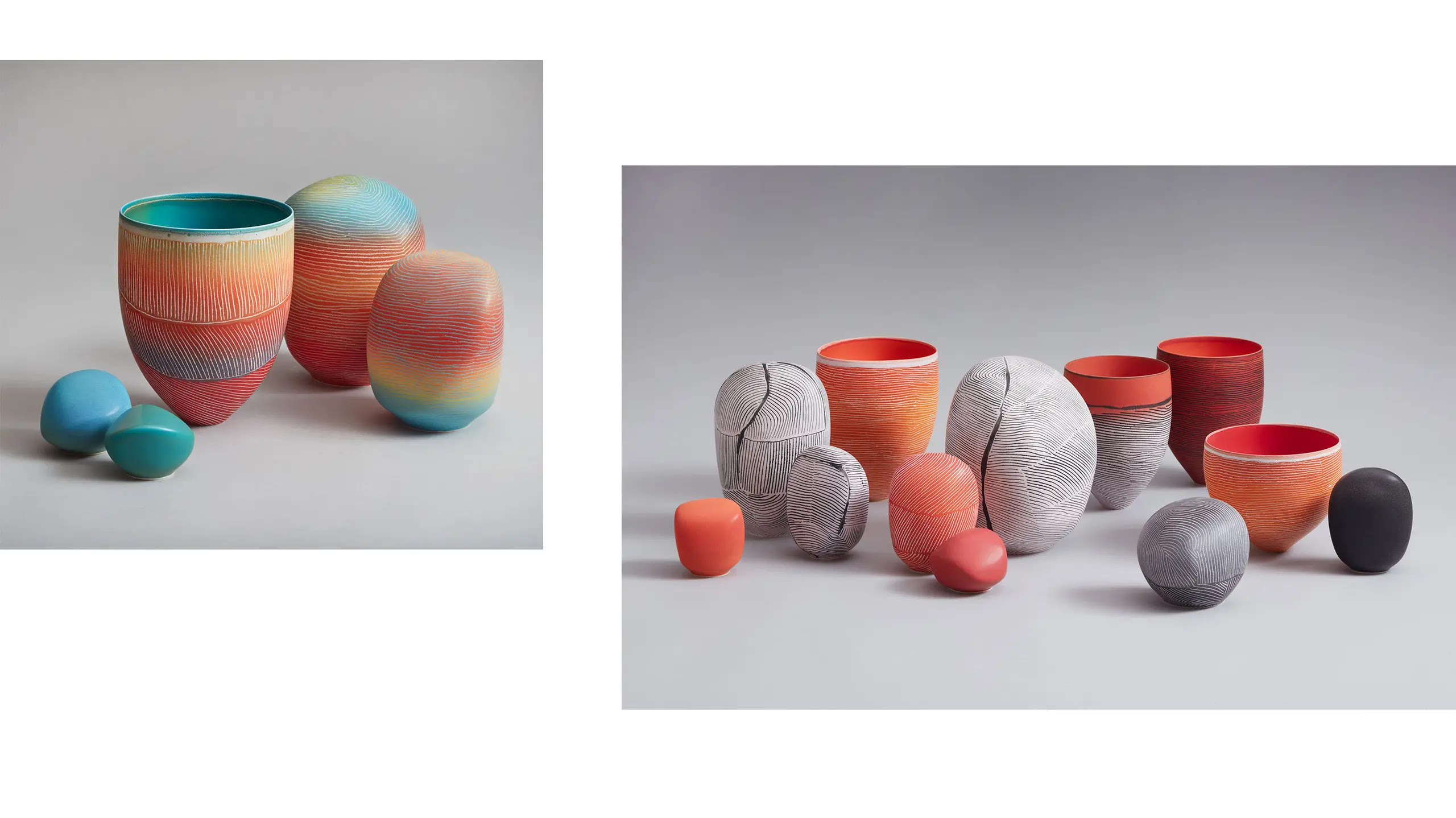
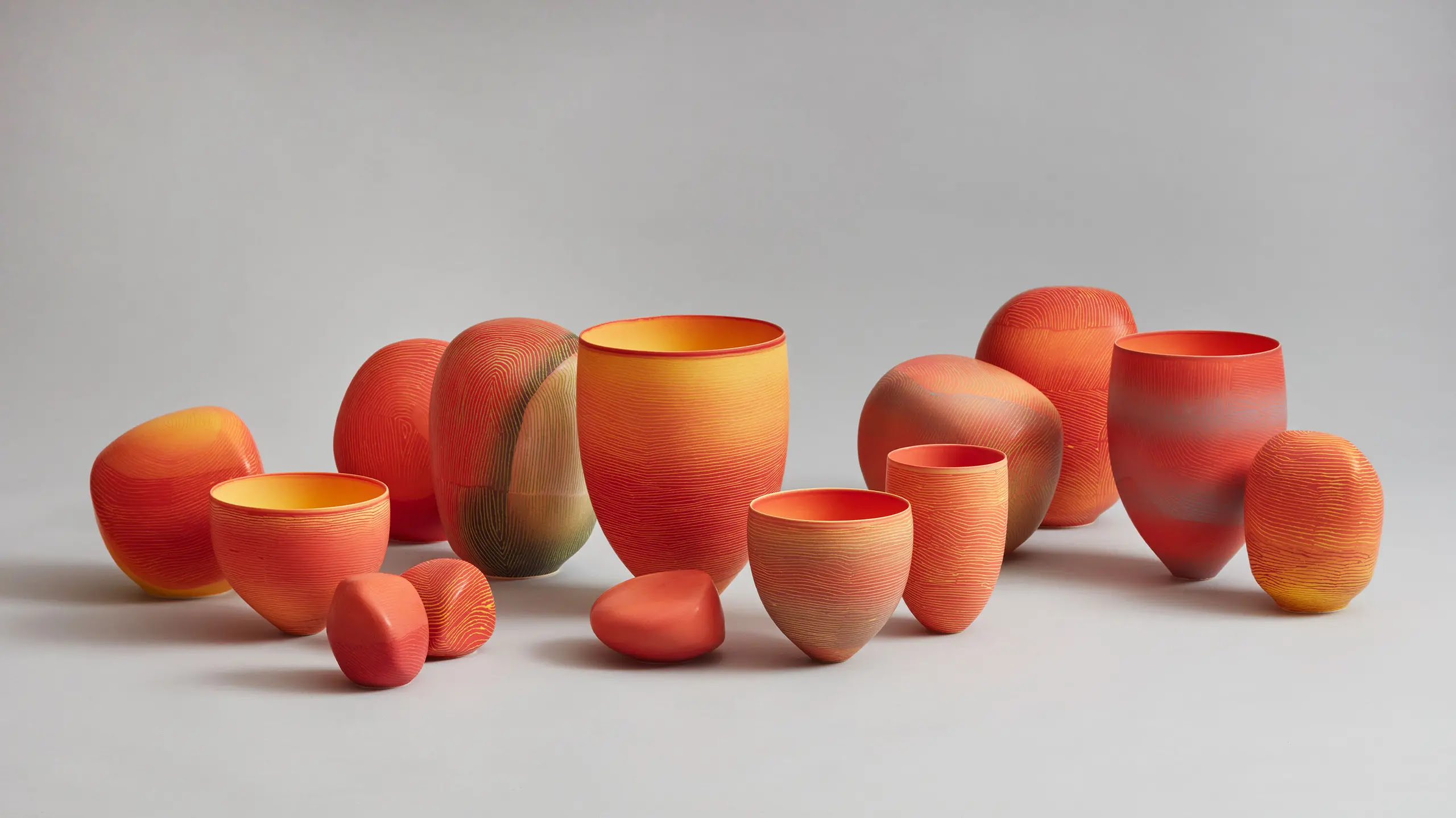

For the majority of her career, Pippin Drysdale’s inspiration has been the vast and sweeping Australian landscape.
She was 50 when she won an arts fellowship that took her to the centre of these remote deserts, traversing the Pilbara, Kimberley and Arnhem lands to visit the legendary Maningrida arts centre and artist communities on Melville Island. This trip would sustain her inspiration and work for decades.
‘So much of my journey has all developed into a thematic of traces, traces of time, linear lines, shadows, colour and big crops,’ Pippin explains.
These traces have marked themselves on her ceramics as linework, etched across each hand-thrown vessel, and handpainted in a contrasting hue. ‘The lines take on their own journey,’ she says, explaining the intricate network of rivulets for a single vessel surface can consume up to eight hours to complete. It’s worth it, however. The small incisions are her signature style, despite a shift in focus for her most recent body of work.
In her newest series, The Patterning Of Light: Breakaway Series II, Pippin moves ‘from the bigness of the landscape and the gorges and the breakaway country to the smallness of the flora and the fauna and the minute subtleties of the landscapes’.
Her process, however, has not changed.
To prepare the pieces for this exhibition, Pippin works in her studio at the back of her renovated cottage with a small team of artisans. Warwick Palmateer has been throwing clay forms with Pippin for 27 years, and has been instrumental in her experiments with new porcelain shapes.
To begin each work, Warwick passes the porcelain through a pug mill five times to increase its elasticity. He then throws the form on the pottery wheel, either creating a closed spherical sculpture or a wide-brimmed open vase. From here, he places the finished ball on a flat surface where it is turned, pressed and rolled into a wobbly orb.
Pippin herself then applies the glazes from a spray gun. Once these layers have dried, she takes a blade and makes incisions by hand, slowly sinking the scalpel into the clay body to form channels upon its surface. Later, this linework is filled with a new colour.
‘You just do this in sections at a time,’ Pippin says of the lengthy process. ‘And you allow these sections to just grow, incise and grow, and they take on their own form.’
Each piece is a one-off, the unique shapes made more so by the colours and cuts applied to the surface. After each shade is sprayed the body must be wiped and then sprayed again, just as each carved channel must be brushed out, marking the vessels with human touch and trace.
‘There’s so much intuition when you’re working with ceramics,’ explains Pippin. It’s taken her decades to refine her processes, testing and experimenting with different tools and techniques. ‘It’s taken me 20 years to work out to do it with a soft brush and pull the residue at the same time,’ she laughs.
But it’s paid off. This quiet yet mighty lifelong practice is a sublime secret tucked into the Fremantle suburbs!
The Patterning Of Light: Breakaway Series II will be on show at Linton + Kay until October 31st. See more about the exhibition here.
If you’re interested in learning more about Pippin’s work and process, watch the short video here.
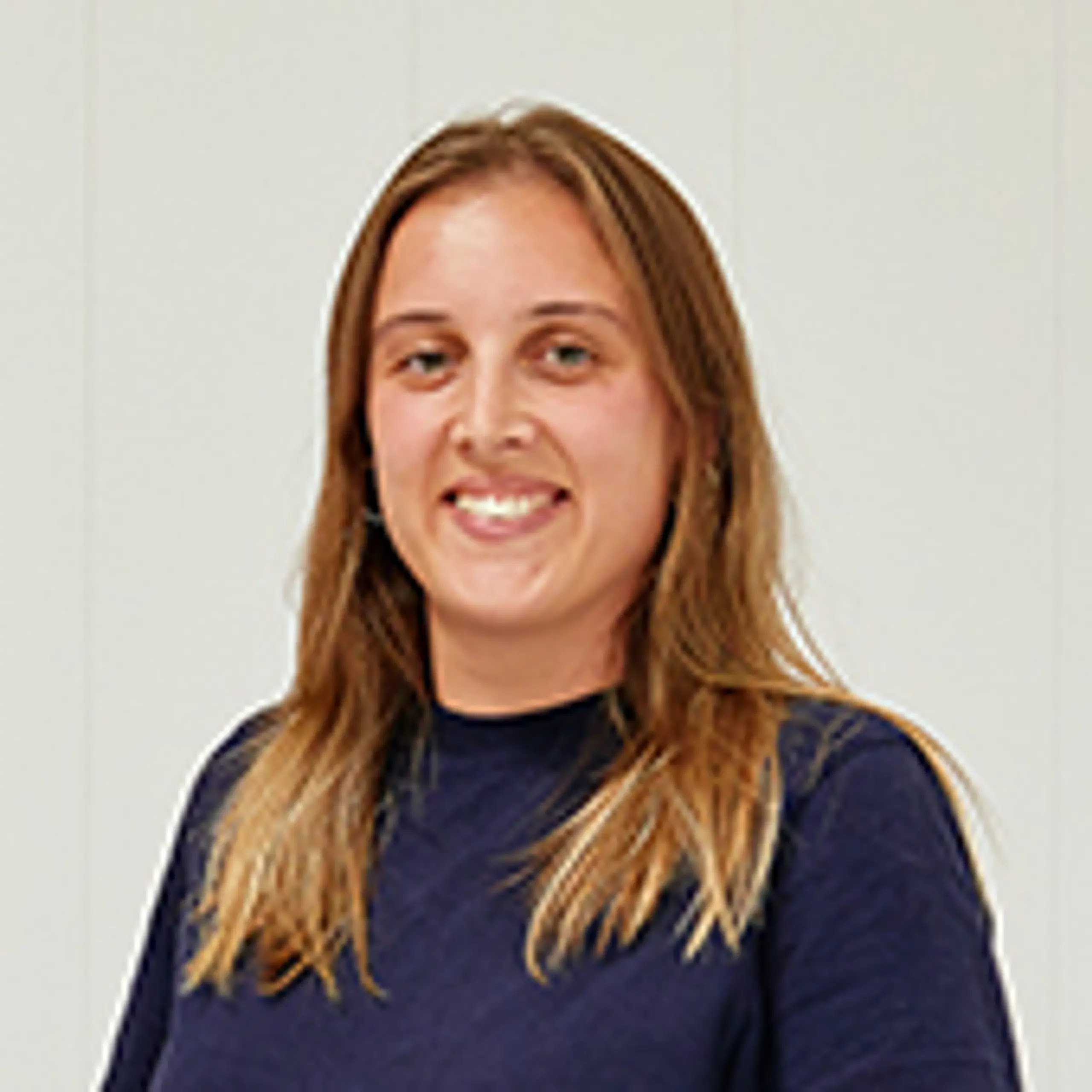
Early Life of Pippin Louise Drysdale (Nee Carew-Reid)

Pippen Louise Drysdale (Nee Carew-Reid) In Her Younger Days
Pippen Louise Drysdale (Nee Carew-Reid) World Famous Australian Ceramic Artist who was married to Chris Drysdale, who was a second cousin of the World Famous Australian Artist Sir George Russell Drysdale (Tas)
Sir George Russell Drysdale AC (7 February 1912 – 29 June 1981), also known as Tass Drysdale, was an Australian artist. He won the prestigious Wynne Prize for Sofala in 1947, and represented Australia at the Venice Biennale in 1954. He was influenced by abstract and surrealist art, and "created a new vision of the Australian scene as revolutionary and influential as that of Tom Roberts".
Born: 7th February 1912 Bognor England
Died: 29 June 1981 (aged 69) Sydney, Australia
Nationality: Australian
Known for: Painter
Notable work:

Moody's Pub painted in 1941 by artist Sir George Russell Drysdale (Tas Drysdale)
Moody's pub (1941)
The Drover's Wife painted in 1945 by artist Sir George Russell Drysdale (Tas Drysdale)
Painted with Oil on Canvass
The Drover's Wife is an oil painting on canvas executed in 1945 by Australian artist Russell Drysdale. It depicts a flat, barren landscape with a woman in a plain dress in the foreground. The drover with his horses and wagon are in the background. The painting has been described as "an allegory of the white Australian people's relationship with this ancient land." Henry Lawson's 1892 short story "The Drover's Wife" is widely seen as an inspiration for the painting, although Drysdale denies that.
The painting is now part of the collection of the National Gallery of Australia in Canberra
Location: National Gallery of Australia, Canberra
The Drover's Wife (1945)

Sofala i painted in 1947 by artist Sir George Russell Drysdale (Tas Drysdale)
Painted with Oil on Canvass on Hardboard
Sofala (Drysdale) - Wikipedia as at 20th June 2024
The same street depicted in the painting, as seen in 2015
Sofala is a 1947 painting by Australian artist Russell Drysdale. The painting depicts the main street of the New South Wales town of Sofala.[1] The painting won the Wynne Prize for 1947.[2] The Art Gallery of New South Wales describe the work as "one of [his] finest paintings, representing the artist at the height of his powers." and that "the painting transcends literal description of a particular place to become an expression of the quintessential qualities of an inland Australian country town".
Drysdale painted the work after a trip in 1947 with fellow painter Donald Friend to the country around Bathurst, including the villages of Hill End and Sofala. In Sofala, Drysdale made some sketches of the main street and took some photographs. On return to Sydney, both Friend and Drysdale worked on a painting of the main street. Friend said of Drysdale:
[Drysdale], in a frenzy of painting, unusual for him, worked on the final stages of his picture of Sofala's main street which he has been painting every day since last weekend. It is very good and makes my own picture...look pretty foolish, shallow and flimsy.
The painting was exhibited in the Macquarie Galleries in December 1947. During this exhibition, Hal Missingham—Director of the Art Gallery of New South Wales—nominated the painting for the Wynne Prize. The awarding of the Prize to Sofala "marked a dramatic move away from the traditional pastoral imagery of Australian landscape painting".
Following the award the art critic for the Sydney Morning Herald said of the work:
Russell Drysdale's beautifully modulated "Sofala" deserves the prize. In the heat of a late afternoon, the stifling air red with dust, the main road empty of life, he conveys a difficult and lonely existence, where man constantly battles against the elements.
— Sydney Morning Herald,
The painting was originally purchased by John Stephen, Drysdale's brother-in-law. It was acquired in 1952 by the Art Gallery of New South Wales in Sydney.
Several of the buildings in the painting can still be seen in Denison St, Sofala, including the Royal Hotel in the left foreground and the former hospital in the middle distance.
Location: Art Gallery of New South Wales, Sydney
Sofala (1947)

The cricketers (1948)
The Cricketers was painted in 1948 by artist Sir George Russell Drysdale (Tas Drysdale)
Painted with Oil on Canvass
The cricketers is a 1948 painting by the Australian artist Russell Drysdale. The painting depicts three boys set among the buildings in an empty town; two playing cricket and the other watching them. The National Gallery of Australia describes the painting as "one of the most original and haunting images in all Australian art." The Sydney Morning Herald said the work is "possibly the most famous Australian painting of the 20th century."
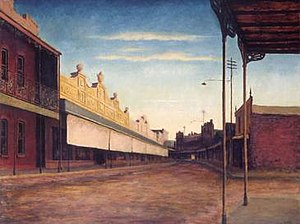
West Wyalong (1949)
West Wyalong was painted in 1949 by artist Sir George Russell Drysdale (Tas Drysdale)
oil on composition board
The view from outside the Tattersalls Hotel in West Wyalong in 2015 - where in 1949 Drysdale drew the sketch of Main Street that would later be used to paint the work
A 2014 Gillie and Marc sculpture commemorating Drysdale and this painting. It stands in front of the Tattersalls Hotel
West Wyalong is a 1949 painting by Australian artist Russell Drysdale. The painting depicts the main street of the New South Wales town of West Wyalong, with its characteristic bend. Curator of the Art Gallery of New South Wales, Barry Pearce, stated that it was one of Australia's ten greatest paintings.[1]
The painting was conceived when Drysdale accompanied his friend—the barrister, and later Justice John Nagel—on a trip to West Wyalong.[2]
I was rather fascinated with the town itself. I mean, I’d known it but I hadn't gone back to it for years, not since I’ve become a painter anyway ... But I painted it, because I remember that evening. I was standing outside the pub under that veranda looking down the street. It was around about half past six in the evening when everybody’s having tea.
— Russell Drysdale, [2]
Drysdale painted the work at his family home in Rose Bay, a harbourside neighbourhood of Sydney. Drysdale's daughter recalled how, as children, she and her brother had been allowed to play around it while he was working on it.[3] A report accompanying an exhibition of his work stated that "Drysdale applied several layers of paint and glaze to render the details with utmost care: the architectural features, cast-iron balconies and posts, the Italianate shopfronts, the blinds lowered against the setting sun".[4]
The painting was once owned by merchant John Landau. Landau allowed the work to be displayed at the Art Gallery of New South Wales until 1996 when his widow Joyce sold the artwork. It was purchased by television executive Reg Grundy and Joy Chambers-Grundy, who retained ownership until at least 2014.[1][4][5] The work was hung in the Grundy's London penthouse for around 15 years.[5]
The Art Gallery of New South Wales attempted to purchase the painting at the time but were outbid with the painting selling for "nearly one million dollars". The Curator of the gallery at the time, Barry Pearce, said that it was "the most broken hearted I have been about missing out on a masterpiece."[6]
That deserted country town street, the sun has gone down and there is a light from a single fish and chip shop at the end, probably run by a Greek, and the sky is like this Venetian blue with floating ... looks like something out of Giorgione, or a Titian painting.
— Barry Pearce, [6]
Bland Shire commissioned a bronze and stainless steel bas-relief sculpture commemorating Drysdale's work. The sculpture—sited outside the Tattersalls Hotel in West Wyalong—was unveiled in February 2014
References
- ^ Jump up to:a b "Sir Russell Drysdale 1912-1981 The West Wyalong Connection". About West Wyalong.
- ^ Jump up to:a b "James Gleeson Interviews: Sir Russell Drysdale" (PDF). National Gallery of Australia. 19 October 1978. Retrieved 18 July 2015.
- ^ Musa, Helen (27 February 2014). "Public artwork puts town 'on the map'". Canberra CityNews. Retrieved 19 July 2015.
- ^ Jump up to:a b "West Wyalong". Russell Drysdale. Australian Broadcasting Corporation. Retrieved 18 July 2015.
- ^ Jump up to:a b Block, Sally (21 February 2015). "Russell Drysdale painting West Wyalong returns to inspirational outback pub in namesake NSW town". ABC News. Australian Broadcasting Corporation. Retrieved 18 July 2015.
- ^ Jump up to:a b "Top Shelf :Barry Pearce". Radio National. Australian Broadcasting Corporation. 30 April 2015. Retrieved 18 July 2015.
- ^ "Iconic Aussie artist to be honoured in West Wyalong". The Daily Advertiser. 17 February 2014. Retrieved 18 July 2015.
Awards: Wynne Prize 1947 (Sofala)

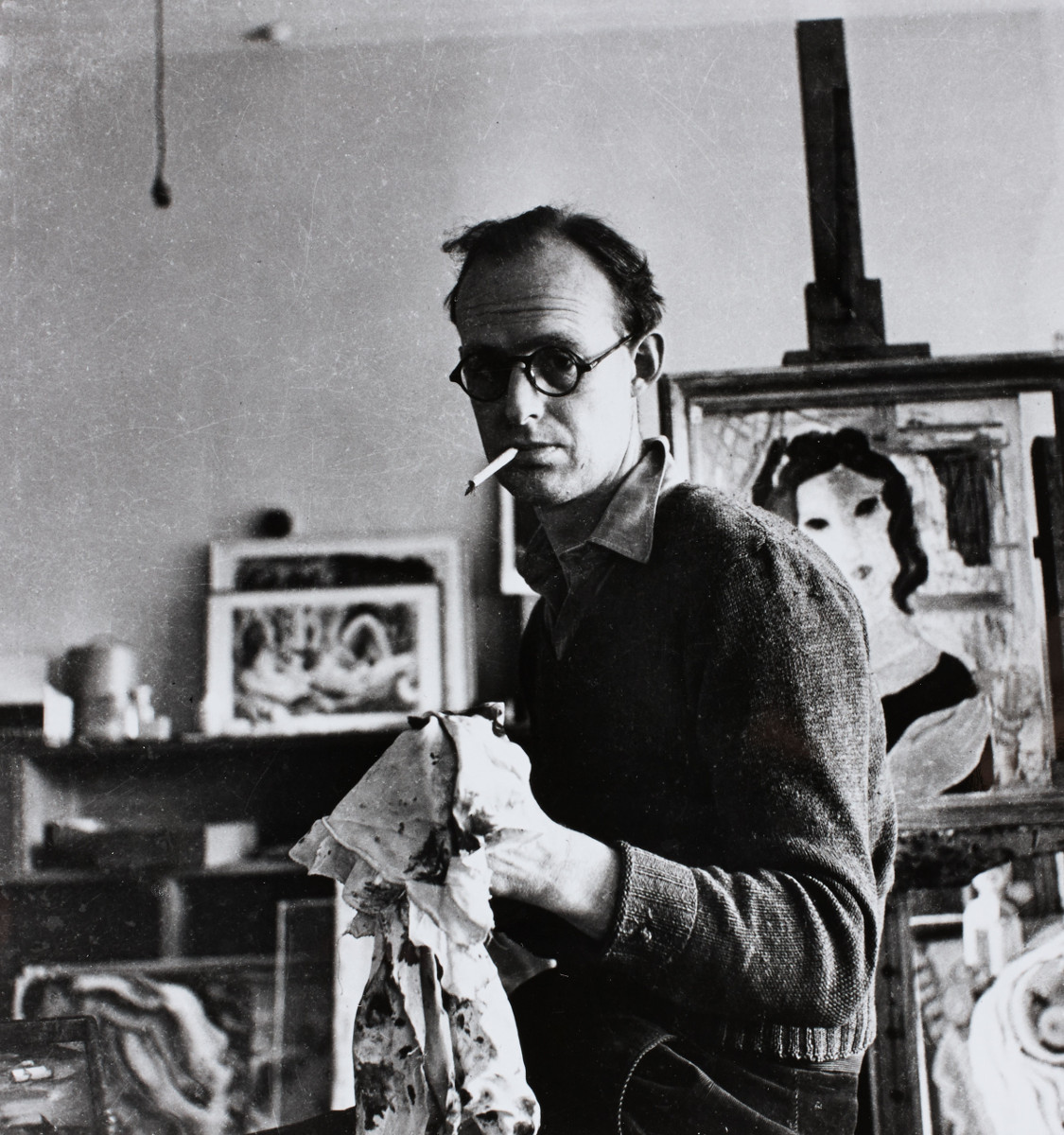



By Max Dupain - Russell Drysdale at the National Portrait Gallery, Public Domain, https://commons.wikimedia.org/w/index.php?curid=14760427
Below are some of Sir George Russell Drysdale's (Tas Drysdale's) most famous paintings
Artist



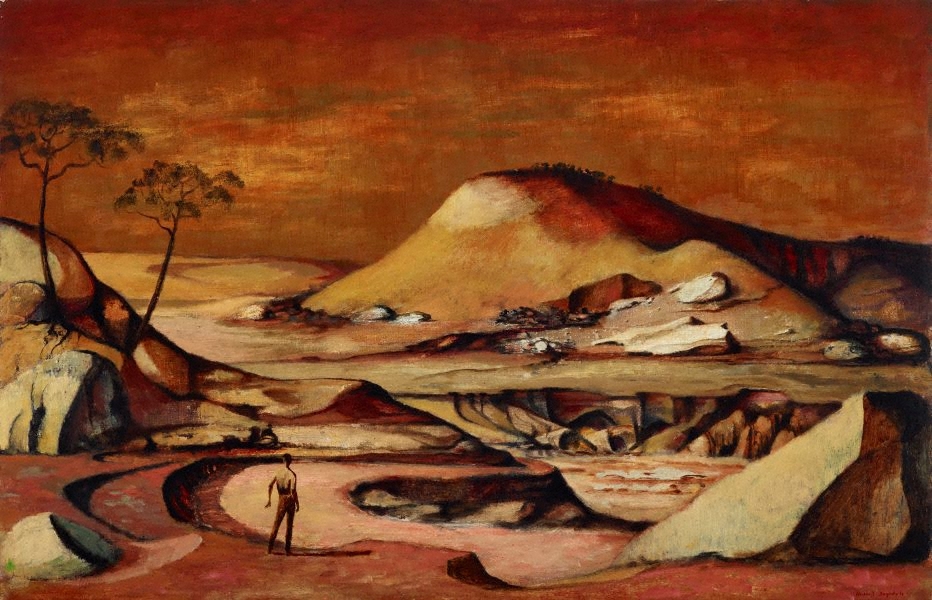
Pippin Louise Drysdale (nee Carew-Reid)
22 Tuckfield Street, Fremantle, Western Australia 6160
Phone: ( +61 ) (8) 9336 2475
Mobile : 0419 162475
Fax: 9433 1195
This email address is being protected from spambots. You need JavaScript enabled to view it.
https://www.pippindrysdale.com

Pippen Louise Drysdale (Nee Carew-Reid) In Her Younger Days

Pippen Louise Drysdale (Nee Carew-Reid) In Her Younger Days
PippenDrysdaleNeeCarew-ReidInHerYoungerDaysPh1.jpg

Home of Pippin Louise (Nee Carew-Reid)
22 Tuckfield Street Fremantle Western Australia A Front View.
Pippin Louise Drysdale (nee Carew-Reid)
22 Tuckfield Street, Fremantle, Western Australia 6160
Phone: ( +61 ) (8) 9336 2475
Mobile : 0419 162475
Fax: 9433 1195
This email address is being protected from spambots. You need JavaScript enabled to view it.
https://www.pippindrysdale.com

Home of Pippin Louise (Nee Carew-Reid)
22 Tuckfield Street Fremantle WA Sun Room View

A Pippen Drysdale Nee Carew-Reid Creation

A Pippen Drysdale Nee Carew-Reid Creation
Pippin Louise Drysdale (Nee Carew-Reid)
Pippen Drysdale (Nee Carew-Reid) Talking About The Process Of Her Ceramic Art Work Part 3.
Objects Of Wonder Pippin Drysdale With Robin Best
https://collection.artgallery.wa.gov.au/persons/7346/pippin-drysdale
Pippin DRYSDALE









A Pippin Louise Drysdale (Nee Carew-Reid) Creation

A Pippin Louise Drysdale (Nee Carew-Reid) Creation
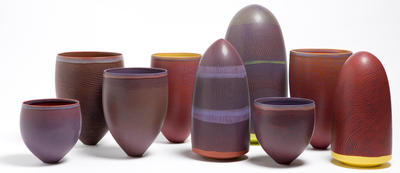
A Pippin Louise Drysdale (Nee Carew-Reid) Creation
Dusk ridge line; 2011; 2012/0046.1-9
Pippin Drysdale





Collection of Porcelain Vessels
Minimus I, Tanamin Trace Series IV vessel (detail)
https://scottish-gallery.co.uk/artists/pippin-drysdale/
Pippin Louise Drysdale (nee Carew-Reid)
22 Tuckfield Street, Fremantle, Western Australia 6160
Phone: ( +61 ) (8) 9336 2475
Mobile : 0419 162475
Fax: 9433 1195
This email address is being protected from spambots. You need JavaScript enabled to view it.
"Drysdale thinks of the development of each series of her vessels, in this case the Tanami series, as a journey back to the sensations and colours that she first experienced traveling through the landscape, engaging with it at a distance and at close quarters.
Both dream and memory are therefore intense fragments of sensation, pattern and colour.
There is no picture, no composition no cipher for the land as whole. There are merely sensations so intense that they can act as a detailed guide to the form of each vessel, to the quality of glazes, the dry, dense or silky surface and the patterns and shadows that fall across it...
...These passionate eidetic memories guide her every move in the studio. Her greatest work happens at the moment that they become the subconscious core of the piece.
All her preparation and research is merely the road to this moment." David Bromfield
Pippin Louise Drysdale (nee Carew-Reid)
22 Tuckfield Street, Fremantle, Western Australia 6160
Phone: ( +61 ) (8) 9336 2475
Mobile : 0419 162475
Fax: 9433 1195
This email address is being protected from spambots. You need JavaScript enabled to view it.
A Pippin Louise Drysdale (Nee Carew-Reid) Creation
A Pippin Louise Drysdale (Nee Carew-Reid) Creation
https://www.pippindrysdale.com

Pippin Louise Drysdale (nee Carew-Reid)
22 Tuckfield Street, Fremantle, Western Australia 6160
Phone: ( +61 ) (8) 9336 2475
Mobile : 0419 162475
Fax: 9433 1195
This email address is being protected from spambots. You need JavaScript enabled to view it.
https://www.pippindrysdale.com
An acclaimed International Artist and Master of Australian Craft, Pippin Drysdale's career as a ceramic artist spans 30 years. Her passion for the craft merges with a love of the landscape, which has travelled across continents and in most recent years has focussed on the vivid dessert landscapes of Australia. Her works evoke a timeless and breathtaking sense of space and place within finely crafted porcelain vessels, narrating the mesmorising vastness of colour experienced in the unique Australian landscape.
Working from her studio in Fremantle, surrounded by the catalogue of her trials and experiments – racks of wonderful pots of all colours and sizes that failed her almost impossible test of quality – Pippin Drysdale continues to interrogate her practice from the perspective of an artist without borders. The Falstaffian spirit that imbues her every action is pitched always at maximum intensity, from her explosive laugh - that fills not only rooms but auditoria - to her extravagant generosity and, of course, to her total commitment to her work.
The process of analysis, review and revision continues until she is convinced she has captured the character of each new series of work. The landscape is the ever-constant lure, the catalyst for work, the connecting point and anchor for each new development. Her works is ambitious. It negotiates interweaving journeys through various landscapes describing her artistic practice and her engagement with the sites she documents. Through a continuing investigation of the flora and landforms of these unique areas of Australia and a commitment to engaging with the cultural, social and political agendas that are shaping them, she is open to embrace each new creative challenge.
Pippen Drysdale captures the spirit of Australia's landscapes

SMH Review Breakaway Sabbia Gallery
Landscapes of porcelain

Ceramic Review Article Joanna Bird
A timeless land

Outside the Mould
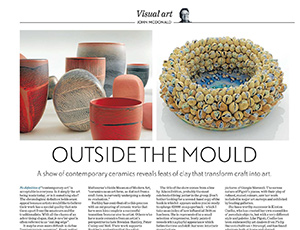
Sydney Morning Herald Review PDF
https://www.adriansassoon.com/artists/pippin-drysdale/
https://www.adriansassoon.com/wp-content/uploads/2017/04/Drysdale-P-Biography-1.pdf
As an artist, I have never wanted to be in the safe zone. Challenges, even when tinged with fear and trepidation, have facilitated and strengthened my artistic practice.
Pippin Drysdale is an acclaimed Australian ceramic artist whose international profile has seen her art works represented in museums, galleries and private collections worldwide.
She has always seen the form as a three dimensional canvas, and to that extent, the form dictates the surface. It is the translation of her intuitive response that she has to her surroundings and her experiences that makes her work so compelling.
Retrospectively, one can see each phase of her creative process and its inspiration, but it is the Australian landscape that is the dominant influence in her work.
Through her lavish use of colour and lustres and her precision of line, she has captured the minutiae of mapping a vast and varied landscape.
Working in Fremantle, Western Australia
2008 Master of Australian Craft, Australia Council for the Arts
1997 to date Adjunct Research Fellow, Curtin University, Western Australia
1986 Curtin University, Western Australia, BA Fine Arts
Pippin Drysdale has work in the following public collections:
Devonshire Collections, Chatsworth House, Derbyshire
National Museum of Scotland, Edinburgh
The Fitzwilliam Museum, Cambridge
Victoria and Albert Museum, London
Farmleigh House and Estate, Dublin, Eire
Museum für Angewandte Kunst, Vienna, Austria
Hetjens-Museum, Düsseldorf, Germany
Lotte Reimers-Stiftung, Deidesheim, Germany
Museum für Kunsthandwerk, Frankfurt, Germany
Museo Civico Palazza dei Colsoli, Gubbio, Italy
Museo Internazionale delle Ceramiche, Faenza Ravenna, Italy
Novosibirsk State Art Museum, Siberia, Russia
Tomsk State Gallery & Museum, Siberia, Russia
Musée Ariana, Geneva, Switzerland
Everson Museum of Art, Syracuse, New York, USA
Fuller Craft Museum, Brockton, Massachusetts, USA
ANZ Bank, Adelaide, Australia
Artbank, Australia
Art Gallery of Western Australia, Perth, Australia
Australian Capital Equity, Perth, Western Australia
Bank of New Zealand, Perth, Western Australia
Campbelltown Arts Centre, Campbelltown, New South Wales, Australia
City of Fremantle, Fremantle, Australia
Edith Cowan University Art Collection, Joondalup, Australia
Manly Art Gallery & Museum, Manly, New South Wales, Australia
Museum and Art Gallery of the Northern Territory, Darwin, Australia
Museum of Applied Arts and Sciences, Sydney, Australia
National Library of Australia, Canberra, Australia
Newcastle Art Gallery, Newcastle, New South Wales, Australia
Queen Victoria Museum and Art Gallery, Launceston, Tasmania, Australia
Queensland Art Gallery & Gallery of Modern Art, Brisbane, Australia
Tasmania Museum and Art Gallery, Hobart, Tasmania, Australia
The Curtin University Art Collection, Perth, Australia
The National Gallery of Australia, Canberra, Australia
The National Gallery of Victoria, Melbourne, Australia
The University of Western Australia Art Collection, Perth, Australia
University of Southern Queensland Art Collection, Toowoomba, Queensland, Australia
The Museum of Modern Ceramic Art, Gifu, Japan
21st Century Museum of Contemporary Art, Kanazawa, Ishikawa, Japan
Auckland Art Gallery, Auckland, New Zealand
Chung-ju National Museum, Chungbuk, South Korea
https://www.adriansassoon.com/artists/pippin-drysdale/
Recent Articles
Visual Masters Arts & Crafts Digital Magazine Issue 1 Autumn 2010
Ceramic Art & Perception - Issue 77 2009, "Pippin Drysdale - The Kimberley Series, The Tanami Traces Series" by Ted Snell
Artlink - Lines of Site' Book Review
The new DRYSDALE - Sally Cox The West Australian 16th June 2007
The Australian 26 May 2007 Victoria Laurie
The West Australian - Visual Arts Ric Spencer 21/7/2007
Articles by Dr David Bromfield: Art Critic and Scholar
A Handful of Gems: Pippin Drysdale’s Tanami Traces Series and her Journey Through Ceramic
Ceramics Art & Perception, December 2002 edition, Pippin Drysdale's Tanami Series written by Dr David Bromfield
Other Articles
Carnegie, Daphne. Tin Glazed Earthenware. UK: Oxford Press, 1993.
Iannou, Norris. Masters of their Craft: Contemporary Decorative and Applied Arts in Australia. Sydney: Craftsman House, 1997.
Lane, Peter. Ceramic Form: Design and Decoration. (rev.) UK, USA, Sydney: Craftsman House, 1997 &1998.
Lane, Peter. Porcelain. UK: Craftsman House, 1995.
Mansfield, Janet. Contemporary Art in Australia and New Zealand. Sydney: Craftsman House, 1995.
Whyman, Caroline. The Complete Potter - Porcelain. UK & USA: unknown, 1995.
Petersen Susan, Craft and Art of Clay (3rd Edition) London: Calman/Thames & Hudson,1999
Artlink Magazine - The Future of Art Vol 19 #2 - A Worthwhile Investment,
The Ceramics of Pippin Drysdale written by Dr Dorothy Erickson pages 16-18, South Australia 1999
Petersen Susan, Contemporary Ceramics London: Calman/King & Hudson, 2000
Ceramics Art & Perception #41 2000 edition, Physical Extension of Memory written by Dr David Bromfield
Petersen Susan, Smashing Glazes London/USA: Calman/King & Hudson, 2001
Australian Ceramic Directory 2001 - Powerhouse Museum NSW (Pottery In Australia)
Artlink Magazine - Art & Enterprise Vol 22 #3 - Backing Winners written by Andrea
Hull Director of Victorian College for the Arts, page 12, South Australia 2002
Artonview - National Gallery of Australia Issue #29 Autumn 2002 - Material Culture - pages 42-48
The Canberra Review, April 6 2002,
Living in a Material World Referencing Material Culture Exhibition
The Canberra Review, May 6-19 2002,
Arts and Culture News Paper
Thorpe In Association with the National Association for the Visual Arts,
Who's Who of Australian Visual Artists, Australia Thorpe 1995
Milner, Sally, Master Works - Decorative & Functional Art, Australia, Sally Milner Publishing Pty Ltd 2002
ArtBank - Dysart, Dinah/Dunn, Jackie, Australian Art in Public Places, Australia, Department of Communications, Information Technology & The Arts 2001
https://artaurea.com/profiles/drysdale-pippin/
| 1943 | Born in Melbourne, Autralia |
| 1986 | Bachelor of Arts (Fine Art), Curtin University of Technology, Western Australia |
| Since 1997 | Adjunct Research Fellow, School of Art , Curtin University of Technology, Western Australia |
| Since 2007 | Master of Australian Craft |
| Website | Link |
The Australian sandstone hills and mountains with their characteristic stripes and coloration are the most important sources of inspiration for Pippin Drysdale’s recent works. Developing a palette of colors and carving the fine lines into the vessels’ surfaces is a time-consuming process, fraught with risk and potentially thwarted by flaws incurred during the subsequent firing process. Yet it’s precisely due to this balancing act that these vessels radiate an inimitable presence that captivates the beholder. Arranged into tablescapes, they represent the topography of ant hills and mountain ranges, of stretches of flat spinifex grassland and steep ridges. The Australian Crafts Council honored Drysdale’s oeuvre by awarding her the title of Master of Australian Craft in 2007.


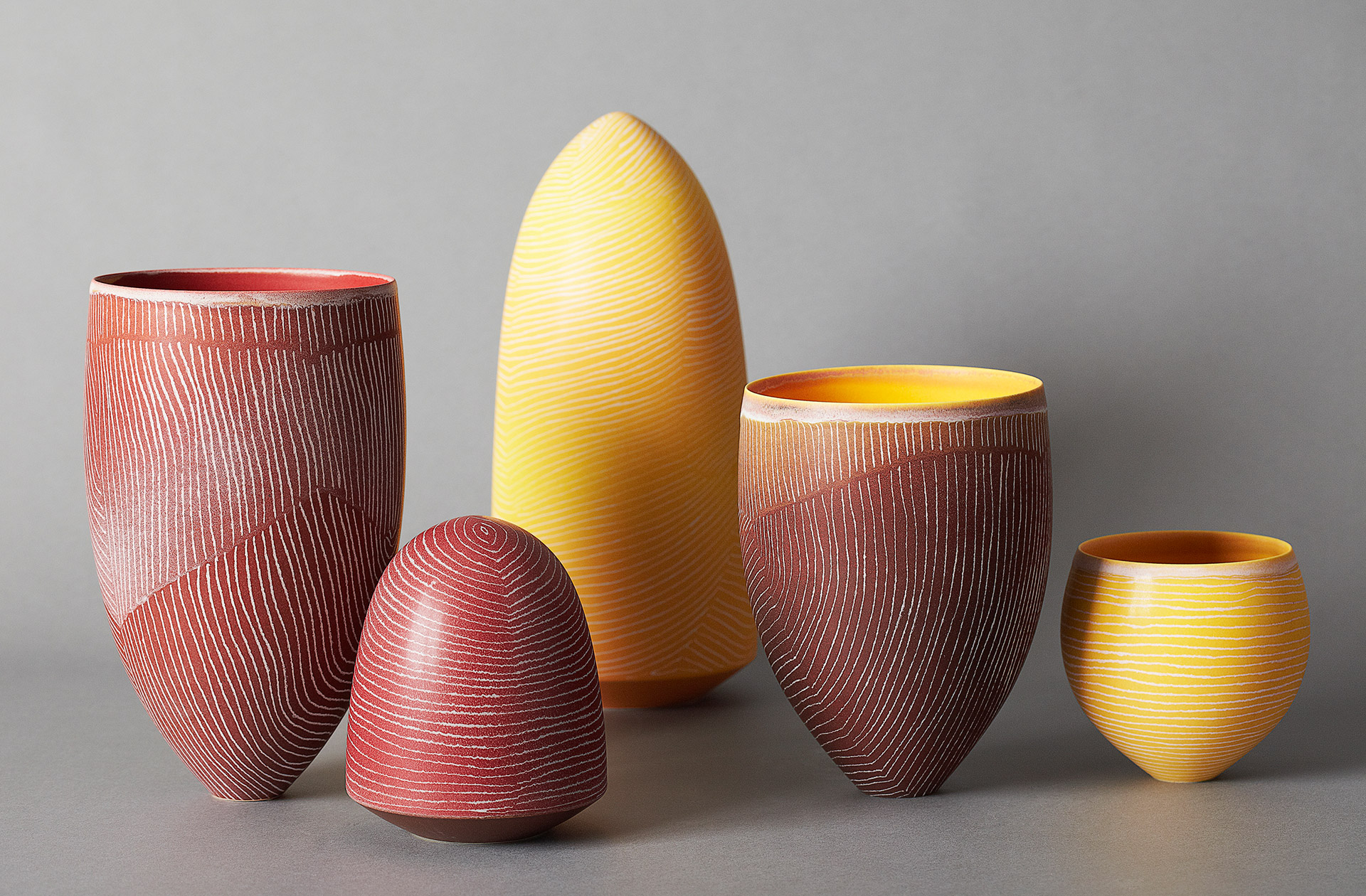


Some History of the Carew Family Name
The surname Carew was taken to Ireland soon after the Norman invasion of England and was Gaelicized as de Carrún. In the 16th century a family called Carew from Devon played an important part in establishing the Tudor administration in Ireland.
Carew is a Welsh and Cornish habitation-type surname; it has also been used as a synonym for the Irish patronymic Ó Corráin. Carey can be a variant.
Carew History, Family Crest & Coats of Arms
https://www.houseofnames.com/carew-family-crest
Motto: J'espere Bien
Motto Translation: I hope well.
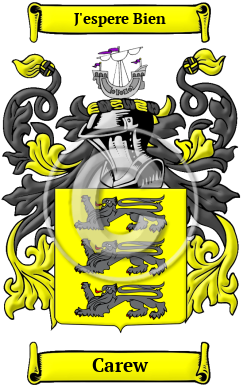
Cornwall, one of the original six "Celtic nations" is the homeland to the surname Carew. A revival of the Cornish language which began in the 9th century AD has begun. No doubt this was the language spoken by distant forebears of the Carew family. Though surnames became common during medieval times, English people were formerly known only by a single name. The way in which hereditary surnames were adopted in medieval England is fascinating. Many Cornish surnames appear to be topographic surnames, which were given to people who resided near physical features such as hills, streams, churches, or types of trees, many are actually habitation surnames. The name Carew is a local type of surname and the Carew family lived in Cornwall. This name is derived from Welsh surname Caeriw, meaning dweller at the fort on the hill.
However, "we come upon a disputed etymology. Mr Carew in his 'Survey of Cornwall' tells us that 'his first ancestor came out of France with William the Conqueror by the name Karrow.' Karo, or Caro, is a Cornish word signifying hart or deer. Dugdale and most other authorities, believe that the family is denominated from Carew Castle in Pembrokeshire."

Early Origins of the Carew family

The surname Carew was first found in Cornwall where the family first established themselves after the Conquest. The family are descended from "Gerald, son of Walter de Windsor, who lived in the reign of Henry I, which Walter was son of Otho, in the time of William the Conqueror."
"In the [parish of Antony in East, Cornwall] have resided for several centuries, many branches of the well known and justly respected family of Carew. Richard Carew, Esq. the celebrated historian of Cornwall, informs us in his Survey of the county, that his ancestors were originally from the continent, and that they came into this kingdom with William the Conqueror. Of the genealogy, progress, and connexion of his family with others, in passing down the stream of time, a detailed account may be found in his work, from page 102 to 106. "
Carew Castle is located in Pembrokeshire, Wales that still stands today and has been held by the Carew family since it was built by Gerald de Winsor who took the name "de Carew" about 1100. " About the year 1300, by the marriage of Sir John de Carru with the coheiress of Mohun, this ancient family first became connected with the county of Devon." 2
One branch of the family was found at Beddington in Surrey from ancient times. "The church [of Beddington], beautifully situated in Beddington Park, close to the ancient mansion, is a handsome edifice with a fine tower, chiefly in the later English style; it was built in the reign of Richard II., and contains some monuments to the memory of the Carew family."
"Harrowbear, or Harroburrow, [in the parish of Calstock, Cornwall] formerly a seat of the Carews of Antony, is now a farm house, and is the property of Mr. John Worth."
Early History of the Carew family
This web page shows only a small excerpt of our Carew research. Another 178 words (13 lines of text) covering the years 1050, 1280, 1323, 1324, 1362, 1363, 1380, 1513, 1514, 1545, 1551, 1555, 1568, 1575, 1580, 1590, 1595, 1609, 1620, 1622, 1626, 1629, 1635, 1639, 1643, 1644, 1660, 1672, 1692, 1693, 1745, 1759 and 1766 are included under the topic Early Carew History in all our PDF Extended History products and printed products wherever possible.
Carew Spelling Variations
Cornish surnames are characterized by a multitude of spelling variations. The frequent changes in surnames are due to the fact that the Old and Middle English languages lacked definite spelling rules. The official court languages, which were Latin and French, were also influential on the spelling of a surname. Since the spelling of surnames was rarely consistent in medieval times, and scribes and church officials recorded names as they sounded rather than adhering to any specific spelling rules, it was common to find the same individual referred to with different spellings of their surname in the ancient chronicles. Moreover, a large number of foreign names were brought into England, which accelerated and accentuated the alterations to the spelling of various surnames. Lastly, spelling variations often resulted from the linguistic differences between the people of Cornwall and the rest of England. The Cornish spoke a unique Brythonic Celtic language which was first recorded in written documents during the 10th century. However, they became increasingly Anglicized, and Cornish became extinct as a spoken language in 1777, although it has been revived by Cornish patriots in the modern era. The name has been spelled Carew, Carrott, Carrow, Carrowe and others.
Early Notables of the Carew family
Notable amongst the family at this time was
- Hugo Carew, High Sheriff of Herefordshire in 1380; Lord George Carew, 1st Earl of Totnes (1555-1629), who served under Queen Elizabeth I during the Tudor conquest of Ireland and was appointed Presiden...
- Bampfylde Moore Carew (1693-1759) was an English rogue, vagabond and impostor, who claimed to be King of the Beggars. He was inspiration of the book The Life and Adventures of Bampfylde Moore Carew wh...
Carew Ranking
In Newfoundland, Canada, the name Carew is the 224th most popular surname with an estimated 194 people with that name. 5
 Migration of the Carew family to Ireland
Migration of the Carew family to Ireland
Some of the Carew family moved to Ireland, but this topic is not covered in this excerpt.
Another 209 words (15 lines of text) about their life in Ireland is included in all our PDF Extended History products and printed products wherever possible.
| + |
An inquiry into the early roots of North American families reveals a number of immigrants bearing the name Carew or a variant listed above:
An inquiry into the early roots of North American families reveals a number of immigrants bearing the name Carew or a variant listed above:
Carew Settlers in United States in the 17th Century
- Gome Carew who settled in Maine in 1607
- Mannes Carew, who arrived in Virginia in 1653 6
- Tho Carew, who arrived in Virginia in 1662 6
- Jacob Carew, who landed in Virginia in 1663 6
- Allen Carew, who arrived in Virginia in 1664 6
- ... (More are available in all our PDF Extended History products and printed products wherever possible.)
Carew Settlers in United States in the 18th Century
Carew Settlers in United States in the 19th Century
- Hugh Carew, who arrived in America in 1805 6
- John Carew, who landed in America in 1807 6
- Richard Carew, who landed in America in 1810 6
- L D Carew, who arrived in San Francisco, California in 1850 6
Carew Settlers in United States in the 17th Century
- Gome Carew who settled in Maine in 1607
- Mannes Carew, who arrived in Virginia in 1653 6
- Tho Carew, who arrived in Virginia in 1662 6
- Jacob Carew, who landed in Virginia in 1663 6
- Allen Carew, who arrived in Virginia in 1664 6
- ... (More are available in all our PDF Extended History products and printed products wherever possible.)
Carew Settlers in United States in the 18th Century
Carew Settlers in United States in the 19th Century
| + |
Some of the first settlers of this family name were:
Carew Settlers in Canada in the 19th Century
- Nicholas Carew, who arrived in Nova Scotia in 1818
- Margaret Carew, who landed in Nova Scotia in 1824
- Letitia Carew, who landed in Nova Scotia in 1831
| + |
Carew Settlers in Australia in the 19th Century
- Daniel Carew, aged 33, a farm servant, who arrived in South Australia in 1850 aboard the ship "Stag" 7
- Michael Carew, who arrived in Adelaide, Australia aboard the ship "Lord Ashburton" in 1850 8
- Daniel Carew, aged 39, a labourer, who arrived in South Australia in 1858 aboard the ship "Utopia"
- Mr. Richard Carew, (b. 1864), aged 21, Cornish settler travelling aboard the ship "Waroonga" arriving in Queensland, Australia on 6th May 1885 9
| + |
Carew Settlers in New Zealand in the 19th Century
- Mr. Ponsonby Carew, British settler travelling from London aboard the ship "Light Brigade" arriving in Lyttelton, Christchurch, South Island, New Zealand on 26th August 1868 10
- Mr. N. Carew, British settler travelling from Gravesend aboard the ship "Queen Bee" arriving in Wellington, New Zealand on 10th January 1872 11
| + |
Carew Settlers in West Indies in the 17th Century
- Richard Carew with his wife Elizabeth, daughter and servants, settled in Barbados in 1680
Carew Settlers in West Indies in the 18th Century
- Walter Carew, who landed in Jamaica in 1780 6
| Contemporary Notables of the name Carew (post 1700) | + |
- Robert Shapland Carew (1818-1881), 2nd Baron Carew
- Stan Carew (1950-2015), Canadian radio broadcaster, musician and actor, best known as a host of the national CBC Radio programs Prime Time and The Entertainers in the 1980s
- Rodney Cline "Rod" Carew (b. 1945), American former Major League Baseball first baseman
- Patrick Thomas Conolly- Carew (b. 1938), 7th Baron Carew
- Charles Robert Sydenham Carew JP (1853-1939), British Conservative politician
- William Francis Conolly- Carew (1905-1994), 6th Baron Carew
- Gerald Shapland Carew (1860-1927), 5th Baron Carew
- George Patrick John Carew (1863-1926), 4th Baron Carew
- Robert Shapland George Julian Carew (1860-1923), 3rd Baron Carew
- Robert Shapland Carew (1787-1856), 1st Baron Carew
- ... (Another 6 notables are available in all our PDF Extended History products and printed products wherever possible.)
| Historic Events for the Carew family | + |
| Related Stories | + |
| The Carew Motto | + |
Motto: J'espere Bien
Motto Translation: I hope well.
The Carew family page
THE (MIS)FORTUNES OF THE CROYDON CAREWS
https://www.croydonist.co.uk/carew-family/
10 December 2020
As I’ve mentioned before, history isn’t my strong point, having sadly dropped the subject at school aged 14. I have a fascination with Croydon’s 20th Century history when our space-age skyline started to form, and I could probably hold my own in a pub quiz if a Croydon history round lightly touched on Elizabethan times and John Whitgift, but any more than where Henry VIII might have stayed whilst he was holidaying in the area and I’d be at a bit of a loss.
It’s a good job we’re joined by guest writer and local historian Tania Rahman to tell us more about Croydon’s past. This week she talks about the rise and fall of the Carew family, who owned an area of Thornton Heath and Norbury for 500 years.
—
When I first moved to Green Lane, Thornton Heath with my family in 1994 I did not really know much about the local history of the area. I was too busy with school, then university where I actually studied English Literature. It was not until I started working at the British Museum that I started to take an interest in the local history of Croydon. I started with archaeological discoveries and historical buildings in Croydon and even as far as Beddington, and then I discovered the historical importance of Norbury and Thornton Heath.
The earliest evidence of civilisation I could find in the Norbury/Thornton Heath area (which was originally known as North Bury) was the discovery of Neolithic flint heads and ancient coins. Saxon coins were discovered in 1862 when Thornton Heath railway was being built; 250 silver coins which were dated during King Alfred’s reign were discovered on Whitehorse Manor Road (along with Frankish and Oriental coins according to the British History Online website). Also, according to the Pollard’s Hill Resident Association website Roman coins were also discovered in Pollard’s Hill, Norbury.
Croydon is on the route between Sussex and London so it made sense that visiting or invading civilisations like the Saxons would leave evidence of their presence or even choose to settle down here.
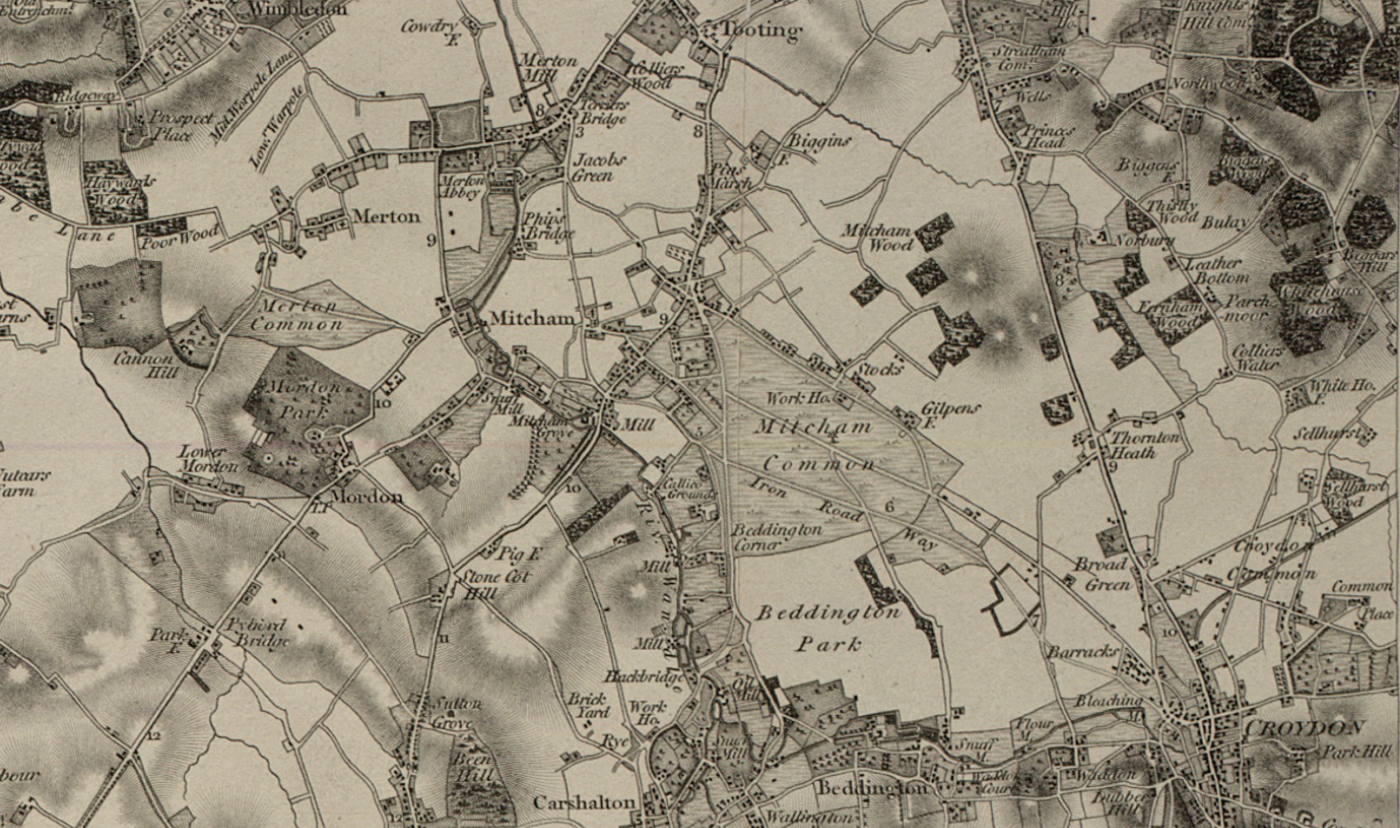
Supposedly a Manor House existed on Bensham Manor Lane. The area was originally called Benchesham and was owned by the Rochester Monks, then by two Bishops of London and an Archbishop of Canterbury. I also discovered that a lot of land had been passed onto royalty or probably been taken over by them. Henry V appeared to own the area and then it seemed to pass to Henry VIII, then his son Edward and then his daughter Mary I.
However Tudor Royalty were never the true owners of Benchesham. By the late 13th century it had been divided into North and South Benchesham; then North Benchesham became North Borough and then Norbury as it is known today. For over 500 years the Carew family owned the area, except for a brief period when Henry VIII owned it. He actually had the owner Nicholas Carew executed on unproven criminal charges to seize his lands, only for his daughter Mary I to restore them to the Carew family.
The Carew family were of noble descent themselves, from the Normans. Nicholas Carew was a cousin of Anne Boleyn and she actually helped him to get a place at court. However Carew disliked Anne and was clearly not grateful for her help as he allowed Henry VIII to court Jane Seymour at another of his residences, Beddington Park, or Carew Manor as it was known then. The Carews are said to have owned land in Norbury and Thornton Heath right up to the 19th century.
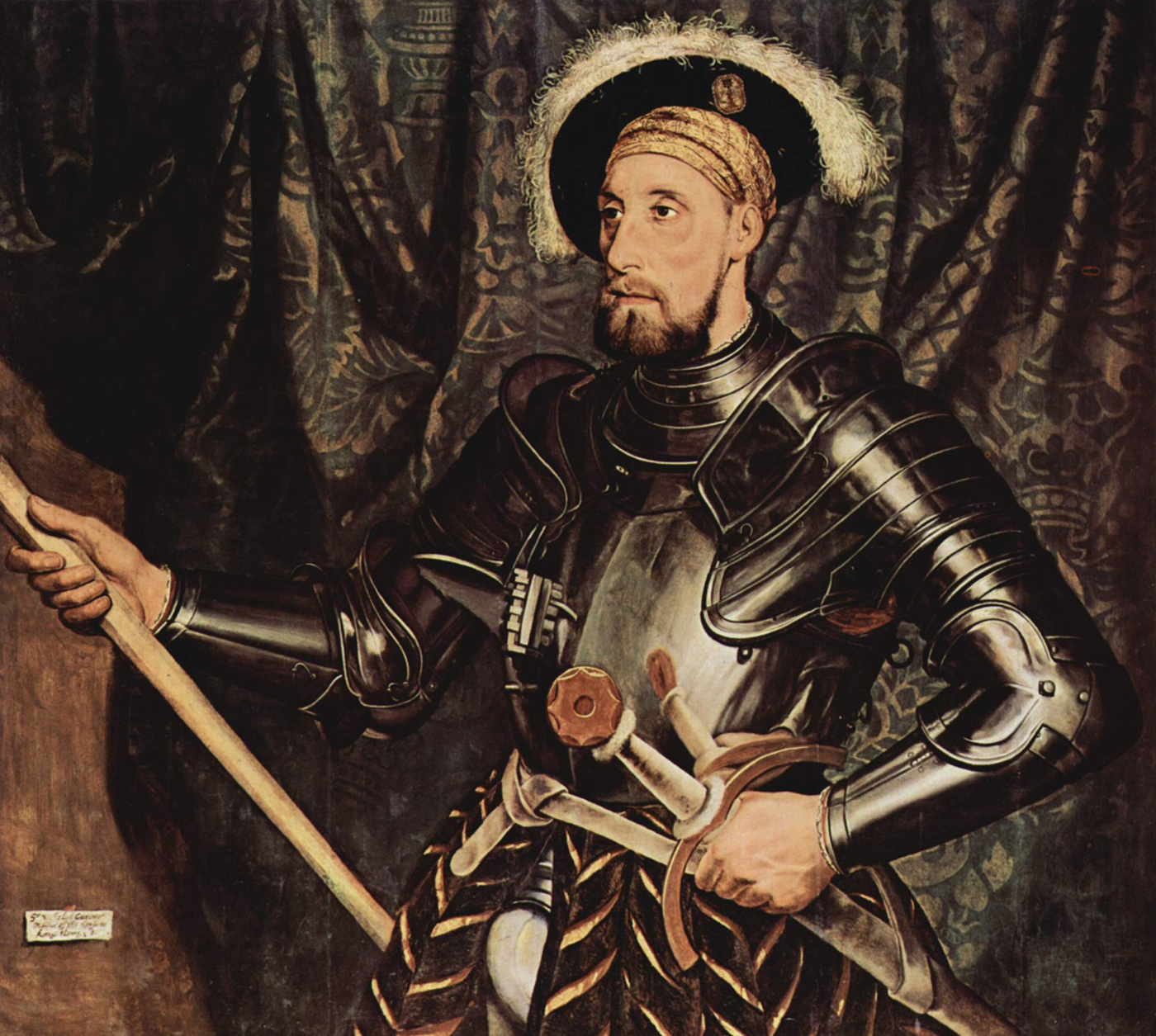
They were also a troubled family. In 1630 Francis Carew fled to France to escape debt and was reprimanded by his father in a letter. By 1634 Francis had returned to England and his own son (whom he had left behind with his wife) had lost his inheritance. Nicholas Carew had also been heavily in debt, had to sell his possessions and even considered leaving his family until he inherited Beddington Estate from his childless uncle Francis Carew I. Even then he still had debts of £4,000 and by the time Francis II, as he was known, died the estate still owed £1,500 in 1649 (over £250,000 in today’s money).
Beddington is also of Saxon, possibly even Roman origin. (Both Croydon and Beddington are built on triangles of energy lines known as ley lines. These triangles intersect to form a Pentagram). Beddington Park was also owned by Walter Raleigh when he married Elizabeth Throckmorton of Carew Manor. Queen Elizabeth I visited him there and both of their ghosts are said to haunt the area.
Posted by Julia and guest writer Tania Rahman
The header image is adapted by the Croydonist and sourced from The Portable Antiquities Scheme/ The Trustees of the British Museum. The map image is a crop from ‘A Vision of Britain through time: This work is based on data provided through www.VisionofBritain.org.uk and uses historical material which is copyright of the Great Britain Historical GIS Project and the University of Portsmouth. The portrait is of SIr Nicholas Carew by Hans Holbein.
Tania Rahman works at the British Museum and attended Old Palace School from 1988 to 1993.
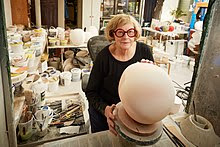
Pippin Drysdale on Sunday Arts
Pippin Louise Drysdale (nee Carew-Reid)
22 Tuckfield Street, Fremantle, Western Australia 6160
Phone: ( +61 ) (8) 9336 2475
Mobile : 0419 162475
Fax: 9433 1195
This email address is being protected from spambots. You need JavaScript enabled to view it.
After selling their Alexanders Coffee Shop in a suburb of Perth. which was financed from funds from his brother's company ....in the late 1970's and early 1980's, Wayne Hastings Carew-Reid and his solicitor wife Anne Marie Carew-Reid, of 5 Francis Street, Mosman Park, Western Australia, started Starkeys Pest Control Solutions Business in Wangara, in Perth Western Australia, also backed by funds from his brother's company .... it is understood that Wayne and Anne Carew-Reid sold the Starkey's business for around $20 million dollars to the multi Billon Pound UK PestWest Group, part of Killgerm Chemicals Ltd
Today, Killgerm Group Ltd is proud to announce the completion of its acquisition of the Starkeys Products business. Based in Perth, Western Australia, Starkeys Products has been producing high quality insect light traps and electric fly killers under the Starkeys brand for the Australian, New Zealand & Asian markets for over 4 decades. More recently, the business has also diversified into the manufacture of bespoke toolbox systems under the Brute Toolboxes brand.
Commenting on the acquisition, Rupert Broome, Killgerm Group Managing Director, said: “Our PestWest Division has been competing with Starkeys Products for many years, and in that time we have developed a deep respect for the quality of the Starkeys products, their market penetration, and – most importantly – the dedication and professionalism of the staff within the Starkeys Products business.
We see many synergies between the PestWest and Starkeys businesses, in terms of products, customers and geographic coverage. Acquiring a strategic manufacturing asset in Australia will also complement and strengthen the existing global footprint for the PestWest Division, alongside existing operations in the USA, the UK and in China.
Cultural fit is also extremely important to us, and I am delighted that the existing management team, led by Adam Carew-Reid as CEO, will continue to drive forward the Starkeys business, now with the added benefit of the resources of the whole of Killgerm Group to support their efforts.”
Given the strength of the product and company name, Starkeys Products will continue to trade under that name, as part of the PestWest Division.
Adam Carew-Reid, CEO of Starkeys Products, added:
“We are delighted to now be part of Killgerm Group; the joining of businesses is truly a substantial step forward for the future of Starkeys Products. We will continue to manufacture our products to the same high standard in Australia, while maintaining our renowned personal service & regular contact with our all customers around the globe.
I am looking forward to an exciting future with Killgerm Group, which is both professional & highly respected in the pest control industry. Our businesses will share a great synergy, while enjoying the added benefits of each other’s experience in the international market”.

Australian Acquisition Announced By Killgerm Group Ltd
https://www.killgerm.com/australian-acquisition-announced-by-killgerm-group-ltd/
www.pestwest.com.au
Founder and owner of Ezy Retaining Walls
Wayne Carew-Reid Bassendean WA 6054 0417 098 302
Attended Christ Church Grammar School
https://obafiles.ccgs.wa.edu.au/Mitre/1968-december.pdf
1968-december.pdf - Christ Church Grammar School
LLOYD CAREW-REID
- MUSICIAN New York, United States






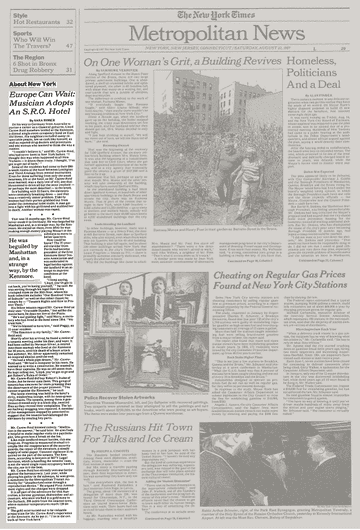
On his way to Germany from Australia to pursue a career as a classical guitarist, Lloyd Carew-Reid somehow landed at the Kenmore, a dismal single-room occupancy hotel on East 23d Street. His neighbors included many respectable people, low on cash like himself, as well as reputed drug dealers and prostitutes and one woman who seemed to think she was a rooster.
''I couldn't believe it,'' said Mr. Carew-Reid, who had never been to New York before. ''I thought this was what happened to all New Yorkers - it drove them crazy. I thought, 'I've got to get out of here.' ''
Some of the residents had come to their $90-a-week rooms at the hotel between Lexington and Third Avenues from mental institutions. Even for those suffering from only the usual neuroses, life at the hotel, as Mr. Carew-Reid soon learned, was a daily test of will, one that threatened to drive all but the most resilient -or perhaps the most detached - to the brink.
In a building with 22 floors, the elevators were constantly breaking down - and that was a relatively minor problem. Elderly women had their purses grabbed out from under the communal toilet stalls. A man got into a fight with his girlfriend and stabbed her to death. Another woman was raped.
That was 18 months ago. Mr. Carew-Reid never made it to Germany. He was beguiled by Manhattan and, in a strange way, by the Kenmore. He stayed on there, even after he was making enough money playing Mozart in the subways to move to better quarters.
How could he leave? The 37-year-old traveler from Perth had become president of the first Kenmore Hotel Tenants Association and was embroiled in legal battles against the landlord in an attempt to improve conditions at the hotel. ''I keep saying, 'Lloyd, you've got to cut back, you're losing yourself,' '' he said. He was sorting through his legal files in his cramped room on the 20th floor, where his book collection includes ''One Hundred Years of Solitude'' as well as that other classic he swears by - ''Tenants Rights and How to Protect Them.''
His fellow tenants regard Mr. Carew-Reid as their own ''Crocodile Dundee,'' but unlike the movie hero, he does not live at the Plaza.
''He's our guiding light,'' said Mary, a secretary who has lived at the hotel since 1954. ''We trust him.''
''We're blessed to have him,'' said Peggy, an 11-year resident.
''The Kenmore is my family,'' Mr. Carew-Reid said.
Shortly after his arrival, he found a notice of a tenants meeting under his door, and went. It had been called by Norman Silvar, a retired merchant seaman who lived at the Kenmore for 30 years, until his death of a heart attack last summer. Mr. Silvar apparently remained an inspired idealist until the end.
''He had a whole pipe dream,'' Mr. Carew-Reid said. ''He had a computer in his room. He wanted us to write a constitution. He wanted to have floor captains. He was an old union man. He kept telling me, 'Lloyd, you've got to go and get Robert's Rules of Order.' ''
Mr. Carew-Reid did buy Robert's Rules of Order, but he never uses them. This group of tenants has concerns far more pressing than the observance of the proper protocol. ''You cannot organize the Kenmore,'' he said.
The latest meeting was held in the hotel's dirty, windowless lounge, with its neon-green vinyl chairs. The tenants, among them a gentleman dressed only in a black slip, swatted flies as they recited their complaints. The latest hallway mugging was reported. A member of the management stopped by uninvited to suggest that the tenants had sabotaged the elevators by stealing key parts.
Mr. Carew-Reid listened calmly. ''Meditation is the answer,'' he said later. He also finds it helpful to make regular visits to a psychologist, who gives him a break on the fee.
Like most landlord-tenant battles, this one drags on. Progress is measured in small triumphs like the reappearance of the security guards, the repair of the elevators, a steady supply of toilet paper. Constant vigilance is required on the part of the tenants. The Kenmore, according to lawyers at MFY Legal Services, which is handling the tenants' case, is not the worst single room occupancy hotel in the city, nor is it the best.
Mr. Carew-Reid has already won one battle against the bureaucracy. Last year, while playing his guitar in the subways, he was given a summons by the Metropolitan Transit Authority for ''unauthorized noise through a reproduction device.'' He argued First Amendment rights and the charges were dropped.
It is all part of the adventure for this Australian, a former gymnast, dishwasher and accountant, who once worked in a gold mine in the Outback, 200 miles from the nearest town, where summer temperatures reach 120 degrees.
The gold mine turned out to be valuable preparation for Mr. Carew-Reid's experience at the Kenmore. As he put it: ''I'm in the outback of New York here.''
This Is Against My Rights!
For three years Lloyd Carew-Reid, a classical guitarist living in New York City, played a cat-and-mouse game with Manhattan cops. What the man wanted to do was make music in the subway system, hoping his melodies would coax some change out of commuters’ pockets. But there were rules against such conduct. In time Carew-Reid, an Australian, got down on himself for trying to make a living in so frustrating a fashion. Then one night a banal but correct notion changed his life. “This is America!” was his thought. “They can’t do this to me! It’s against my constitutional rights!” The musician and the First Amendment double-teamed the court and won. These mornings you can catch him happily playing below-ground Bach at 59th and Lexington, where he says, “It’s a free world down here now.”
So it goes throughout this litigious land. In Wisconsin, Selena Fox, a witch, is fighting local zoning laws so that she may conduct religious ceremonies on her property. In Oklahoma, Lucille McCord and Joann Bell, two mothers, successfully ended school prayer with a suit, then, after Bell was assaulted and her home burned, the women sued again and won undisclosed damages from the school district of Little Axe. In Montana, Donna Todd filed her tax return after typing on her 1040 form, “Signed involuntarily under penalty of statutory punishment.” The Internal Revenue Service fined her $500 for filing a “frivolous” return. Todd and the courts battle on. Here and there, sanctuary, sanctuary, sanctuary is all the word. Kay Kelly of Tucson, for example, was placed under house arrest for refusing to give the name of the Guatemalan she had sheltered. She contended her right to keep silent on the name was a religious issue.
Well, one could go on, but the point is that the civil docket still makes room for more than whiplash, malpractice, what have you, still accommodates the citizen who has nothing grander to gain than the Republic’s concession that he was right and it was wrong, which is pretty grand. In Louisiana, a Vietnamese schoolgirl, no bigger than a pencil sharpened to a nub, had no larger scheme than to publish a newspaper for the “out crowd” at her Louisiana high school, but she ran afoul of her principal nonetheless. In California, a black entrepreneur who sports a thick thatch of provocative dreadlocks and enjoys late-night strolls, even in white neighborhoods, didn’t particularly care for being stopped 15 times for vagrancy. He felt that his looks, race and whereabouts were what had invited police inquiry and that these things added up to undue cause. Neither the schoolgirl nor the entrepreneur gave up; they went to the bench.
None of these people are larger-than-life Jimmy Stewarts in a Frank Capra piece; rather, they are obscure citizens who felt slighted on their home patch and sought redress. As subjects, they are what crusty journalists of another age called the “little people.” Forty years ago, Joseph Mitchell, the New Yorker writer, bridled at this condescension: “They are as big as you are, whoever you are.” With that in mind, herewith the cases of the guitarist, Carew-Reid; the student, Cat Nguyen; and the entrepreneur, Edward Lawson.
Lloyd Carew-Reid, the street musician from Perth, is a squirrelly little guy, blond beard, soft speech, 37 years old, who lives on the rim of the Chelsea area of Manhattan in a dog-eared hotel where drug deals and muggings go down every month or so, where one mad woman thinks she’s a rooster. His home environment to some would seem a nightmare; his work environment to most would seem hell. After a day of breathing the iron filings in the New York City subways, one would think he could blow his nose and sink a Hudson River liner. Worse, a braking train in a tunnel in this town can sound like a ten- ton banshee caught in a vise. And yet there he sits, caressing an acoustic guitar in bedlam, playing Bach and Mozart, Francisco Tarrega and Erik Satie, and one of the reasons he got his back up about it was that the city had the gall to hit him with an environmental charge: making unnecessary noise.
In 1985 the Metropolitan Transit Authority issued 3,000 summonses for “unauthorized noise through a reproduction device,” a catchall ordinance that covered radios as well as musical instruments, amplified or no. In April of the following year, Carew-Reid was also ticketed three times for “solicitation for entertainment.” “Right,” the guitarist said sarcastically. “It’s a horrible situation down there, and it should remain so.” What really got his goat was “the bureaucratic arrogance of it all. Rules. Rules. You’ve got to have rules. How can rules apply to aesthetics?”
The transit authority replied that musicians setting up shop on densely packed platforms posed safety problems. Said a spokesman: “We do not allow any unsanctioned playing of instruments on the subways.” Carew-Reid chose to challenge the constitutionality of the authority’s rules against his unsanctioned playing. The T.A. dropped all charges against Carew-Reid in January, stopped issuing summonses to musicians (unless they are found to be blocking an entrance or interfering with train operations — rare instances, both), and said it would rewrite its regulations.
“It was the best possible victory,” Carew-Reid says. “I was almost developing a hate-cop mentality. Now I feel pleased when I see one come up. Sometimes they say, ‘That was nice.’ “
One recent drizzly morning, a lot of people expressed similar sentiments. “God bless you,” a woman said in a note she dropped into the musician’s guitar case, along with a dollar. “Lovely,” said others. “Just beautiful.” At the end of the day, the guitarist pockets between $40 and $60, his normal take. Then he returns to the fleabag he calls home, takes up his duties as president of the tenants’ association and works for better housing conditions.
“This is America, isn’t it? People don’t have to live in squalor.”
1985-95: Forgotten history of activism
On Thursday, BuskNY and City Lore will host an evening of songs and stories in a first commemoration of the 1985 case People v Manning, the first to explicitly provide constitutional protection to New York City’s subway performers.
But though Manning was a crucial step forward for performers, it was far from a definitive legalization. The preparation for this program has led us across a trove of documents that reveal a story of legalization more complex and more hard-fought than what is often told. This post will seek to rectify the paucity of information on that era by presenting a few of the performers, activists, and original documents that shaped the period.
The chapter of subway history most familiar to today’s performers is the 1985 case People v. Manning. In that case, “punk-folk vagabond” guitarist Roger Manning contested tickets he received, in the spring of 1985, under the then-current MTA regulation 1051.3, which forbade riders to “entertain passengers by singing, dancing or playing any musical instrument.”
In the first case where constitutional protection was explicitly granted to subway performance, the court found in his favor, establishing rule 1051.3 as “unconstitutionally violative of the First and Fourteenth Amendments,” relying on NYCLU lawyer Art Eisenberg’s citation of previous First Amendment protection in the 1968 case People v St Clair:
In her decision, Judge Diane Lebedeff notes that the NYCTA “amended its regulation concerning disorderly conduct effective June 14, 1985.” In that amendment, in which the modern-day rule 1050.6 was created, the TA “no longer place[d] a prohibition on any kind of entertainment.” In other words, in the nick of time before the release of the Manning decision, the TA had already removed its explicit restriction on performance.
Still, in practical terms, People v. Manning and the accompanying rules change left the subway little safer for most performers. Summonses continued to be written, not only on pretexts like blocking traffic, but also under the new 1050.6(b) ban on “solicit[ing] money for goods, services or entertainment.” Although performers accepted donations rather than soliciting them, this nuance was lost on MTA agents — and on police as well.
Worse, the MTA attempted to describe membership in the new program Music Under New York as a legal requirement:
Enter Lloyd Carew-Reid, an Australian-born classical guitarist who chose to contest the MTA’s summonses. Carew-Reid’s fight stuck, both legally and in the public eye. Ultimately, the MTA was forced, according to a January 30, 1987 AP article, “to put a moratorium on issuing summonses” to subway performers. (Later, in 1989, it would issue the new rule 1050.6(c), recently publicized during the arrest of Andrew Kalleen, which for the first time explicitly stated that “artistic performance, including the acceptance of donations” was permitted).
For this reason, Carew-Reid argued in performer and journalist Stephen Witt’s long-running column The Street Singer’s Beat circa 1989, “Roger [Manning]’s case [only] brought on a new law, ‘No entertainment for the purpose of soliciting’. My case actually changed the policy. That’s why for the last two years, nobody has been ticketed.” In a word, then, 1987 saw the practical legalization of performance as the MTA ceased to systematically issue tickets; 1989 would then see explicit allowance of busking, under 1050.6 (c).
Carew-Reid and his advocacy organization, Subway Troubadours Against Repression (STAR), went on, in a historical series of public hearings, to successfully fight a proposed rules change banning performance on platforms. STAR also fought a ban on amplifiers on the platforms, arguing that the rights of those performers whose genres inherently involve amplification were being violated. (This argument resulted in a stay against the amplifier ban by the Second Circuit Court of Appeals, but was ultimately rejected. Amplifiers remain banned on the platform, but are permitted on the mezzanine level).
Following STAR’s lengthy fight to protect performers, the gap was filled, in the late 1990s, by the Street Performers Advocacy Project, which emerged from the pioneering academic work of Susie Tanenbaum. SPAP produced a written pamphlet to advise performers of their rights, and informed countless more through a widely-cited online resource, the Know Your Rights guide.

Still, despite these decades of advocacy, the safety of subway performers remains precarious. Due to inaccurate media coverage of Music Under New York auditions, which erroneously suggest MUNY membership to be a legal requirement or “permit,” performers continue to be wrongfully ejected, ticketed, and even arrested.
As one such arrestee, I have channeled my experience into co-founding BuskNY, which has spoken out for threatened performers. Others, including Erik Meier and Andrew Kalleen, have spoken out, with Kalleen’s video alone reaching 1.5 million viewers online.
The most recent chapter of subway performance history has thus seen greater attention brought to the legality of performance — and, we hope, a move toward the definitive end of the oppression fought by Manning, Carew-Reid, STAR, SPAP, and many more.
Charges dropped
This is the second post in our case database series.
I would write up today’s news that the charges associated with my July 25th arrest were dropped, but there’s very little fanfare to report. When my name was called in court, I didn’t even have fifteen seconds of fame: the judge asked if I was indeed named Matthew Christian, I said I was, and she said: “alright, you’re all set.” And that was that: no paperwork, and not the least crumb of a sense that the city regrets having had me arrested for playing the violin.
There is one very important piece of take-away information from these: having video evidence of your arrest is important. In the video I took, my arresting officer insists that I’m not allowed to perform without a permit. That claim — which he used on video to justify my arrest — doesn’t hold water legal, as there is no such permit. The police flirted briefly with charges for blocking traffic, but since the police in the video had raised no concern about traffic, and since there had been no visible problem with traffic, they changed to a very dated state law concerning train stations.
The assistant district attorney handling my case could evidently see that wouldn’t fly. My Legal Aid attorney informed me a week ago that they had spoken by phone and that the charges would be dropped.
Could this case have gone differently? Sure: my arrest on 6/18 involved precisely the same circumstances, but because I didn’t take a video, I’m still charged with blocking traffic. If my arresting officer from 7/25 claimed that I was blocking traffic, it’s patently obvious that he’s lying; but if my arresting officer from 6/18 claims the same thing, it’s his word against mine. That case will be resolved tomorrow, and unfortunately, the lack of video means I’ll have to accept an ACD.
Case closed: disorderly traffic summons
This is the first post in our case database. Hoping it grows, to give performers more information about dealing with legal threats in the future.
We had some good news in court today — not for me, but for a friend. She had been issued a pink summons for playing the guitar and singing at 53rd St. Once again, the charge didn’t fit the crime artistic performance: she was facing §240.20, ‘Disorderly Conduct.’ The statute reads:
A person is guilty of disorderly conduct when, with intent to cause public inconvenience, annoyance or alarm, or recklessly creating a risk thereof:
[…]
5. He obstructs vehicular or pedestrian traffic.
Of course, it could have been worse: she could have been charged with section 7, “[creating] a hazardous or physically offensive condition by any act which serves no legitimate purpose.” These laws are so hurtful!
On a more serious note, she went in for her court date and reports having had the charges immediately dropped. So that’s a victory for sanity, for music, and for culture. Cheers, all!
Sun Arts Pippin Drysdale
Ochre Pit Series I
Pippin Drysdale on Sunday Arts

About the artwork of Pippin Louise Drysdale (Nee Carew-Reid)
Pippin Louise Drysdale's (nee Carew-Reid) Artist's Statement

Pippin Louise Drysdale (Nee Carew-Reid)
Born Naarm | Melbourne, Victoria
Lives and works Boorloo | Perth
About the artist Pippin Louise Drysdale (Nee Carew-Reid)
Born in 1943, Pippin Drysdale has been working in the same studio in Fremantle for over 45 years. As the “foremost interpreter of the Australian landscape in the field of ceramics”, Drysdale’s exquisite works are the result of endless experimentation with colour, line and shape, reflecting the remote and grandiose geology of the famous Kimberley or Pilbara regions, as well as her keen interest in Australia’s First Nation peoples. Through her lavish use of colour and her precision of line, she distills the vast and varied landscape, as well as its flora and its fauna, into her ceramic forms.
In 2015, Pippin Drysdale was honoured by the Government as a State Living Treasure. These distinguished honours are offered to artists whose artistic achievements merit exceptional recognition and whose contribution to the State offers an ongoing unequalled legacy. Additionally, in 2020 she was the recipient of an Honorary Doctorate from Curtin University, where she also has the distinction of a retrospective exhibition.
One the Esplanade artist profile — Australia.chevron.com
https://australia.chevron.com/
Pippin Drysdale - Joanna Bird : Joanna Bird
https://www.joannabird.com/
An acclaimed International Artist and Master of Australian Craft, Pippin Drysdale’s career as a ceramic artist spans 40 years. Her passion for the craft merges with a love of the landscape, which has travelled across continents and in most recent years has focused on the vivid desert landscapes of Australia.
Her works evoke a timeless and breathtaking sense of space and place within finely crafted porcelain vessels, narrating the mesmerising vastness of colour experienced in the unique Australian landscape. The landscape is the ever-constant lure, the catalyst for making, the connecting point and anchor for each new development. Her works is ambitious. It negotiates interweaving journeys through various landscapes describing her artistic practice and her engagement with the sites she documents.
Through a continuing investigation of the flora and landforms of these unique areas of Australia and a commitment to engaging with the cultural, social and political agendas that are shaping them, she is open to embrace each new creative challenge.
Pippin Drysdale has been chosen as one of Western Australia’s 15 Living Treasures. The 2015 State Living Treasures Award recipients were chosen by a panel of distinguished members of the arts and culture community.
Price range: from £1,200
Gallery - click images to enlarge
Porcelain Open Vessel
Pyrites Lustre Series
2017
H 13 x D 14 cm Ref. JB125 POA
A Pippin Louise Drysdale (Nee Carew-Reid) Creation
A Pippin Louise Drysdale (Nee Carew-Reid) Creation
A Pippin Louise Drysdale (Nee Carew-Reid) Creation
Breakaways series
Porcelain Open Vessel and Marbles
L – R
H 25 x D 17 cm Sold
H 30 x D 22 cm Sold
H 16 x D 12 cm
H 11 x D 15 cm
Ref. JB204, JB139, JB201, JB202 POA

Breakaways series Porcelain Open Vessel and Marbles
L – R
H 27 x D 28 cm
H 24 x D 15 cm Sold
H 27 x D 20 cm
H 11 x D 15 cm
Ref. JB87, JB206, JB205, JB202 POA
Breakaways series
Porcelain Open Vessel and Marbles
L – R
H 17.5 x D 15.5 cm
H 13 x D 14 cm Sold
H 23 x D 18 cm
Ref. JB207, JB203, JB138
POA
A Pippin Louise Drysdale (Nee Carew-Reid) Creation
Westonia Lights Mine Marble V, Westonia Lights Mine III, Devils Marbles III >
Left: H 30 x W 27 cm
Middle: H 20 x W 17 cm Sold
Right: H 21 x W 20 cm
Ref. JB111, JB109, JB84 POA
Porcelain Open Vessel
Pyrites Lustre Series
2017
H 22 x D 22 cm Ref. JB113
Pyrites Lustre CXV > Sold
Porcelain Open Vessel
Pyrites Lustre Series
2017
H 12 x D 16.5 c Ref. JB116
The Devils Marbles series
Porcelain forms with gold and platinum lustre
Tallest H 26cm POA
Porcelain open vessel
H 16 x D 18 cm Ref. JB91 POA
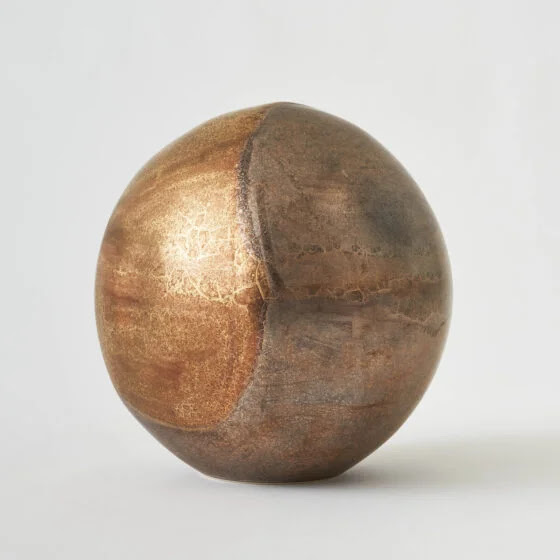
London
W4 3QE
Some artist's work is subject to VAT
About Joanna Bird >>
Privacy Policy >>
Tel: +44 (0) 208 995 9960
Open by appointment only except during exhibitions

Pippin Louise Drysdale (Nee Carew-Reid)
Biography
Drysdale was born in Melbourne in 1943 into a wealthy family, and grew up in Perth from the age of three.[3] Her father, John Hastings "Bunny" Carew-Reid, was a successful businessman and real estate developer.[5] As a teenager she had art lessons from William Boissevain. At school, she excelled at art, but struggled with other subjects due to an undiagnosed vision problem that, although eventually discovered and corrected at age 12, set her on a rebellious course during her formative years.[5] She failed her Junior Certificate at Methodist Ladies' College, Perth. After leaving school, she attended a business college, from which she was expelled, and then a technical college, where she failed all subjects.[6] She then worked for a short stint at her father's company as a typist, then as a secretary in Canberra, then worked odd jobs in England for a year, and traveled throughout Europe. Returning to Australia in the early 1960s, she moved to Melbourne, married Christopher Drysdale in 1967 (divorced in 1972),[7] and had a son, Jason. In Melbourne she began selling art (Mexican paper flowers sold as "Pip’s Flowers").[3] She returned to Fremantle, Perth in the 1970s, and started a successful business selling herbs. Through a relationship with a potter who made ceramic structures for her herbs, Drysdale first discovered clay. That led to an Advanced Diploma in Ceramics at Western Australia School of Art and Design in 1982, followed by a 1982 trip to America where she studied with Daniel Rhodes and Toshiko Takaezu at the Anderson Ranch Art Center. Rhodes encouraged her to further her education at university level; Takaezu told her to ignore traditions and create her own sensibilities and techniques to suit her own environment.[8] Returning to Australia, Drysdale obtained a Bachelor of Arts (Fine Art) at Curtin University in 1986.[9]
After graduating, she worked and studied at Grazia Deruta Majolica Pottery, the Artists’ Union of Russia, Tomsk State University and Banff Centre for Arts and Creativity.[10]
Career
Drysdale is a painter, a colourist, whose chosen canvases are ceramics. She draws inspiration from the landscapes of Australia’s vast desert country.[2] Places that inspire her include the Pilbara, the Eastern Goldfields-Esperance
Early career
Drysdale went from an initial period of throwing bowls to making slab plates that she used as canvases for expressionistic drawing with coloured slips, glazes, and resists.[4] She cites Willem de Kooning as an early influence.[4] Her early work is notable for eschewing the "brown sauce" that often douses craft pottery in favour of "complex colours and nervous decoration".[14]
Maturity
Moving from slab plates to thrown vessels, Drysdale still retained her spontaneous style of decoration. She likes pure, simple forms where the forms do not intrude on the canvas-like aspects of the vessel. After residencies in Europe, the USA and Russia, during which she learned about majolica decoration and lustres, she produced the Totem and Carnivale
Western Australia inspired the series Landscape Lustre (1994), Pinnacles (
This glaze and lustre period reached its apogee in the Pakistan series, where multiple, liberal layers of glaze were followed each time by dousing in paraffin wax, scraping back, and filling.[4]
Late period
Drysdale moved from the toxicity of waxes and lustres to the much safer Liquitex medium, which also allowed her to further refine her line work.[4]
A 1998 airplane flight Drysdale took over northern Australia stands out to her as a key turning point. Flying low over Australia's Great Sandy Desert and the Tanami Desert, she was deeply impressed by the endless lines of parallel sand dunes stretching to the horizon, and their repetitive interplay of shadow and light. The linearity of her work also echoes the exposed rock strata everywhere to be seen in Australian deserts, so that truly "her ceramics are grounded in the tonal and linear patterns of the land".[15] She was also influenced by indigenous painting (she owns works by indigenous artists Queenie McKenzie and Kitty Kantilla)[16][17] and painter Fred Williams.[4] McKenzie's influence can be seen in the serried, stacked segments of landscape that recede to the horizon line, and Kantilla's influence is clearly evident in the motif of parallel, slanting or vertical lines within these landscape segments.
Coalescing all these influences and ideas together, Drysdale arrived at her signature style of intense colour and fine linework in the first Tanami series called Red Desert (Frankfurt, 2003), which was a great success.[4] Her technique encompasses the selection of a suitable vessel, the adding the layers of glaze, then the careful linear incisions with a knife through a masking resist to inscribe the tracery that defines and shapes each work. Because the masking medium quickly dries into a form too hard to inscribe, Drysdale can work only on one small section at a time. The inscribed lines are then brushed out and filled with thickly applied colour, and the excess colour is removed.
A Pippin Louise Drysdale (Nee Carew-Reid) Creation
Installation of 2018 work inspired by Devils Marbles by Pippin Drysdale
Another feature of Drysdale's later oeuvre are her assemblages of asymmetrical pieces, suites of closed forms that echo geological features of Australia, such as the Devils Marbles series, inspired by the Karlu Karlu / Devils Marbles Conservation Reserve in the Northern Territory.[18]
Drysdale finds constant renewal of self in the creative process, dating back to her earliest contact with clay:
Finally, I decided to take up clay. I can't believe that I'm still sitting here today, committed to clay. I finally found something that I thought was going to be a life time thing. I think the thing about being a ceramic artist, a potter, is that you are constantly learning and are challenged by it so you never get bored. You're just constantly extending yourself in lots of ways.[19
Studio
Drysdale's studio for the last 30 years has been her home in the port of Fremantle, a worker's cottage, now heavily renovated, bought for her by her father.[7] Her pottery is thrown by Warrick Palmateer, a fellow Curtin graduate. She has a studio team of helpers to do the glaze mixing, colour testing, firing, bisque-ware sanding, internet work and shipping of work. The porcelain clay is pugged multiple times, wrapped to "sweat" for four weeks, then repugged before use.[20]
Collections
Drysdale's works are found in many private collections. She is represented in Australia by Sabbia Gallery.[21] The 12th Duke of Devonshire, Peregrine Cavendish, has a large collection (over 100) of Drysdale's works.[22][23]
Her work is represented in the collections of the National Gallery of Australia, Art Gallery of Western Australia, Powerhouse Museum, Auckland Art Gallery, Queensland Art Gallery, Tasmanian Museum and Art Gallery, Museum and Art Gallery of the Northern Territory, National Museum of Scotland, Museum of Fine Arts, Gifu, Tomsk State Gallery and Museum, Novosibirsk State Art Museum, as well as in the Victoria and Albert Museum ceramic collection, London.[24]
Honours
- Western Australia’s State Living Treasures in 2015
- Lifetime Achievement Award — Artsource Australia[3]
- Major Fellowship Grant from Australia Council for the Arts in 2007[25]
Gallery
Early work[edit]

A Pippin Louise Drysdale (Nee Carew-Reid) Creation |

A Pippin Louise Drysdale (Nee Carew-Reid) Creation |
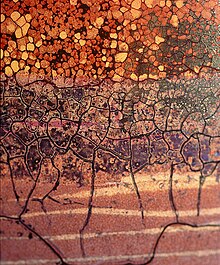
|
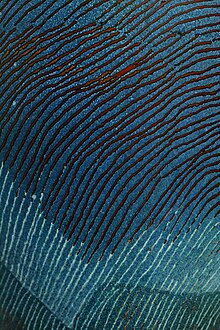
A Pippin Louise Drysdale (Nee Carew-Reid) Creation |
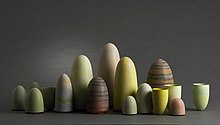
A Pippin Louise Drysdale (Nee Carew-Reid) Creation |
See also
- Australian art
-
Notes
- ^ Cousins, Kerry-Anne. "Art in the palm of your hand at the Mini Ceramics show at Bilk Gallery in Manuka". The Sydney Morning Herald. Retrieved 14 October 2018.
- ^ Jump up to:a b "Pippin Drysdale and Warrick Palmateer together at the John Curtin Gallery". Mirage News. Retrieved 14 October 2018.
- ^ Jump up to:a b c d e "Pippin Drysdale". Department of Local Government. Government of Western Australia. Retrieved 15 October 2018.
- ^ Jump up to:a b c d e f g h i Howlin, Jan (6 June 2018). "Indesign Luminary: Pip Drysdale". Indesignlive. IndesignMediaAsiaPacific. Retrieved 18 October 2018.
- ^ Jump up to:a b Snell (2007), p. 45.
- ^ Snell (2007), p. 47.
- ^ Jump up to:a b Snell (2007), p. 52.
- ^ Snell (2007), p. 65.
- ^ Snell (2007), p. 67.
- ^ Snell (2007), p. 70.
- ^ Wilson, Laetitia. "Refined Ceramics Define Career". The West Australian. Retrieved 14 October 2018.
- ^ Firth, Rob (18 November 2015). "Pippin Drysdale – WA State Living Treasure". Retrieved 22 April 2020.
- ^ "Western Australian State Living Treasures 2015" (PDF). West Australia Government. Retrieved 22 April 2020.
- ^ Snell (2007), p. 69.
- ^ Osborne, Margot (2007). "Pippin Drysdale; Design, Craft and the Smart Syndrome". Artlink. 27 (3): 76. Retrieved 23 October 2018.
- ^ Snell, Ted. "Close Focus: Interpreting Western Australia's Visual Culture" (PDF). Curtin University. Retrieved 20 October 2018.
- ^ Snell, Ted. "Artist Statement" (PDF). Pippin Drysdale official site. P Drysdale. Retrieved 20 October 2018.
- ^ Yeoman, William (20 October 2018). "Dual Dose of Natural Mastery". The West Australian.
- ^ "Pippin Drysdale (Carew-Reid)". Methodists Ladies' College. Retrieved 18 October 2018.
- ^ Martin, Tony (March 2014). "Pippin Drysdale Is an Enigma: An Interview with Tony Martin". Ceramics Art & Perception. 95: 8–13. ISSN 1035-1841. Retrieved 16 October 2018.
- ^ "Pippin Drysdale". sabbia gallery. Retrieved 14 April 2021.
- ^ Laurie, Victoria (13 October 2018). "Thrown Together". The Australian. Retrieved 14 October 2018.
- ^ Herdman, Sue. "Illustrious Collection". Ceramic Review. No. March 2019. Ceramic Review Publishing Ltd.
- ^ Snell (2007), p. 34.
- ^ "Artist's Resume" (PDF). Pippin Drysdale. Retrieved 18 October 2018.
References
- Snell, Ted (2007). Pippin Drysdale: Lines of Site. Fremantle Press. ISBN 978-1-92073-119-9.
Further reading
- McAuliffe, Annemie (November 2016). "The Devils Marbles 2016: A transformative direction for Pippin Drysdale". Journal of Australian Ceramics. 55 (3): 50–54. ISSN 1449-275X. Retrieved 16 October 2018.
External links
RELATED ARTICLES
- Queenie McKenzieAustralian artist (c. 1915–1998)
- Kitty KantillaAustralian Aboriginal painter
- Warrick PalmateerAustralian studio potter and art teacher (born 1969)
Time Magazine - Judiciary
By GREGORY JAYNES Monday, Jul. 06, 1987

Lloyd Carew-Reid who is a classical guitarist living in New York City,
who once played a cat-and-mouse game with Manhattan cops to fight
for the rights for buskers to make music in the New York Subways. now continues to campaign average American's constitutional rights...
"This is America!" was his thought.
"They can't do this to me! It's against my constitutional rights!"
The musician and the First Amendment double-teamed the court and won.
For three years Lloyd Carew-Reid, a classical guitarist living in New York City, played a cat-and-mouse game with Manhattan cops. What the man wanted to do was make music in the subway system, hoping his melodies would coax some change out of commuters' pockets. But there were rules against such conduct. In time Carew-Reid, an Australian, got down on himself for trying to make a living in so frustrating a fashion. Then one night a banal but correct notion changed his life. "This is America!" was his thought. "They can't do this to me! It's against my constitutional rights!" The musician and the First Amendment double-teamed the court and won. These mornings you can catch him happily playing below-ground Bach at 59th and Lexington, where he says, "It's a free world down here now."
So it goes throughout this litigious land. In Wisconsin, Selena Fox, a witch, is fighting local zoning laws so that she may conduct religious ceremonies on her property. In Oklahoma, Lucille McCord and Joann Bell, two mothers, successfully ended school prayer with a suit, then, after Bell was assaulted and her home burned, the women sued again and won undisclosed damages from the school district of Little Axe. In Montana, Donna Todd filed her tax return after typing on her 1040 form, "Signed involuntarily under penalty of statutory punishment." The Internal Revenue Service fined her $500 for filing a "frivolous" return. Todd and the courts battle on. Here and there, sanctuary, sanctuary, sanctuary is all the word. Kay Kelly of Tucson, for example, was placed under house arrest for refusing to give the name of the Guatemalan she had sheltered. She contended her right to keep silent on the name was a religious issue.
Well, one could go on, but the point is that the civil docket still makes room for more than whiplash, malpractice, what have you, still accommodates the citizen who has nothing grander to gain than the Republic's concession that he was right and it was wrong, which is pretty grand. In Louisiana, a Vietnamese schoolgirl, no bigger than a pencil sharpened to a nub, had no larger scheme than to publish a newspaper for the "out crowd" at her Louisiana high school, but she ran afoul of her principal nonetheless. In California, a black entrepreneur who sports a thick thatch of provocative dreadlocks and enjoys late-night strolls, even in white neighborhoods, didn't particularly care for being stopped 15 times for vagrancy. He felt that his looks, race and whereabouts were what had invited police inquiry and that these things added up to undue cause. Neither the schoolgirl nor the entrepreneur gave up; they went to the bench.
None of these people are larger-than-life Jimmy Stewarts in a Frank Capra piece; rather, they are obscure citizens who felt slighted on their home patch and sought redress. As subjects, they are what crusty journalists of another age called the "little people." Forty years ago, Joseph Mitchell, the New Yorker writer, bridled at this condescension: "They are as big as you are, whoever you are." With that in mind, herewith the cases of the guitarist, Carew-Reid; the student, Cat Nguyen; and the entrepreneur, Edward Lawson.
Lloyd Carew-Reid, the street musician from Perth, is a squirrelly little guy, blond beard, soft speech, 37 years old, who lives on the rim of the Chelsea area of Manhattan in a dog-eared hotel where drug deals and muggings go down every month or so, where one mad woman thinks she's a rooster. His home environment to some would seem a nightmare; his work environment to most would seem hell. After a day of breathing the iron filings in the New York City subways, one would think he could blow his nose and sink a Hudson River liner. Worse, a braking train in a tunnel in this town can sound like a ten- ton banshee caught in a vise. And yet there he sits, caressing an acoustic guitar in bedlam, playing Bach and Mozart, Francisco Tarrega and Erik Satie, and one of the reasons he got his back up about it was that the city had the gall to hit him with an environmental charge: making unnecessary noise.
In 1985 the Metropolitan Transit Authority issued 3,000 summonses for "unauthorized noise through a reproduction device," a catchall ordinance that covered radios as well as musical instruments, amplified or no. In April of the following year, Carew-Reid was also ticketed three times for "solicitation for entertainment." "Right," the guitarist said sarcastically. "It's a horrible situation down there, and it should remain so." What really got his goat was "the bureaucratic arrogance of it all. Rules. Rules. You've got to have rules. How can rules apply to aesthetics?"
The transit authority replied that musicians setting up shop on densely packed platforms posed safety problems. Said a spokesman: "We do not allow any unsanctioned playing of instruments on the subways." Carew-Reid chose to challenge the constitutionality of the authority's rules against his unsanctioned playing. The T.A. dropped all charges against Carew-Reid in January, stopped issuing summonses to musicians (unless they are found to be blocking an entrance or interfering with train operations -- rare instances, both), and said it would rewrite its regulations.
"It was the best possible victory," Carew-Reid says. "I was almost developing a hate-cop mentality. Now I feel pleased when I see one come up. Sometimes they say, 'That was nice.' "
One recent drizzly morning, a lot of people expressed similar sentiments. "God bless you," a woman said in a note she dropped into the musician's guitar case, along with a dollar. "Lovely," said others. "Just beautiful." At the end of the day, the guitarist pockets between $40 and $60, his normal take. Then he returns to the fleabag he calls home, takes up his duties as president of the tenants' association and works for better housing conditions. "This is America, isn't it? People don't have to live in squalor."
A year ago this spring Cat Nguyen was 16, an honors student at West Jefferson High School, just across the Mississippi River from New Orleans, and an editor of a soon-to-be mimeographed school paper called Your Side. Five years before that she had reached this country from Viet Nam, with no command of English. Having come so far so quickly, she thought the world was at her ! feet -- until Principal Eldon Orgeron saw the paper and banned it.
He had not been consulted, Orgeron said; what was more, he seemed to read the paper's tone as seditious. Nguyen went to the American Civil Liberties Union. "I had to do it to prove I can fight for my rights and to show other kids they can fight for theirs."
He had not been consulted, Orgeron said; what was more, he seemed to read the paper's tone as seditious. Nguyen went to the American Civil Liberties Union. "I had to do it to prove I can fight for my rights and to show other kids they can fight for theirs."
Nguyen is one of those wunderkinds who inspire pride, envy or both. Her mother came from Saigon to New Orleans in 1980 to be near a brother. Cat soon followed. Her mother got a job teaching elementary school and rented a long, skinny house -- a shotgun house -- hard by the levee in the little town of Gretna. Cat conquered English, became an honors student and grew to a height of 4 ft. 9 in. She also got an after-school job in a grocery, where she has to stand on a case of beer to reach the cash register.
Last year, as part of a class project on freedom of the press, she and her friend Regina Saenz and a couple of casual contributors put out their 14-page mimeographed paper. They thought they were being ironic, funny, irreverent. They included references to unresponsive counselors, the selling of term papers, sex, drugs, cheating. "Don't try to cheat unless you're really sneaky, have years of experience and sit way in the back of the class," they wrote in a parody of an advice column. To a would-be dropout, they preached, "Just stay home, get a job at some gas station, get married, have a couple of kids, and before you know it, you'll be 70."
"This was not responsible journalism," said Orgeron. "This school does not extol those kinds of things. That's why this paper has to stop." The principal seized the last 30 of the 150 copies Cat had run off. She had sold the rest at 50 cents a pop. The young woman likes to tell her own story:
"I used to be a waitress in a restaurant, and I knew some lawyers, and they told me to call the American Civil Liberties Union. For a week they didn't accept me. They thought I was just some student mad at my principal. When they did accept me, the A.C.L.U. contacted the school and threatened to take it to court. The school board's lawyers settled out of court. I got the right to print more issues, but I couldn't sell it. We had no money. How could I print without selling?
"I could not sue without parental approval because I'm underage, and my mother works for the school board and she wouldn't sign. If I had my way, I would have taken it all the way. At the end of the school year I decided to publish another issue. Since I couldn't sell it, it came mostly out of my pocket. I just wanted to prove my rights. It made the teachers mad. The principal said he decided not to censor it -- with the lawyers and everything he didn't have the right -- but he just wanted to sound tough."
What dispirited her about the ordeal, the student says, was the apathy of the student body. "I wanted a paper for the majority, the D students. The minority, the A students, have their own paper, the official paper, the Jolly Roger. But when my paper came out, the minority was against me and the majority couldn't have cared less. I wanted to be a lawyer and change the world. But when I saw the minority wasn't with you and the majority didn't care, it looked to me just like politics. I have decided to become a doctor and help people whether they want it or not. I don't want to have anything to do with politics."
Cat Nguyen was graduated from West Jefferson High last month with perfect scores and a four-year Martin Luther King Scholarship to Brandeis University, where she will start the long road toward becoming a physician.
"The dictum that for every wrong there is a right is not true reality. There are a lot of people out there who have been wounded, with no remedy." This is Ed Lawson talking, and can he talk. It is a stunning San Francisco dawn, and Lawson has rejected an invitation to breakfast. "I do not like to do two pleasurable things at once, converse and eat. I find one gets in the way of the other. We'll find someplace outdoors to languish." In moments he secures a public bench not far from Union Square, and occupies it with a self- assurance that all but says aloud, "I am a taxpayer. This is mine."
Lawson ran into trouble in San Diego, where, as an "avid pedestrian," he was stopped repeatedly for vagrancy on his midnight walks, prosecuted twice and convicted once under a provision of the state's penal code that required him to produce "credible and reliable" identification for any police officer who had reason to be suspicious. Lawson saw the matter simply: he was black, his looks were not conventional, and he was treading white sidewalks. His suit called the law unconstitutionally vague and said it violated the Fourth Amendment's guarantee against "unreasonable searches and seizures" and the Fifth Amendment's self-incrimination protection. The U.S. Supreme Court did not subscribe all the way with Lawson, but it did agree that the statute was % too vague to satisfy the due-process clause of the 14th Amendment. Today Ed Lawson's nightly constitutionals are nobody's business.
"I took a terrible beating for years," Lawson says, drinking in the day. "Somewhere back in here is Melvin Belli's office." He sweeps an arm round San Francisco. "I sat there. He said, 'No remedy. No money in it.' I went to the best-known attorneys, the highest priced. They said by and large you don't win against the police department. They didn't understand that I knew I could beat them on my own turf, the media. Most people who can communicate, communicate. Those who can't, carry guns. I thought surely at some point sanity would prevail. But they would not give up, and so it went all the way to the Supreme Court."
In May 1983, the night the Supreme Court struck down the California statute that the San Diego police had used to nail Lawson for vagrancy, Lawson, who was called the California Walkman in headline shorthand, was all over the networks, sauntering, as the news programs had it, wherever he pleased. He said at the time, "If you are one of those individuals who, over coffee and the morning paper, says, 'This is terrible. Somebody ought to do something about this,' you will probably see the person who should do something when you look in the mirror to shave."
To this day he keeps his principles handy, as you would a wallet. Born 41 years ago in Buffalo, he remembers blacks rapping in the streets in a time before they were called raps. "They were always saying, 'They won't let me do this.' My frequent comment would be, 'Who are they?' Much of my life has been uncovering that prevailing myth."
Somewhere along the line, Lawson, an odd duck by any measure, got press smart. He knew he was photogenic, he knew he was bright, and he knew his cause was right. Innocent black man arrested for taking a hike? It was a natural. The notoriety his case received has led to his involvement in other "meaningful battles," as he calls them.
Lawson makes a living in an ill-defined sort of way. "I'm neither a butcher, a baker nor a candlestick maker. I do joint ventures with the entertainment industry. I'm a member of the Screen Actors Guild. I wrote a screenplay. I've got a horrendous project involving the integration of entertainment with education. You want to call me a consultant? Will your stomach settle? Okay, I'm a consultant. But really I do whatever the Sam Hill I want to." Lately he has been involved in something called Pro Per Inc., + which is "attempting to de-lawyer and re-people the American court system by encouraging Americans to represent themselves in court." And there is something Lawson calls the "Unauthorized Commission on the Bicentennial of the United States Constitution." He is publishing a biweekly pamphlet called Common Cents, which encourages the common man to celebrate his favorite part of the Constitution in his own way, as opposed to what Lawson sees as a white, snobbish celebration along the Potomac.
"The measure of an advanced civilization is how it treats its worst people, not its best," he says, rising from his bench. "Those who have the most reason to celebrate a Constitution are the poorest. The people in the BART ((Bay Area Rapid Transit)) station. That gentleman asleep on that bench over there." Then Lawson strides away, a man with a purpose.
New York Times
New York Times
About New York; Europe Can Wait: Musician Adopts An S.R.O. Hotel
By SARA RIMER
Published: Saturday, August 22, 1987
On his way to Germany from Australia to pursue a career as a classical guitarist, Lloyd Carew-Reid somehow landed at the Kenmore, a dismal single-room occupancy hotel on East 23d Street. His neighbors included many respectable people, low on cash like himself, as well as reputed drug dealers and prostitutes and one woman who seemed to think she was a rooster.
''I couldn't believe it,'' said Mr. Carew-Reid, who had never been to New York before. ''I thought this was what happened to all New Yorkers - it drove them crazy. I thought, 'I've got to get out of here.' ''
Some of the residents had come to their $90-a-week rooms at the hotel between Lexington and Third Avenues from mental institutions. Even for those suffering from only the usual neuroses, life at the hotel, as Mr. Carew-Reid soon learned, was a daily test of will, one that threatened to drive all but the most resilient -or perhaps the most detached - to the brink.
In a building with 22 floors, the elevators were constantly breaking down - and that was a relatively minor problem. Elderly women had their purses grabbed out from under the communal toilet stalls. A man got into a fight with his girlfriend and stabbed her to death. Another woman was raped.
That was 18 months ago. Mr. Carew-Reid never made it to Germany. He was beguiled by Manhattan and, in a strange way, by the Kenmore. He stayed on there, even after he was making enough money playing Mozart in the subways to move to better quarters.
How could he leave? The 37-year-old traveler from Perth had become president of the first Kenmore Hotel Tenants Association and was embroiled in legal battles against the landlord in an attempt to improve conditions at the hotel. ''I keep saying, 'Lloyd, you've got to cut back, you're losing yourself,' '' he said. He was sorting through his legal files in his cramped room on the 20th floor, where his book collection includes ''One Hundred Years of Solitude'' as well as that other classic he swears by - ''Tenants Rights and How to Protect Them.''
His fellow tenants regard Mr. Carew-Reid as their own ''Crocodile Dundee,'' but unlike the movie hero, he does not live at the Plaza.
''He's our guiding light,'' said Mary, a secretary who has lived at the hotel since 1954. ''We trust him.''
''We're blessed to have him,'' said Peggy, an 11-year resident.
''The Kenmore is my family,'' Mr. Carew-Reid said.
Shortly after his arrival, he found a notice of a tenants meeting under his door, and went. It had been called by Norman Silvar, a retired merchant seaman who lived at the Kenmore for 30 years, until his death of a heart attack last summer. Mr. Silvar apparently remained an inspired idealist until the end.
''He had a whole pipe dream,'' Mr. Carew-Reid said. ''He had a computer in his room. He wanted us to write a constitution. He wanted to have floor captains. He was an old union man. He kept telling me, 'Lloyd, you've got to go and get Robert's Rules of Order.' ''
Mr. Carew-Reid did buy Robert's Rules of Order, but he never uses them. This group of tenants has concerns far more pressing than the observance of the proper protocol. ''You cannot organize the Kenmore,'' he said.
The latest meeting was held in the hotel's dirty, windowless lounge, with its neon-green vinyl chairs. The tenants, among them a gentleman dressed only in a black slip, swatted flies as they recited their complaints. The latest hallway mugging was reported. A member of the management stopped by uninvited to suggest that the tenants had sabotaged the elevators by stealing key parts.
Mr. Carew-Reid listened calmly. ''Meditation is the answer,'' he said later. He also finds it helpful to make regular visits to a psychologist, who gives him a break on the fee.
Like most landlord-tenant battles, this one drags on. Progress is measured in small triumphs like the reappearance of the security guards, the repair of the elevators, a steady supply of toilet paper. Constant vigilance is required on the part of the tenants. The Kenmore, according to lawyers at MFY Legal Services, which is handling the tenants' case, is not the worst single room occupancy hotel in the city, nor is it the best.
Mr. Carew-Reid has already won one battle against the bureaucracy. Last year, while playing his guitar in the subways, he was given a summons by the Metropolitan Transit Authority for ''unauthorized noise through a reproduction device.'' He argued First Amendment rights and the charges were dropped.
It is all part of the adventure for this Australian, a former gymnast, dishwasher and accountant, who once worked in a gold mine in the Outback, 200 miles from the nearest town, where summer temperatures reach 120 degrees.
The gold mine turned out to be valuable preparation for Mr. Carew-Reid's experience at the Kenmore. As he put it: ''I'm in the outback of New York here.''
A version of this article appeared in print on Saturday, August 22, 1987, on section 1 page 29 of the New York edition.
1. How Not to Be Hated on Facebook: 10 More Rules
2. Sizing Up Obama's First 100 Days
3. How to Defeat Pirates: Success in the Strait
4. The Chinese Navy: How Big a Threat to the U.S.?
5. Governor Perry's Tantrum: So What if Texas Secedes?
6. Why New York Is No Place to Try Somali Pirates
7. The Looming Crisis in Commercial Real Estate
8. 25 More Things I Didn't Want to Know About You
9. Obama's Growing Dilemma on Torture Prosecution
Know Your Rights!
A Guide for Subway Musicians & Other Performers
(revised edition, © 2004)
Prepared by Susie Tanenbaum with The Street Performers Advocacy Project and City Lore
You have a right to perform in the subways, on the sidewalks and in the parks of New York City. The purpose of this guide is to clarify your rights and responsibilities as public space performers, especially when you are setting up underground. We also hope that officers in the New York Police Department, Station Managers, and hearing officers will find this guide useful when they are implementing New York City Transit regulations permitting subway performances.
The Street Performers' Advocacy Project was formed in 1996 as a coalition of musicians and activists who were united in their belief that street and subway performers make a valuable contribution to this city. They decided that a guide would advance their goal of encouraging spontaneous expression and a sense of community whenever and wherever possible. In the same spirit, we have revised the guide to reflect more recent court rulings and current government policies. Now that the guide is on the web, we hope to update it on a more regular basis.
The sections of this guide are as follows:
SOME HISTORY shows that, as a street performer, you are carrying on a tradition that is as old as civilization itself.
YOUR RIGHTS AND RESPONSIBILITIES outlines the New York City Transit regulations, and explains what you are authorized to do.
COURT DECISIONS IN YOUR FAVOR highlights many of the legal rulings that uphold the rights of street and subway performers.
THE TRANSIT POLICE explains the role of officers underground and suggests some options for dealing with confrontations.
TRANSIT POLICE FACT CHECK is a quick reference so that you know what is true and what is false.
STATION MANAGERS explains their role and suggests ways to handle confrontations.
MUSIC UNDER NEW YORK describes the MTA's music program and how it co-exists with freelance performances.
LEGAL ASSISTANCE lists names of attorneys who have agreed to be contacted for advice.
PERFORMING ON THE STREETS AND IN THE PARKS provides basic information about recent rulings and policies affecting performances in the city's other major public spaces.
OUR VIEWS is where we share with you how we think the rules governing subway music could be improved.
CONFRONTATION SHEETS are intended to help you document problems you might have while performing in public spaces.
Here are some abbreviations that you will come across in this guide:
MTA: Metropolitan Transportation Authority
NYCT: New York City Transit
NYPD: New York Police Department
MUNY: Music Under New York
Please let us know what you think of this guide! You can reach us at: (212) 529-1955 or at This email address is being protected from spambots. You need JavaScript enabled to view it..
Thanks,
Susie Tanenbaum, Street Performers' Advocacy Project
Steve Zeitlin, City Lore
There have been street performers as long as there have been streets. In ancient Egypt and Greece, people entertained and passed the hat for donations. During the Middle Ages—in Europe, troubadours were the personal street performers of the aristocrats, while minstrels and jongleurs brought joy to the general public.
In colonial America, twelve-year-old Benjamin Franklin sang on the streets of Philadelphia! At the turn of the century, immigrants helped to make street performing popular in New York. There were German marching bands and Italian organ grinders—"hurdy gurdies"—who serenaded women below their tenement windows and during the Great Depression, banjo players set up on subway and elevated platforms.
Government authorities never knew exactly what to make of street performing. They seemed to think its spontaneity was a threat to law and order. In the 1930s, New York Mayor Fiorello LaGuardia called them beggars (he defended the poor but disapproved of panhandling), and he made it illegal to perform on New York City's streets.
Although street performing was allowed once again after 1970, subway performances were illegal until the 1980s. And yet the elevated and underground subway platforms were not quiet. Artists still expressed themselves and attracted an audience underground. In the 1940s, for example, Woody Guthrie, Pete Seeger, and others involved in the growing Urban Folk Revival Movement pulled out guitars while waiting for their trains. Not only did they reclaim public space, they believed that songs could change social conditions.
In the early 1960s, young African American and Italian American men sang doo-wop inside subway cars and received donations from appreciative riders. In 1987, with the creation of an official MUNY (Music Under New York) program, public performers have been re-recognized by authorities. The program is now funded and directed by the MTA Arts for Transit office.
Whether you were raised in New York City or in a country with its own street performing tradition, you are helping to carry on a venerable urban tradition.
YOUR RIGHTS AND RESPONSIBILITIES
YOU HAVE A RIGHT TO PERFORM IN THE NEW YORK CITY SUBWAY SYSTEM
The New York City Transit (NYCT) is the subdivision of the Metropolitan Transportation Authority (MTA) that operates the city's subways and buses. The NYCT authorizes these types of free expression in subway stations:
"Public speaking; distribution of written materials; solicitation for charitable, religious or political causes; and artistic performances, including the acceptance of donations [emphasis added]."
The statement we just quoted comes from Section 1050.6 (c) of the New York City Transit rules and regulations governing "non-transit use of transit facilities". As a consequence of the regulations, these activities are also protected by the First Amendment of the United States Constitution [See the end of this guide for the full text of the regulations]. Government (in this case, the NYCT) can only regulate the time, place, or manner in which the activities are presented, and only if restricting them advances a substantial government interest. This translates into the following restrictions on performances:
• setting up at least 25 feet from a token booth
• setting up at least 50 feet from the marked entrance to an NYCT office or tower
• not blocking access to an escalator, stairwell or elevator
• not interfering with transit services or passenger movement in general
• not performing in an area where construction is underway
• not performing during a public service announcement
• not performing above 85 dBa measured at 5 feet, or above 70 dBa measured at 2 feet, from a token booth
• not performing in subway cars
YOU DO NOT NEED A MUNY PERMIT TO PERFORM IN THE SUBWAYS
Some subway performers are members of the MTA's Music Under New York program, also known as MUNY. Other performers are independent, and in this guide we refer to them as freelancers.
MUNY schedules performances on designated mezzanines in the subway system and commuter railroad terminals. You have to pass an audition to become a member of MUNY. Twice a month, MUNY members receive a schedule ("permit"), which gives them priority in the spots where they are scheduled to perform. You do not have to be a MUNY member to perform in the subway system! Also, MUNY has nothing to do with subway platforms.
YOU HAVE A RIGHT TO PERFORM ACOUSTIC MUSIC ON SUBWAY PLATFORMS
Freelancers are authorized to perform on subway platforms. But the NYCT prohibits the use of amplification devices on platforms, including battery-operated Mouse amps and microphones. Freelancers, just like MUNY members, may use amplification when they perform on subway mezzanines.
NO CASSETTE TAPE OR CD SALES: Neither MUNY members nor freelancers are authorized to sell recordings in the subway system. Many of them do anyway, and they risk getting ticketed by the Transit Police or having their work confiscated.
YOU CAN FREELANCE IN PARTS OF GRAND CENTRAL TERMINAL
Freelancers can request a special "permit to engage in non-commercial activity" to perform in Grand Central Terminal's 42nd Street Passage or in the Graybar Passage. Requests have to be made at least 2 days in advance. The permits are good for 7 days. Write to: General Superintendent, Metro-North Commuter Railroad Company, Grand Central Terminal, 89 East 42nd Street, New York, NY 10017.
By the 1970s, street performers in many U.S. cities were going to court to have their Constitutional rights upheld. Here are some highlights:
- Goldstein v. Town of Nantucket 477 F.Supp. 606 (D. Mass. 1979) established that street music, even when performed for donations, is protected First Amendment activity: "The fact that plaintiff troubadour accepted contributions of passersby during his public performance would not dilute his protection under the First Amendment."
- In Davenport v. Alexandria, Va. 683 F2d 853 (1983), 748 F2d 208 (1984), the court held that there were no valid safety arguments to stop musicians from performing: "There has been shown no safety interest to outweigh the plaintiff's First Amendment interests."
- As for the New York subways, already in the 1960s People v. St. Clair 56 Misc.2d 326 (Criminal Ct. N.Y. Cty. 1968) ruled that "for First Amendment purposes, no distinction can be wrought between a subway platform and the public street."
Still, until 1985, musical performances were not permitted in New York's subway system. Then guitarst Roger Manning received a ummons on the Lexington Avenue & 59th Street platform for "entertaining passengers", which he challenged in Manhattan Criminal Court. The case became known as People v. Manning Docket No. 5N038025V (Criminal Ct. N.Y. Cty. 1985). In this case, the court decided that the total ban on subway music "was unconstitutionally violative of the First and Fourteenth Amendments of the United States Constitution."
In 1989, the Transit Authority (the old name of the NYCT) proposed to ban music on subway platforms. At some remarkable public hearings, musicians, subway riders, politicians, and civil liberties attorneys spoke, sang, and juggled in opposition to the ban. The Transit Authority listened, but it banned amplification devices on platforms instead.
Guitarist Lloyd Carew-Reid, who had formed an organization called STAR, Subway Troubadours Against Repression, challenged the amp ban in court. Carew-Reid v. Metropolitan Transportation Authority, 1990 WL 3216 at 6 (S.D.N.Y. 1996), was the first federal case to affirm that "the TA [Transit Authority] has designated the subway platforms as public forums for musical expression."
Still, the Second Circuit Court of Appeals upheld the Transit Authority's right to impose the amp ban on platforms, which remains in effect today.
The Transit Police Bureau is a subdivision of the New York Police Department. Transit Police officers are responsible for enforcing the NYCT rules and regulations.
Many officers are friendly to subway performers, and some really appreciate the way a performance can brighten up the subway environment. At the same time, the police are allowed to use their discretion in implementing the NYCT regulations. So, if a performer is not playing by one of the rules, officers can decide whether to let it go, issue a warning or a ticket, eject the performer from the station, or even put the performer under arrest.
If you have a confrontation with the police—if they tell you to change the way you are performing, move you, or tell you to leave—you still have options.
Objecting: You may want to assert your rights by raising objections with the officers. Be aware, however, that in doing this, you may run a greater risk of receiving a summons, having your property confiscated, being charged with "disorderly conduct", or getting arrested.
Complying: Another way of asserting your rights is to comply with the officers' orders (doing what they say) for the moment and to challenge their actions in court later.
Here are some other options, depending upon the situation.
Volume: If the police stop you for playing above the 85-decibel volume limit and you think they're wrong, you can say that you want them to measure your volume with a decibel meter. Their district command should have a decibel meter.
Harassment: If you feel that the police are treating you unfairly or using excess force, take down their badge numbers. Also, ask riders standing nearby if they are willing to be your witnesses, and if they are, take down their names and phone numbers. Use one of the Confrontation Sheets on this web site to collect all of the information. Then you can call one of the attorneys listed on this web site for further advice.
If you get a ticket, make sure you show up in court or respond by mail before the court date. Most tickets require performers to appear either at the Transit Adjudication Bureau at 505 Fulton Street in Brooklyn, or in Criminal Court at 100 Centre Street in Manhattan. It is difficult to challenge a ticket if it charges you with violating one of the NYCT rules, but check the ticket for errors. You can also contact one of the attorneys on this web site for advice.
During our research, we learned from many of you that some Transit Police officers get the rules wrong. Be aware of what's false and what's true!
FALSE: You need a MUNY permit to perform in the subways.
TRUE: Everyone has a right to perform in the subways, subject only to time?place?manner regulations.
FALSE: You can perform, but not for donations.
TRUE: You are authorized to perform and accept donations.
FALSE: No music is allowed on subway platforms.
TRUE: Acoustic music is allowed on platforms. Acoustic or amplified music is allowed on mezzanines.
FALSE: Subway music is banned at certain stations.
TRUE: Transit Police officers have the discretion to decide whether or not to enforce regulations. They may also tell musicians to lower their volume or to stop performing for a while, for instance, during rush hours. But they can not keep musicians out of a station permanently.
If you feel that some officers are misenforcing the rules, show them this guide!
Station Managers are the NYCT employees responsible for monitoring the "quality of life" of their stations. They do this by overseeing any necessary repairs or renovations and by providing customer service to subway riders.
Some performers have reported at least as many confrontations with Station Managers as with the Transit Police. Station Managers do not have the authority to give you tickets, but they have the same discretion as police officers to tell you to lower your volume, or to stop performing at times when an area of the station is very crowded.
Here are a few things you can do in confrontations with Station Managers:
Objecting: You always have the option of raising objections. Just realize that this may lead to an escalation of the conflict.
Complying: Instead of objecting, you can comply with the orders, and use the Confrontation Sheets on this web site to write down everything that happened. Then you can contact one of the attorneys on this web site for advice on how to proceed.
Educating: Show the Station Managers a copy of this guide, and specifically Section 1050.6 (c) of the NYCT rules and regulations. They might appreciate learning something about the rules that they didn't know before!
Reporting: If none of these steps resolve the situation and you believe you're being treated unfairly by a Station Manager, you can "complain to the boss"— write to the NYCT President, Lawrence Reuter, at New York City Transit, 370 Jay Street, Brooklyn, NY 11201. Or contact us at City Lore! [This email address is being protected from spambots. You need JavaScript enabled to view it.]
What it is
MUNY is a program of the Metropolitan Transportation Authority (MTA), the agency that oversees the NYCT. The MUNY program schedules performances on a number of mezzanines, in two commuter railroad terminals—Grand Central Terminal and Penn Station—, in Yankee Stadium and Shea Stadium, and in the Duffy Square traffic triangle above ground in Times Square. MUNY has nothing to do with the subway platforms. [http://www.mta.nyc.ny.us/mta/
How to apply
To become a member of MUNY, you have to audition and be accepted. Call (212) 878-4678 to arrange an audition. The auditions are held only once a year and the MUNY program is asking applicants for an audio tape or a video of their performances ahead of time. Please be aware that a great audition doesn't guarantee you a place in MUNY; the program only has space for about 10-20 new members a year. But once you're accepted, you're in—your membership doesn't expire.
How it works
MUNY members request spots twice a month. They receive schedules printed up on cards that are often referred to as "permits", listing the locations and the times at which they are scheduled to perform.
Membership Advantages
Priority in popular spots: If independent, "freelance" performers are in your spot when you are scheduled to set up, you can ask them to leave.
Access to commuter railroad terminals: Only MUNY members are authorized to perform on Grand Central Terminal's lower level and in Penn Station's Long Island Rail Road waiting area.
Less police harassment: Since MUNY members have been scheduled by an official program, the police are less likely to tell them to move. If MUNY members do get harassed, they can report incidents to the MUNY program and ask for help.
Cassette tape and CD sales in commuter railroad terminals: MUNY members may legally sell cassette tapes and CDs in the terminals.
Special events: The MUNY program holds special events during the year, and MUNY members are paid a small stipend to be a part of them.
Referrals: Corporations and individuals call the program to find out how to contact and hire MUNY members.
Rules and restrictions
MUNY members are subject to the NYCT regulations just as freelance performers are. In addition:
Permits and banners: MUNY members are expected to hang their orange-and-black banners behind them when they perform. They must show their official schedules ("permits") to police officers or Station Managers when asked. They are not supposed to display any other visual devices (such as photos of themselves).
No cassette tape or CD sales on mezzanines: Just like freelance performers, MUNY members are not authorized to sell cassette tapes or CDs in the subway system. Many of them do anyway, and they risk getting ticketed by the Transit Police or having their work confiscated. When this happens, the people who run MUNY generally can not help their members in court.
Contract waiver: MUNY members must sign a contract that requires them to give up certain rights in case of accidents.
Many MUNY members "double" as freelancers when they are not scheduled to perform with MUNY. This is allowed.
The following attorneys and organizations are willing to be contacted if you have confrontations with the police or experience other problems during your public space performances. Please call or write them for advice:
Marni Berk, Esq.
Director of Pro Bono Programs
New York Lawyers for the Public Interest
151 West 30th Street, New York, NY 10001
(212) 244-4664
Paul Chevigny, Esq., Professor of Law
New York University School of Law
Vanderbilt Hall, 40 Washington Square South, New York, NY 10012
(212) 998-6249
Art Eisenberg, Esq.
New York Civil Liberties Union (NYCLU)
125 Broad Street, New York, NY 10004
(212) 344-3005
Gene Russianoff, Staff Attorney
New York Public Interest Research Group (NYPIRG)
9 Murray Street, New York, NY 10007
(212) 349-6460
For legal advice on matters other than performing in the subways and on the streets, you can contact one of these Legal Services offices:
Manhattan — (212) 431-7209
Brooklyn — (718) 237-5500
Queens — (718) 392-5646
PERFORMING ON THE STREETS AND IN THE PARKS
Streets and parks are traditional public forums, places which "by long tradition or government fiat have been devoted to assembly or debate." [Perry Education Association v. Perry Educators' Association, 460 U.S. 37, 45-46 (1983)] This means that you definitely have a constitutional right to express yourself in them.
Streets
Since the 1970s, musicians have not needed a license to sing or play on the streets of New York, but now there is a sound amplification permit requirement. Street performers who use amplification devices are required to apply for a permit from the local police precinct Community Affairs Office overseeing the area where they wish to perform. The permit costs $45 a day, and musicians are expected to apply for it 7 days before they perform.
During the 1990s, a street musician went to court to challenge these regulations. In Turley v. Police Department of the City of New York, Robert Turley argued that the city's sound amplification permit system was overly restrictive and unconstitutional. The Second Circuit upheld the city's policy with regard to amplified music. Robert Turley may be appealing this decision to the Supreme Court.
Turley also argued that New York City's vendor permitting scheme violated his right to free speech and denied him equal protection of the law because he was effectively barred form selling cassette tapes and CDs during his performances. The court rejected Turley's argument, because it found that the city's permitting scheme satisfied the conditions for meeting a "legitimate government interest."
The sound amplification permit requirement is not enforced consistently throughout the city. Some amplified musicians continue to perform without this permit. Some also continue to sell cassette tapes and CDs. They risk getting ticketed by the police, or possibly having their work confiscated.
Parks
Parks Department regulations require street performers to apply for the same sound amplification permit from the local police precinct, if the performance in question can be heard outside the immediate area.
In addition, the Parks Department requires performers to obtain a $25 Special Events permit, at least 21 to 30 days in advance, if either of these conditions apply:
• the performance is expected to draw a large crowd (over 20 people)
• the performer wants to set up in a particular location
A single Special Events permit can cover 3 dates in different locations, or up to a full month (every day) in a specific location. Permits are granted subject to availability and if the Parks Department deems the location to be appropriate for the performance. In general, performers are also expected to comply with Parks Department rules and regulations, which can be found on the web site:www.nyc.gov/parks.
To obtain the Special Events permit, you have to fill out a one-page application and submit it in person, by mail, or on the Internet. The application is available as a link on the Parks Department's web site: www.nyc.gov/parks. The office address is: Borough Permit Office, New York City Department of Parks & Recreation, 24 West 61st Street (between Broadway & Columbus Circle), 5th Floor, New York, NY 10023. Subway: A B, C, D, 1, 9 to Coulmbus Circle Station. Fax: 212-408-0236. Hours: 10am-5pm Mon-Fri (other times for appointment).
If your request for a Special Events permit is denied, you can appeal the decision to the Parks Department's legal office. Normally, these problems are resolved through negotiation.
If you intend to have vendors at, sell anything at, charge for, or conduct any other revenue-generating activity at your event on parkland, you will require a Temporary Use Authorization (TUA) (PDF, 16 KB) from Parks' Revenue and Concessions Division. For more information about TUAs, call (212) 360-1397.
For specific information about Parks Department regulations outside of Manhattan, you can contact the Borough Parks Offices directly:
Bronx - (718) 430-1847
Brooklyn - (718) 965-8912
Queens - (718) 520-5941
Staten Island - (718) 390-8023
Manhattan - (212) 408-0226 (Recording)
Citywide - (212) 360-1319
In the previous sections of this guide, we aimed to make you aware of the existing regulations governing public space performances, especially as these apply to the subways. Now we want to share with you how we feel the rules could be improved.
* ALLOW AMPLIFIED MUSIC ON SUBWAY PLATFORMS. The authorities argue that amplified music on the platforms produces "excessive noise", which they say interferes with transit operations and reduces public safety. But another argument, which we agree with, is that unamplified instruments such as drums and horns can be just as loud as amplified guitars and vocals. According to this view, the amp ban should be lifted and the NYCT's volume limit could be uniformly enforced with the use of a decibel meter.
* ALLOW THE SALE OF CASSETTE TAPES AND CDs IN THE SUBWAY SYSTEM. We support the argument advanced in Carew-Reid v. MTA that sales of cassette tapes and CDs are an extension of the performers' creative expression. Aside from this, a commercial licensing system can be set up for performers to sell their own recordings. Such a permitting scheme was discussed at the end of the Carew-Reid case, but there was no follow-up. It is not too late to explore such an arrangement.
* MAKE THE SOUND AMPLIFICATION PERMIT AFFORDABLE FOR STREET PERFORMERS. The fee (see the section entitled PERFORMING ON THE STREETS AND IN THE PARKS) is more than some performers earn in one day. If a sound amplification permit is required, we feel that it has to be affordable so that it does not prevent some performances from occurring in the first place.
* MAKE THE SPECIAL EVENTS PERMIT READILY AVAILABLE. The Parks Department requirement to give at least 21 days' advance notice should be reviewed to ensure that it does not result in a "chilling effect" and eliminate spontaneity—a hallmark of street performing since it began centuries ago.
We would like to know how you feel the rules governing street and subway performances are working, and also about your experiences as public space performers. You can reach us at City Lore by phone at (212) 529-1955, or by email, This email address is being protected from spambots. You need JavaScript enabled to view it..
CONFRONTATION SHEET
PDF version to print
Your Name: ________________________
Your Telephone Number: ______________________
INCIDENT (Please check as many as apply):
__ Stopped
__ Ejected
__ Ticketed
__ Harassed
__ Other:
Date: _______________________
Time: _______________________
Place: _______________________
WHO WAS INVOLVED:
Name: ___________________________
Title/Badge # if any: ________________
Name: ___________________________
Title/Badge # if any: ________________
Name: ___________________________
Title/Badge # if any: ________________
WITNESSES (Please include riders and other performers)
Name: ______________________________
Telephone Number: _________________________
Name: ______________________________
Telephone Number: _________________________
Name: ______________________________
Telephone Number: _________________________
WHAT HAPPENED (Please describe briefly below)
______________________________
______________________________
______________________________
______________________________
______________________________
Baird, Stephen. Street Artists Guild newsletters.
Campbell, Patricia. Passing the Hat: Street Performers in America. New York: Delacorte, 1981.
Harrison-Pepper, Sally. Drawing a Circle in the Square: Street Performing in New York's Washington Square Park. Mississippi: University of Mississippi Press, 1990.
Tanenbaum, Susie. Underground Harmonies: Music and Politics in the Subways of New York. Ithaca: Cornell University Press, 1995.
Arthur Eisenberg, Esq., Executive Director, New York Civil Liberties Union, for his extraordinary assistance in updating this guide
Alan Silver, Esq., NYCLU Fellow, for his extensive research
Stephen Baird, Street Artists Guild; Paul Chevigny, Esq., NYU Law School; Gene Russianoff, Esq., Staff Attorney, New York Public Interest Research Group; and George Sommers, Esq., for their indispensable advice
The original SPAP: Jorge Cabrera, Candace Kim Edel, Bruce Edwards, Eric John, Marcial Olascuaga, Robert T. Perry, Benjamin Salazar, Naomi Schrag, Ricardo Silva, and Steven Witt
Written by Susie Tanenbaum and edited by Steve Zeitlin
Photographs by Jason McConathy
Website publishing by Makalé Faber
Public programs, audience expansion, and long-range institutional development at City Lore are made possible by a major grant from the Lila Wallace-Reader's Digest Fund. Funding for this project has been provided by the Puffin Foundation and the Joyce Mertz Gillmore Foundation.
Purpose of this Guide | Some History | Your Rights & Responsibilities | Court Decisions in your Favor | The Transit Police | Transit Police Fact Check | Station Managers | Music Under New York | Legal Assistance | Performing on the Streets and in the Parks | Our Views | What do You Think? | Confrontation Sheets | Sources | Special Thanks
Carew-Reid v. Metropolitan Transportation Auth., 903 F2d 914 (2nd Cir. 1990);
UNITED STATES COURT OF APPEALS
FOR THE SECOND CIRCUIT
no. 1172 AUGUST TERM, 1989
Argued March 7, 1990 Decided May 18, 1990
Docket No. 90-7143
Celebrating self-expression as a basic human right essential for the
healthy growth of youth, individuals and communities
COMMUNITY ARTS ADVOCATES, INC.
Stephen H. Baird, Founder and Executive Director
PO Box 300112, Jamaica Plain, MA 02130-0030
Telephone: 617-522-3407
Pippin Drysdale's MAJOR SERIES OF WORKS ARCHIVE

A Pippin Louise Drysdale (Nee Carew-Reid) Creation
Major Series of Work archive -
some links reference material from Pippin's original website. New Series links are featured under
A Pippin Louise Drysdale (Nee Carew-Reid) Creation
A Pippin Louise Drysdale (Nee Carew-Reid) Creation
Pippin Drysdale COLLECTIONS
A Pippin Louise Drysdale (Nee Carew-Reid) Creation
Curtin University Art Collection
A Pippin Louise Drysdale (Nee Carew-Reid) Creation
'Chatsworth Collection'

Burnt Ridge Blaze - Tanami Mapping 2011
Purchased April 2012
A Pippin Louise Drysdale (Nee Carew-Reid) Creation
'COLLECT' Joanna Bird London

Dusk Ridge Tanami Mapping 2011
WA Art Gallery Collection
Purchased July 2012
A Pippin Louise Drysdale (Nee Carew-Reid) Creation

Luminous Haze
Ros Packer Collection
Sydney Australia
A Pippin Louise Drysdale (Nee Carew-Reid) Creation
V & A Collection London

Burnt Ridge
Acquired by Gandel Foundations Melbourne Australia from Mossgreen Gallery
A Pippin Louise Drysdale (Nee Carew-Reid) Creation
A Pippin Louise Drysdale (Nee Carew-Reid) Creation

TT series and Kimberley Series
"Sunburst"
Joanna Bird London
A Pippin Louise Drysdale (Nee Carew-Reid) Creation
A Pippin Louise Drysdale (Nee Carew-Reid) Creation

Storm Clouds
Purchased by Paul Simons Sothebys, New York
A Pippin Louise Drysdale (Nee Carew-Reid) Creation

Desert Melody
Andrew Forrest Collection
Perth Western Australia
A Pippin Louise Drysdale (Nee Carew-Reid) Creation
A Pippin Louise Drysdale (Nee Carew-Reid) Creation
The Duke and Duchess of Devonshire have acquired 3 major installations for the Chatsworth Collection UK. >>visit Chatsworth website
https://www.artsy.net/artist/pippin-drysdale
https://www.adriansassoon.com/artists/pippin-drysdale/
https://www.artsy.net/artist/pippin-drysdale

https://www.artgallery.nsw.gov.au/prizes/wynne/2023/30576/
Pippin Drysdale
Wolfe Creek Crater installation
A Pippin Louise Drysdale (Nee Carew-Reid) Creation
porcelain
17 parts, dimensions variable
The grandeur of remote Western Australia has been a source of inspiration to Pippin Drysdale for decades. In her recent work, her attention has shifted from the vastness of land, water and sky to the subtleties of nature’s small and wonderful details.
Drysdale was drawn to interpret Wolfe Creek Crater, or Kandimalal to the Jaru people, for its ecosystem, which has evolved over 120,000 years since the moment of meteorite impact. Containing seasonal water, the rocky crater is a habitat for precious wildlife, which Drysdale distils in her abstract sculptural forms.
‘Working collaboratively with my dear friend and thrower, Warrick Palmateer, I turned to my memories of Wolfe Creek,’ says the first-time Wynne finalist. ‘Within the crater are brown ringtail dragons, whose colours can range from orange to pale beige with yellow on the underbelly, and butterflies such as the Glasswing or Spotted Dusky Blue, with their fluttering, glistening wings. The elusive Major Mitchell cockatoos are residents of the crater and are a stunning sight in flight against a backdrop of red rocks and blue skies. All in all, it is a raw and rugged environment.’
On Gadigal Country
Art Gallery RoadThe Domain
Sydney NSW 2000
Australia
Info line 1800 679 278
https://www.australianceramicscommunity.com/listing/pippin-drysdale/
Pippin Drysdale is one of Australia’s most accomplished contemporary ceramic artists and one of our finest exports. Her works continue to be in demand by galleries, museums, curators and collectors all around the world. Drysdale’s career as a ceramic artist spans over 45 years. Working from her studio in Fremantle, surrounded by the catalogue of her trials and experiments – racks of wonderful pots of all colours and sizes that failed her almost impossible test of quality – Pippin Drysdale continues to interrogate her practice from the perspective of an artist without borders.
Australia’s vast semi-arid spaces (including ten deserts) that compose 70% of the Australian mainland, are characterised by poor soil, droughts and infrequent flooding rains. Yet they boast an impressive biodiversity and many spectacular ancient geological formations that are an ongoing source of inspiration for Pippin Drysdale. The artist explains that landscape ‘is all about colour, whether subtle and soft or vibrant with contrast’. Drysdale never aims to accurately reproduce a scene, but rather captures fleeting moments in an intuitive manner, and celebrates her passion for the structures, colours and memories of the Australian ‘outback’ that is her birth place and home.
CONTACT
Russell Drysdale - Wikipedia as at 20th June 2024
Sir George Russell Drysdale AC (7 February 1912 – 29 June 1981), also known as Tass Drysdale, was an Australian artist. He won the prestigious Wynne Prize for Sofala in 1947,[1][2] and represented Australia at the Venice Biennale in 1954. He was influenced by abstract and surrealist art, and "created a new vision of the Australian scene as revolutionary and influential as that of Tom Roberts".[3]
Early life and career[edit]
George Russell Drysdale was born in Bognor Regis, Sussex, England, to an Anglo-Australian pastoralist family, which settled in Melbourne, Australia in 1923. Drysdale was educated at Geelong Grammar School. He had poor eyesight all his life, and was virtually blind in his left eye from age 17 due to a detached retina (which later caused his application for military service to be rejected).[4]
Drysdale worked on his uncle's estate in Queensland, and as a jackaroo in Victoria.[1] A chance encounter in 1932 with artist and critic Daryl Lindsay awakened him to the possibility of a career as an artist. Supported by a fellow artist, Drysdale studied with the modernist artist and teacher George Bell in Melbourne from 1935 to 1938. He also made several trips to Europe; during 1938–39, he attended the Grosvenor School in London and the Grande Chaumière in Paris.[5] By the time of his return from the third of these trips in June 1939 Drysdale was recognised within Australia as an important emerging talent, but had yet to find a personal vision. His decision to leave Melbourne for Albury and then Sydney in 1940 was instrumental in his discovery of his lifelong subject matter, the Australian outback and its inhabitants. Equally important was the influence of fellow artist Peter Purves Smith in guiding him towards his characteristic mature style with its use of desolate landscapes inhabited by sparse figures under ominous skies.[citation needed]
Sydney[edit]
Drysdale's 1942 solo exhibition in Sydney (his second in point of time; his first had been in Melbourne in 1938) was a critical success, and established him as one of the leading Sydney modernists of the time, together with William Dobell, Elaine Haxton, and Donald Friend. In 1944, The Sydney Morning Herald sent him into far western New South Wales "to illustrate the effects of the then-devastating drought".[6] With his series of paintings of drought-ravaged western New South Wales and, later, a series based on the derelict gold-mining town of Hill End, his reputation continued to grow during the 1940s. Sofala, a painting of the nearby town of Sofala, won the Wynne Prize for landscape in 1947.[7] His 1948 work, The cricketers has been described by the National Gallery of Australia as "one of the most original and haunting images in all Australian art."[8]
London 1950[edit]
His 1950 exhibition at London's Leicester Galleries, at the invitation of Sir Kenneth Clark, was a significant milestone in the history of Australian art. Until this time, Australian art had been regarded as a provincial sub-species of British art; Drysdale's works convinced British critics that Australian artists had a distinctive vision of their own, exploring a physical and psychological landscape at once mysterious, poetic, and starkly beautiful. The exhibition initiated the international recognition of Australian art that quickly came to include Dobell, Sidney Nolan, Arthur Boyd, Clifton Pugh, and others who came to national and international prominence in the 1950s.
Last years[edit]
Drysdale's reputation continued to grow throughout the 1950s and 1960s as he explored remote Australia and its inhabitants. In 1954, together with Nolan and Dobell, he was chosen to represent Australia at the Venice Biennale, and in 1960, at Bouddi near Gosford, New South Wales. Also in 1960, he was the first Australian artist to be given a retrospective by the Art Gallery of New South Wales.[9]
In 1962 he co-wrote a travel book, Journey Among Men, with Jock Marshall. They dedicated it to their wives, "who were good enough to stay at home".[9]
In 1963 the Reserve Bank of Australia, then led by H. C. Coombs, appointed him to a small committee supervising the note designs for the new Australian decimal currency (which finally came into fruition in 1966).[10]
In 1969, Drysdale was knighted for his services to art, and in 1980, he was appointed a Companion of the Order of Australia.[11] His later years saw a marked falling off in the quantity of his output, which had never been large.[12]
Drysdale died in Sydney on 29 June 1981 of cancer. At his request, Sir Russell's cremated remains were placed in the shade of a tree by the church in the burial ground beside historic St Paul's Anglican Church, Kincumber.
Personal life[edit]
He was married twice, and had a son, Tim, and a daughter, Lynne. As an 11 year-old, Tim co-starred in the film Wherever She Goes, on the life of Eileen Joyce, the Tasmanian born pianist, playing the part of Eileen's brother.[13] Tim took his own life in 1962, aged twenty one, and the following year, Drysdale's wife Bon also committed suicide. In 1964 Drysdale married Maisie Purves Smith, an old friend.[14]
Soon after Tim's suicide, Drysdale made the acquaintance of the composer Peter Sculthorpe, who had recently lost his father. The two spent a working holiday together in a house on the Tamar River in Tasmania, and became lifelong friends. Sculthorpe came to regard Drysdale as a role model, admiring the way he reworked familiar material in new ways. He said: "In later years he was often accused of painting the same picture over and over again. But his answer was that he was no different to a Renaissance artist, striving again and again to paint the perfect Madonna-and-Child. Since then, I've never had a problem about the idea of reusing and reworking my material. Like Tass, I've come to look on my whole output as one slowly emerging work". He dedicated works to Russell Drysdale and to the memory of Bonnie Drysdale.[15]
Drysdale's second wife Maisie was the sister-in-law of the Canadian novelist Robertson Davies, with whom Peter Sculthorpe discussed collaborating on an opera based on the Australian adventures of the Irish actor Gustavus Vaughan Brooke.[15]
Style and themes[edit]
Australian art scholar and gallery director Ron Radford argues that, towards the end of World War II, Drysdale triggered "'a general reddening' of Australian landscape art".[6] Radford describes Drysdale's work as follows: "His dried up earth suggested that man had lost control of the land - nature had fought back and taken back".[6] Drysdale's Australia was "hot, red, isolated, desolate and subtly threatening".[6] His The Drover's Wife "cohabits in Australians' minds with Sidney Nolan's Carcass paintings" as conveying a sense of desolation.[6] Drysdale's red presents "a landscape deeply, intrinsically inhospitable" and conveys the "utter alienation" of the figures he paints in the landscape.[6]
Drysdale's use of colour photography as an aide-mémoire was the subject of an exhibition in 1987 at the NGV and publication which reveals in previously unknown photographic imagery this method of working and his stylisation in interpretation of subject matter and specific locations.[16]
Christine Wallace suggests that Drysdale "was the visual poet of that passive, all-encompassing despair that endless heat and drought induces", but that it was Sidney Nolan who, with a similar view, "most powerfully projected this take on Australia to the outside world".[6]
Lou Klepac, summing up in his 1983 work on Drysdale, says: "He found in the common elements of the landscape permanent and moving images which have become part of the visual lingua franca of modern Australia...Those who see in Drysdale's paintings a world remote from the comforts and pleasures they depend on, feel that he depicts loneliness and isolation. To him it was the opposite, a liberation from the anguish of the civilised world."
In June 2017 one of Drysdale's last works, Grandma's Sunday Walk (1972), sold for $2.97 million, "the fifth-highest price for any Australian artwork at auction".[17]
See also[edit]
References[edit]
- ^ Jump up to:a b Short, John Rennie (2005). Imagined Country: Environment, Culture, and Society. Syracuse University Press. p. 211. ISBN 0-8156-2954-0.
- ^ Drysdale, Russell (1947). "Sofala". AGNSW collection record. Art Gallery of New South Wales. Retrieved 9 May 2016.
- ^ Osborne, Harold, ed. (1970) Oxford Companion to Art, Oxford, Oxford University Press
- ^ Australian Dictionary of Biography. Retrieved 21 December 2017
- ^ "Drysdale, Russell (1912–1981)". Australian War Memorial. Retrieved 10 August 2007.
- ^ Jump up to:a b c d e f g Wallace, Christine. "Clean, orderly and laminex coloured" (PDF). Griffith Review. 19 (Re-imagining Australia).[permanent dead link]
- ^ "Wynne Prize". AGNSW prize record. Art Gallery of New South Wales. Retrieved 16 February 2014.
- ^ "The cricketers". Federation: Australian art and society. National Gallery of Australia. Retrieved 31 August 2009.
- ^ Jump up to:a b John McDonald, "The past master", Sydney Morning Herald, 11 April 1998, Spectrum, p. 12s
- ^ Reserve Bank of Australian Museum: Alternative Decimal Banknote Designs. Retrieved 21 December 2017
- ^ "Sir Russell Drysdale (1912–1981)". Eva Breuer Art Dealer. Archived from the original on 30 December 2012. Retrieved 10 August 2007.
- ^ "Russell Drysdale 1950-81". ABC and NGV. Retrieved 15 January 2016.
- ^ 'Himalaya's Last Visit Before Cruises', The West Australian (Perth), 31 March 1951
- ^ Russell Drysdale 1950–1981 Archived 25 July 2008 at the Wayback Machine
- ^ Jump up to:a b Graeme Skinner, "Pete and Tass; Sculthorpe and Drysdale", ABC Radio 24 Hours, August 1997, p. 34
- ^ Boddington, Jennie & Drysdale, Russell Sir, 1912-1981 & National Gallery of Victoria (1987). Drysdale, photographer. National Gallery of Victoria, 1987, Melbourne
- ^ Russell Drysdale's outback painting Grandma's Sunday Walk sells for $3m at auction ABC News, 25 June 2017. Retrieved 26 June 2017.
Further reading[edit]
- Klepac, Lou (1983). The Life and Work of Russell Drysdale. Bay Books. ISBN 0-85835-685-6.. Republished as Russell Drysdale in 1996 by Murdoch Books (ISBN 0864115237)
- Smith, Geoffrey (1997). Russell Drysdale 1912–81. National Gallery of Victoria. ISBN 0-7241-0197-7.
- Dutton, Geoffrey (1981). Russell Drysdale: A Biographical and Critical Study. Angus & Robertson. ISBN 0-207-14430-3.
- Dutton, Geoffrey (1989). Russell Drysdale 1912–1981: A Biographical Sketch. Mallard Press. ISBN 1-86325-801-9.
- Drysdale, Russell (1974). Russell Drysdale's Australia. Ure Smith. ISBN 0-7254-0212-1.
- Drysdale, Russell (1981). Drysdale Drawings (1935–1980: 16–31 March 1981). Melbourne: Joseph Brown Gallery. ISBN 0-9595056-1-X.
- Drysdale, Russell (1985). Russell Drysdale: Paintings, 1940–1972. New South Wales: S.H. Ervin Museum and Art Gallery, National Trust of Australia. ISBN 0-909723-63-X.
- Da Costa, Caroline (1989). Russell Drysdale and Donald Friend : works on paper and selected paintings by two highly acclaimed Australian artists, 23 November – 16 December 1989. Savill Galleries. ISBN 0-9587524-1-9. OCLC 27615173.
External links[edit]
- Russell Drysdale at the Art Gallery of New South Wales
- NGV/ABC Drysdale exhibition (also available at ngv.vic.gov.au). Contains biography and images of many of Drysdale's works.
- A football game 1943 - Ballarat Fine Art Gallery
- Russell Drysdale on Artabase. The Bath 1941
- 1912 births
- 1981 deaths
- People from Bognor Regis
- British emigrants to Australia
- Companions of the Order of Australia
- Australian Knights Bachelor
- Paintings by Russell Drysdale
- People educated at Geelong Grammar School
- Alumni of the Académie de la Grande Chaumière
- Wynne Prize winners
- 20th-century Australian male artists
- Australian contemporary artists
- Australian male painters
- 20th-century Australian painters
- Australian modern painters
".... Please take the time to look at the other amazing artists displayed further down this webpage... such as .."
Studio Elke Relaunches With New Hand-Made Ceramic
Studio Elke Relaunches With New Hand-Made Ceramics
https://thedesignfiles.net/

Studio Elke creative director Elke Kramer first made waves as a successful jewellery designer more than a decade ago, known for her geometric and playful designs.
But in 2019, when her business was growing at an unsustainably rapid rate, Elke felt she needed to taking a break in hopes of returning re-inspired and ready to rebuild.
Now, after a pandemic, and few years of self-reflection, she’s finally back with a relaunched website, a new dreamy studio – and her own range of ceramics!
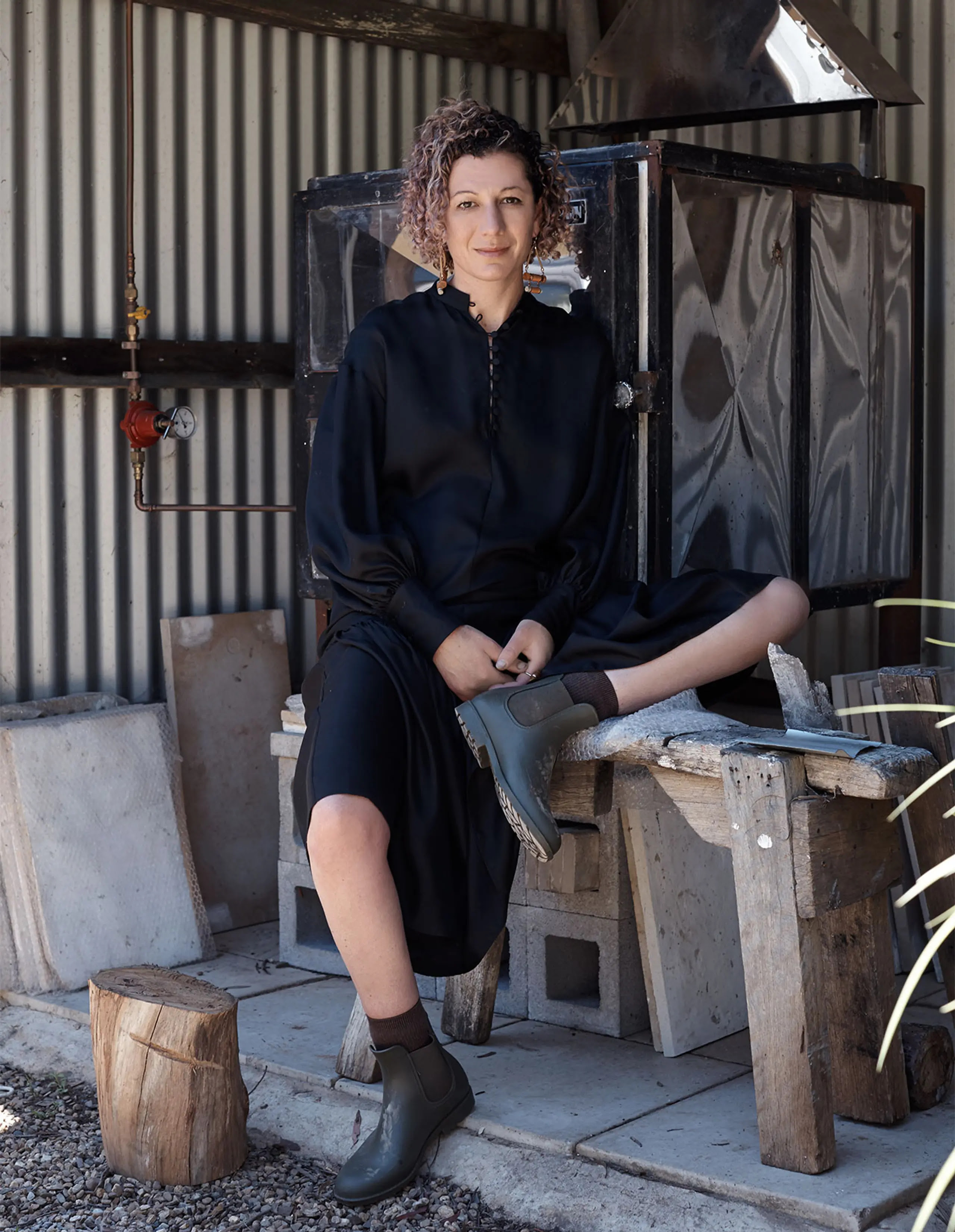
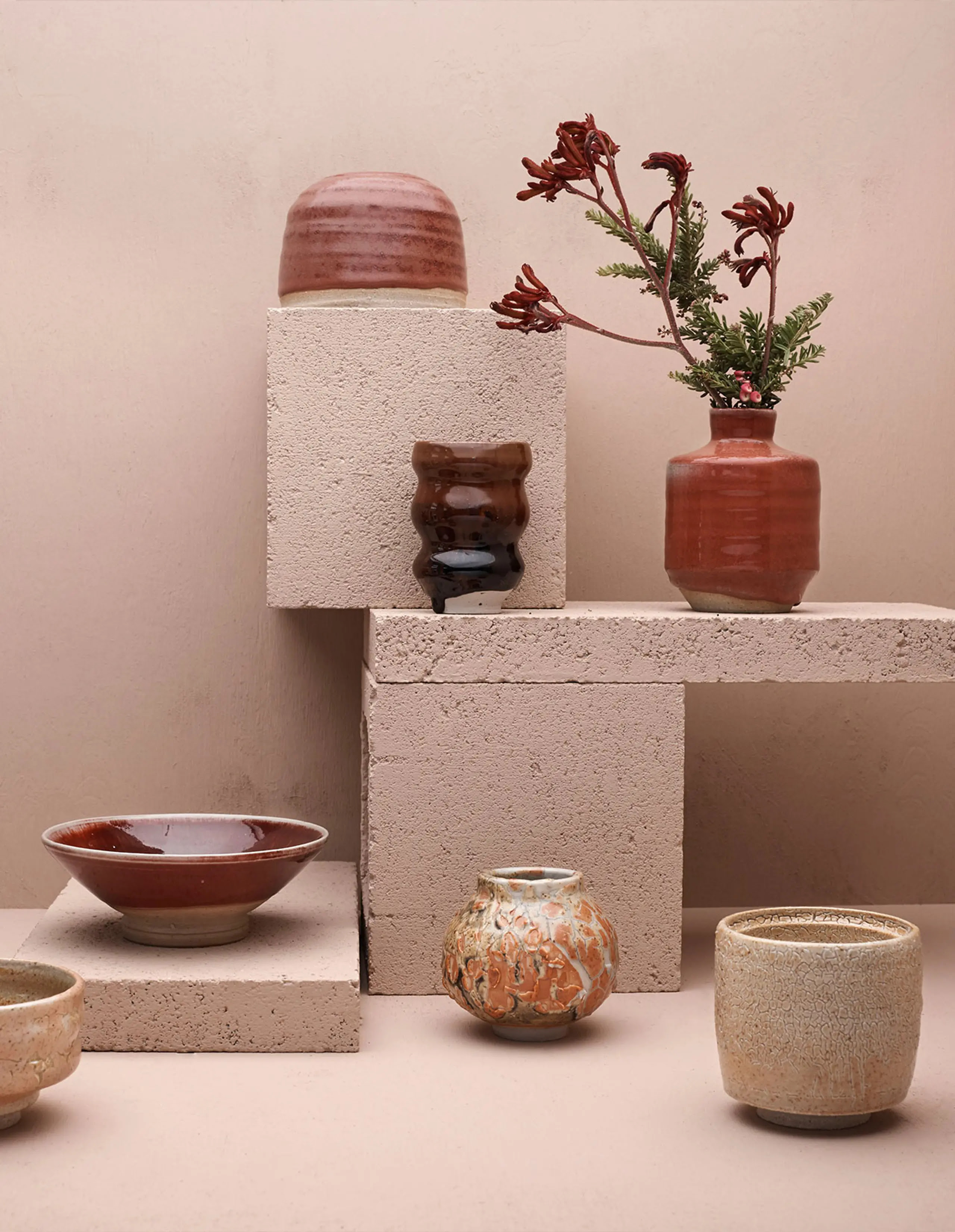
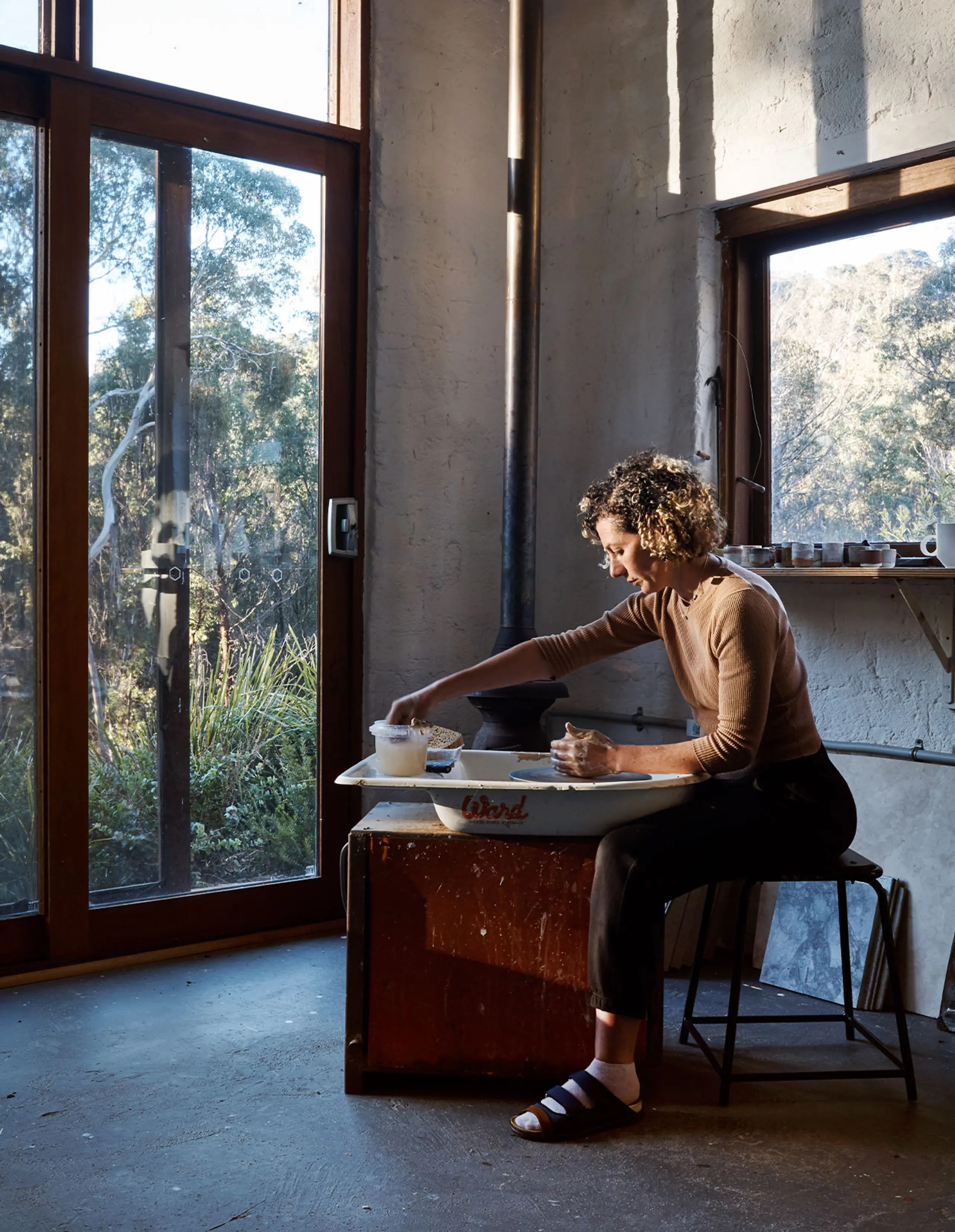
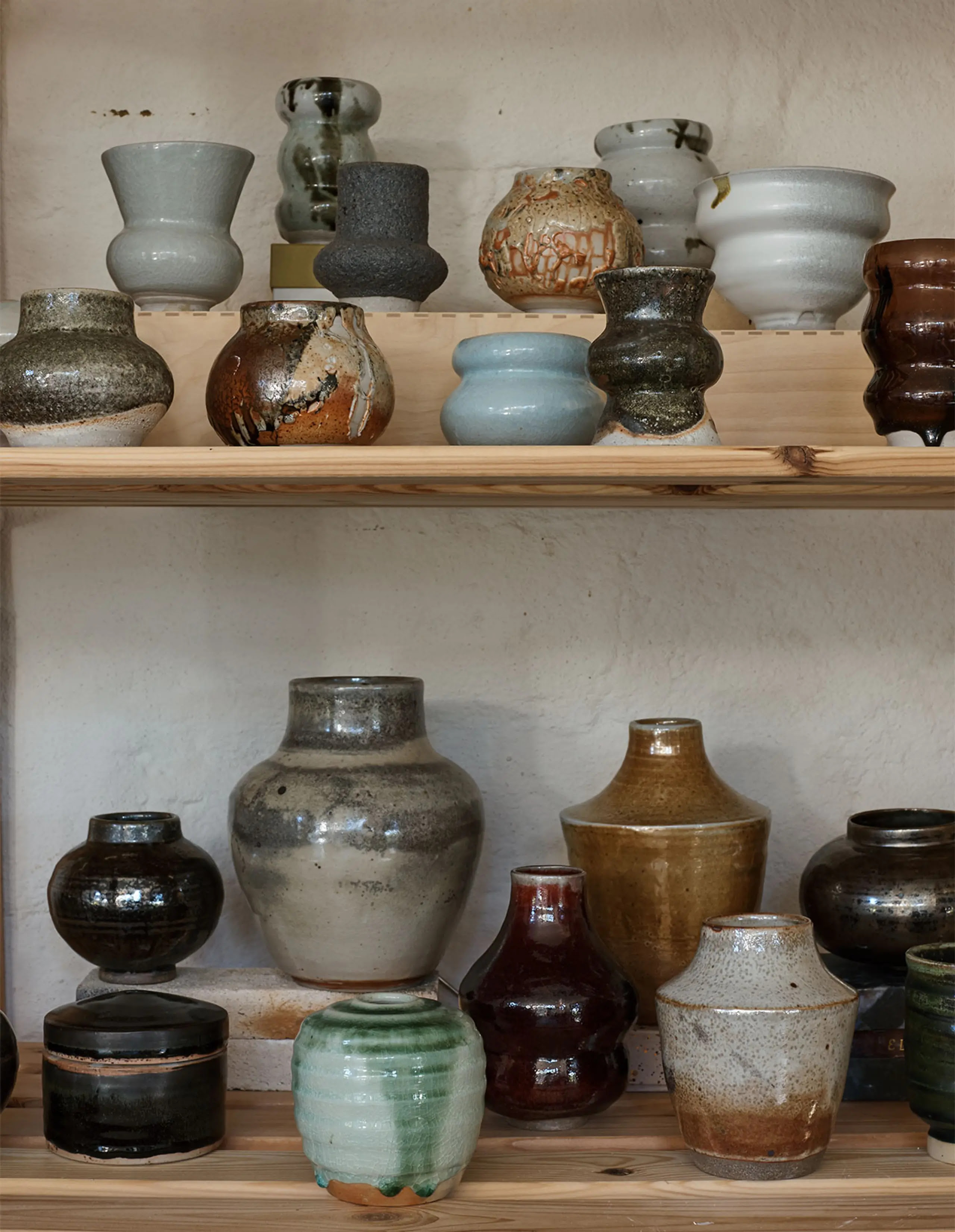
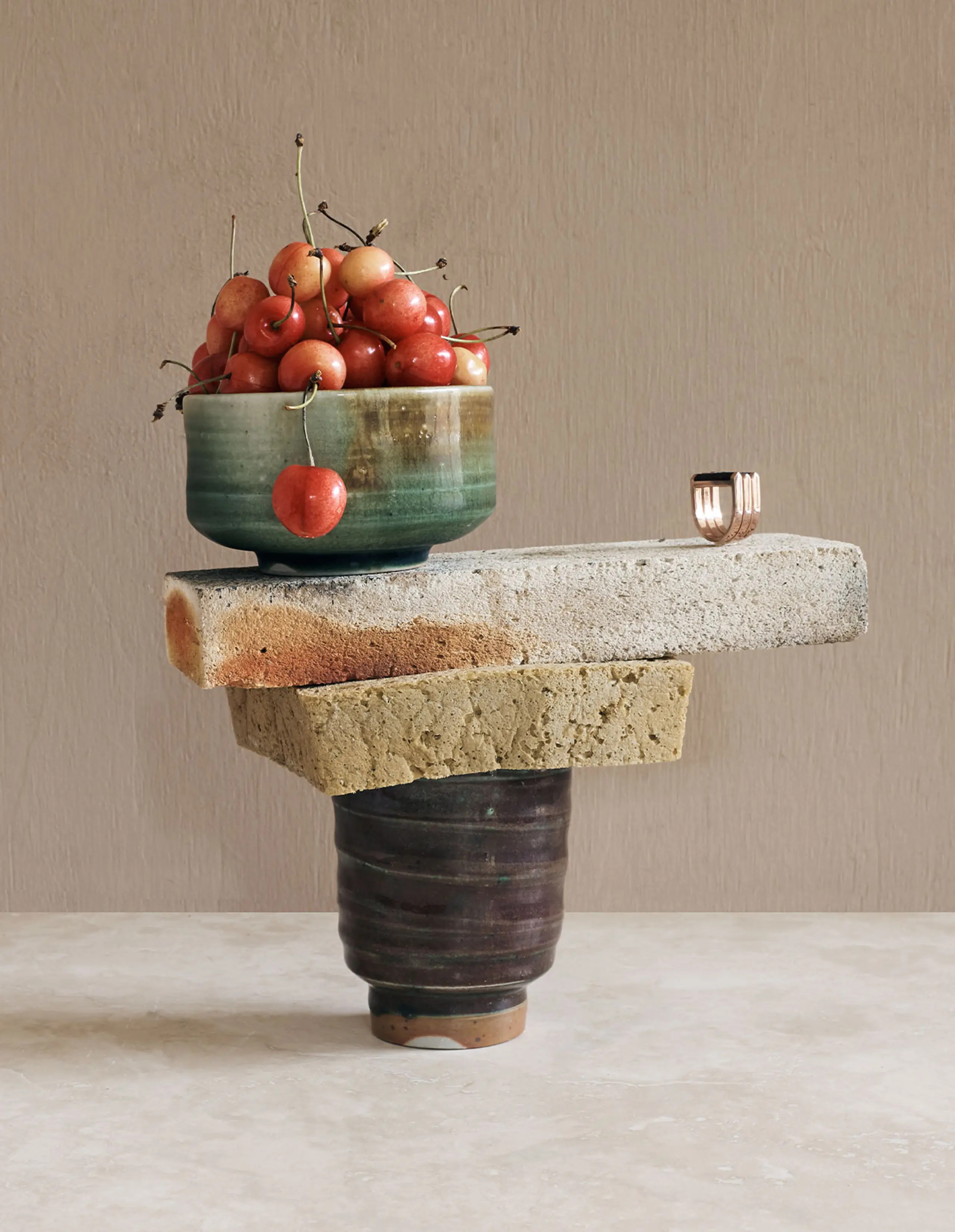
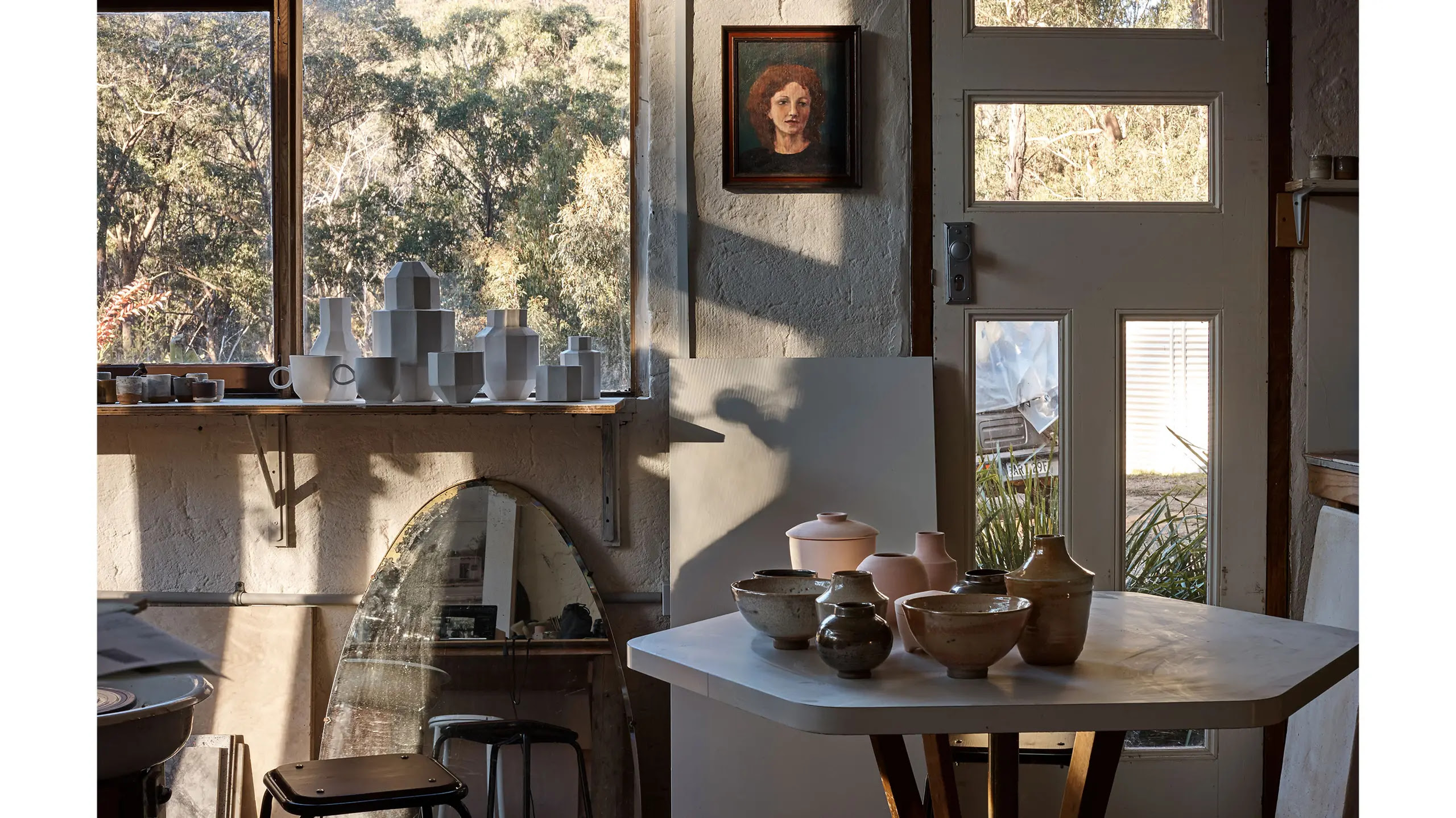
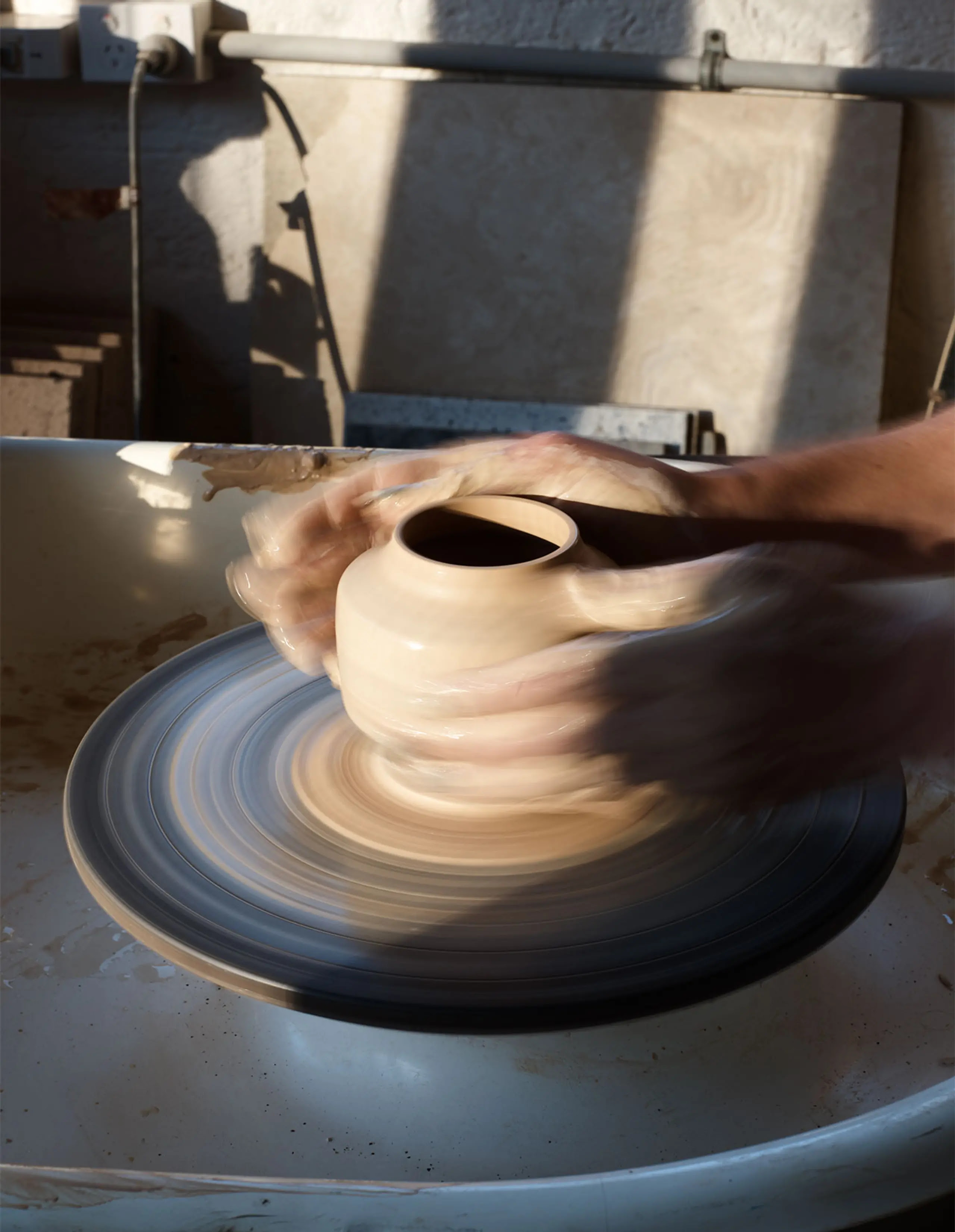
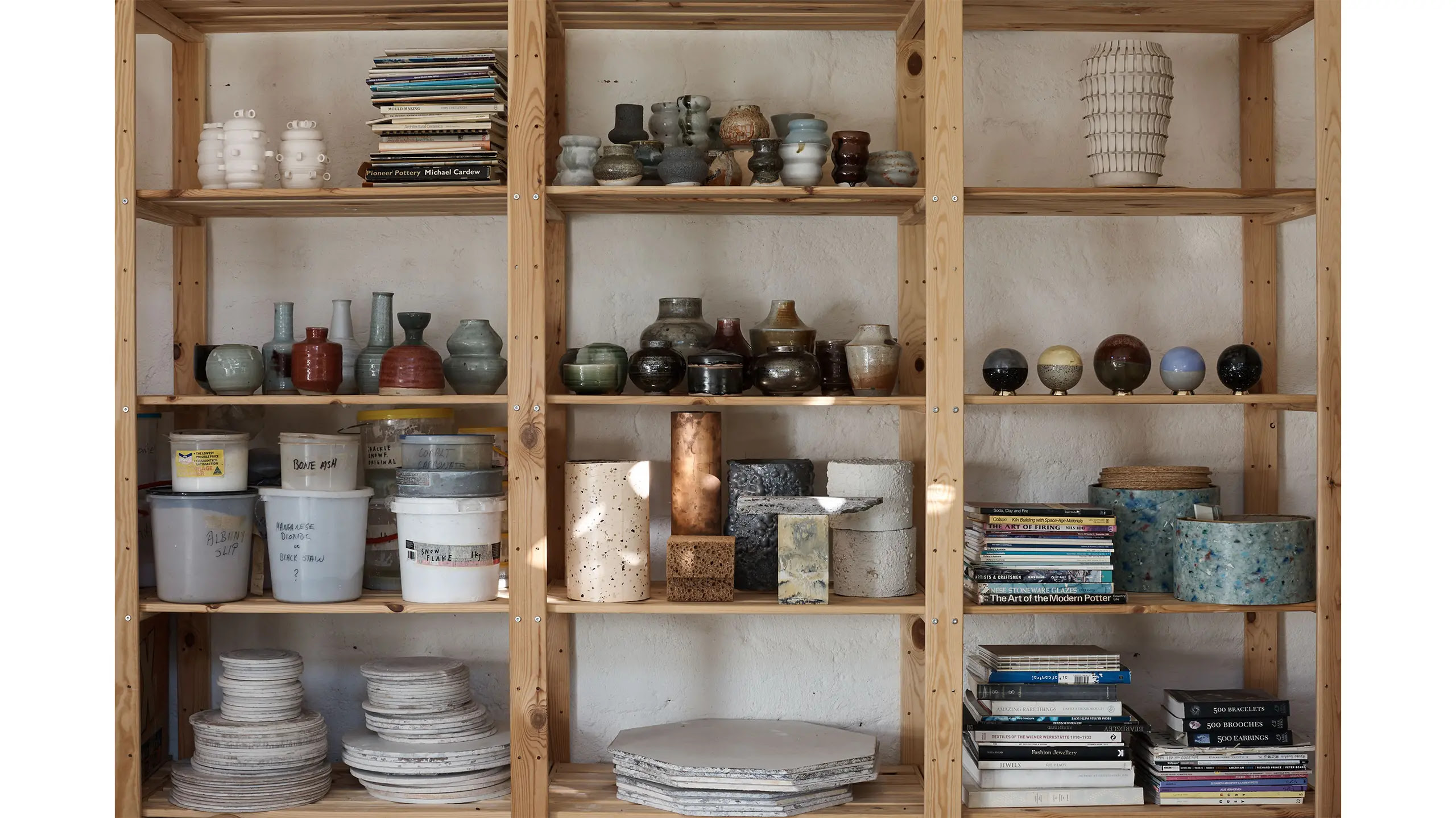
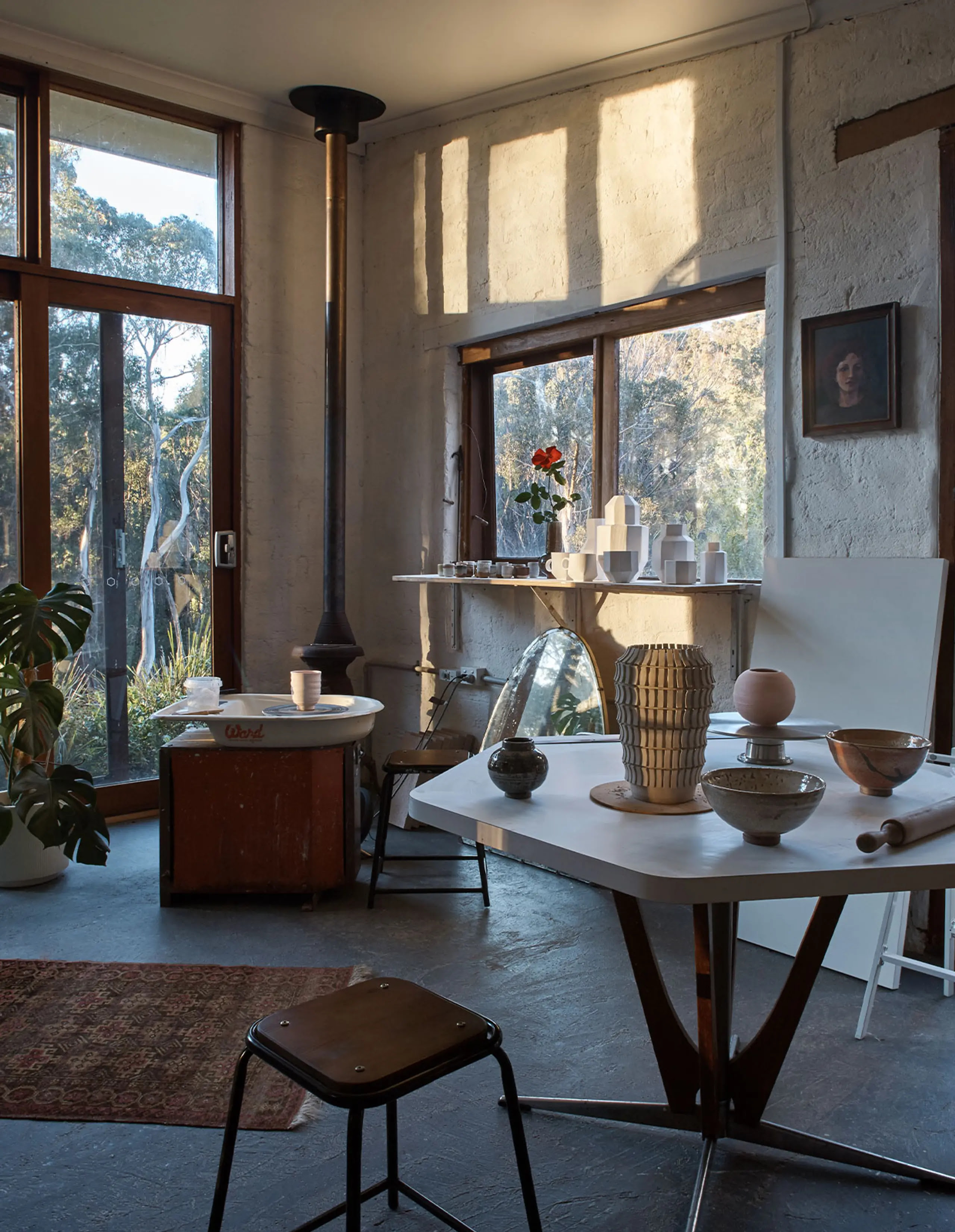
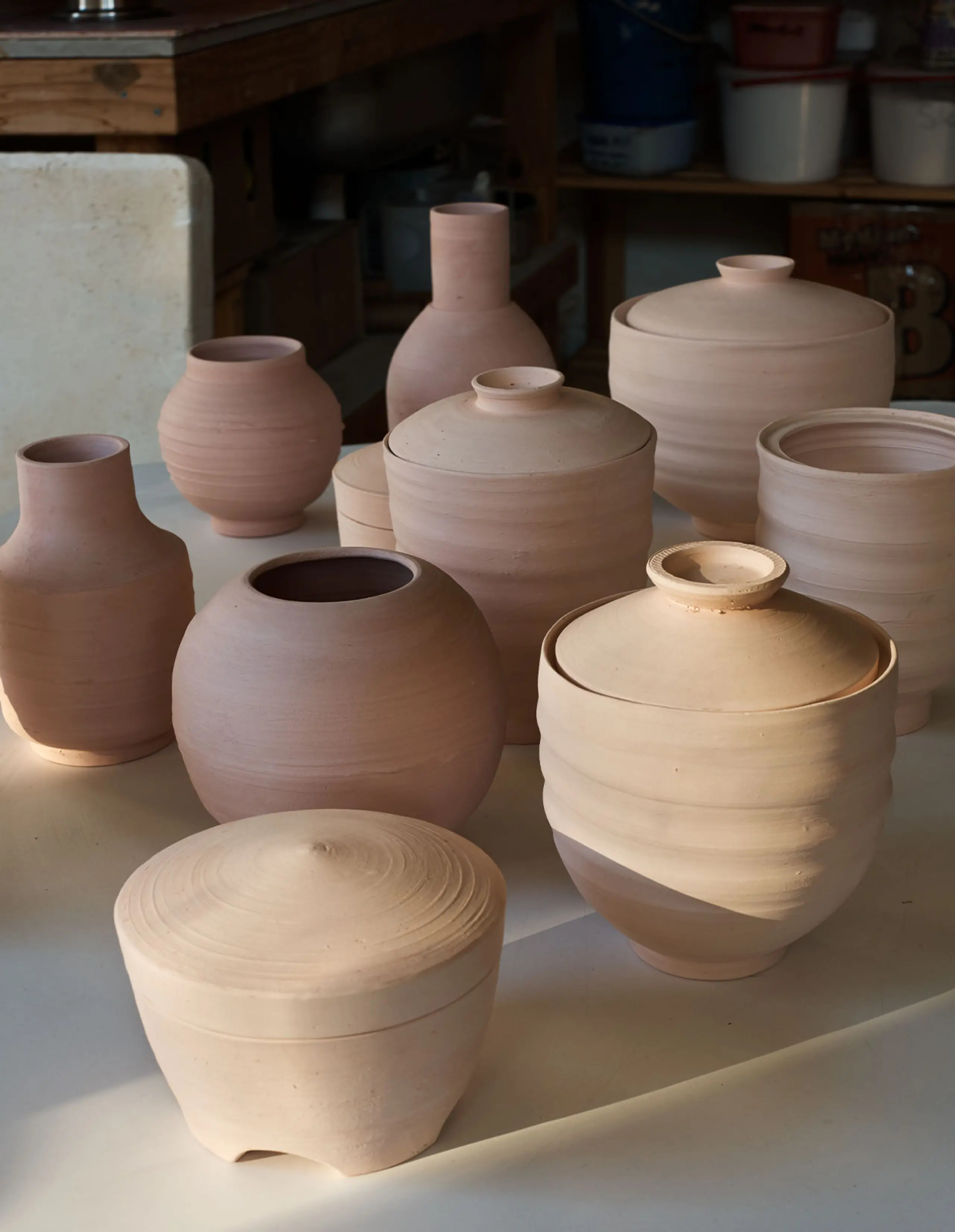
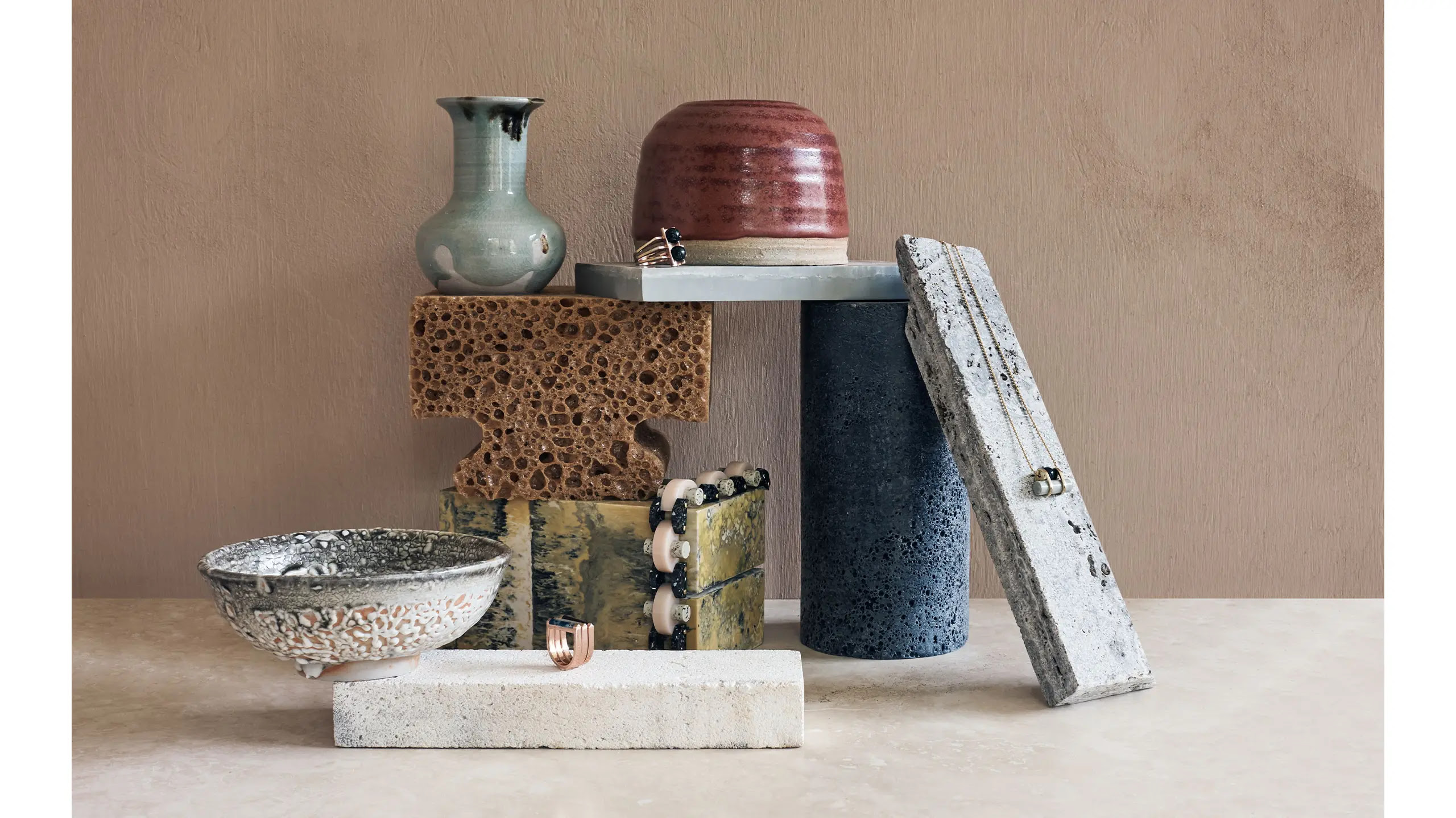

Elke Kramer has always been a proud creative. But over the years, the designer, maker, and creative director behind Studio Elke has developed the ability to shape shift and change lanes when necessary – which is why she decided to her take a year-long sabbatical from her work in late 2019.
Or so she thought. Elke’s original plan was ‘to take a pause on the pace of working on commercial jobs in order to explore ideas and make room for play’. But, the onset of the pandemic just months later quickly derailed that timeline.
‘I was holed up in a tiny house in [Sydney’s] city with my children feeling suffocated. That was the trigger that made us relocate to rural NSW, and instead of rebuilding my creativity I was trying to stop our compost toilet from flooding and side-stepping venomous snakes,’ Elke explains.
She had established Studio Elke a few years out of university, where she’d majored in graphics, textiles, jewellery and ceramics, after deciding to focus on jewellery.
‘It’s only been recently that I have fell back in love with the process of making with clay, and the radical alchemy of the firing process,’ Elke says of her renewed interest in ceramics. ‘Adding it to my brand offering has helped reinvigorate my creative practice.’
Her new range of pieces are all hand-made and gas-fired, which means each creation is a little different from the next – whether it’s a special one-off tint in the glaze, or the individual, textured lumps and bumps.
‘I am constantly intrigued by the alchemy of glazing. I am fascinated by the chemistry of it and am slowly gaining an understanding on the science of creating colour, finish and texture by combining basic minerals. Despite this, there is always an element of unpredictability that adds a little spice to the process!’
When Elke’s family made the tree-change to their off-grid property in the Southern Tablelands, she was also lucky enough to inherit an amazing studio space from the previous owner, and ceramicist, Gwenna Green. The beautiful stand-alone studio has its own wood fired stove, and floor-to-ceiling glass windows that frame the towering eucalypt rainforest!
Now, Studio Elke’s new online store sells her signature jewellery designs that we know and love, alongside her unique vessels, homewares and objects, all imbued with personality.
Shop Studio Elke’s new work here.
Why The Internet Is In Love With Libby Haines’ Beautiful Still-Life Paintings
https://thedesignfiles.net/


Why The Internet Is In Love With Libby Haines’ Beautiful Still-Life Paintings
When Libby Haines posts a picture of her still-life paintings on Instagram, they sell out within seconds. In minutes there’s an endless stream of comments saying ‘SOLD’ in a rapid-fire attempt to claim the Melbourne artist’s beautiful vignettes for themselves.
It’s an overwhelming response that Libby says she never expected when she returned to her childhood love of painting at the start of the pandemic. And she credits social media for giving her the power to become a full-time artist — a dream that once seemed ‘impossible’ to her!
Step inside her home studio, where she creates her colourful paintings of domestic bliss.
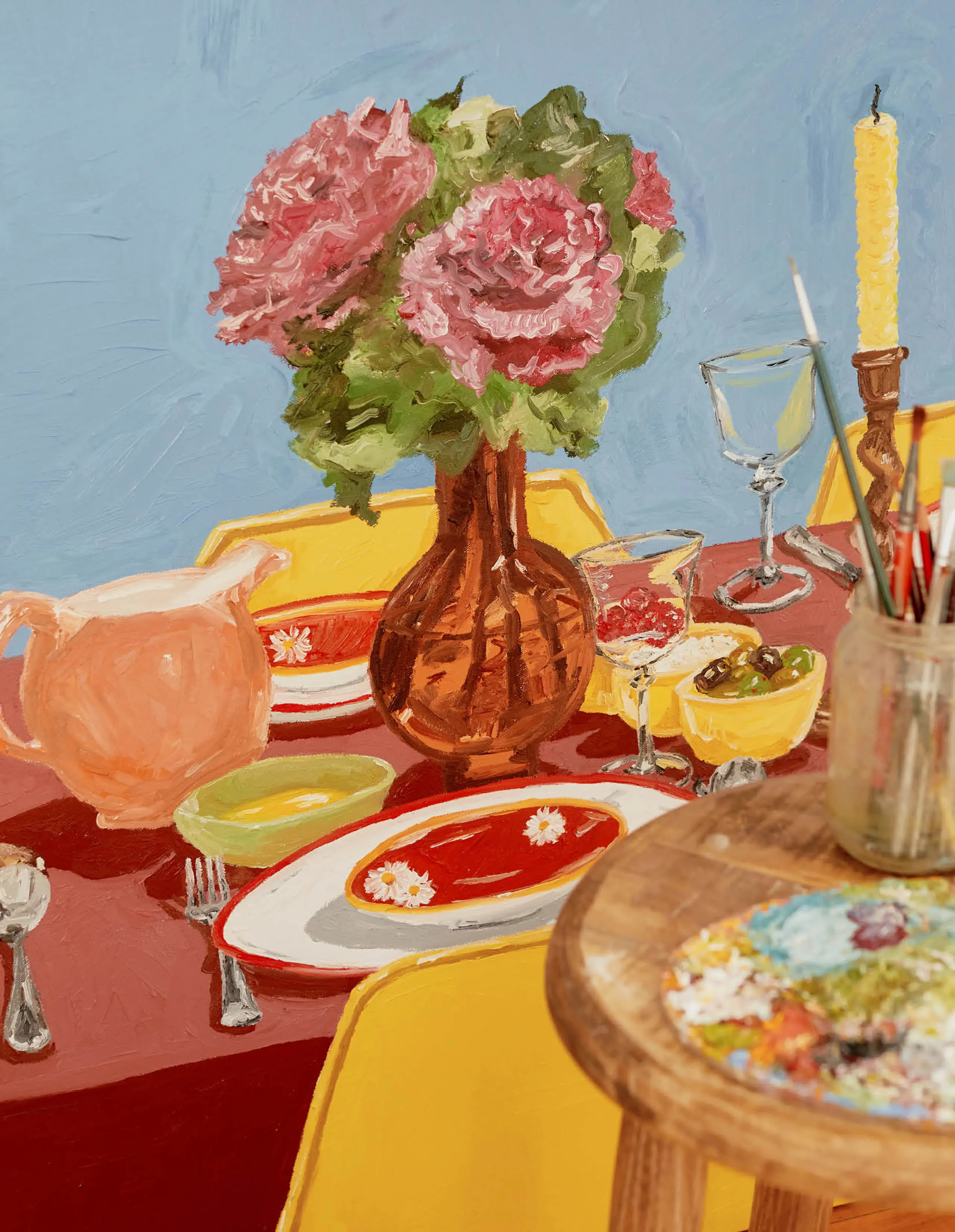
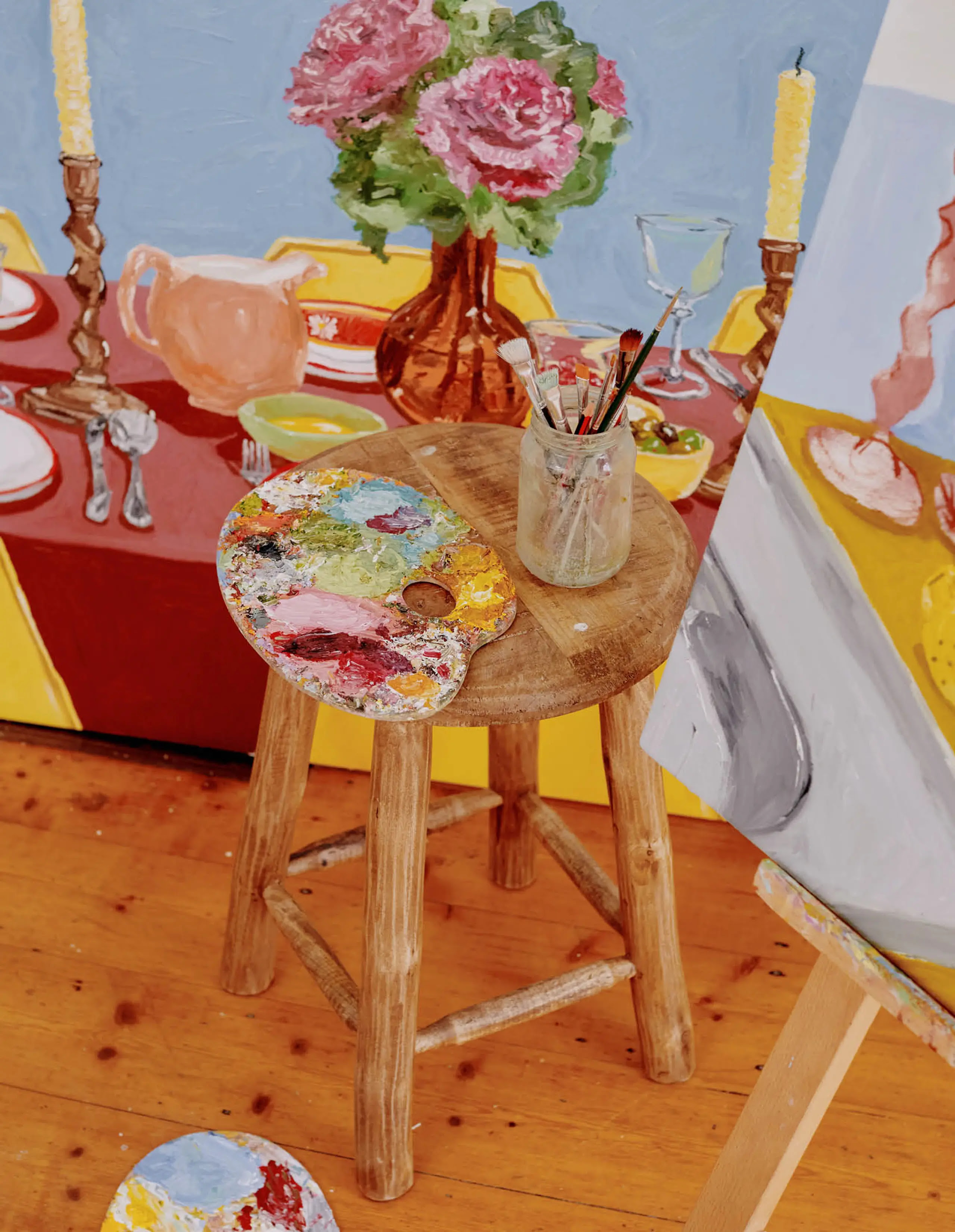
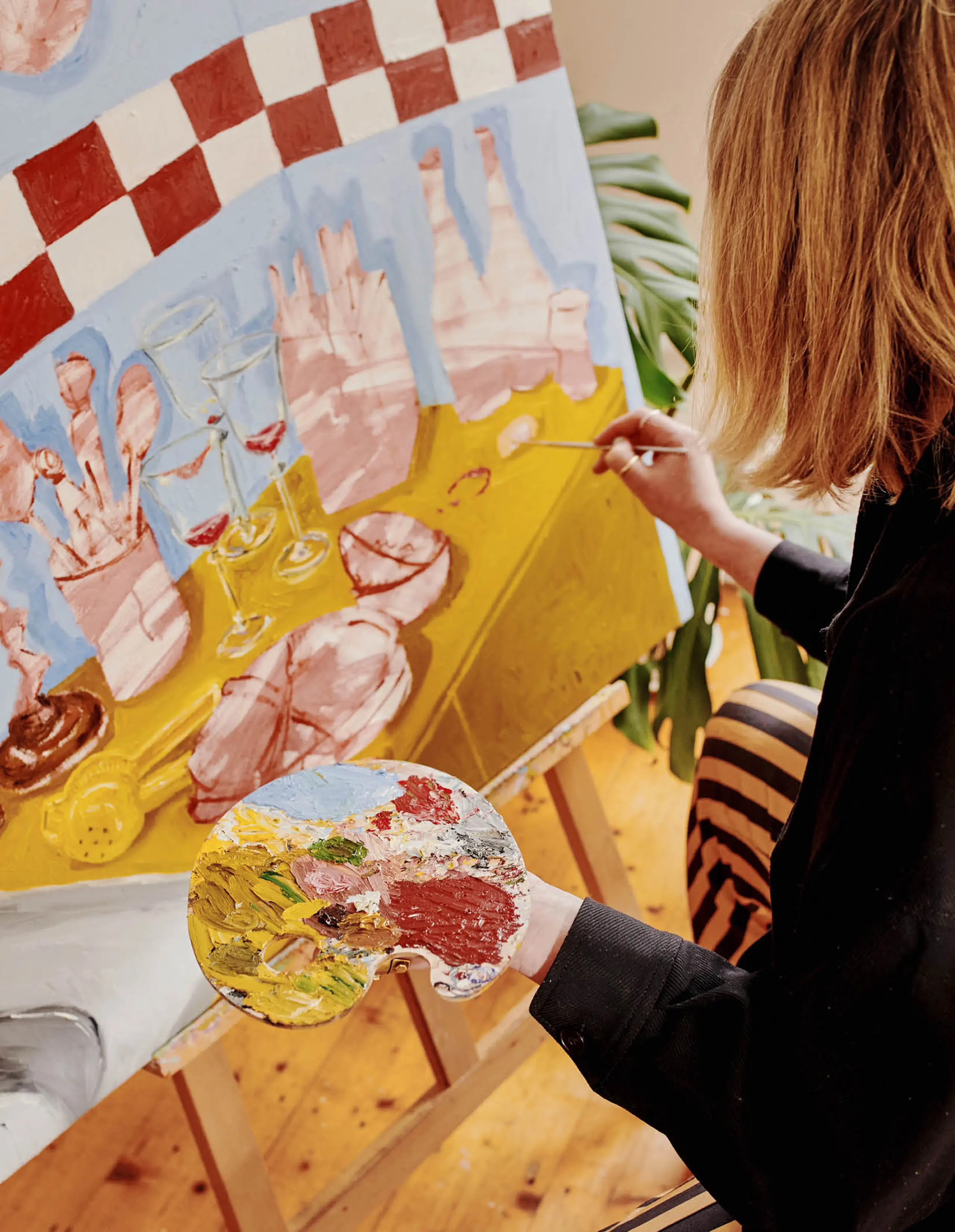

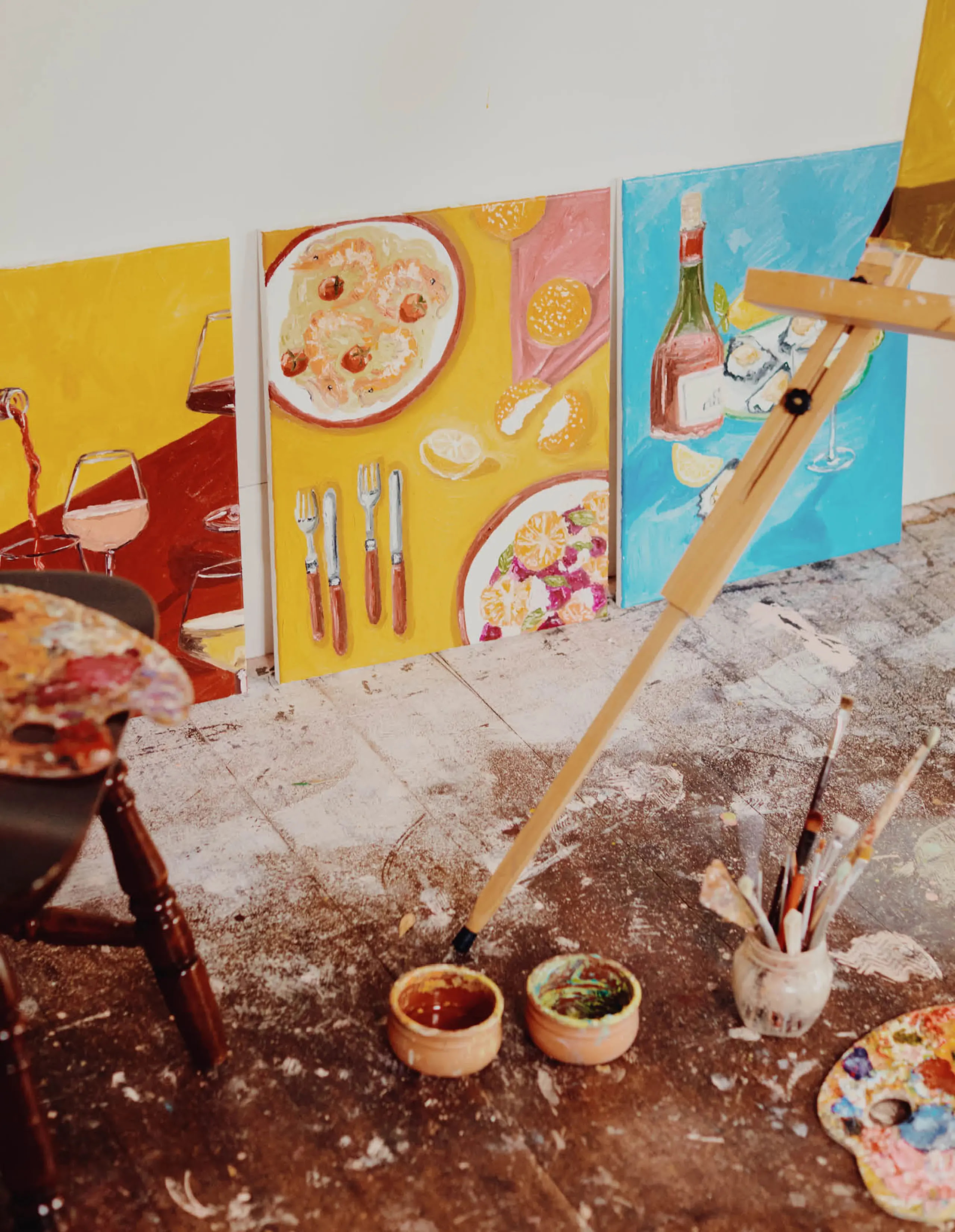
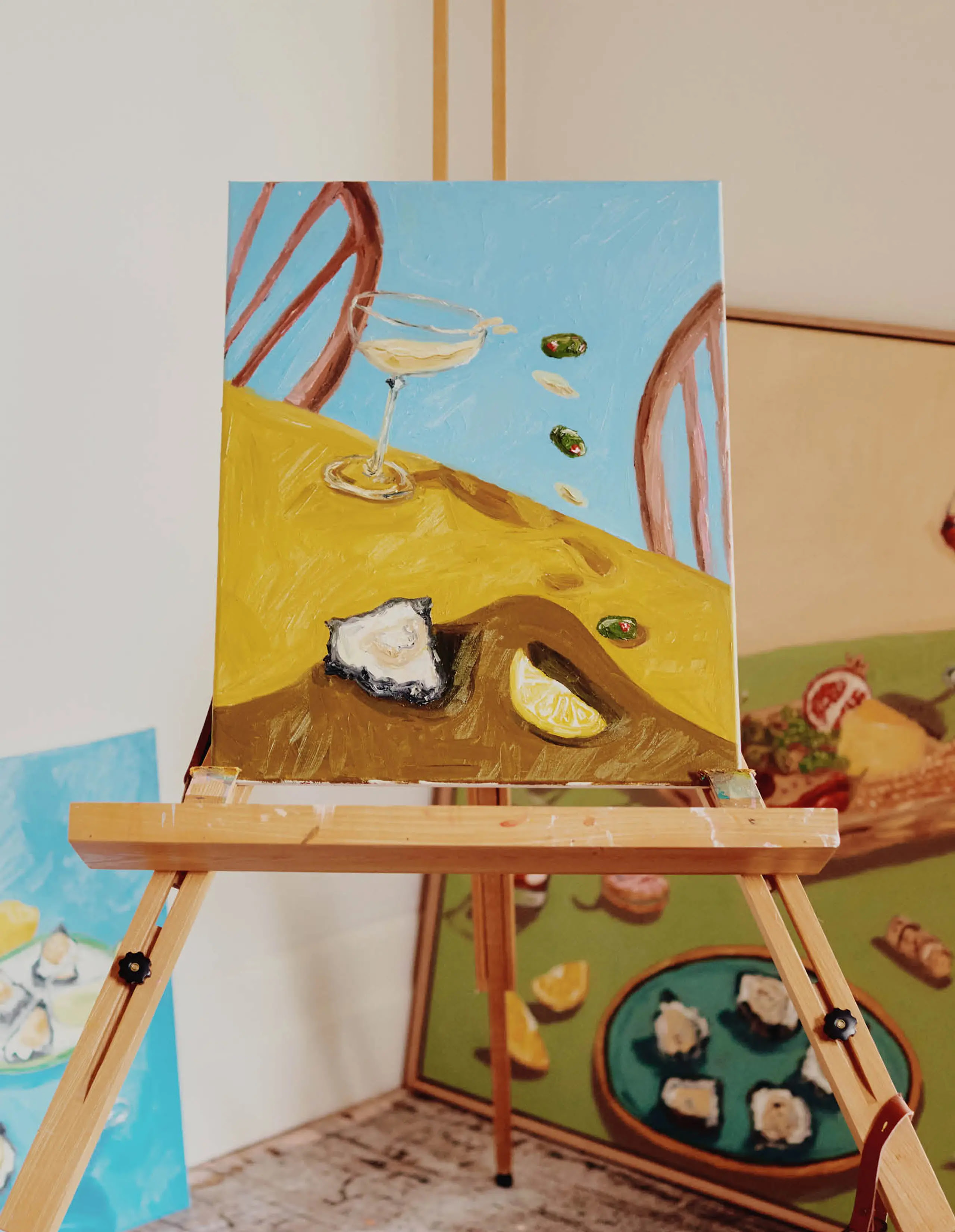
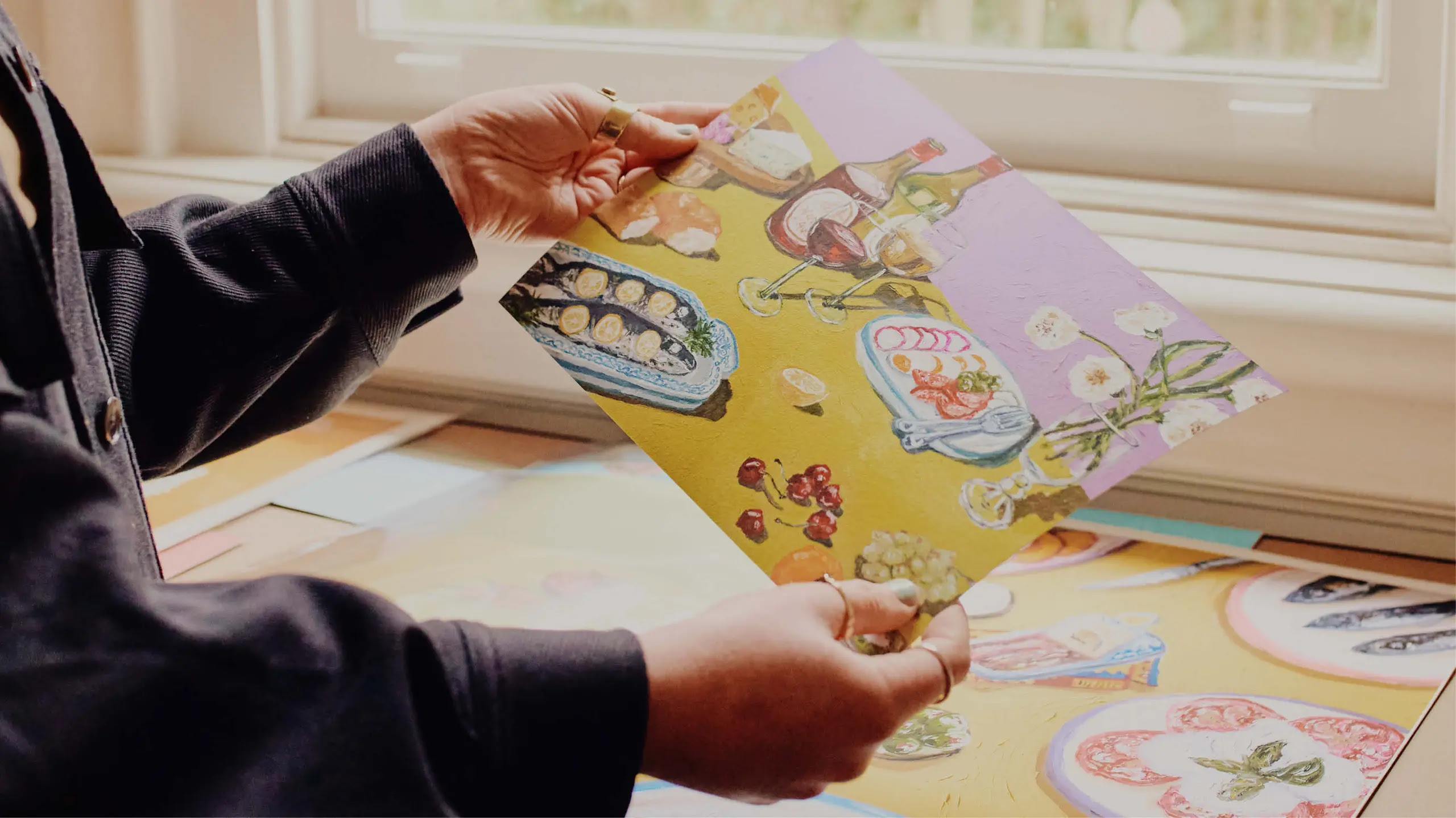
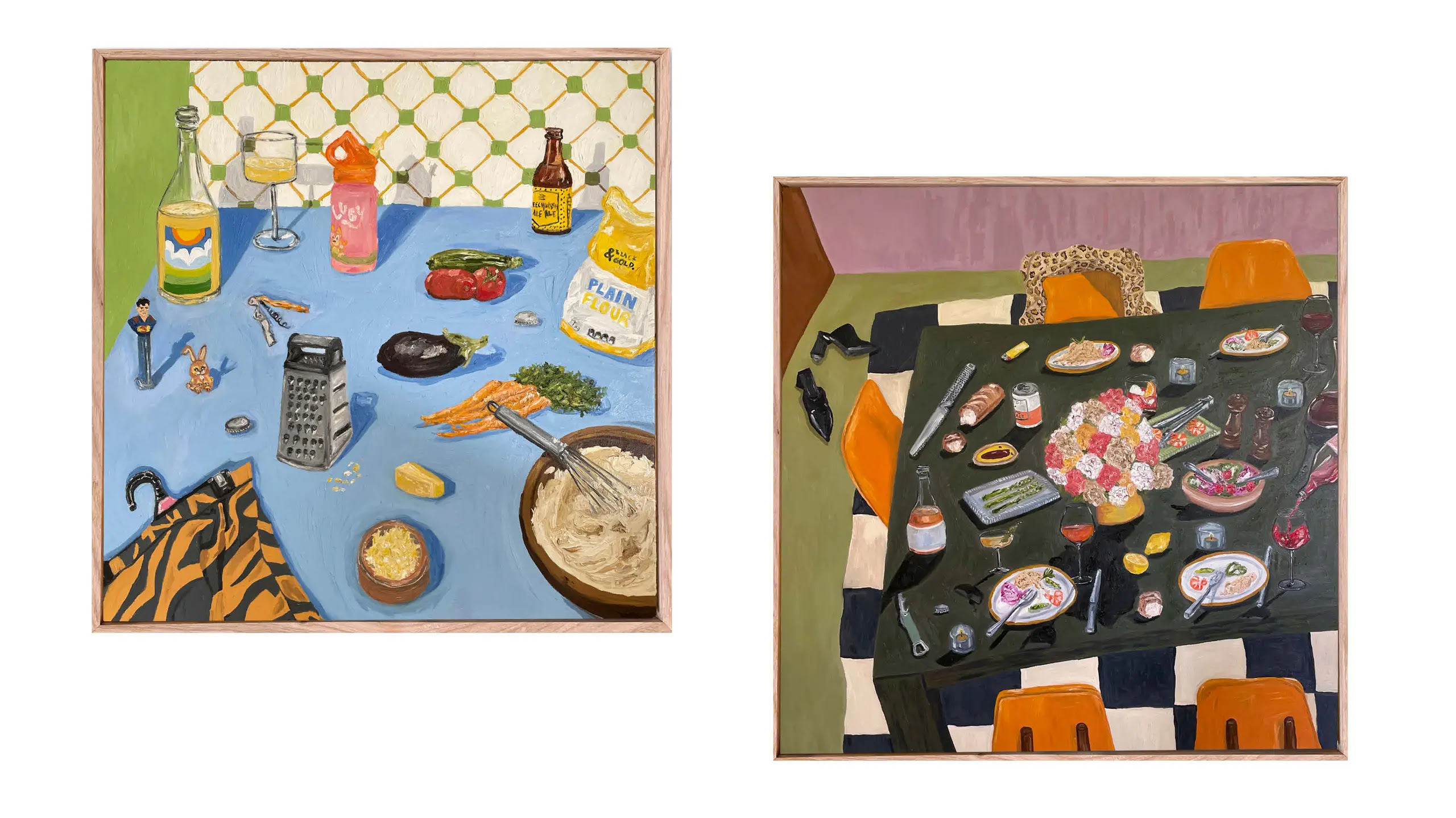

Libby Haines loved making art as a teenager and pursued visual arts in university. But by the time she was finished her degree, she had ‘no desire to be an artist anymore.’
‘I think I felt burnt out from producing and critiquing art constantly and I had no idea what I would want to create,’ Libby says. ‘It was pre-Instagram, and being a full-time artist truly seemed like an impossibility to me.’
She went on to study and work in fashion design and production, and later started her own jewellery brand called Lemon. Despite some successes, Libby says it was ‘really hard to make a profit’ – she ended up funding her passion with various side hustles before calling it quits six years in. Luckily, as one door closed another one opened, and she felt ready to explore art again after a 12-year hiatus.
‘It was the start of pandemic, and I was home with my two toddlers (both under two at the time) and suddenly painting was all I could think about.’ Libby started sharing her dreamy, still-life oil paintings directly inspired by her day-to-day life on Instagram in the lead up to her first solo show with a positive response – so she decided to test the waters by selling smaller works via the app.
‘At first it took a few days to sell one (which I was stoked with) and then from there it was happening within hours, then minutes, to the point where many people were commenting at the exact time I released it,’ Libby explains. It’s since become a competitive frenzy with her 41,200 followers vying in the comments to buy one of her two releases a week. Sometimes, she even gets frustrated and upset DMs from people afterwards who are devastated to miss out on a painting, which Libby admits is a flattering but bizarre position to be in.
‘After years of working so hard to keep my jewellery brand alive I could never have dreamed of this kind of demand for my work,’ she adds. She ‘impulsively’ creates these richly textured paintings from her home studio in just a few hours, often painting from memory alone, while her husband Sam builds the canvas frames from their living room.
But the Internet has fallen in love with Libby’s ability to capture familiar and ‘messy moments’ they recognise from their own lives. They’re often scenes from dinner parties (a theme Libby is now focusing on for her upcoming solo show of larger paintings!) with food, flowing wine glasses and intimate details of a lipstick stain, or tables cluttered with household objects and a stray kid’s toy.
It’s clear we have an affinity for seeing these shared scenes of joyful domestic bliss on social media (perhaps even more so after the challenges of the last few years), and Libby’s works seem to have arrived in the world at just the right time.
Follow Libby on Instagram here, and shop her prints online here.
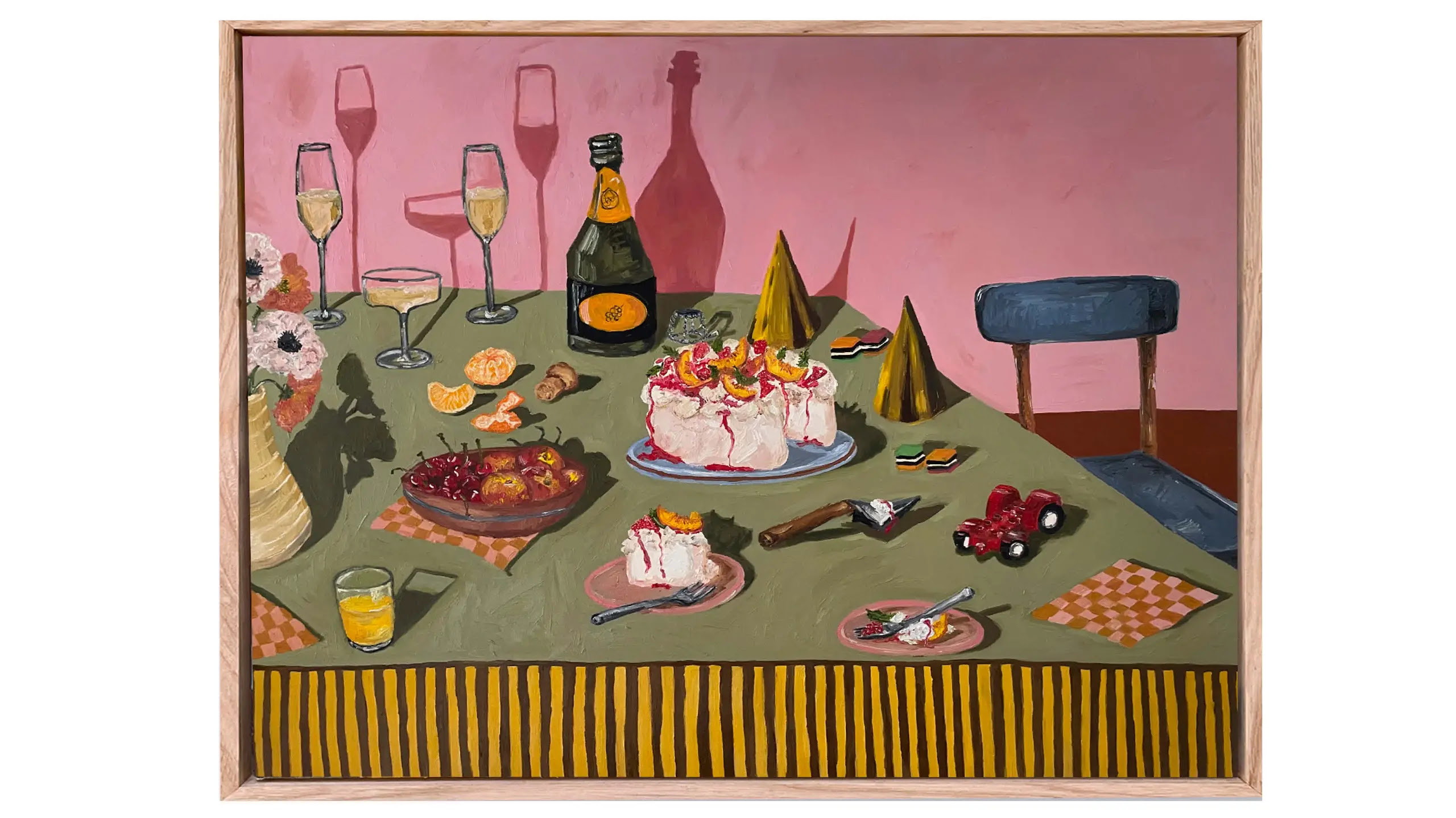
Latest Stories
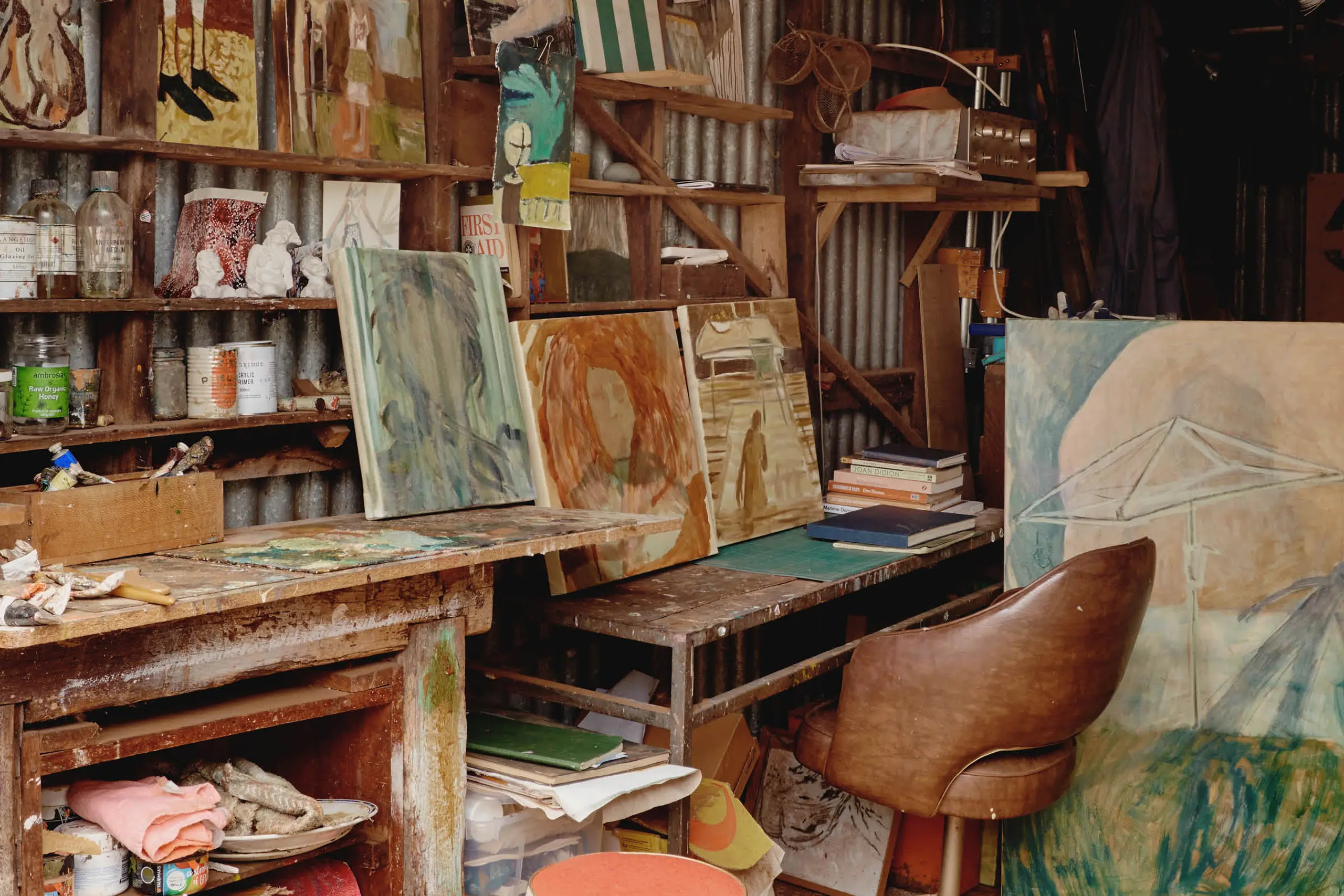
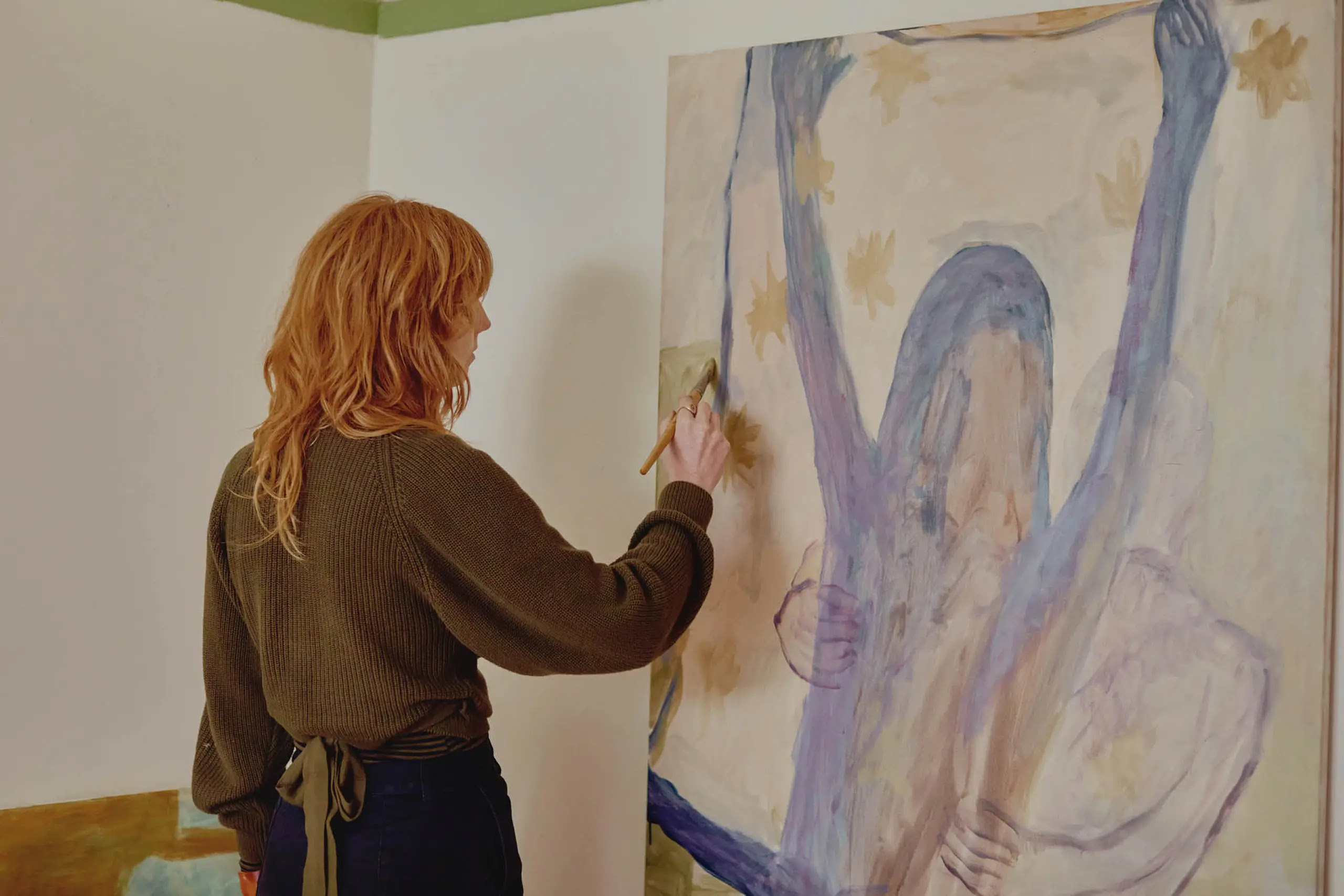
The Haunting, Shadow-Inspired Paintings Of Melbourne Artist Ella Dunn
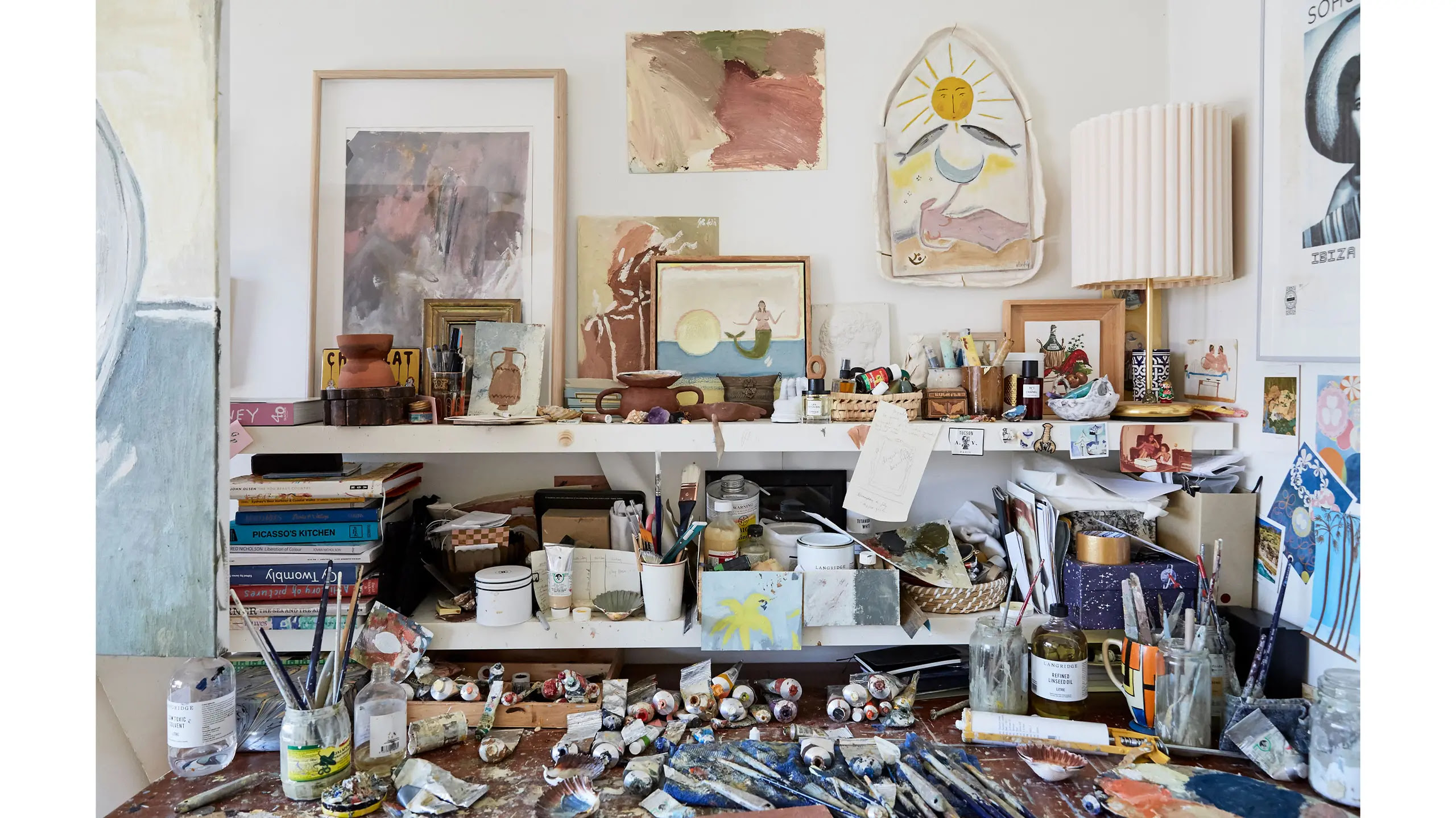
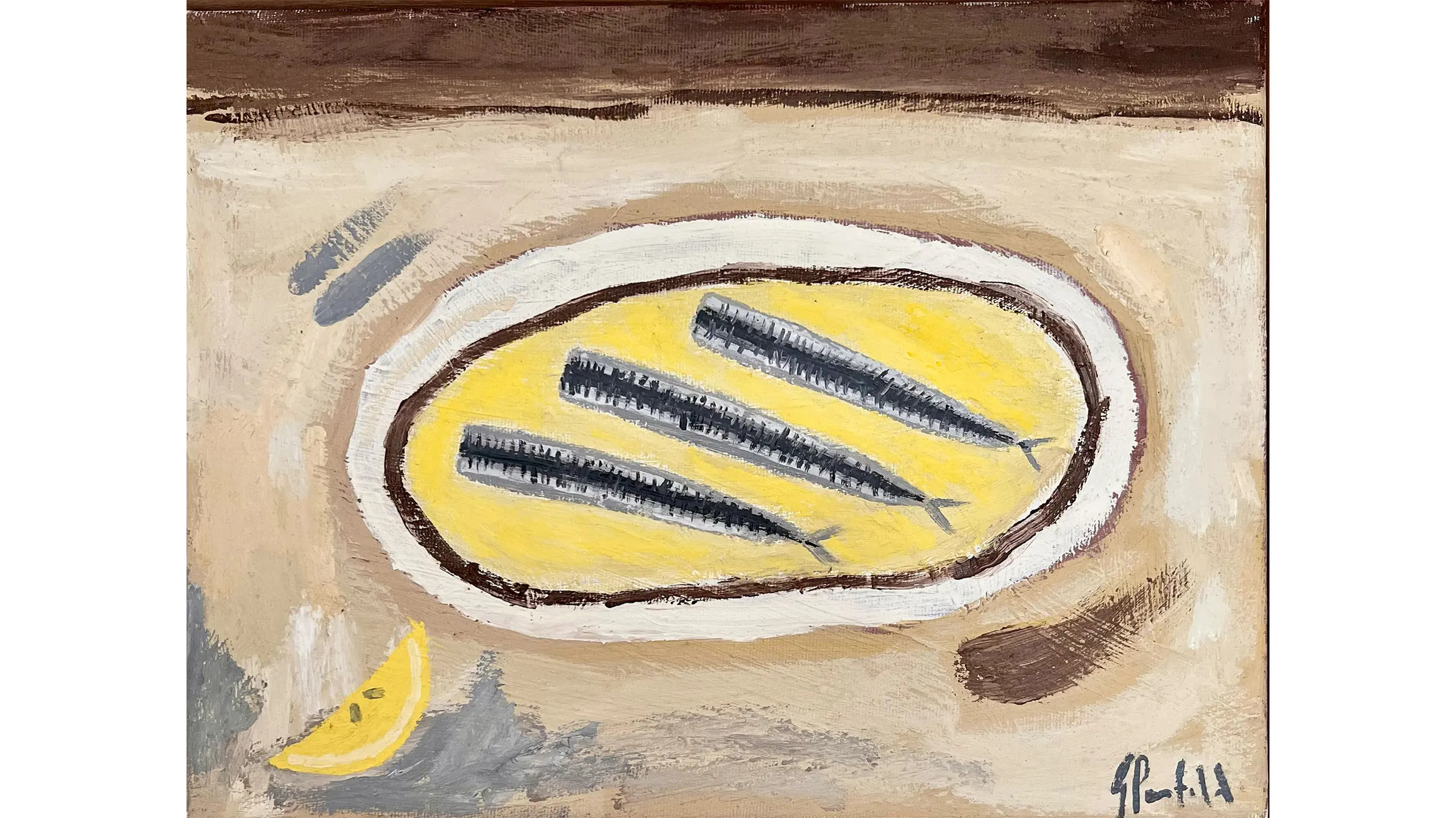
Gabrielle Penfold’s Nostalgic Paintings Capture Food And Feelings Of Summer
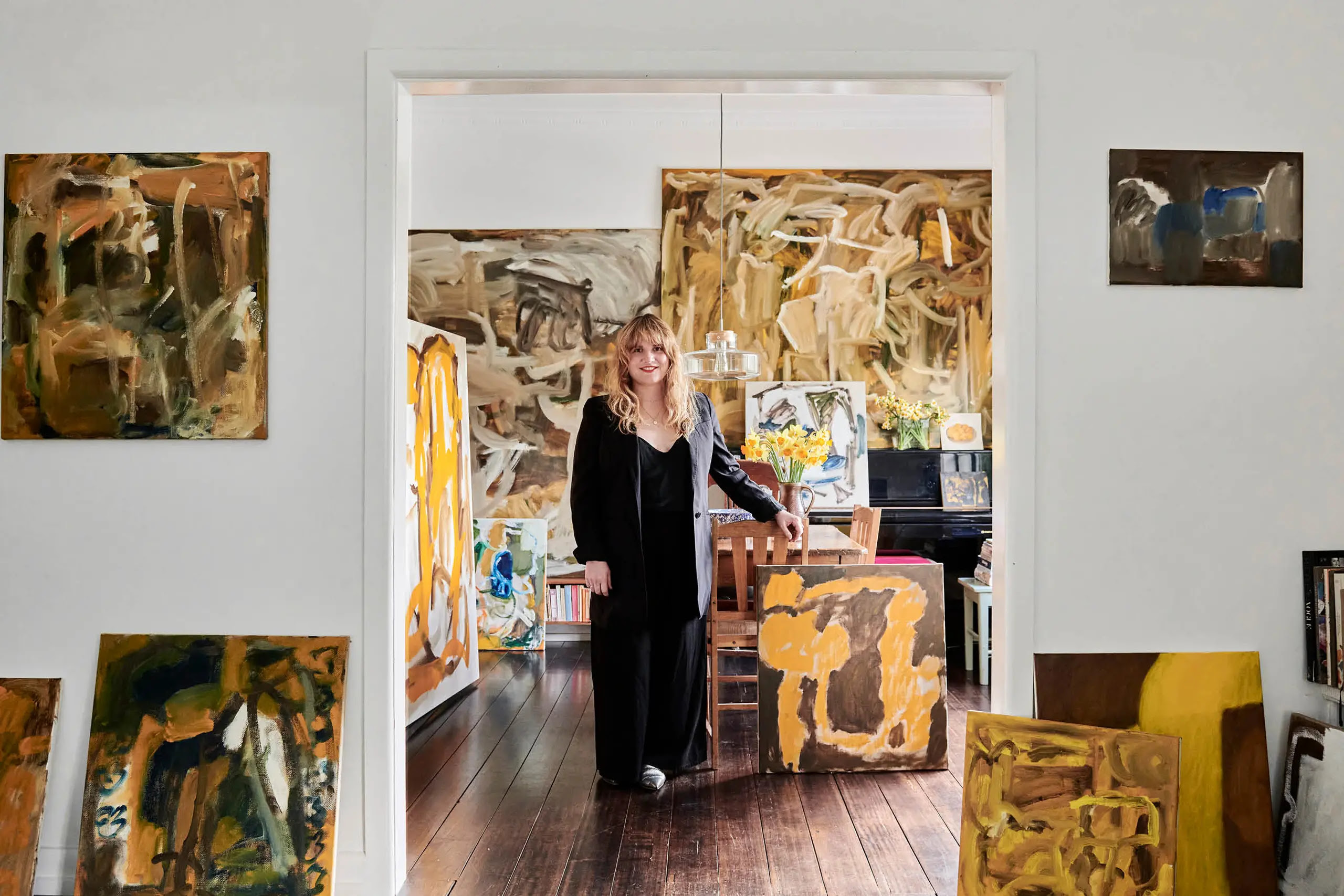
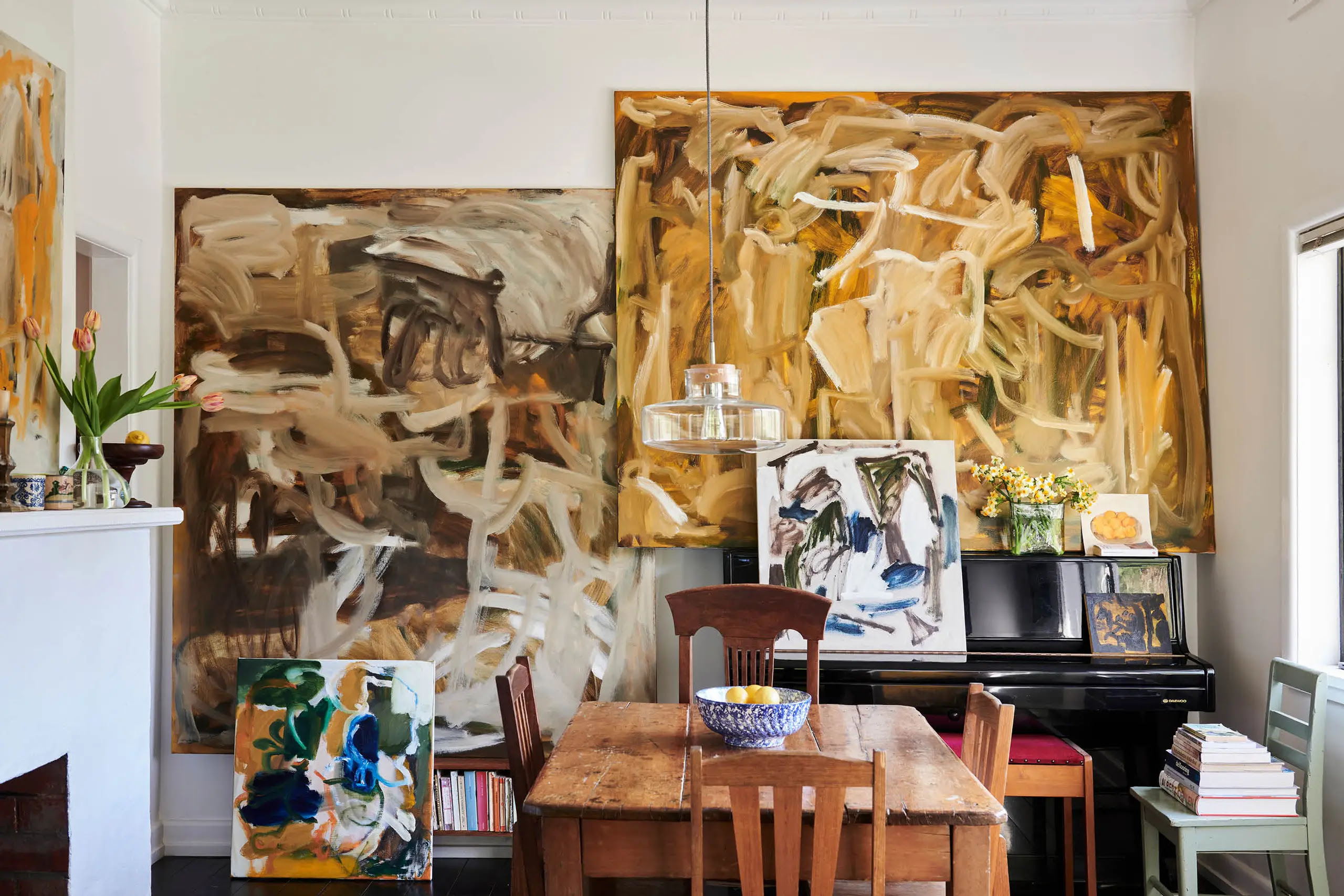
An Artist’s Home Bursting With Her Own Beautiful Golden-Toned Paintings
Recent Studio Visit
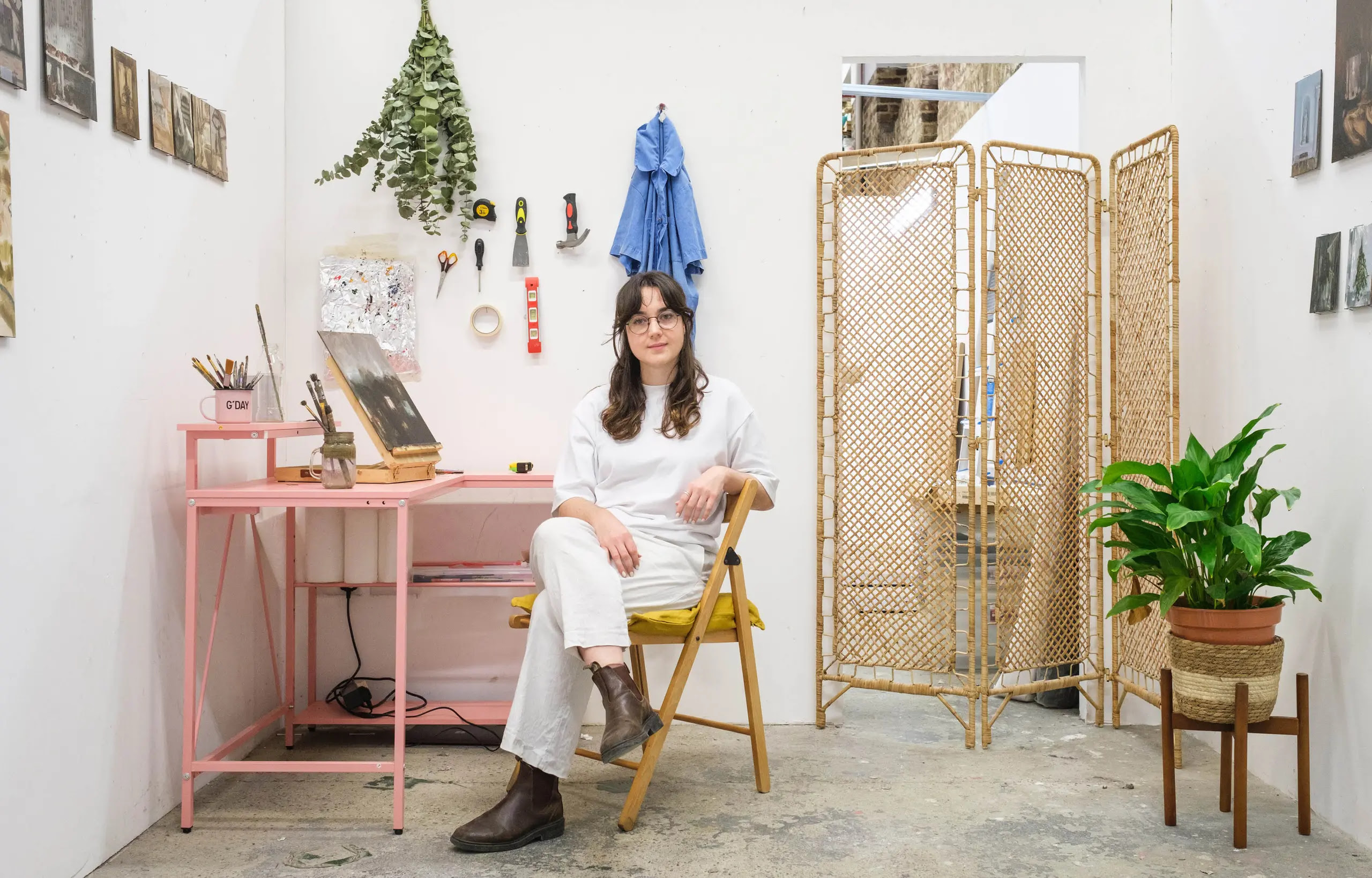
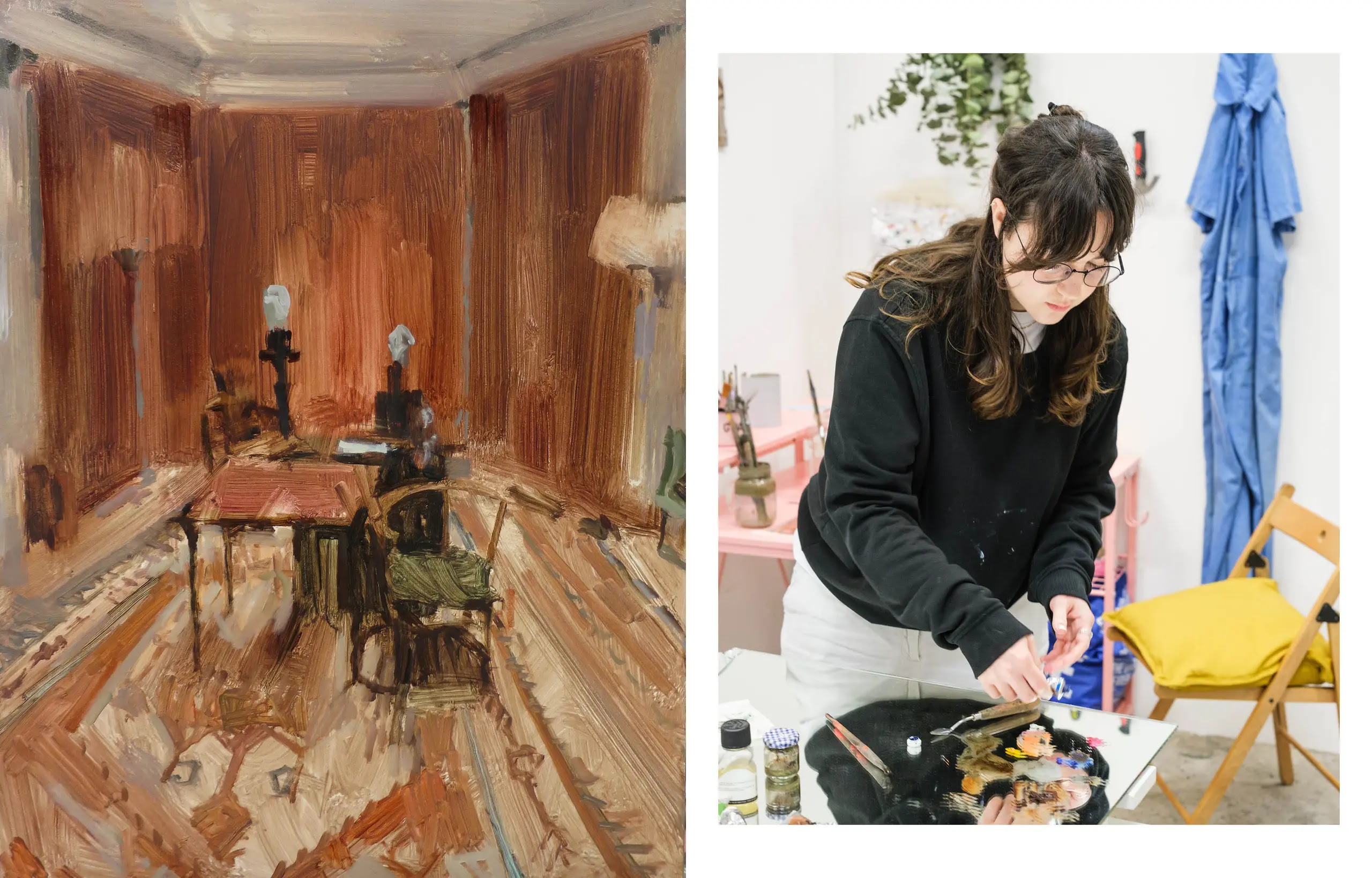
Miranda Hine’s Alluring Paintings Of English House Museums
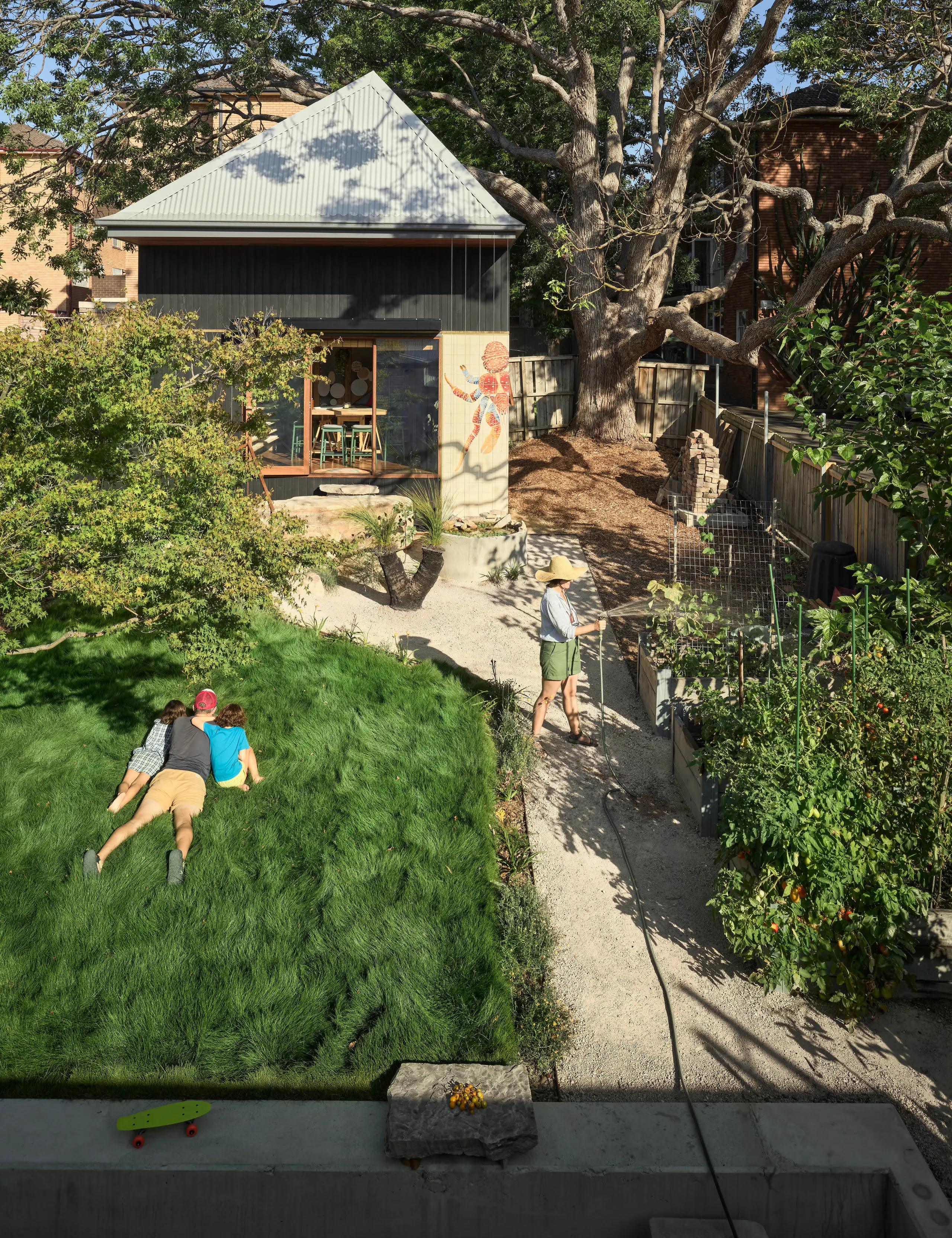
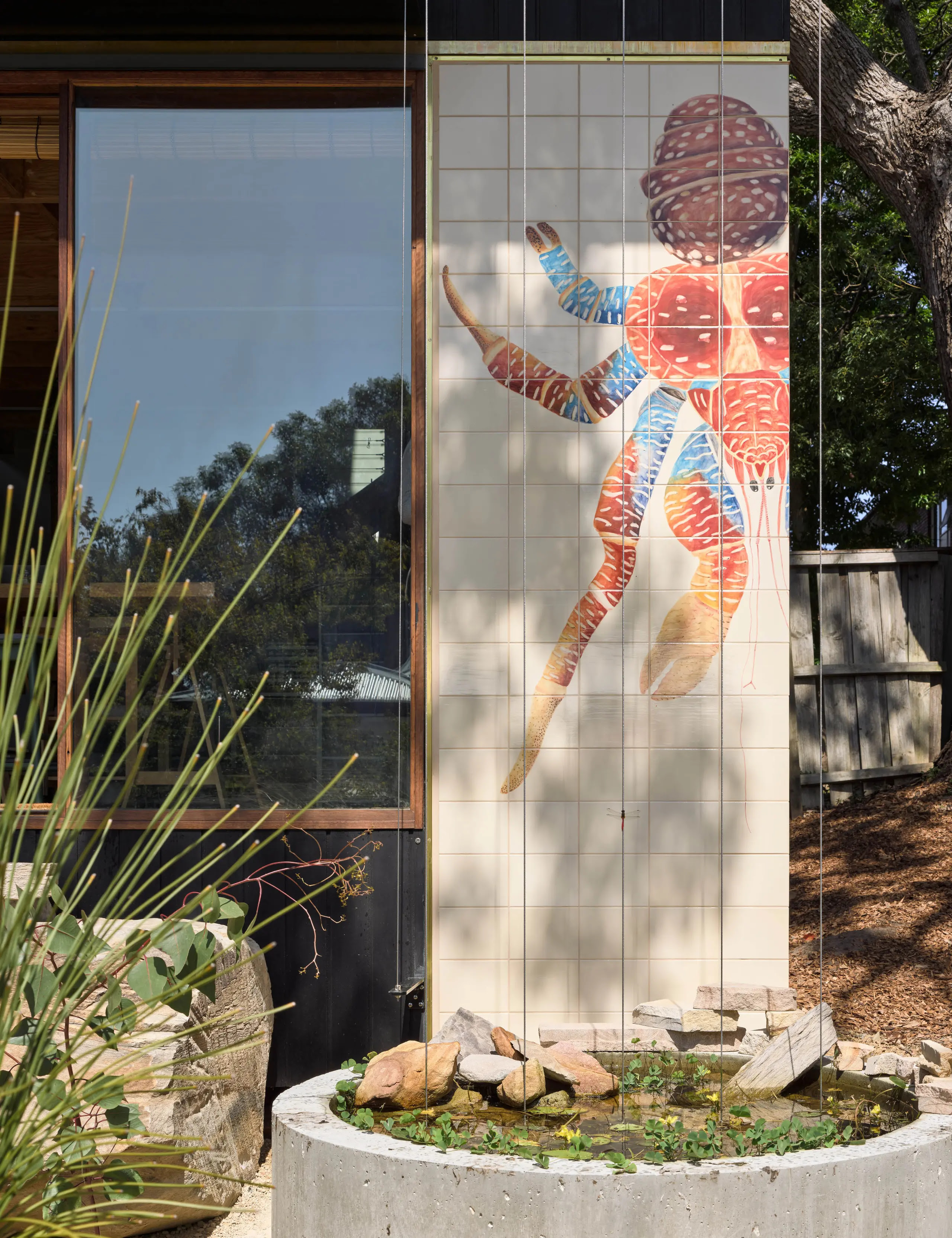
The Environmentally Regenerative Ceramics Studio Of Casa Adams
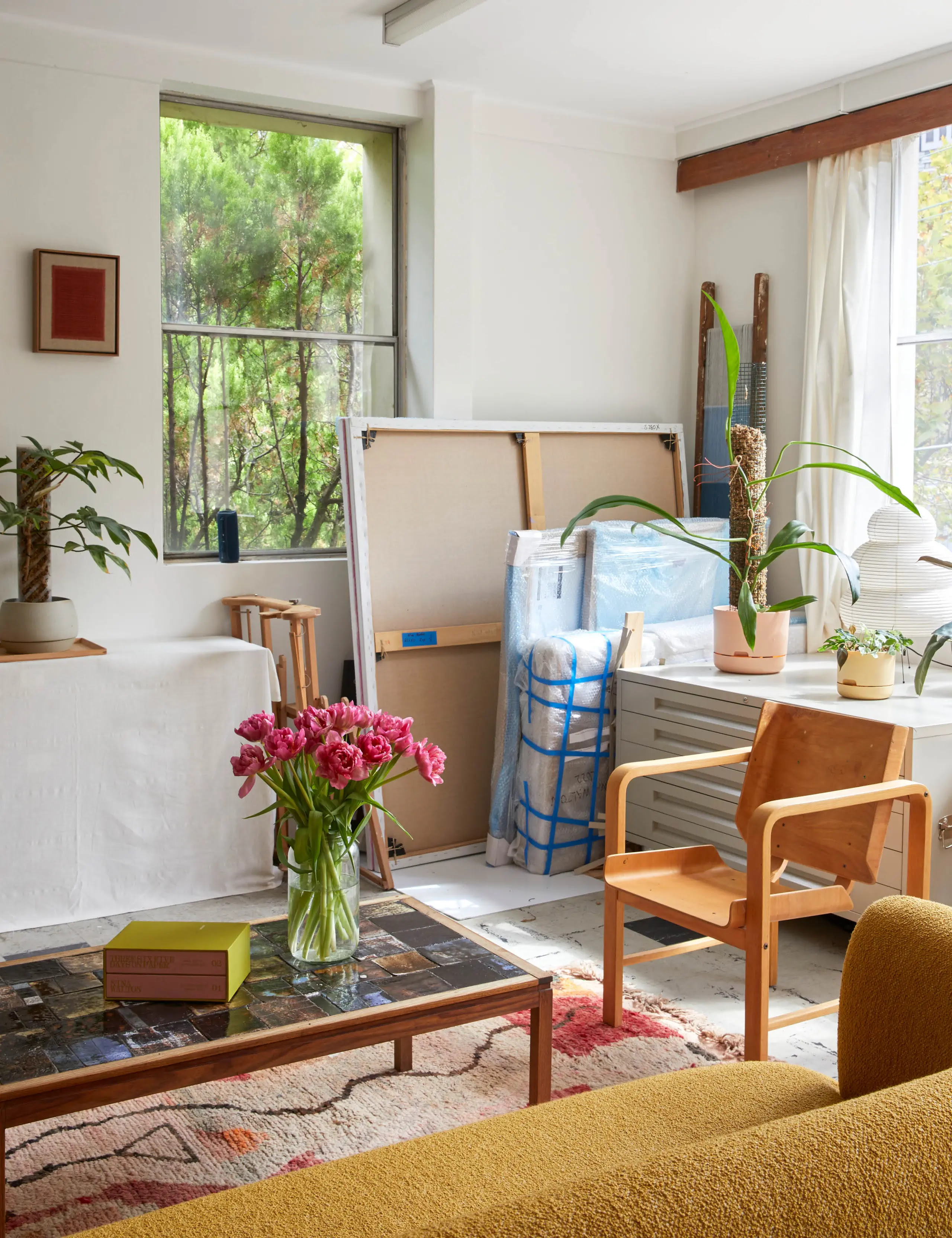

These Intricate Woven Paintings Explore Creativity Within Contraints
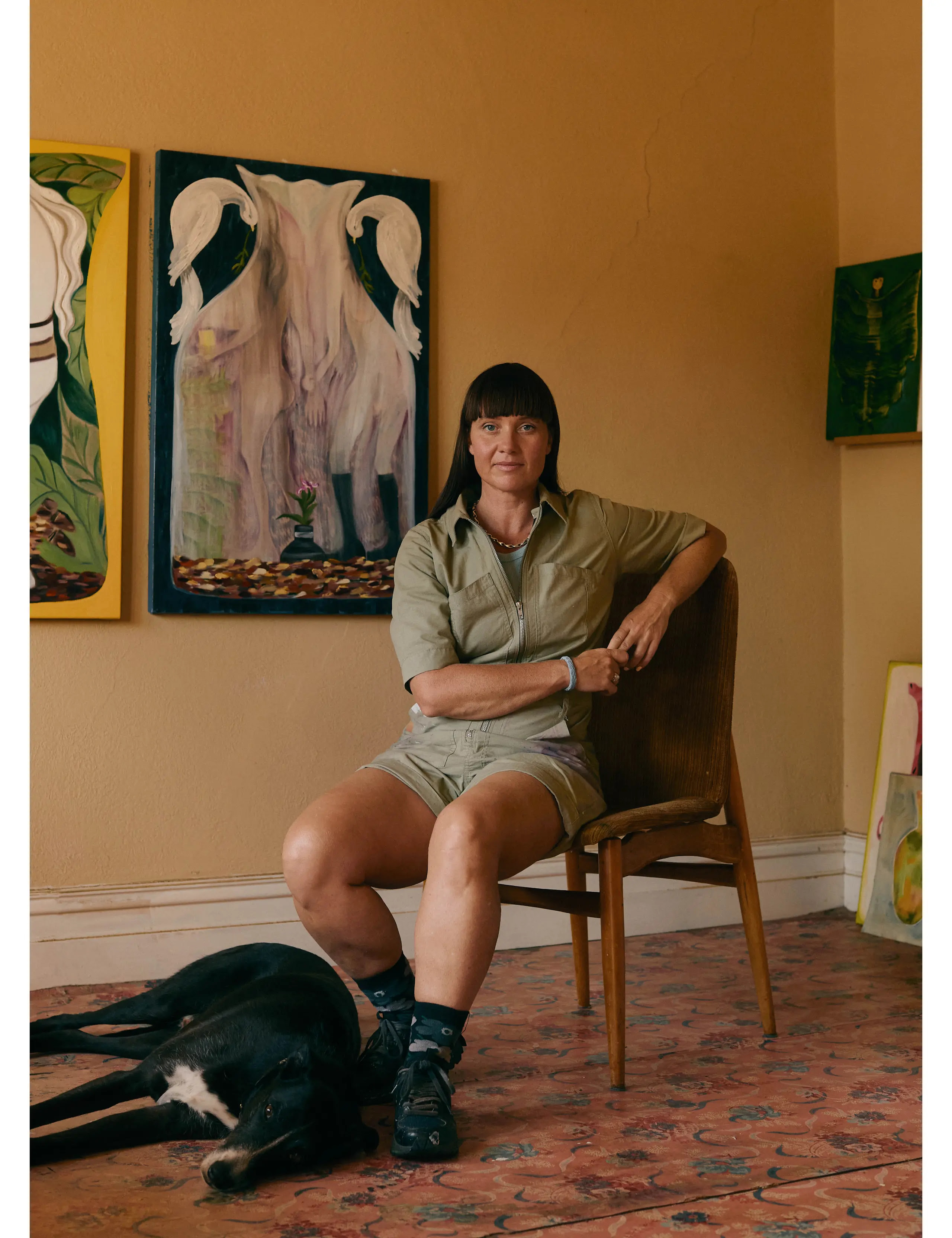
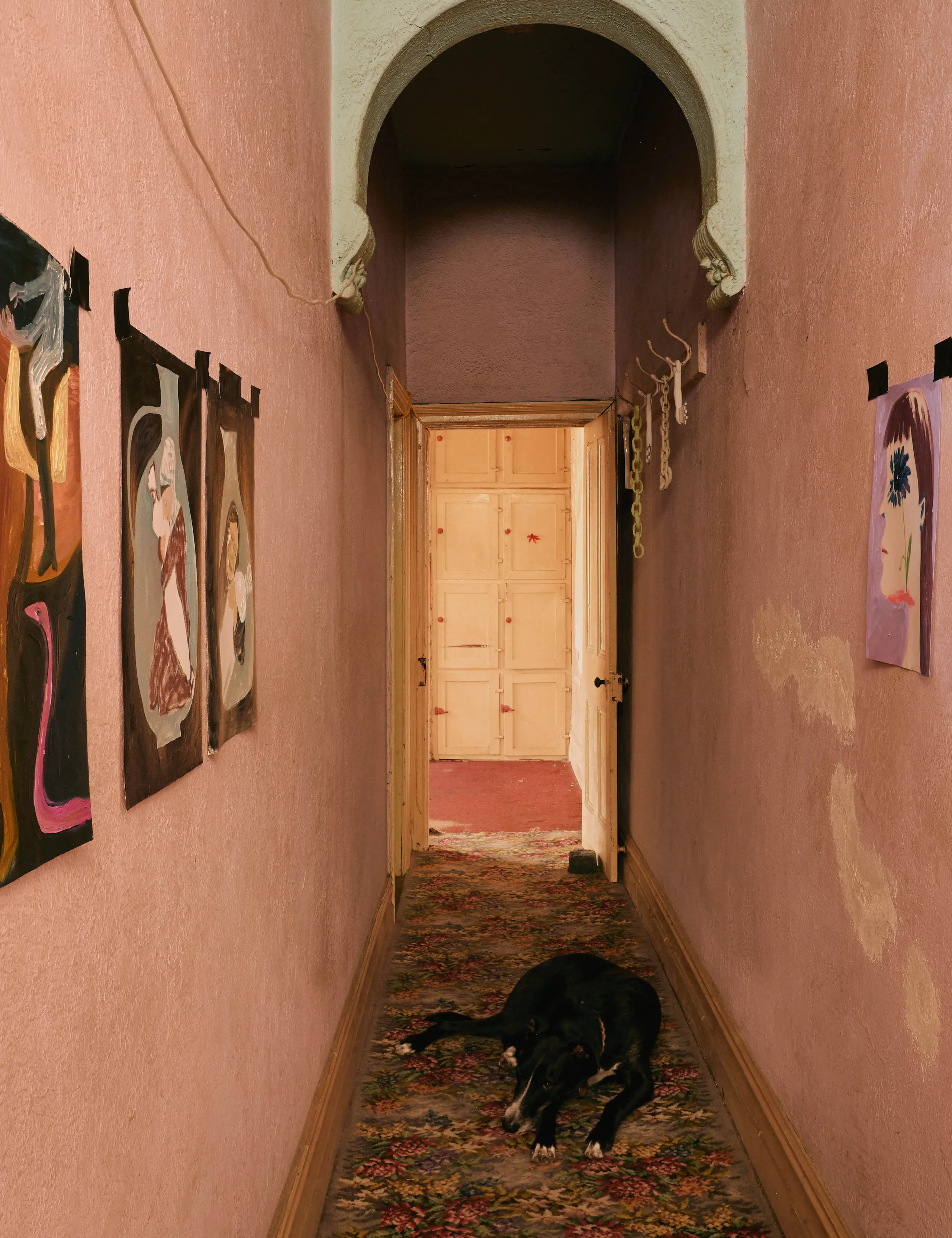
Artist Tai Snaith Paints From A Beautiful ‘Haunted’ House In Fitzroy North

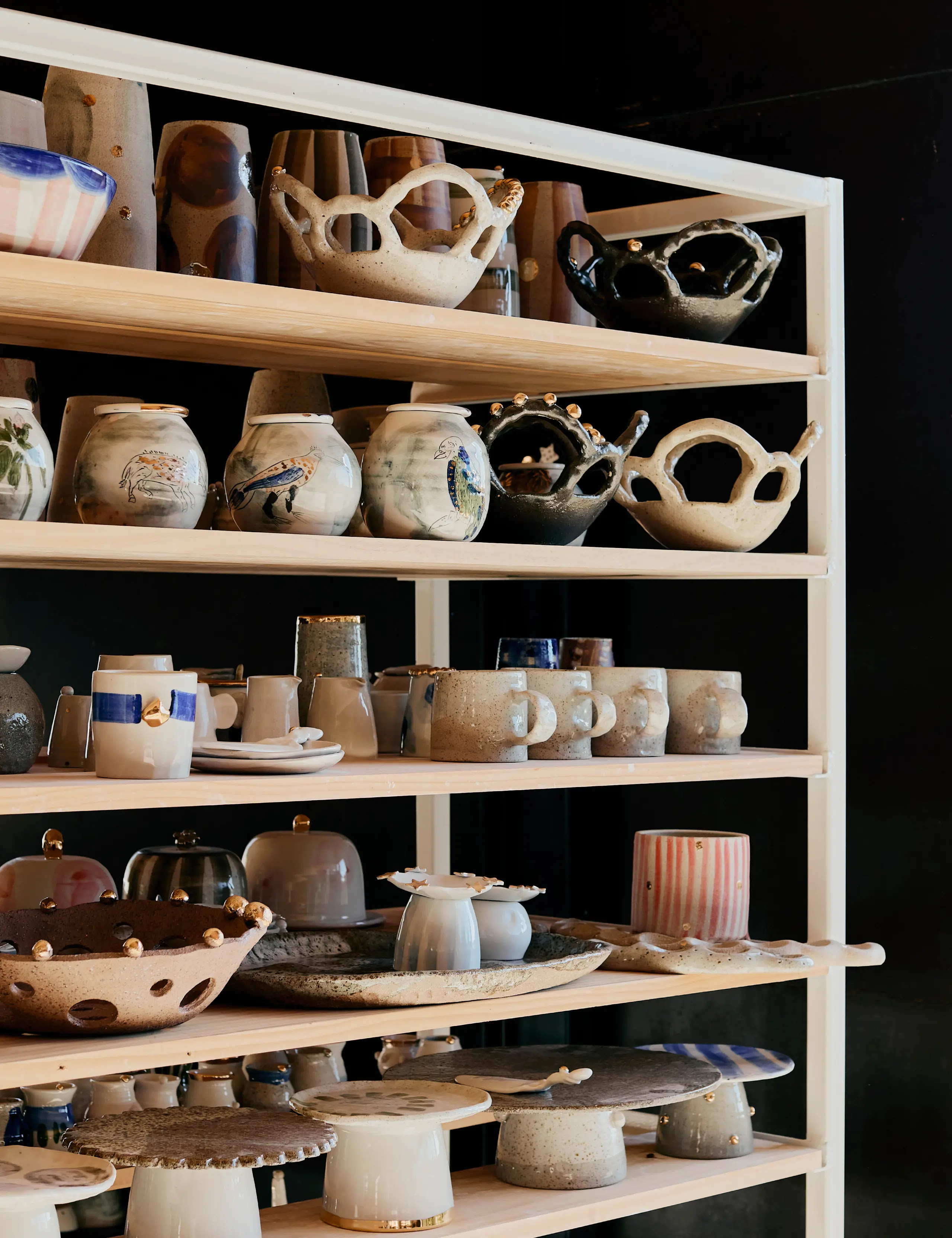
This Potter Makes Petal-Edged Bowls To Help Save The Bees
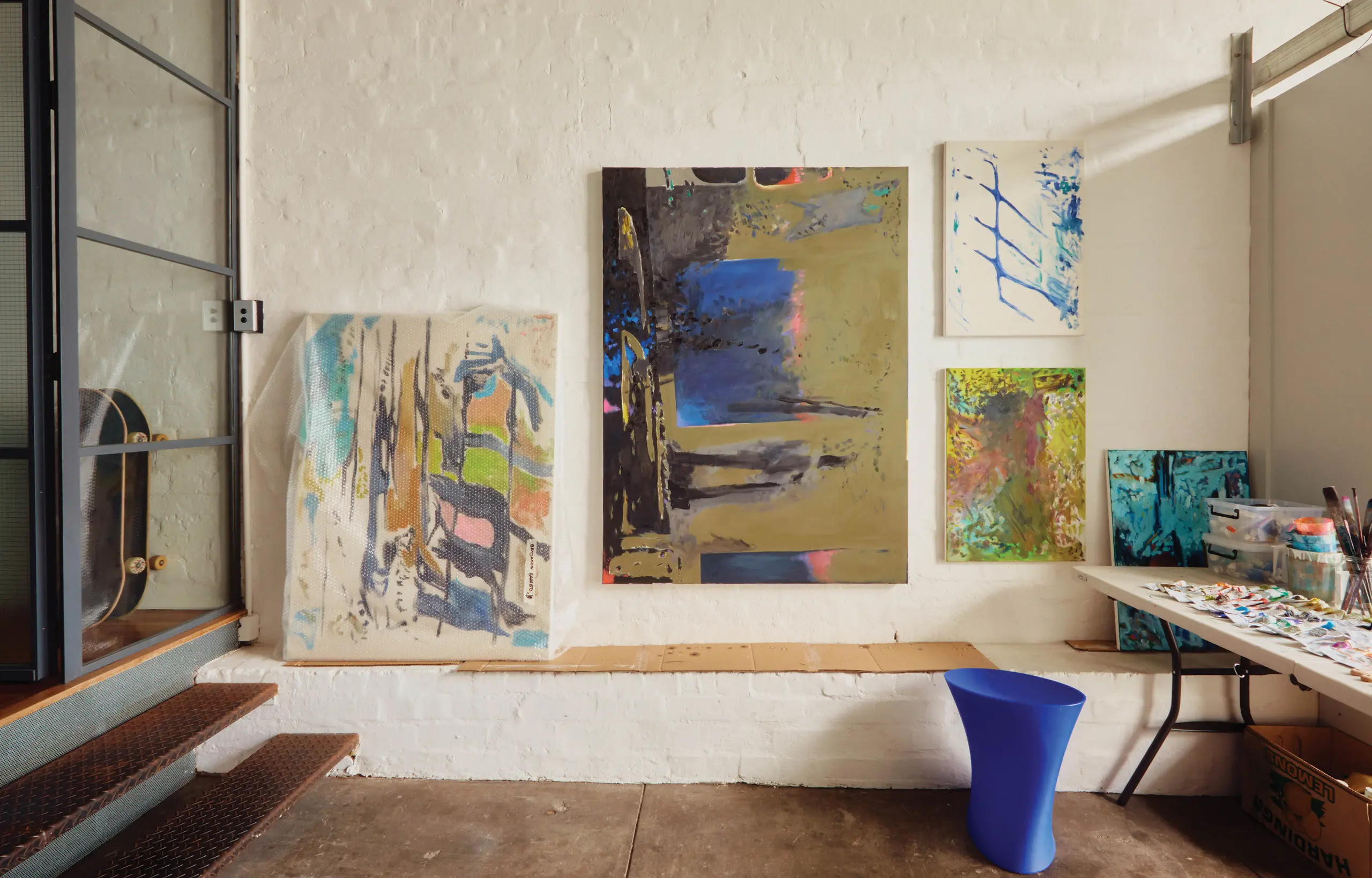
The Diverse And Experimental Art Practice Of Benjamin Barretto
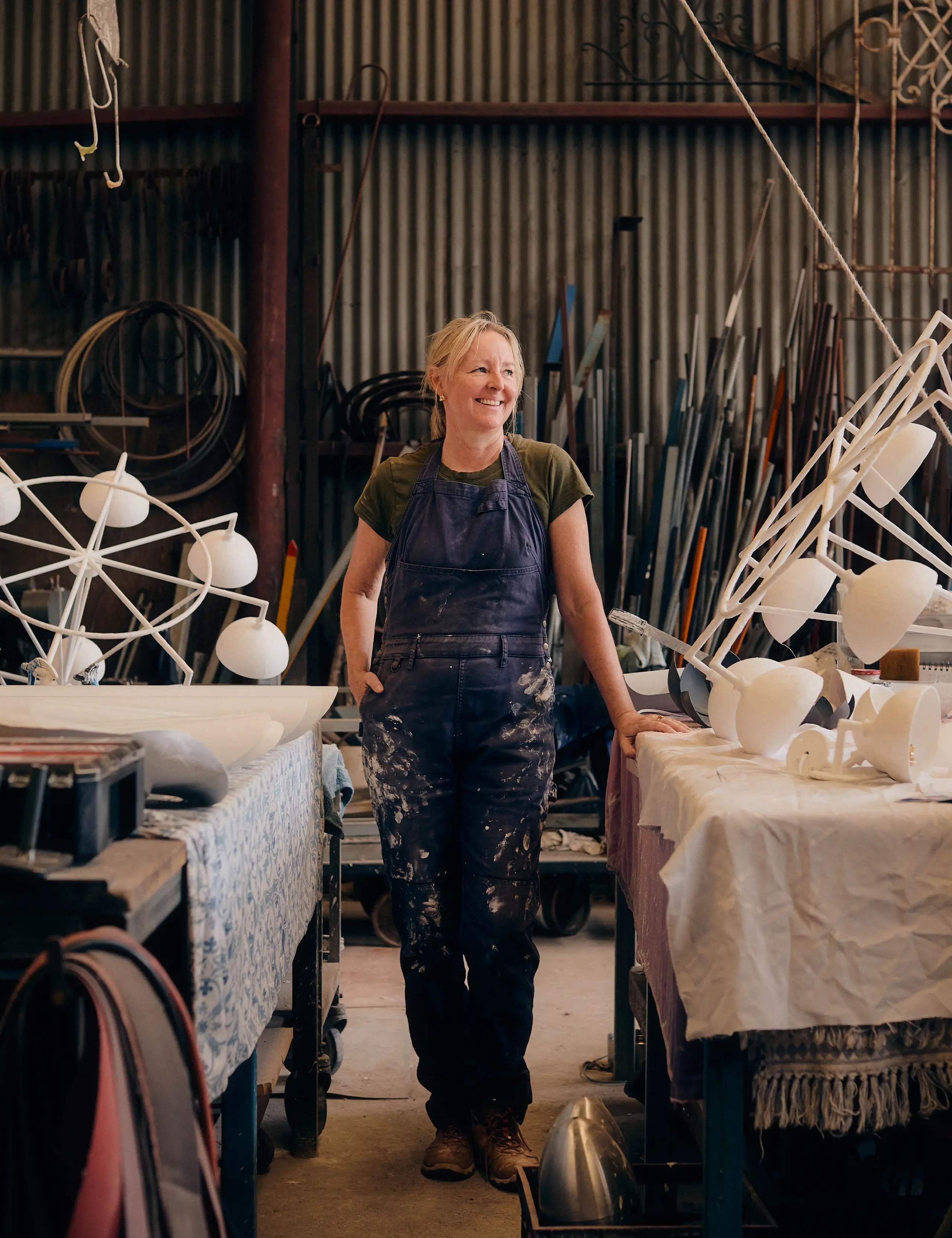
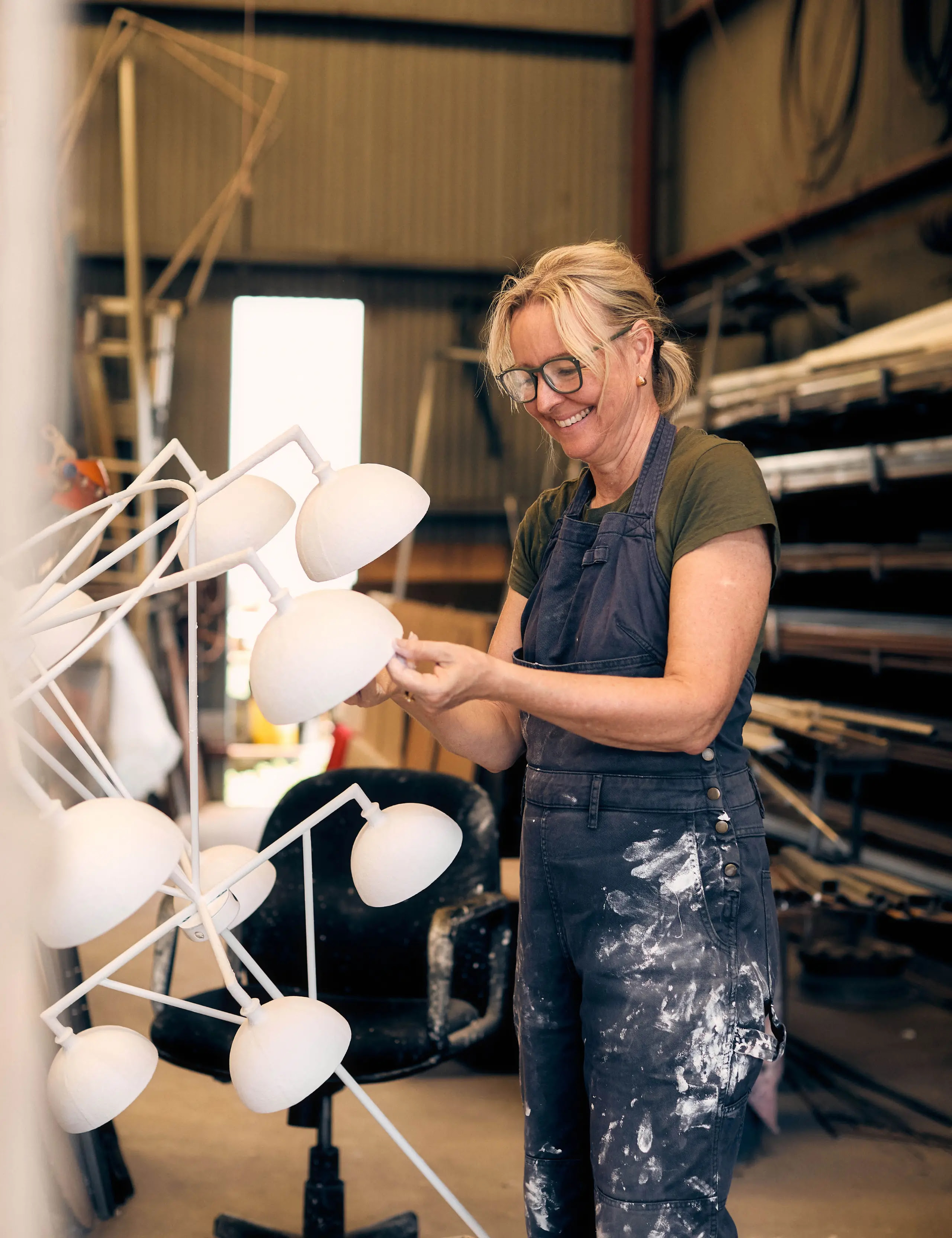
Meet The Metal Maker Behind These Elegant, Handcrafted Lights
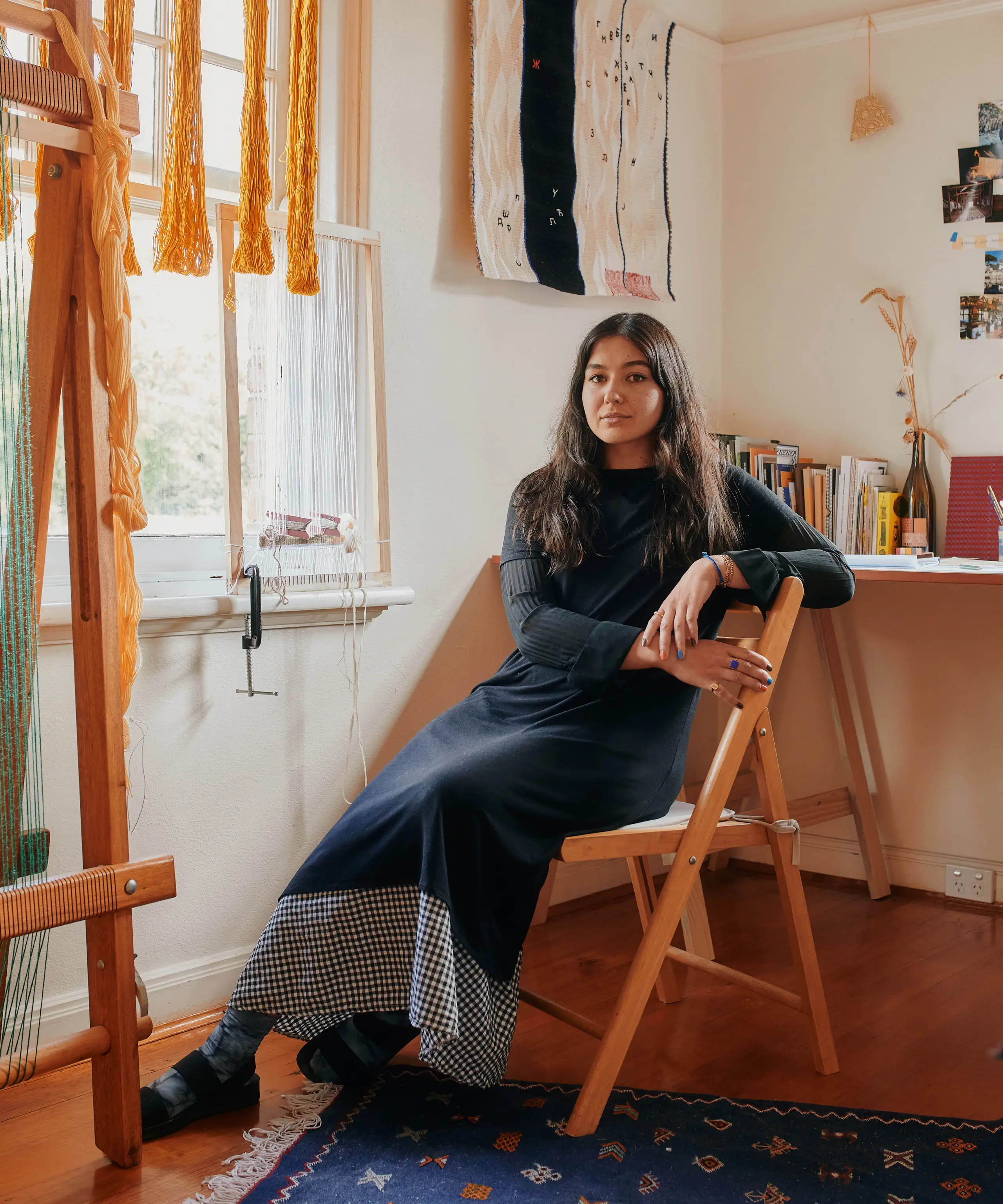
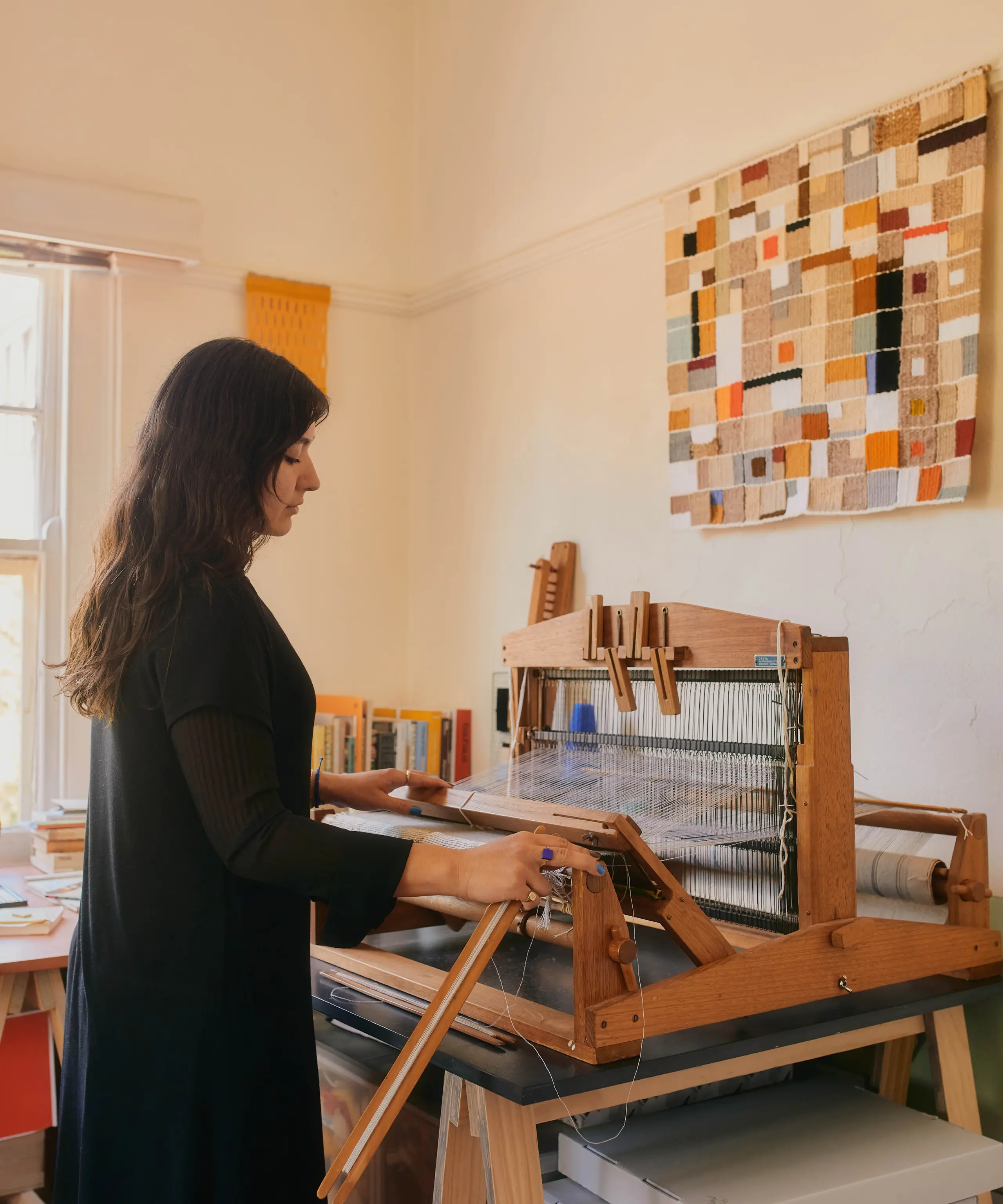
This Melbourne Artist Creates Beautiful Weavings Inspired By The Past
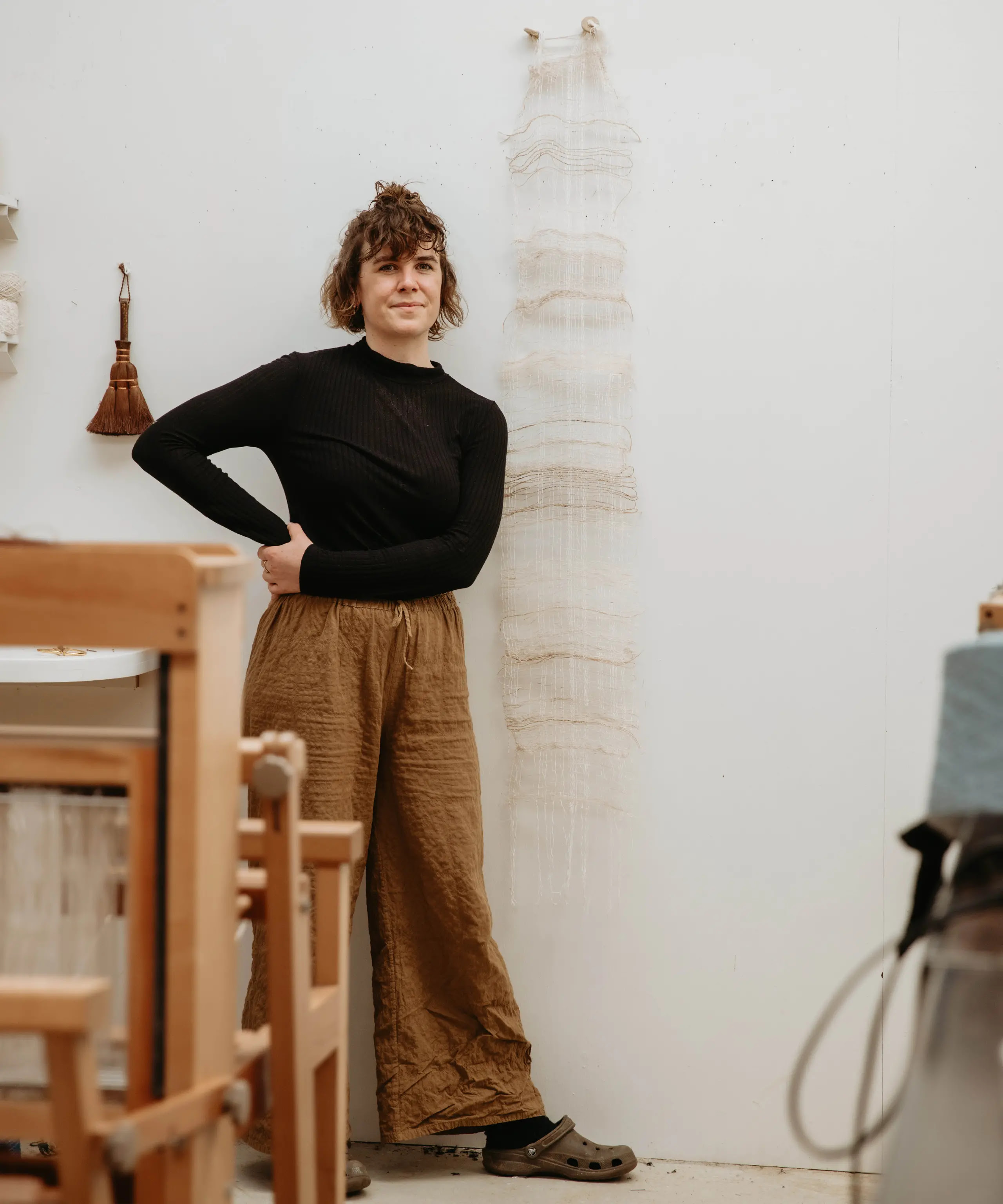

The Functional + Decorative Weavings Of Sundance Studio’s Emma Shepherd
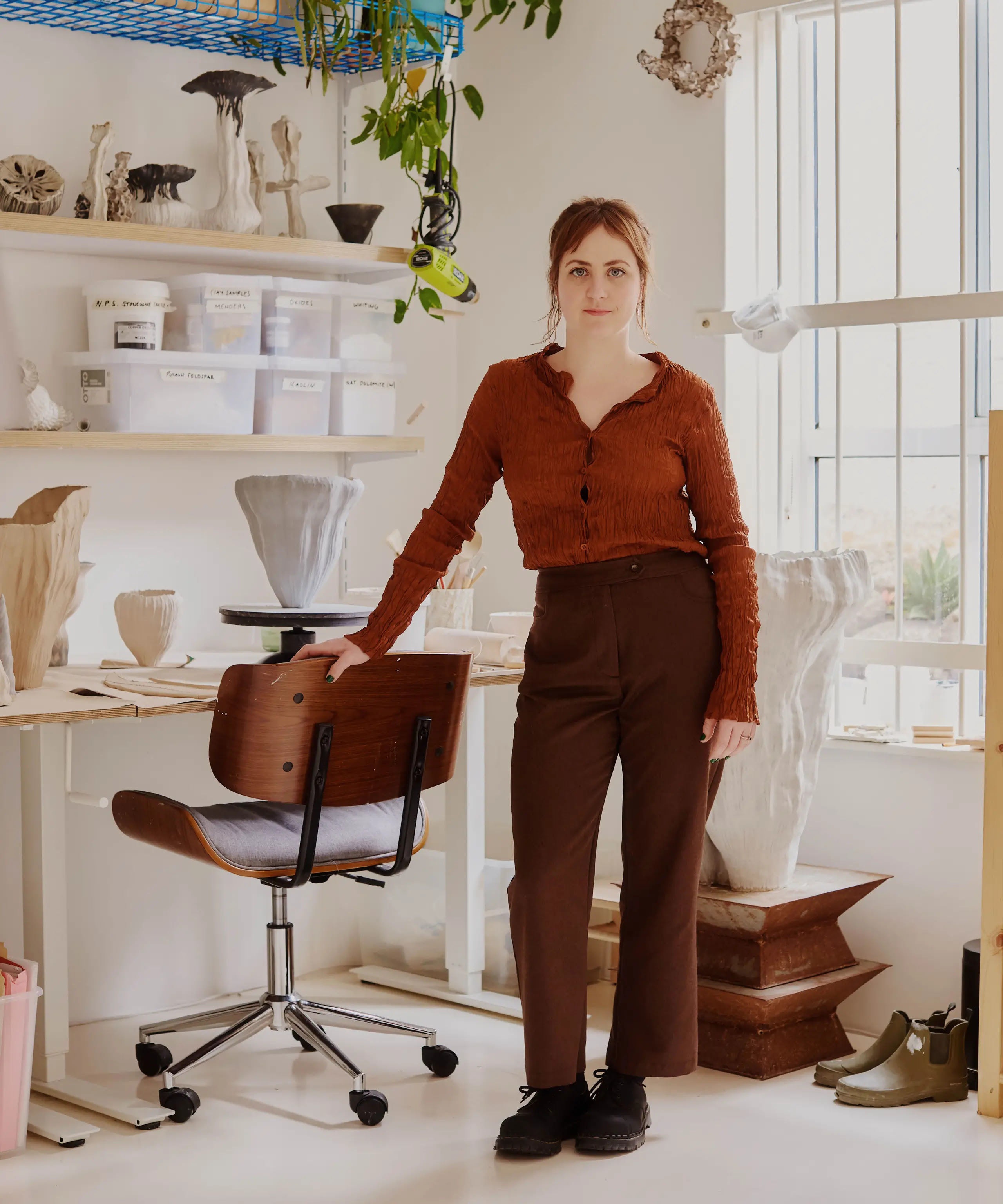
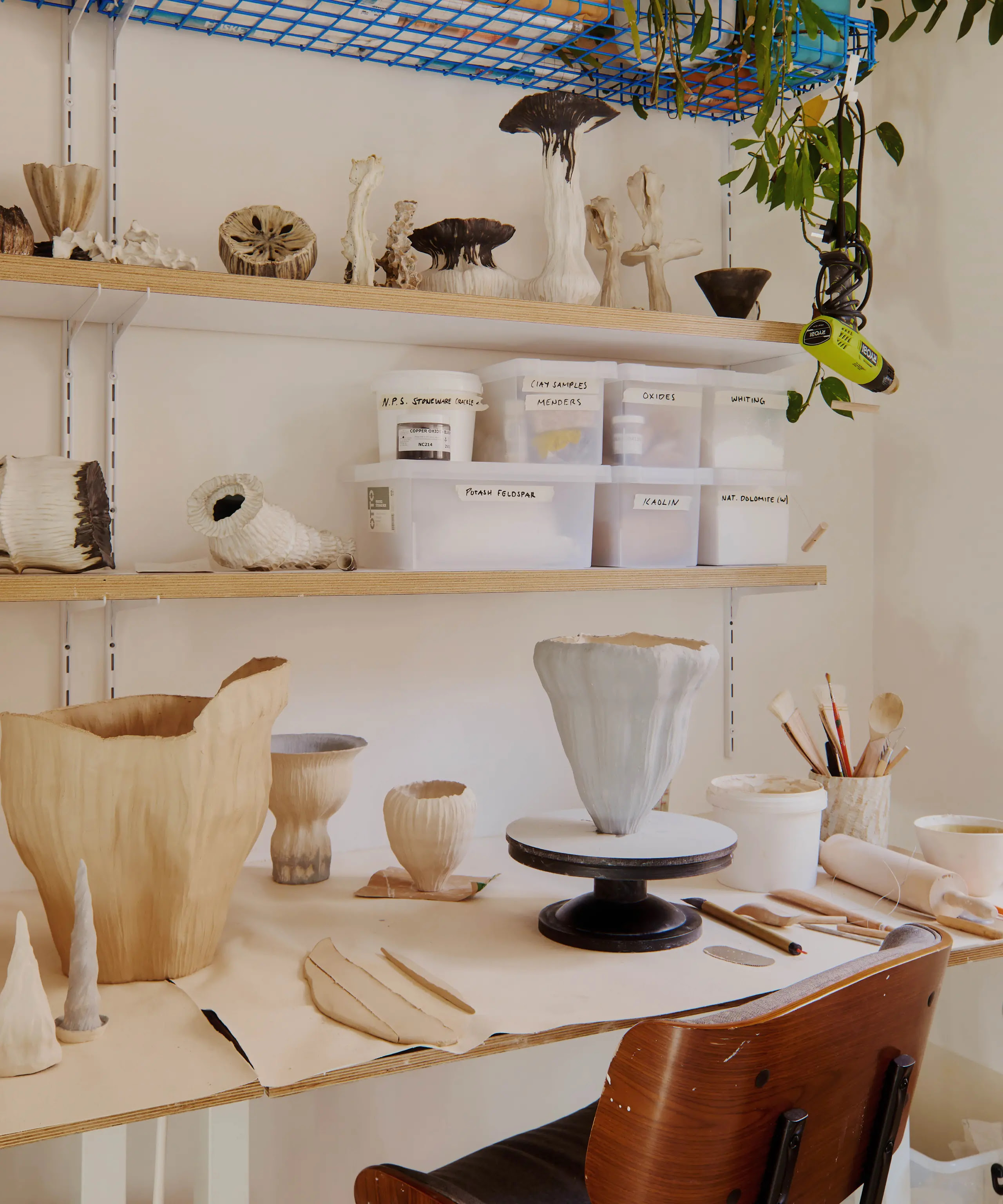
The Artist Making ‘Other-Worldly’ Ceramics Inspired By Plants, Coral and Fungi
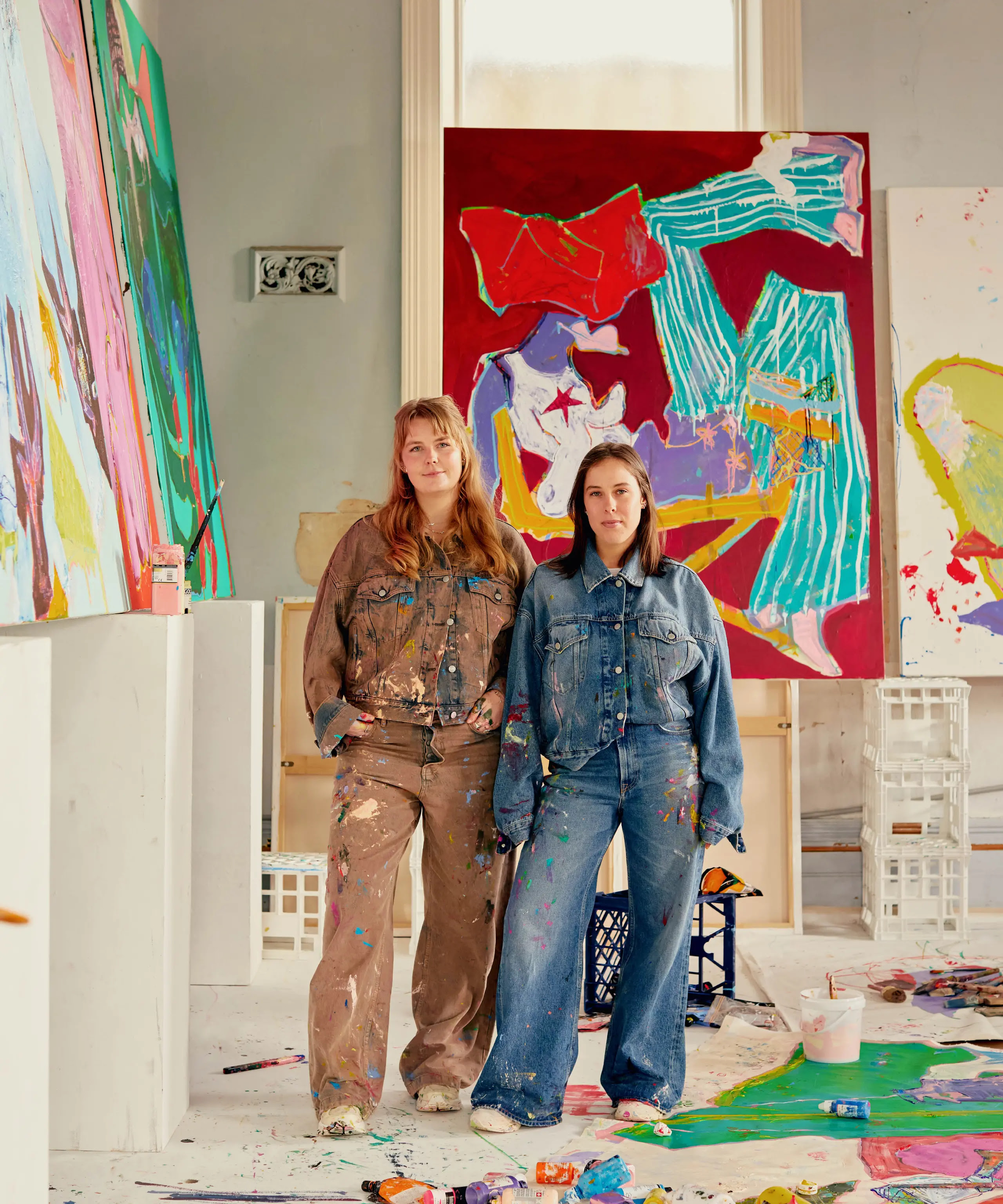
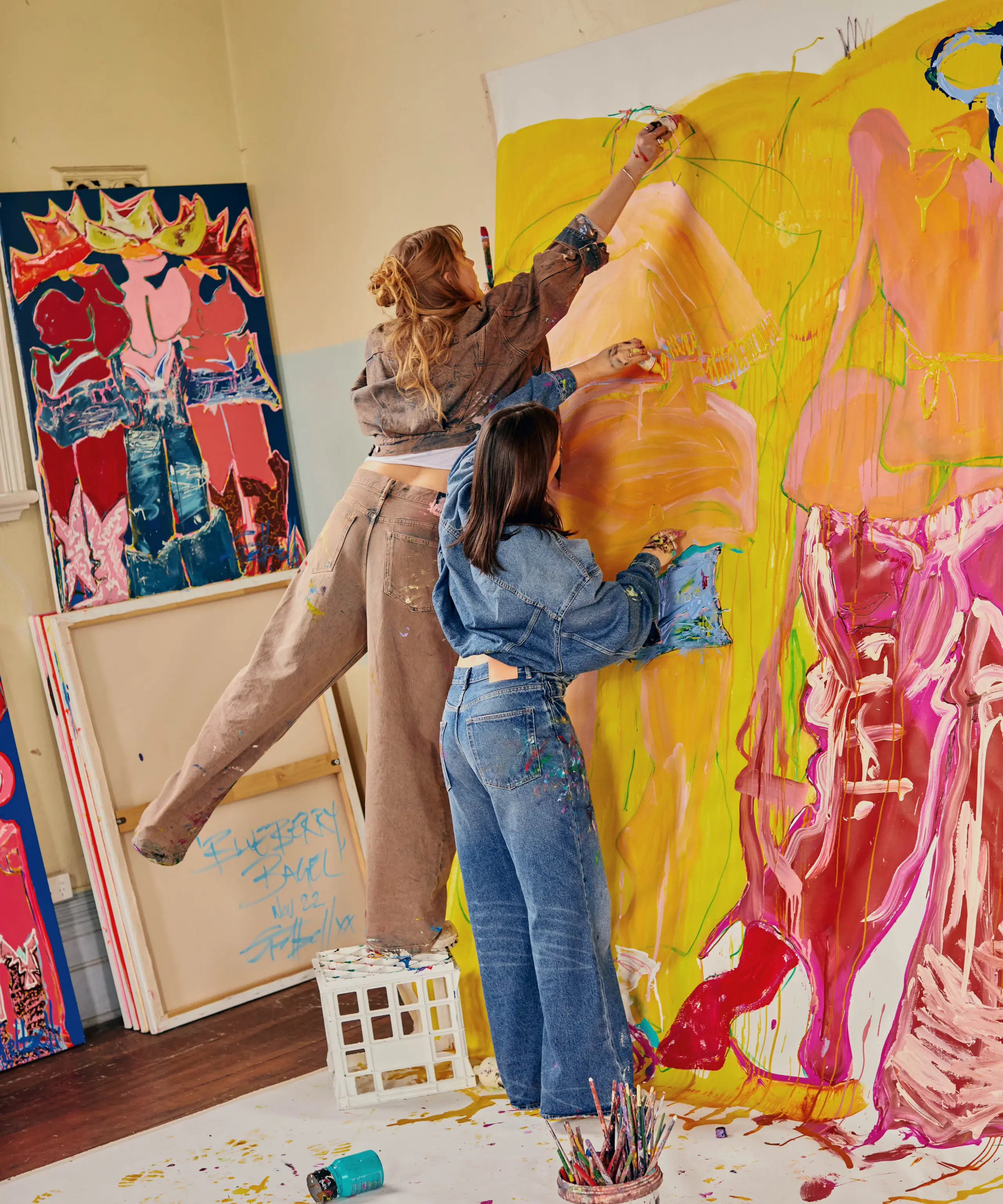
Meet Gelbell, The Best Friends Creating Colourful + Chaotic Abstract Paintings — Together!
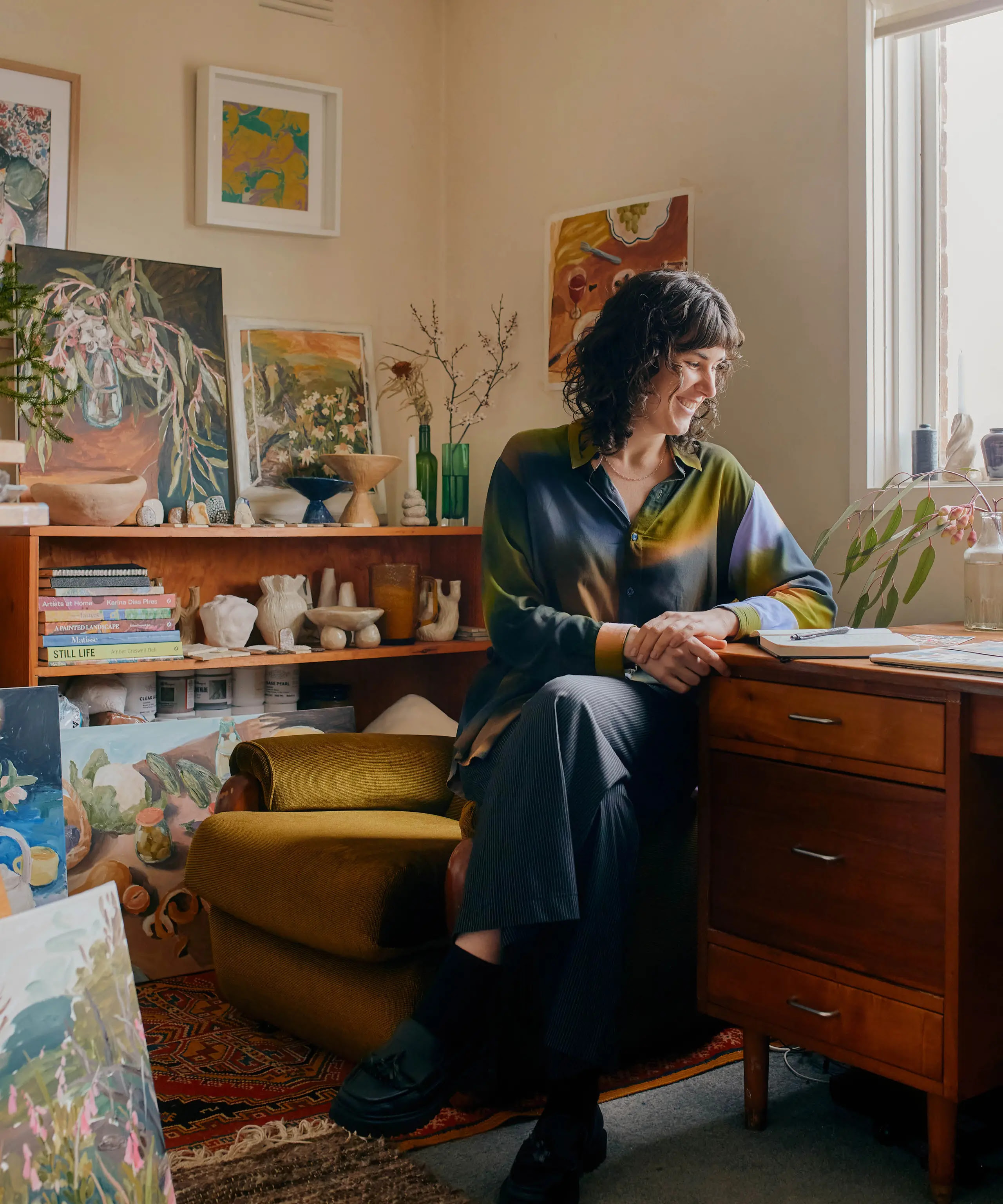
This Talented Still-Life Painter Is One To Watch
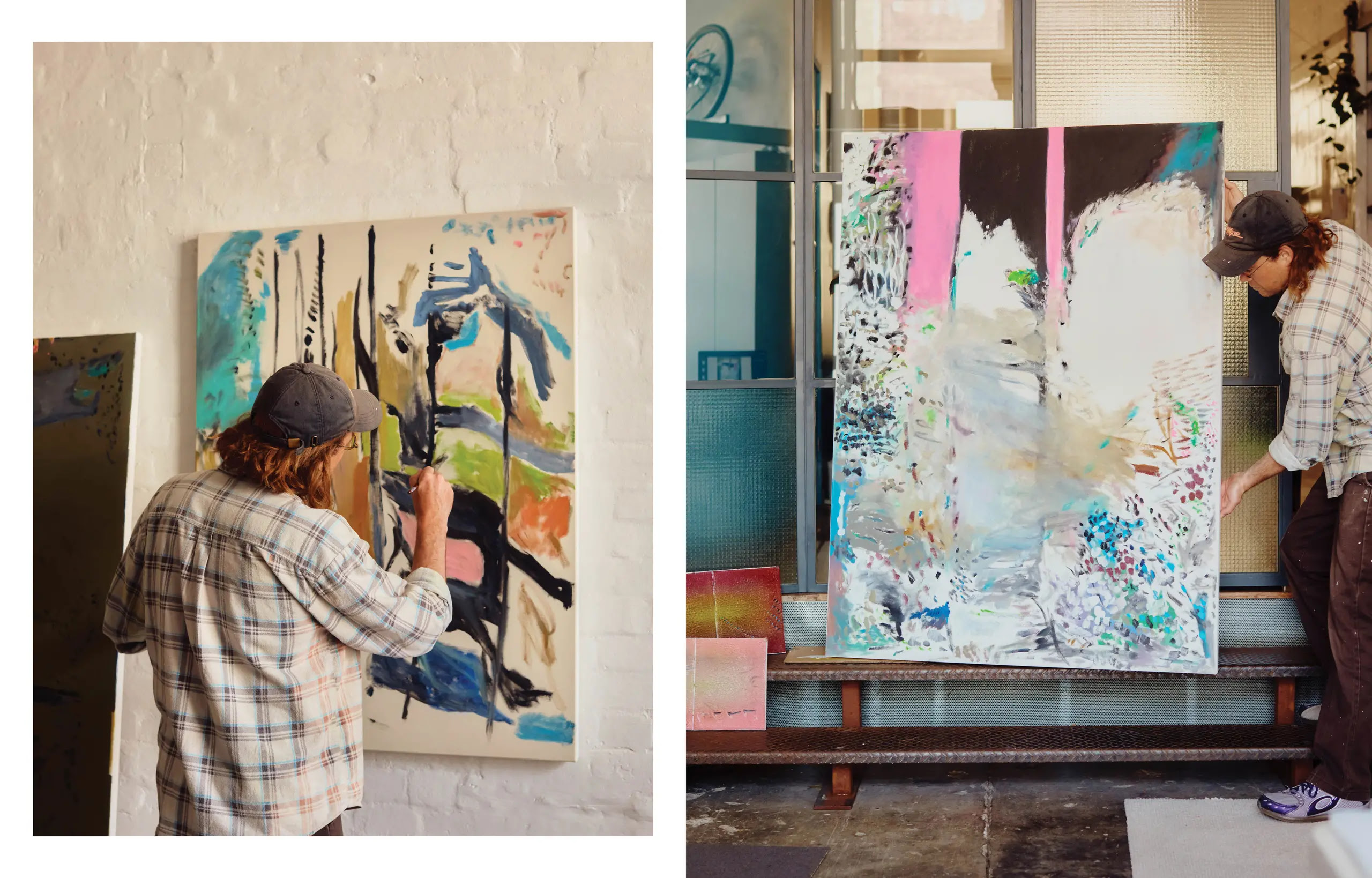
The Design Files acknowledge the Traditional Custodians of the lands on which we work, the Wurundjeri people of the Kulin Nation. We pay our respects to Elders past and present.
First Nations artists, designers, makers, and creative business owners are encouraged to submit their projects for coverage on The Design Files. Please email This email address is being protected from spambots. You need JavaScript enabled to view it.
Why The Internet Is In Love With Libby Haines’ Beautiful Still-Life Paintings
How Powerhouse Designer Lucy Simpson Is Making Waves
https://thedesignfiles.net/
How Powerhouse Designer, Yuwaalaraay Woman Lucy Simpson Is Making Waves
Yuwaalaraay Woman Lucy Simpson works across various mediums in her work as creative director and principal designer of her studio, Gaawaa Miyay.

From painting to weaving, printmaking, textile design, and more recently, glasswork, to Lucy it’s not a matter of defining whether something is ‘art’ or ‘design’, but rather a decision on what medium, material or technique can be used to communicate a story, place or experience effectively.
This approach has led her to work with well-known brands; Breville, Westpac, Koskela, Artedomus and JAG, as well as exhibit in galleries across Australia.
TDF columnist, Koorie woman and business owner Jirra Lulla Harvey, of Kalinya, caught up with Lucy in her Wangal/Sydney-based studio recently to talk about her connection to Country, and how she communicates this in her creative process.
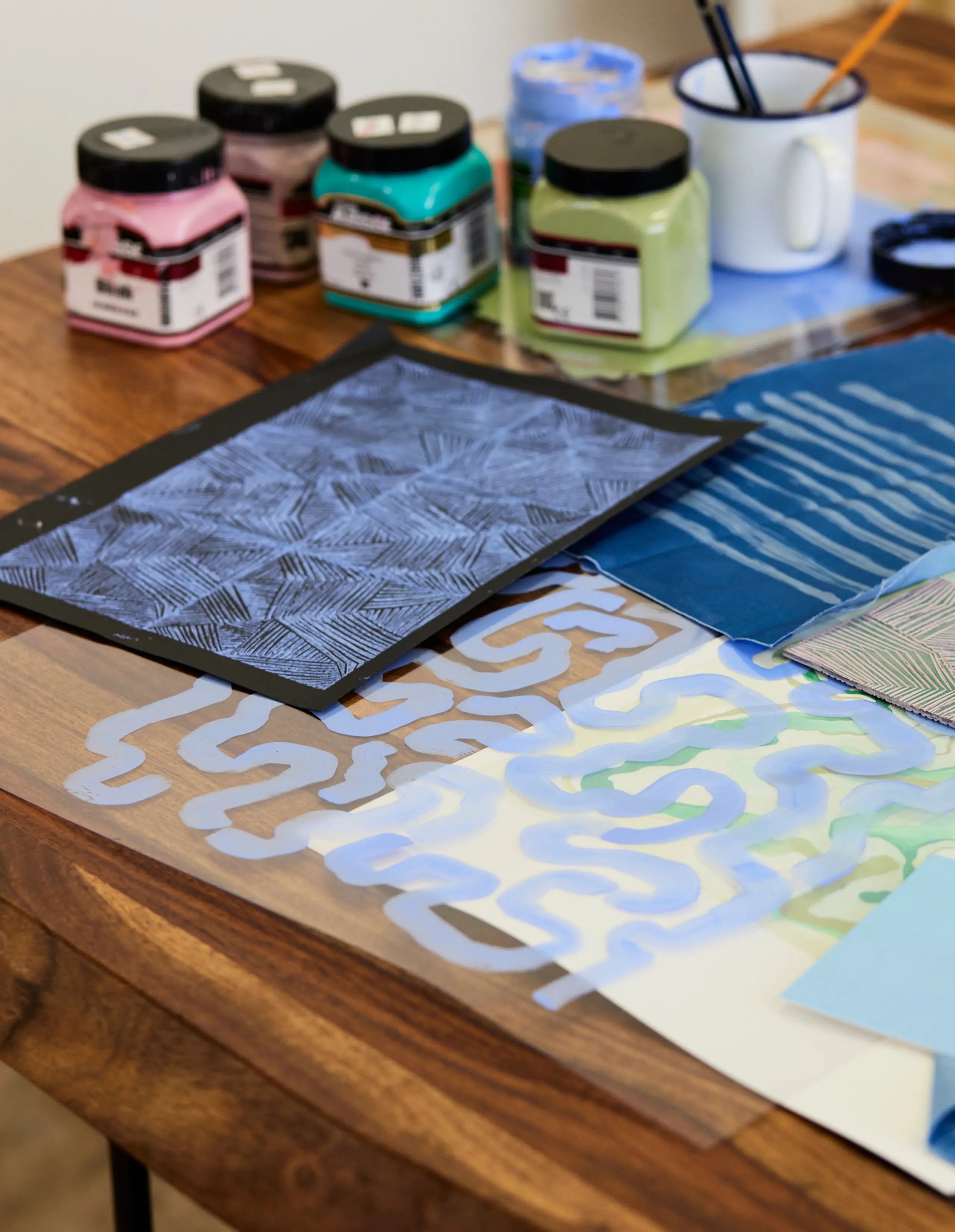
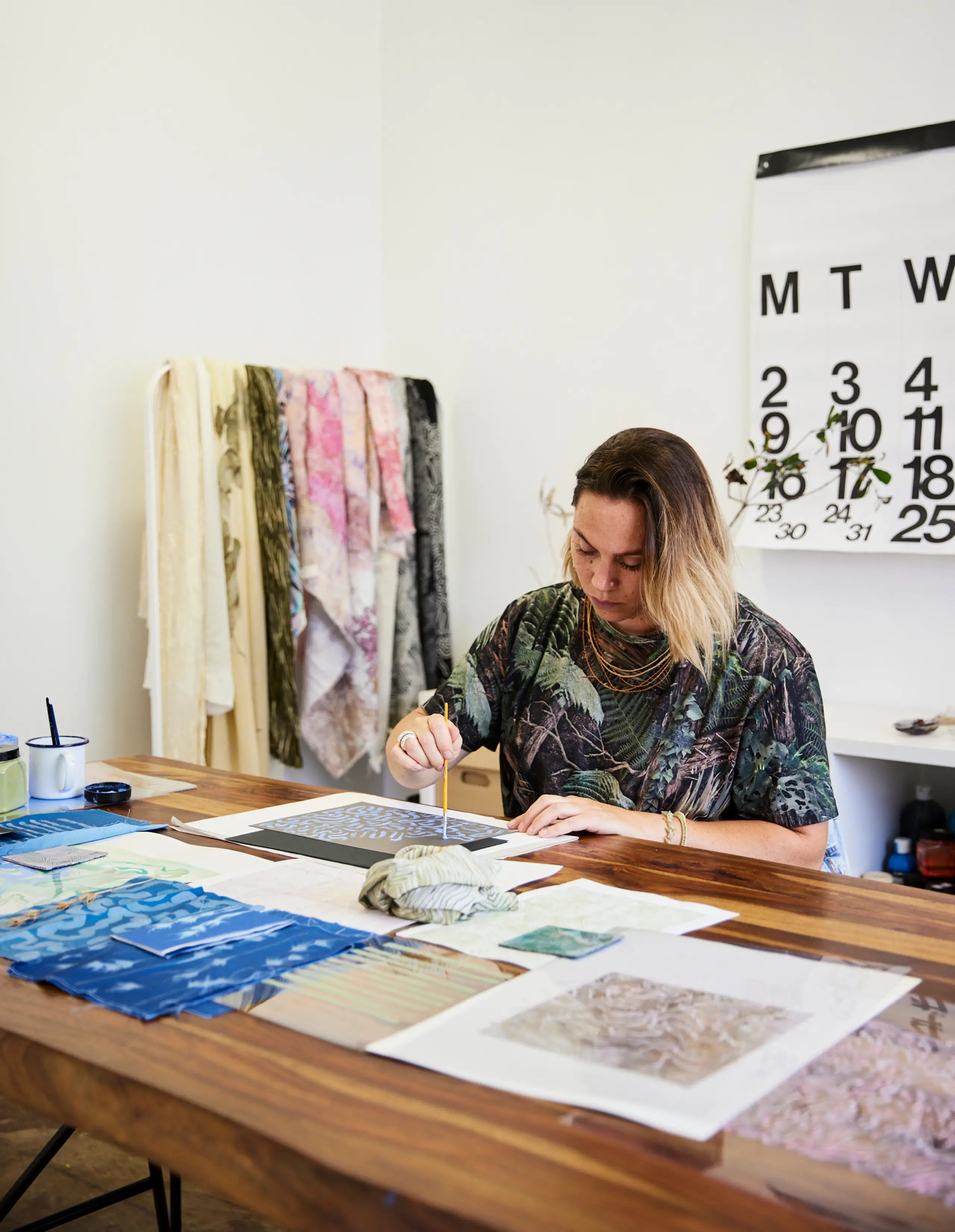
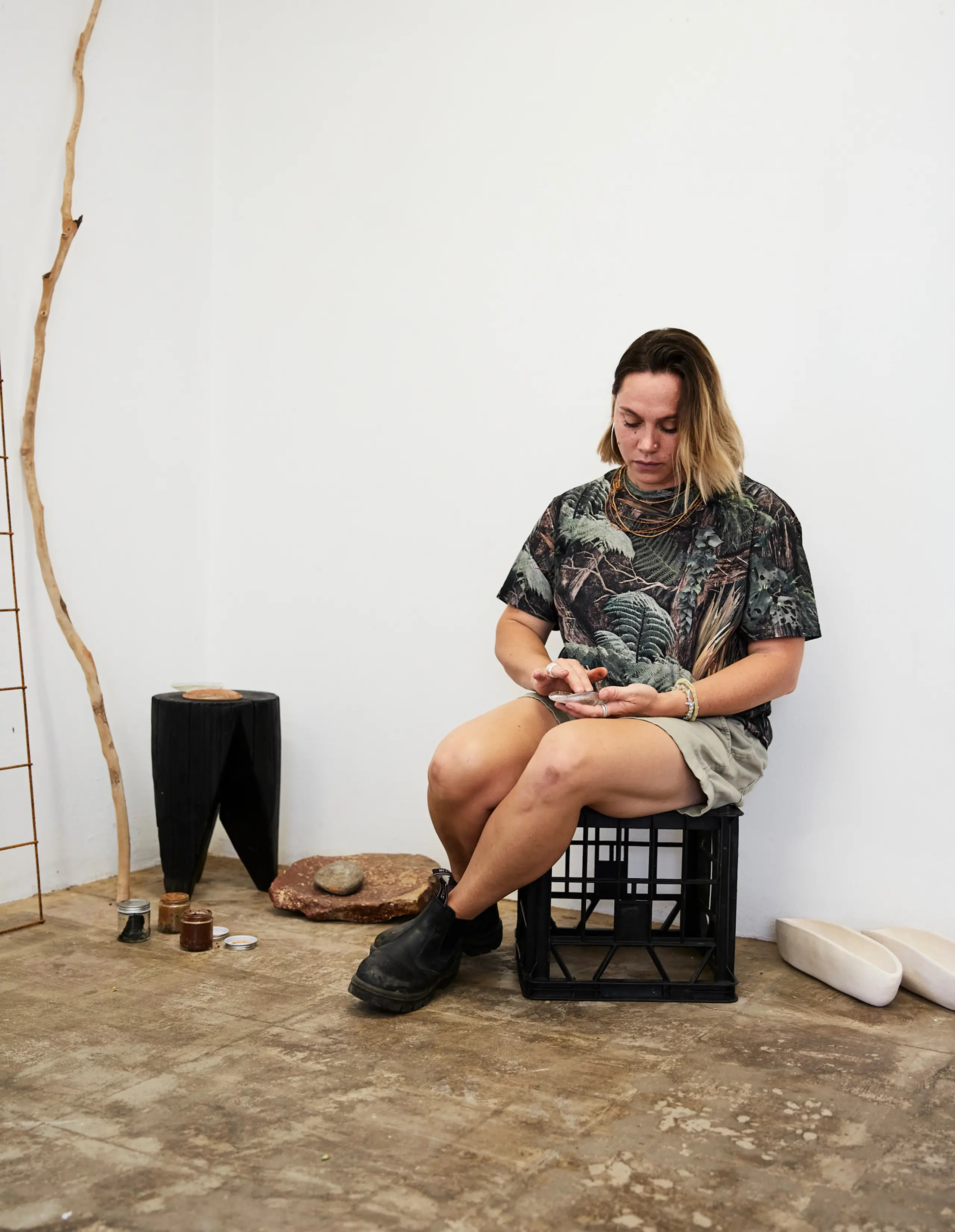
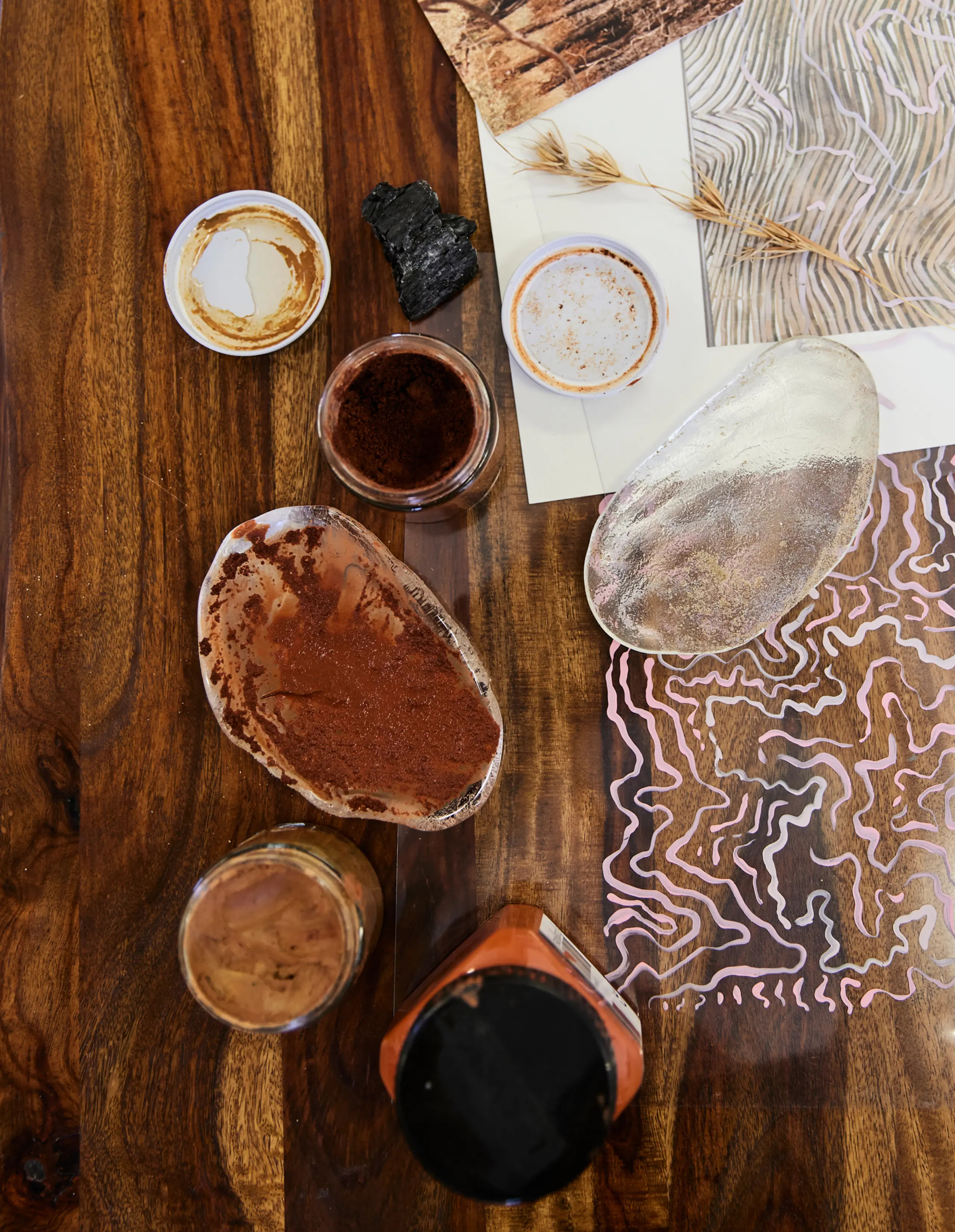
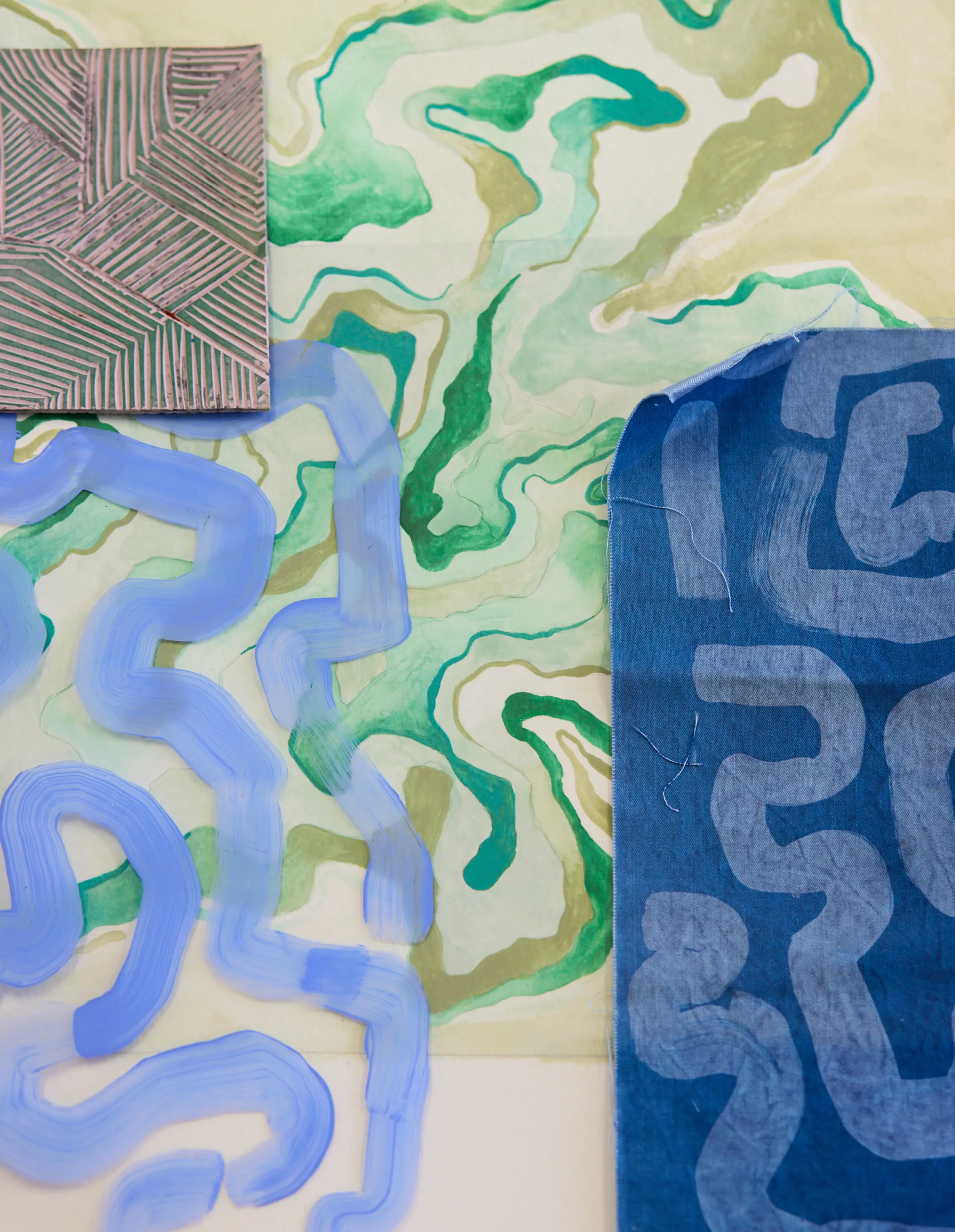
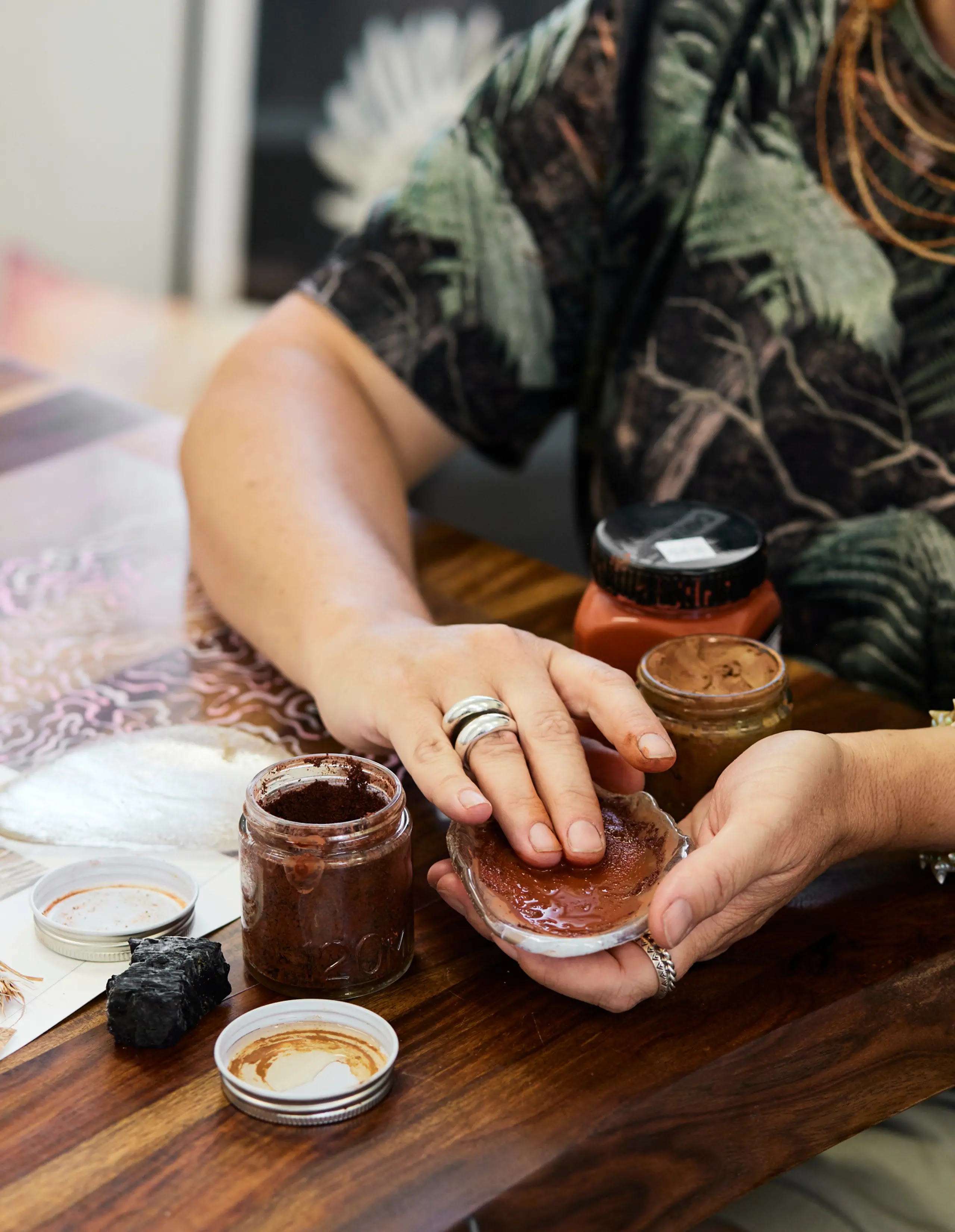
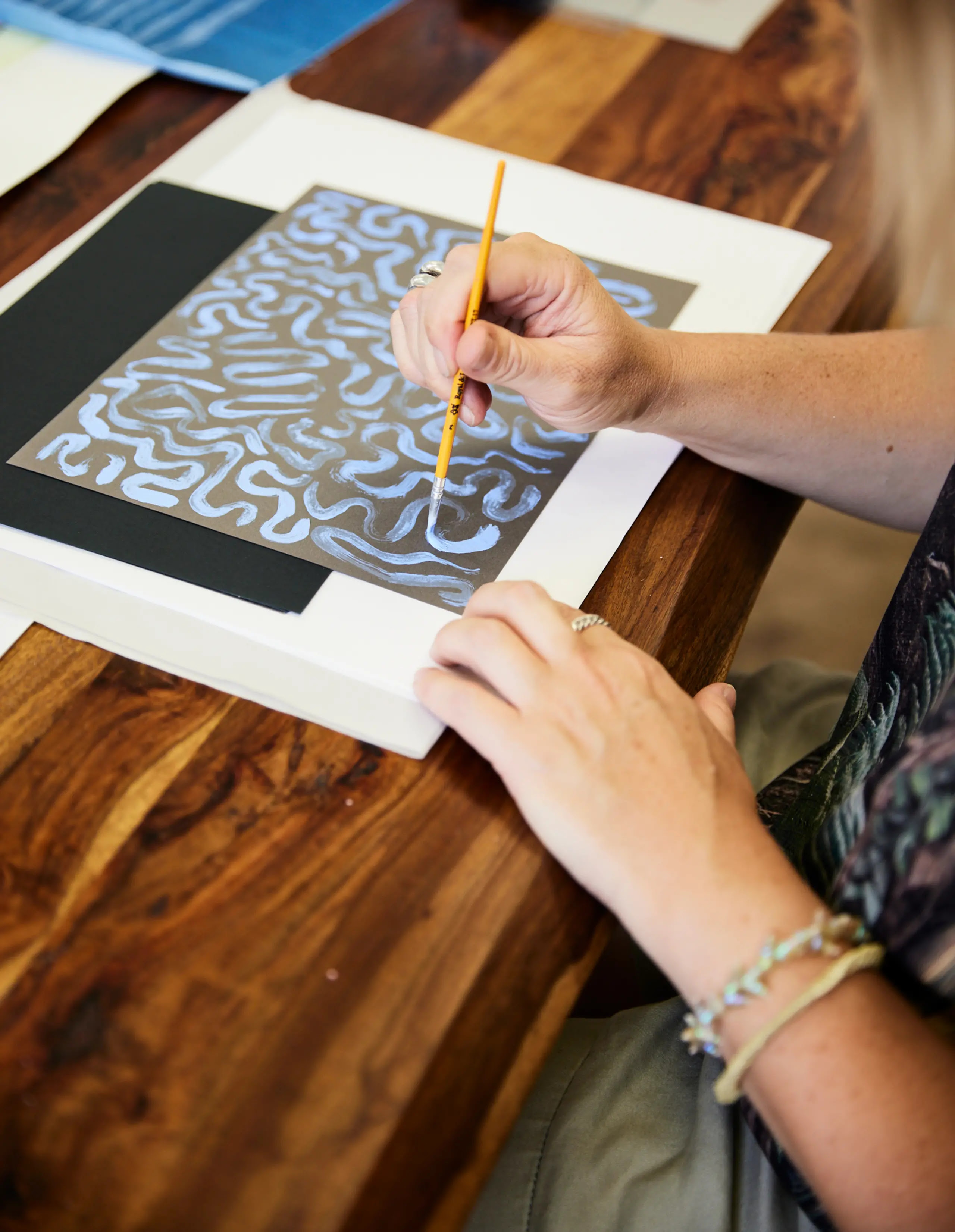

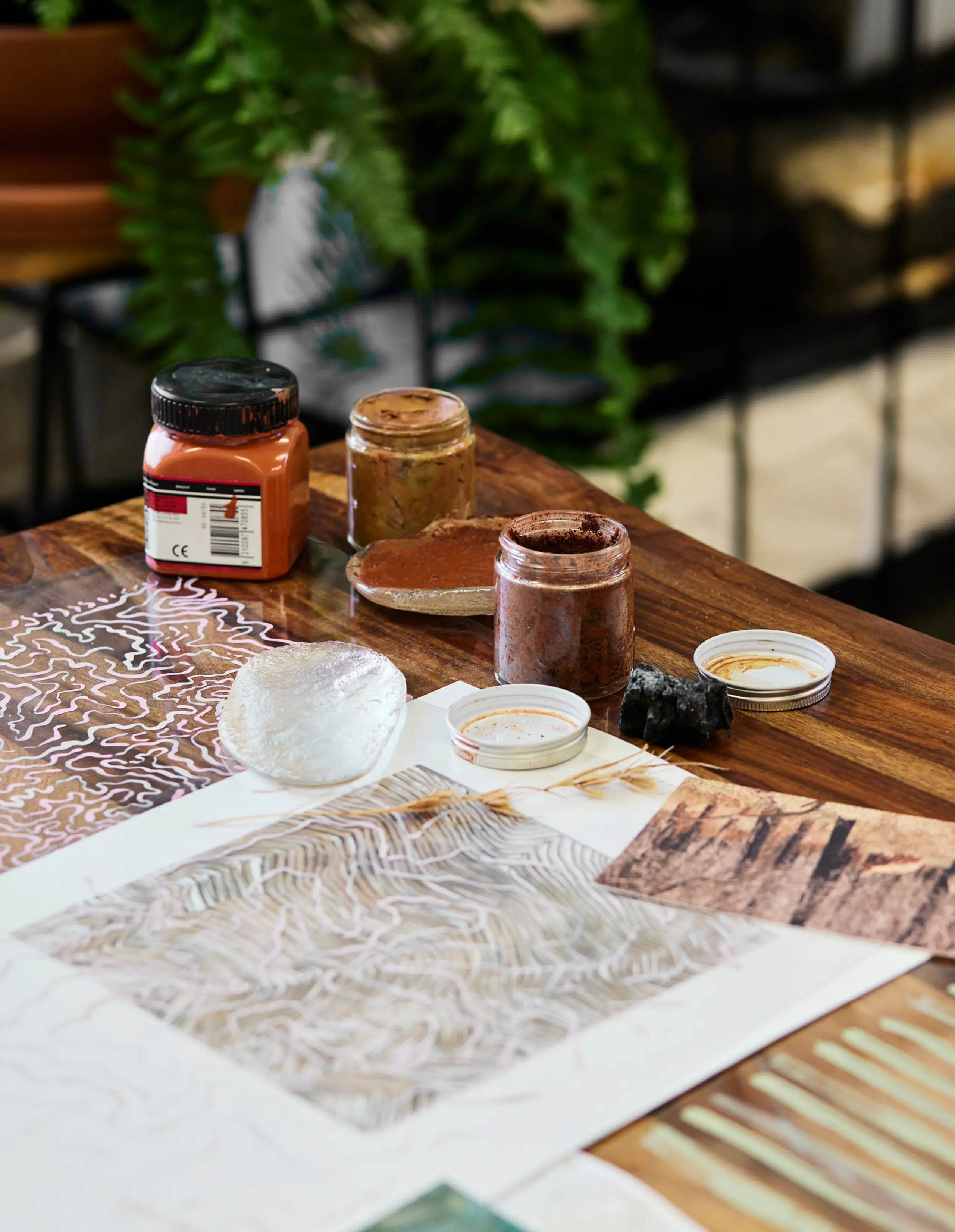
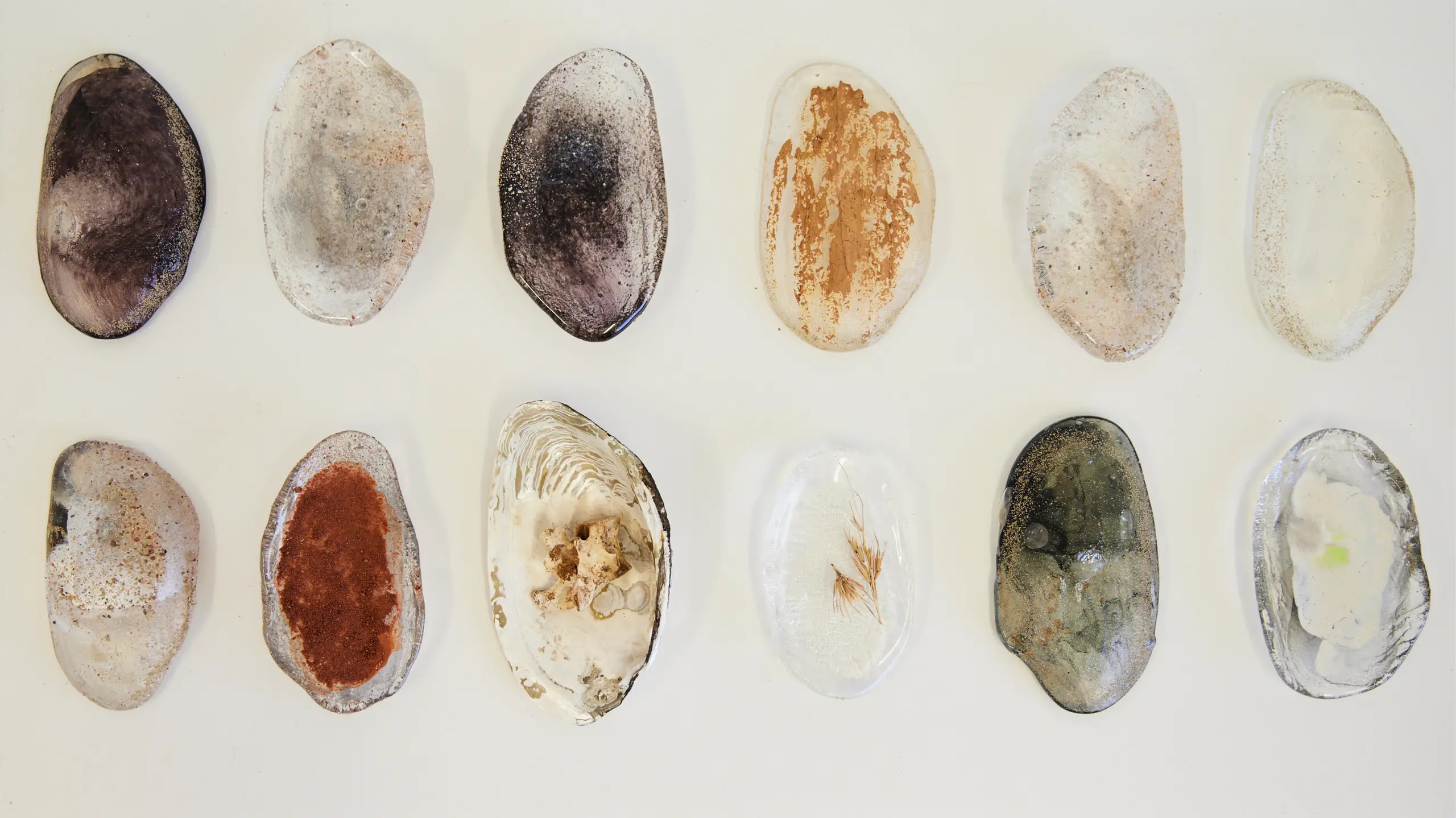
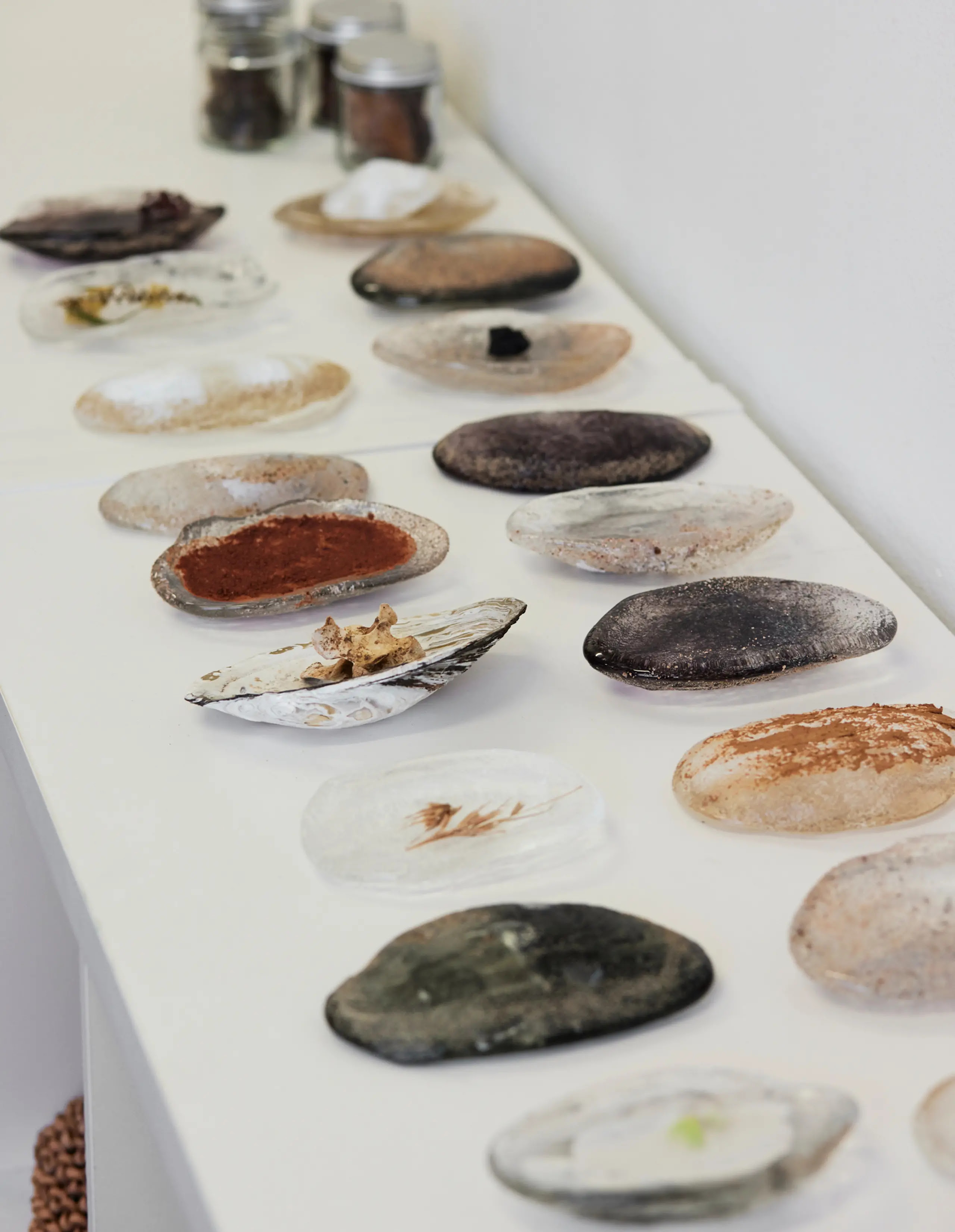
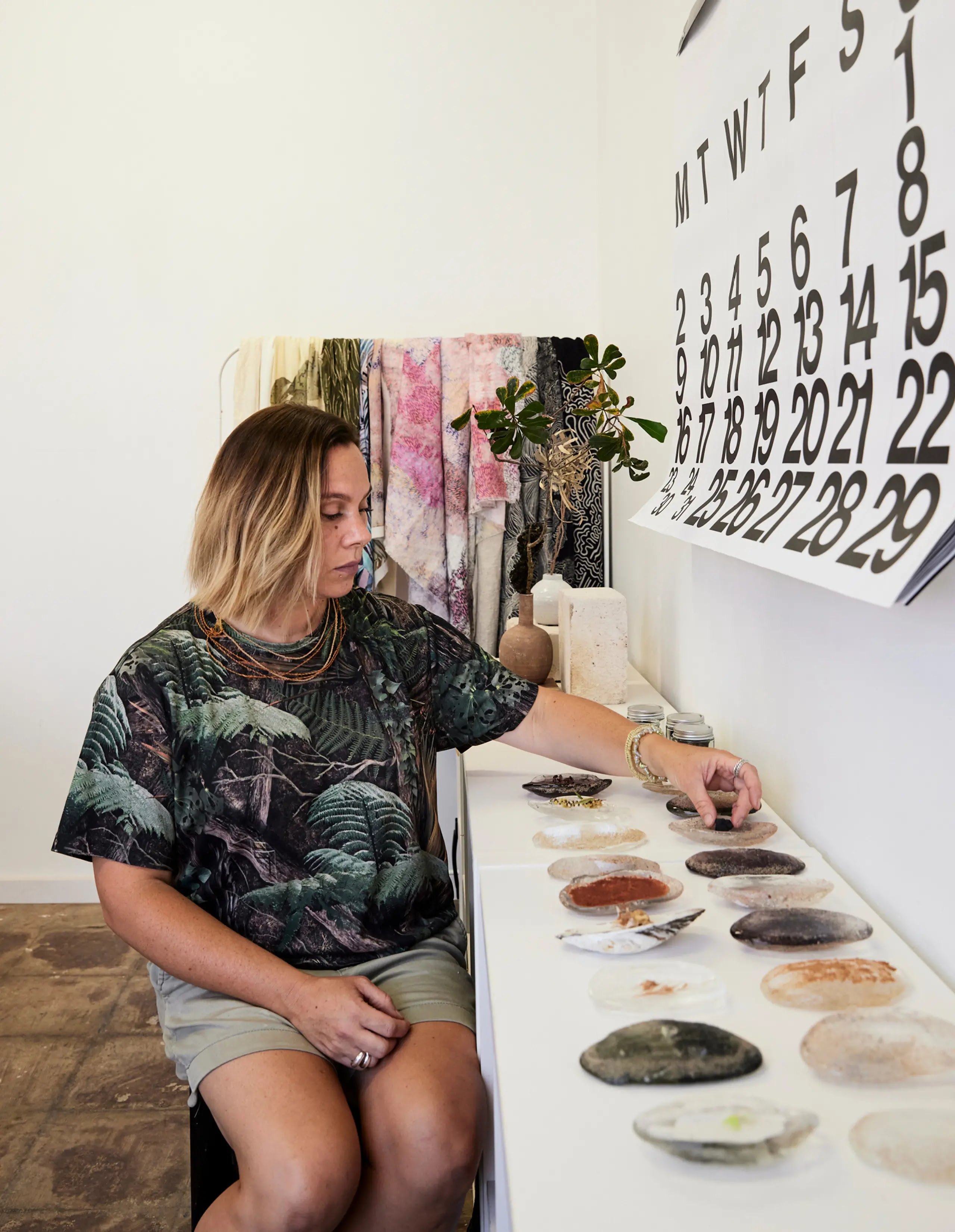
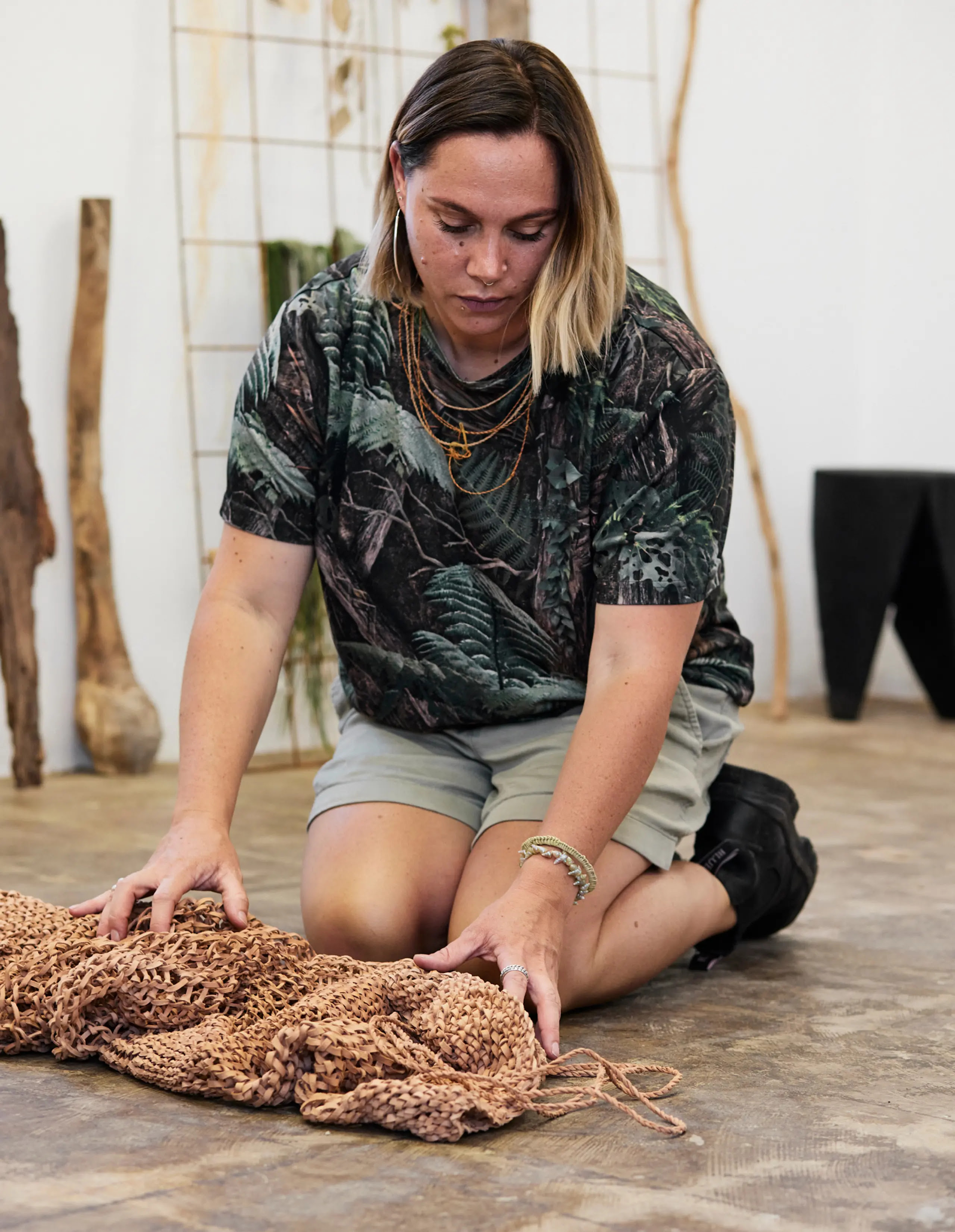

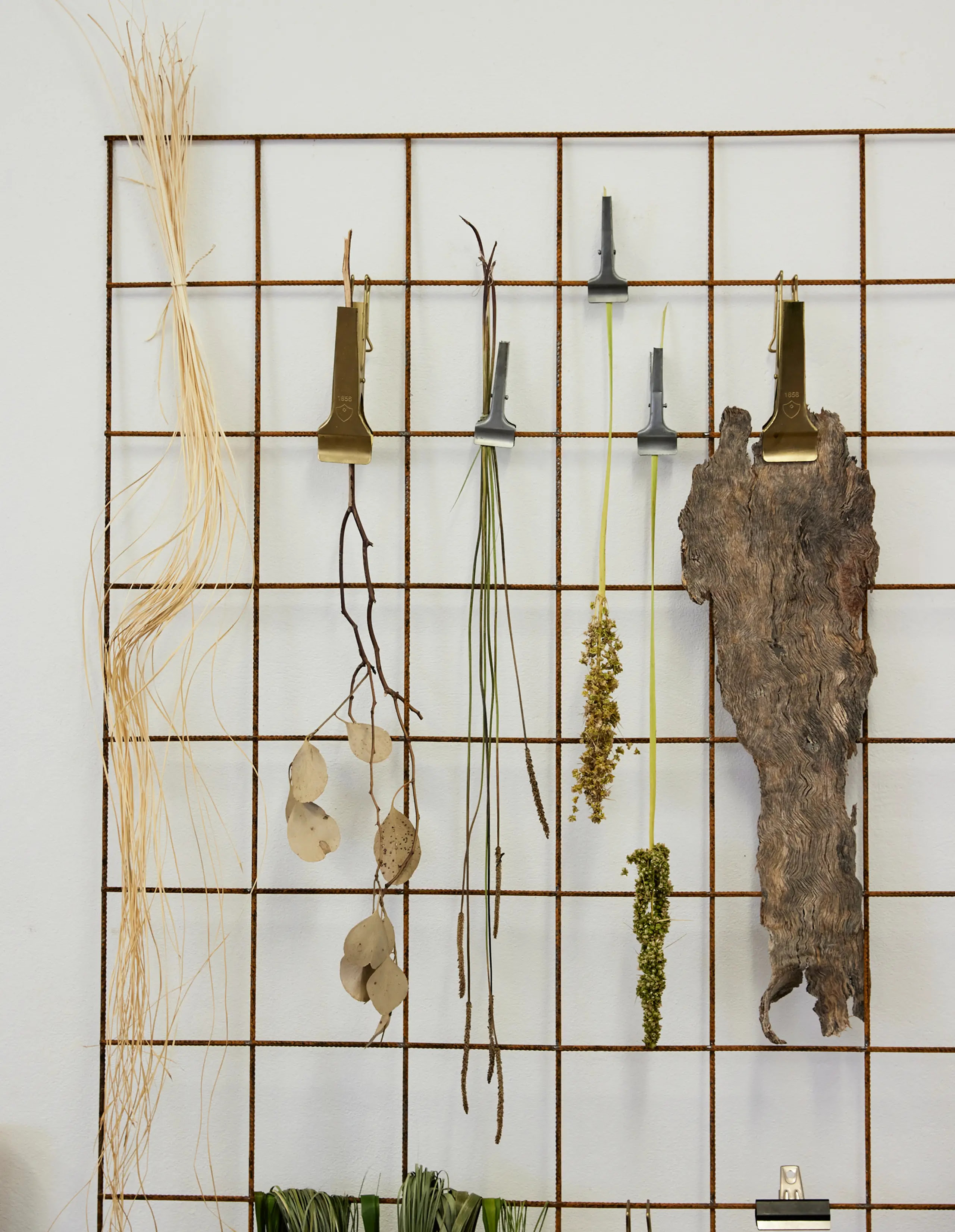
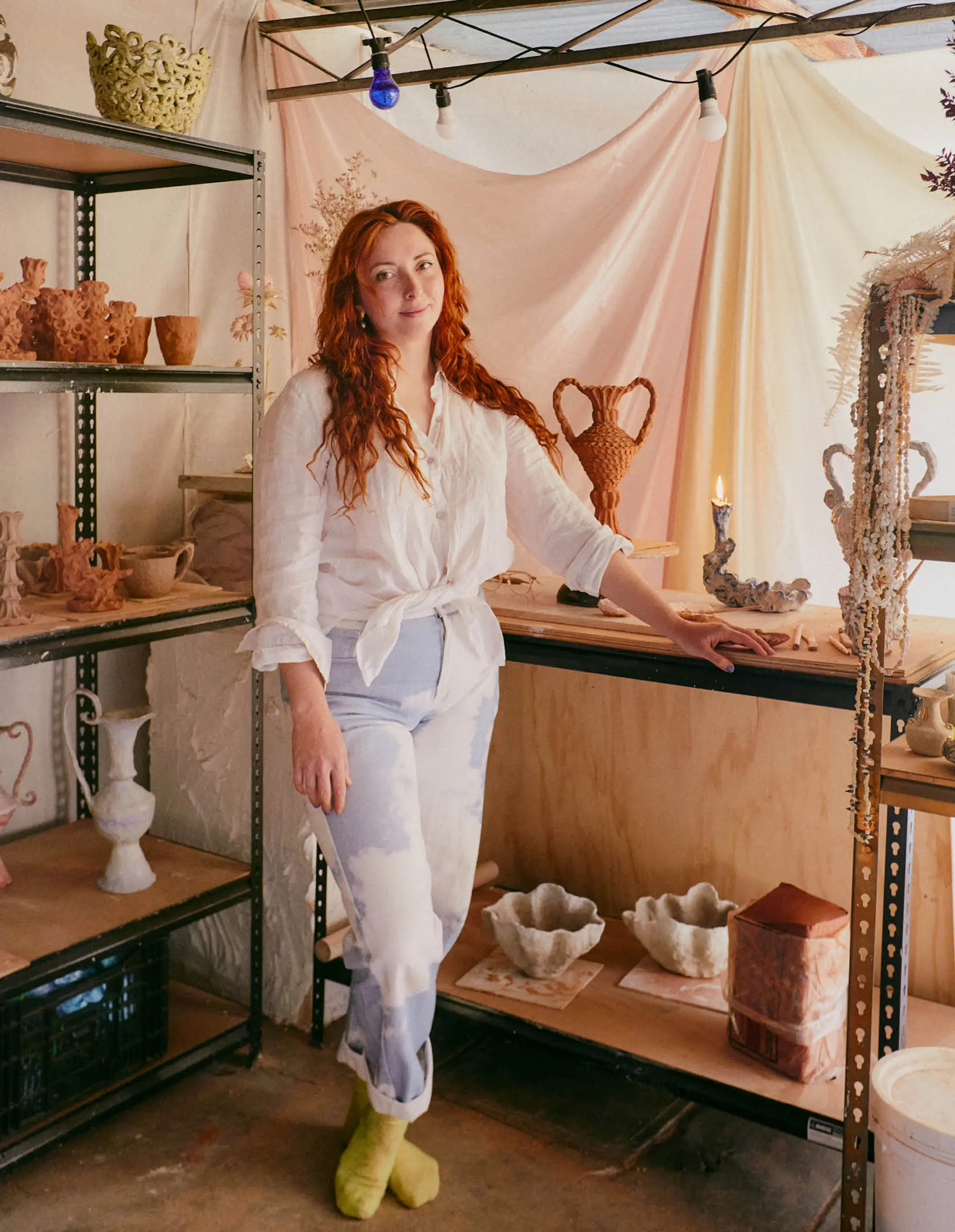

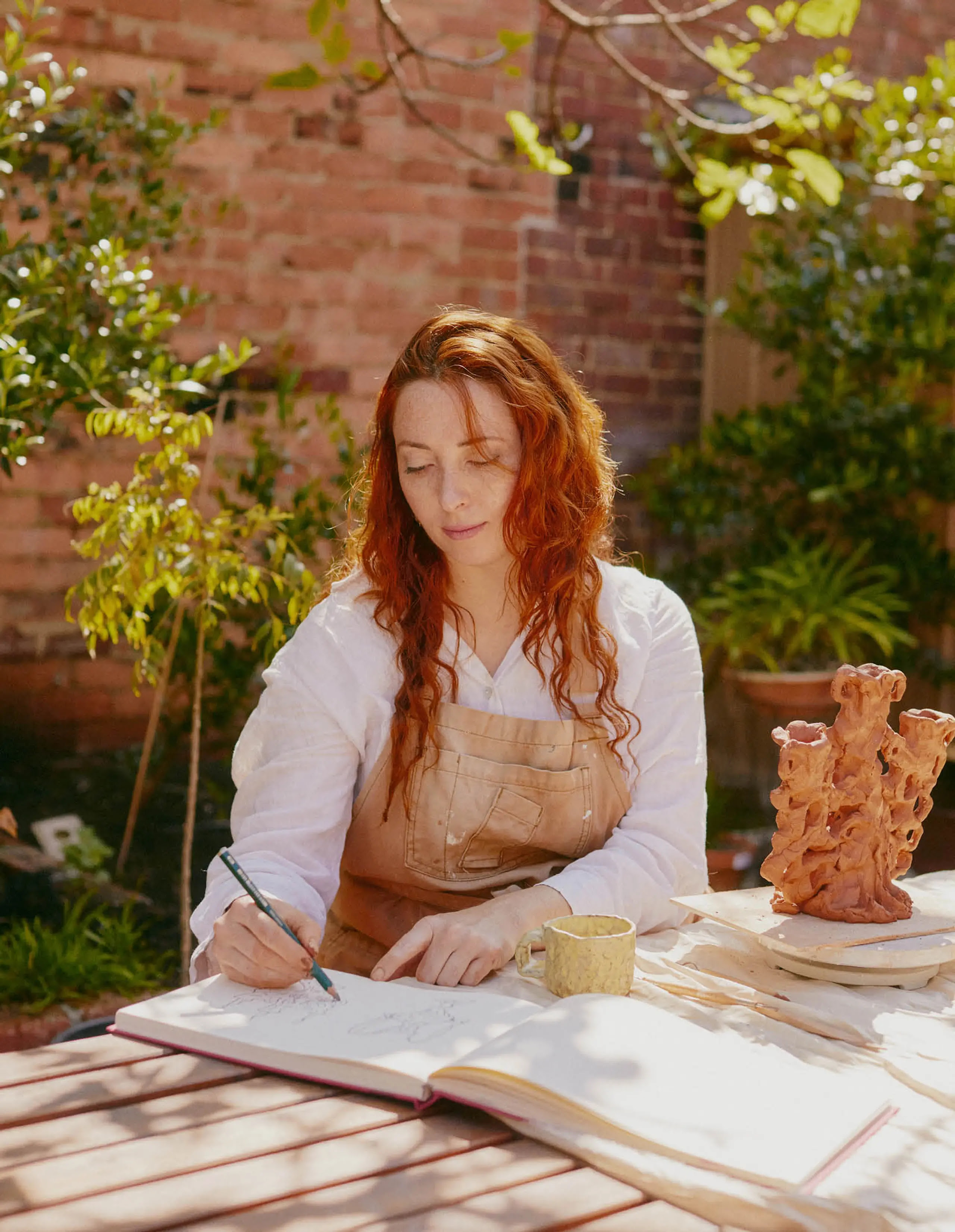
The Playful + Surreal Ceramics Practice of Hilary Green
Melbourne artist Hilary Green admits to not finding her true artistic calling until deep into her creative journey.
‘I had the technical skills to create art, but didn’t feel connected to what I created for a long time,’ she says. ‘…finding a creative community was the catalyst for finding more about myself, what I believe in and processing the world in a new way.’
She’s completed studies in Fine Art Photography and courses in wheel thrown ceramics, but it’s hand-building that has Hilary’s heart. From her garden shed-turned studio, she creates her whimsical pieces inspired by everything from seaweed, architecture and ironwork, to the charming illustrations of Sir Quentin Blake!
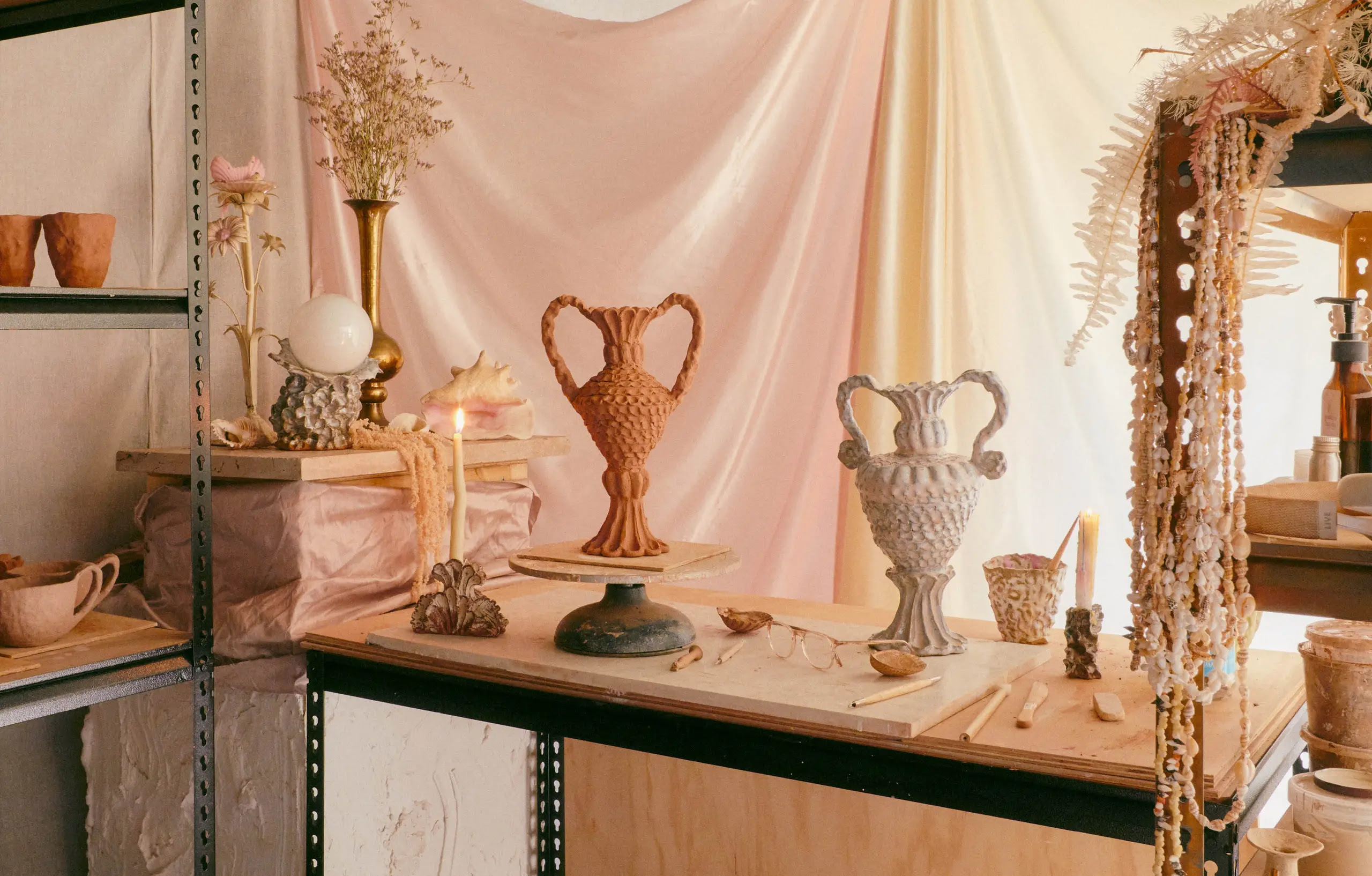
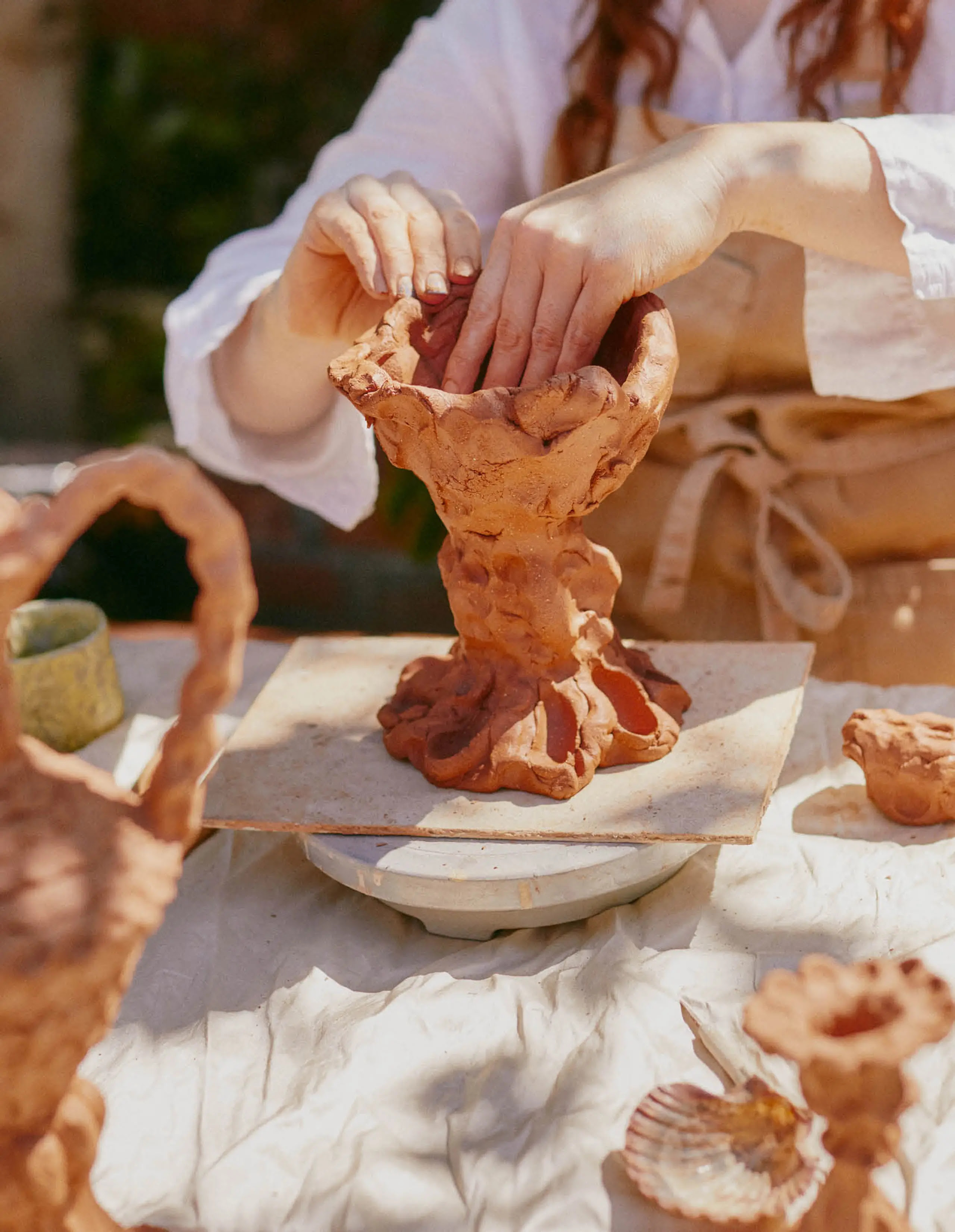

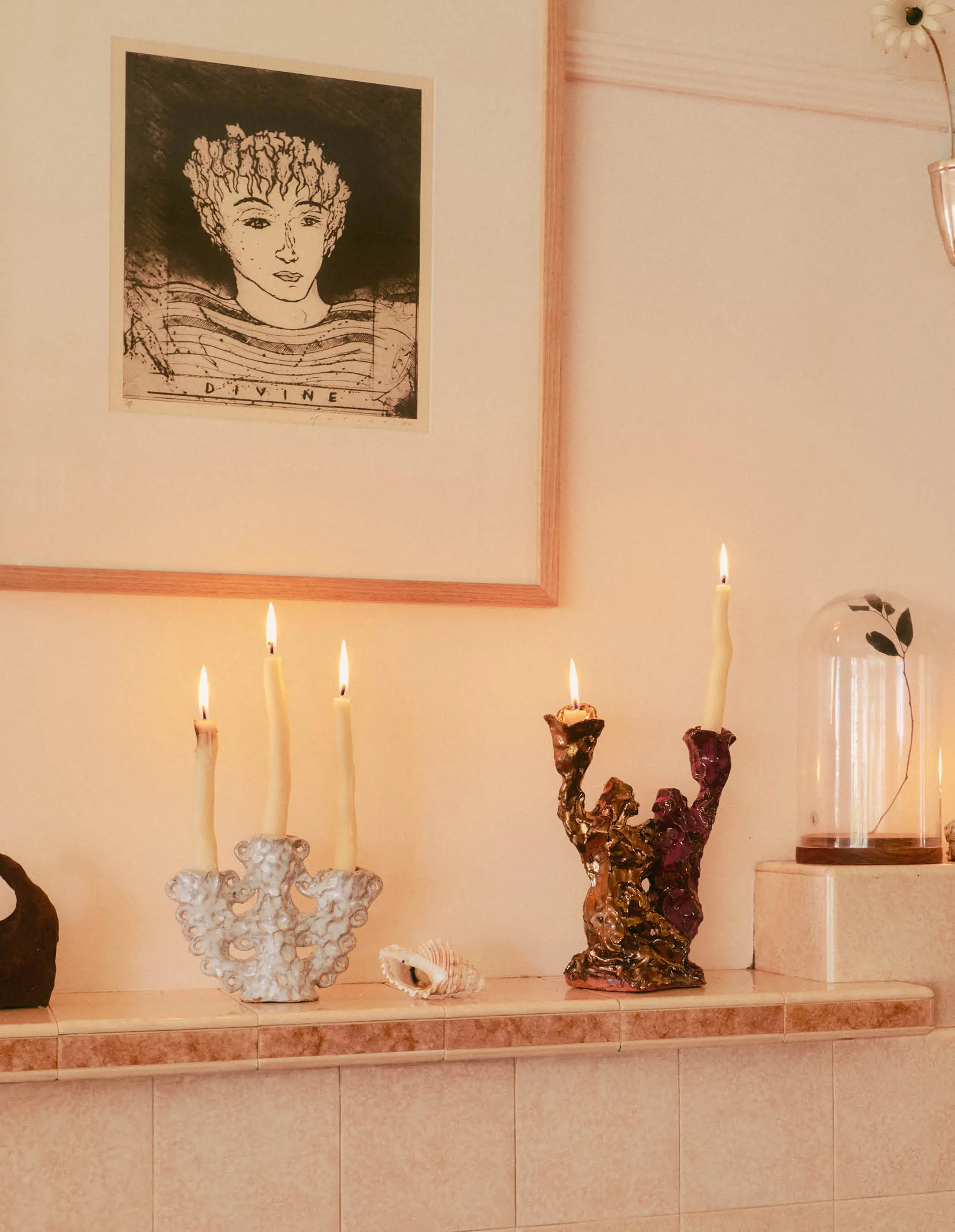
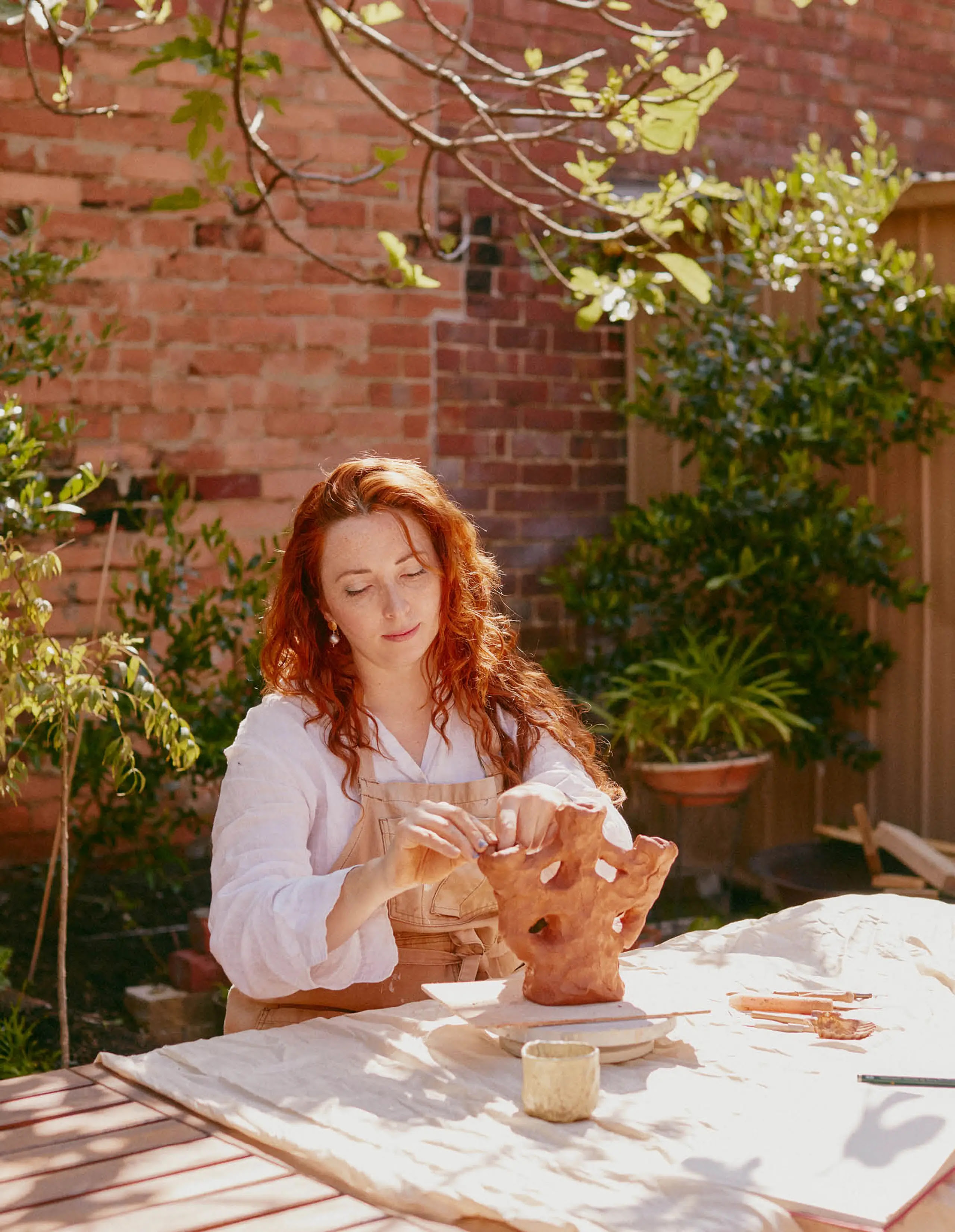
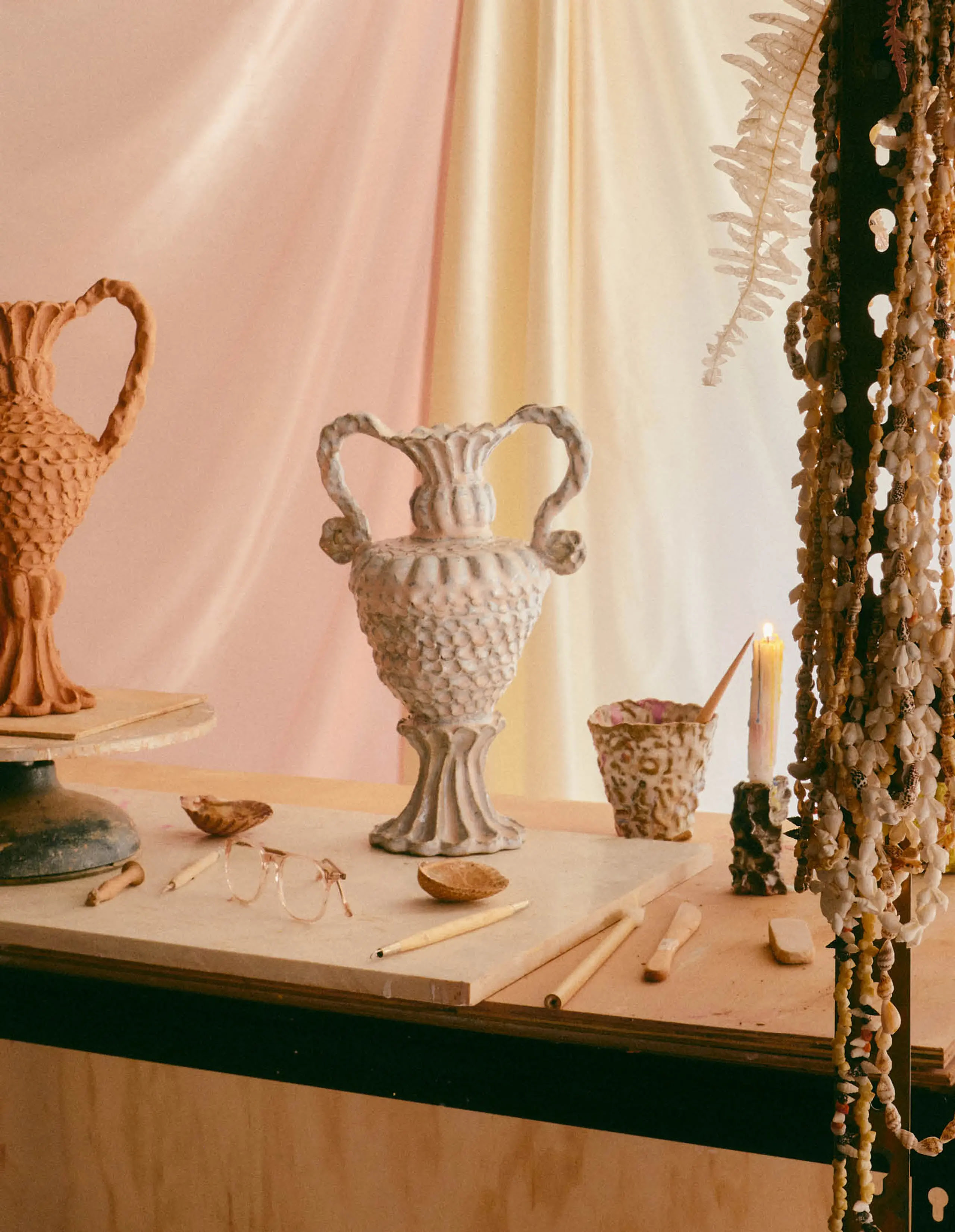
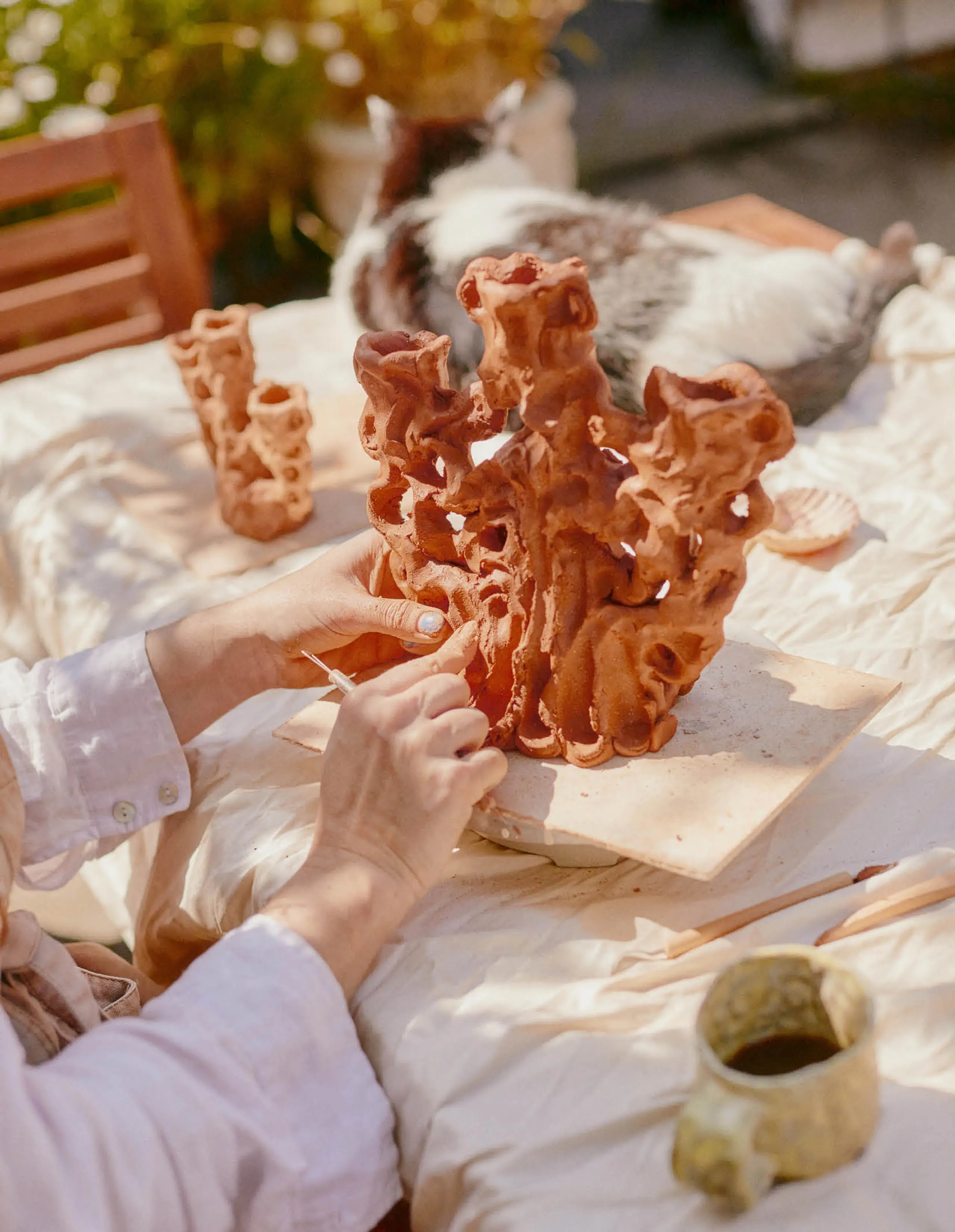
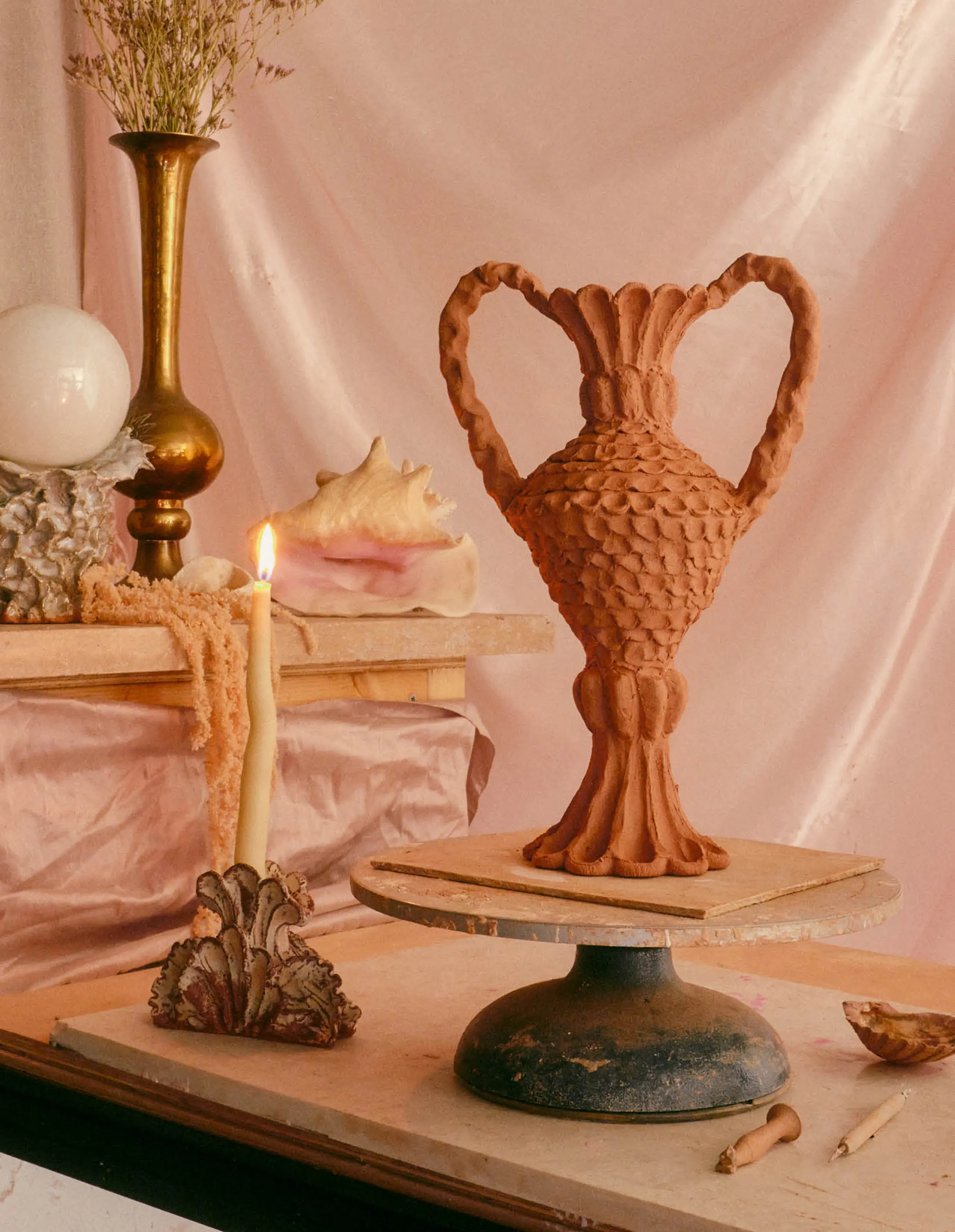
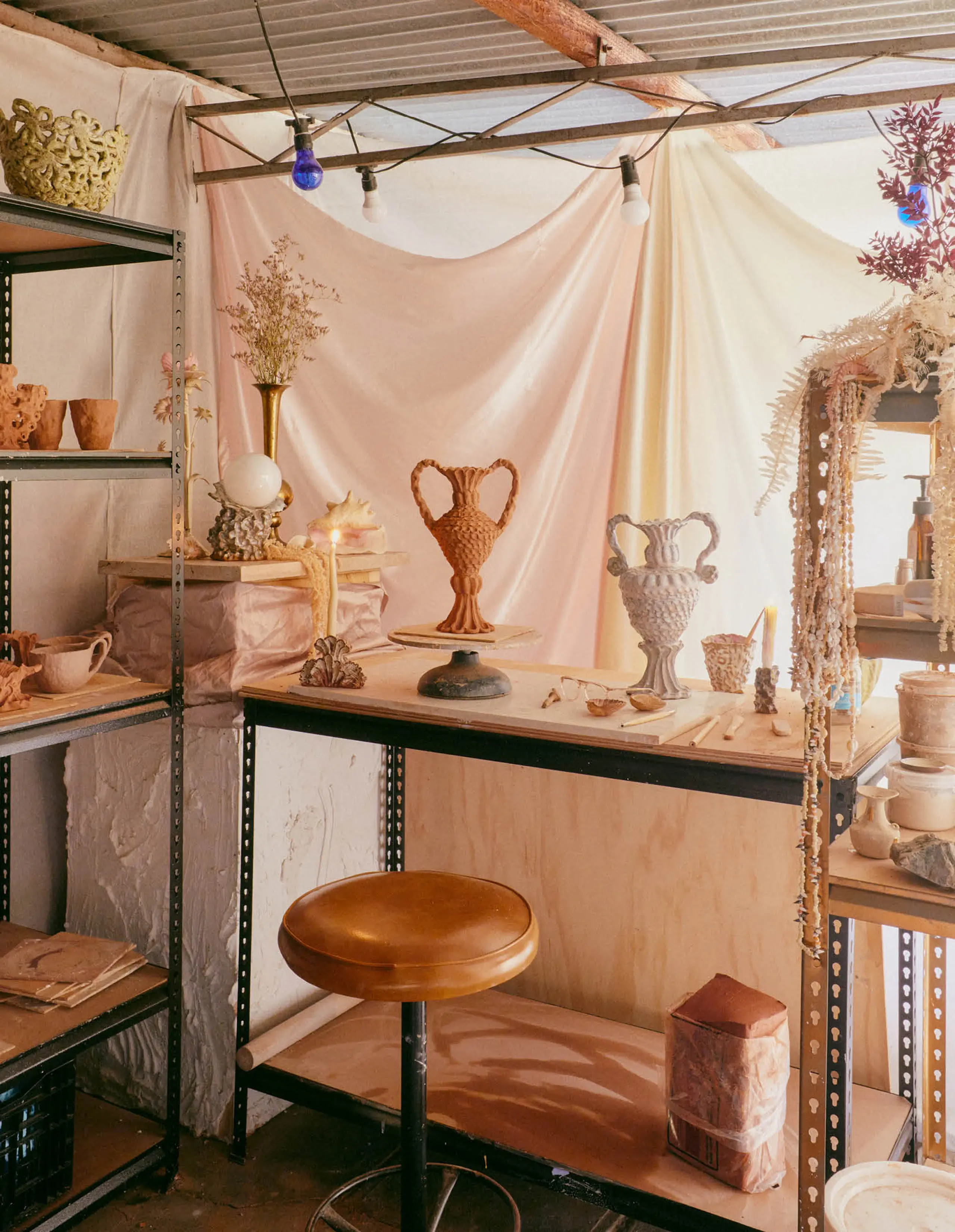
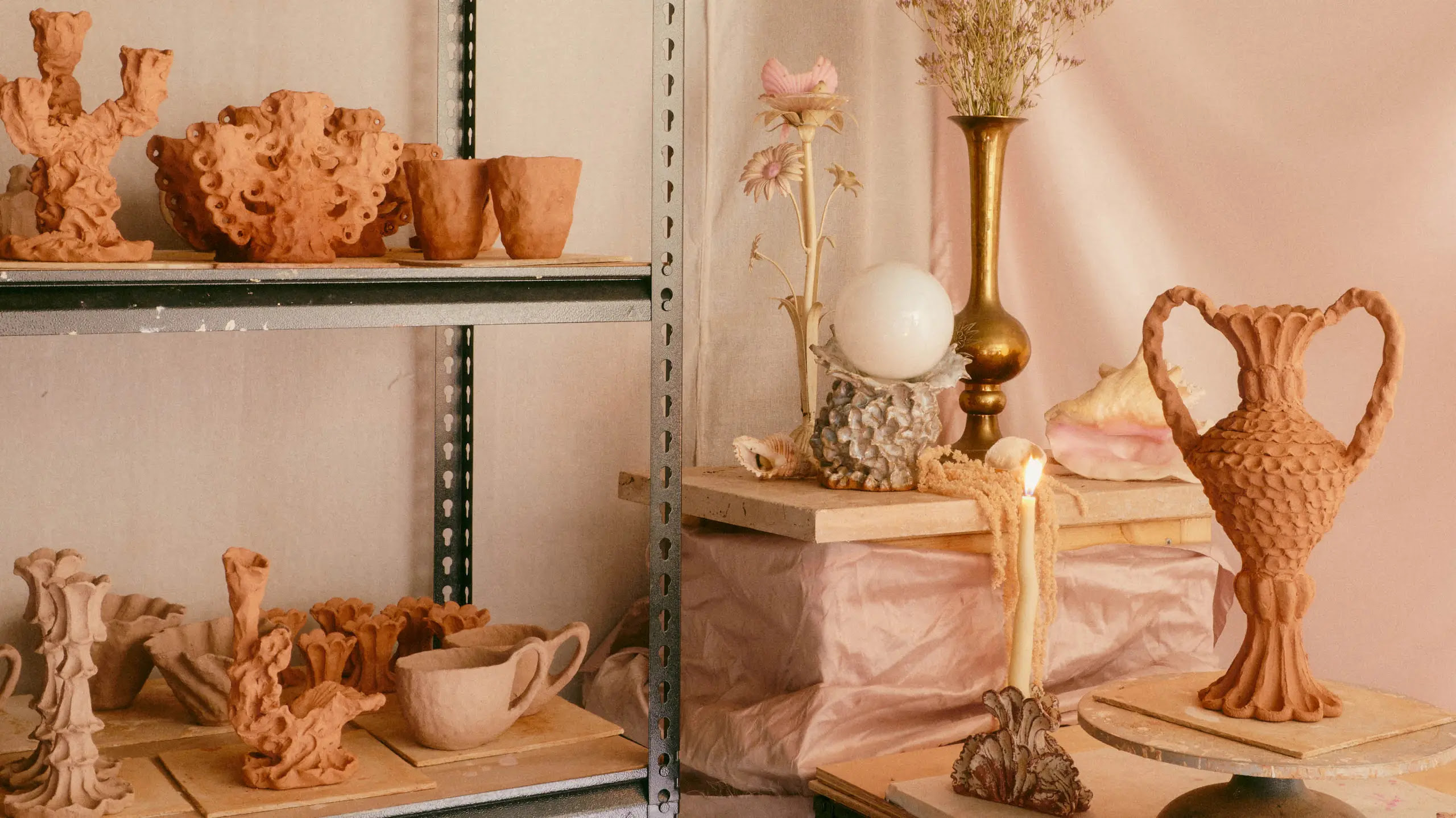
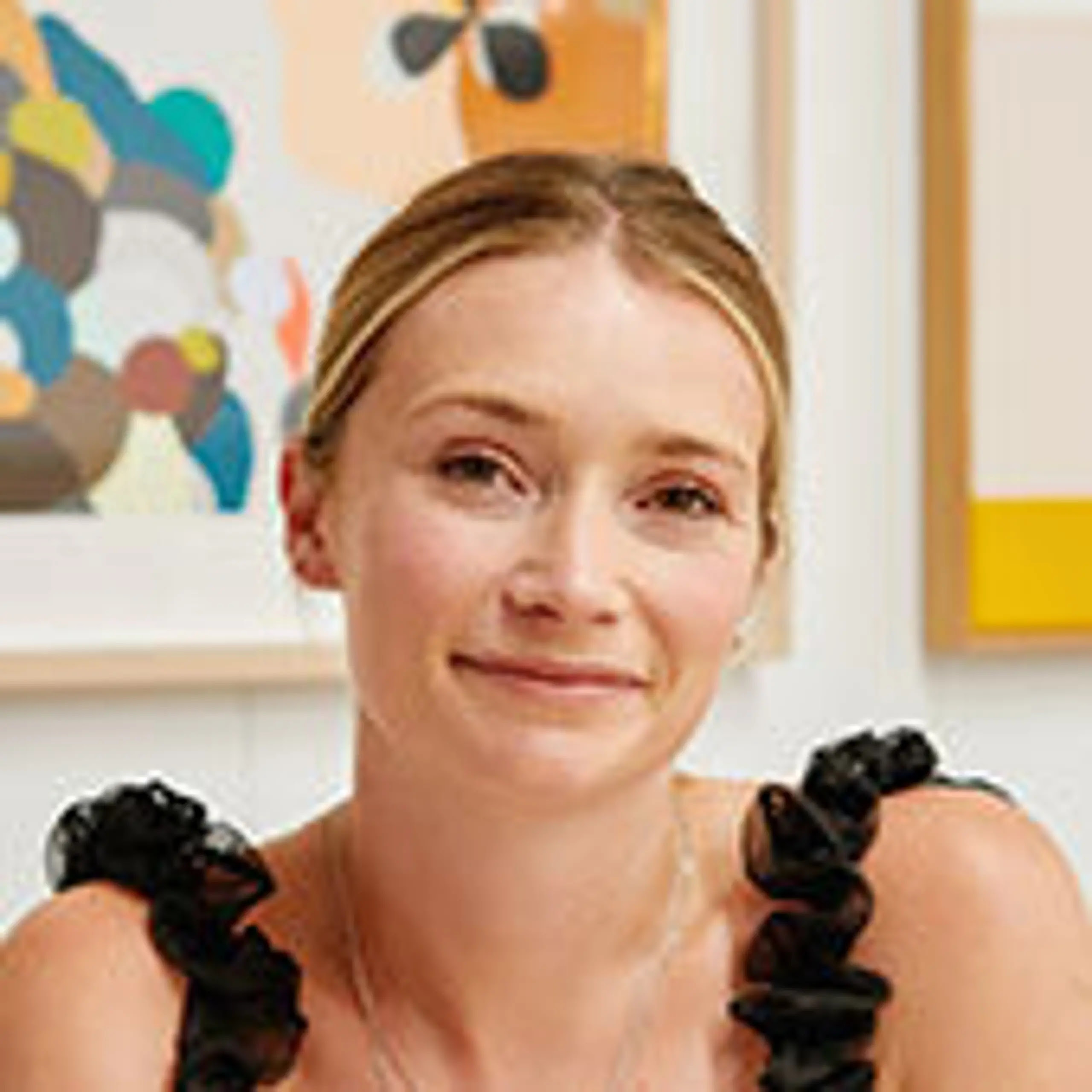
When asked why she prefers handbuilding over throwing clay, Hilary Green’s answer is simple; ‘The wheel makes everything too perfect, and my brain is not perfect, the world is not perfect. It is messy and complex, beautiful and surreal.’
In fact, ‘beautiful’ and ‘surreal’ are the perfect words to describe Hilary’s style, which is, in part, inspired by the work of illustrator Sir Quentin Blake (the artist known for bringing Roald Dahl’s beloved characters to life), as well as archaeology, architecture, seaweed, rocks, and ironwork.
‘I adored Quentin Blake’s illustrations as a child,’ explains Hilary. ‘And I still do. His economy of line, the movement, the joy and empathy that comes across in his work is perfection.’
Drawing has been something Hilary has always adored, but she didn’t start ceramics until 2016, after finishing her studies in Fine Art Photography.
‘I should’ve known I needed a more tactile medium when I used to skip the end of class to travel to my ceramics class,’ she says.
Hilary was working exclusively on the wheel until lockdown 2020, where, without access to one she started to experiment with hand-building, and in doing so stumbled across an art form that truly spoke to her.
‘It took me a while to realise that I was restricted by the wheel… I began making some large vessels and found that hand-building and mark making completed my drawing style. I guess it just takes time to find your soul medium,’ she says.
Now, Hilary works as a full-time artist, moulding and creating playful and organic sculptures with her hands. She’s developed a set of ‘practiced gestures’ she uses to achieve her signature marks and shapes, and sometimes spends up to two days working on her large coil vessels.
‘It’s like my hand does a dance when sculpting large pieces of clay,’ she explains.
Such work could not be created without a studio to match this creative energy. Hilary’s does not disappoint, with softly coloured silks draped on the walls, large shells and shell necklaces on display, and candles lit to ‘set the mood’.
‘It might be a shed, but it’s a magical shed at night time,’ she says.
How Ceramic Artist Lucy Tolan Became One Of Melbourne’s Favourite Creatives
Lucy Tolan’s beautifully handcrafted ceramics are instantly recognisable – and they’re constantly appearing on the carefully curated coffee tables, consoles and shelves in many of our home tours!


The local artist has created a signature style that’s completely her own, thanks to the intriguing ‘seams’, textures and bold colours of her one-of-a-kind vessels. And in just few short years, this distinctive ‘visual language’ has quickly made her of Melbourne’s most beloved creatives.










Lucy Tolan’s work is all about repetition. Behind each one of her beautiful ceramics is hours of work, as she creates piece by piece, hand-building layer upon layer. Sometimes, she even builds her vessels just to cut them apart again, and reassemble them in a unique new patchwork, with visible ‘seams’ and tactile imperfections.
It can take her up to three weeks to create just one piece. But her patience and originality is part of what makes her hand-crafted pieces so special – and distinctive.
‘The process is so important as it’s deeply fluid,’ Lucy says. ‘I don’t plan how a vessel will be realised but rather I’m guided by the repetitive rhythm of adding one tile at a time, the form unfolding with each layer.’
It’s no surprise that Lucy’s always been a creative (she still has the first ceramic cup and spoon set she made in prep!) and she’s been building her own ‘visual language’ even before completing her Bachelor of Fine Arts (Ceramics) in 2018. Since then, her work has featured in galleries like Modern Times and Craft Victoria, and has recently become a full-time occupation, shortly after starting work on her upcoming collection with Jardan earlier this year.
‘Now I have a studio space in Maribyrnong at Piecework Projects run by Sachiko Mardon and shared with Anni Hagberg and a number of casual members,’ Lucy adds. ‘It sits at the intersection of parklands and giant bluestone walls, which makes for a curious contrast – similar to some of my references and inspirations.’
Lucy eloquently describes her style as ‘occupying the space where contradicting characteristics meet’. This extends to her differing inspirations, ranging from architecture to textiles, and her use of opposing hues like bold blues against romantic reds.
There’s also an amazing combination of ‘soft and hard’ textures in Lucy’s pieces. Moulds made from textured objects give her work a delicate, paper-like quality, while other dents are the result of Lucy tapping rocks into her creations once they’ve dried firm.
‘Throughout my studies and practice I’ve collected elements that I feel so drawn to, whether it be colour, texture or form and begun combining them with one another,’ she explains. ‘It’s been a process of following my preferences and intuition to create objects that I love. It’s so gratifying to know others love them too, and I’m so delighted to share my visual language with the world.’
Her plan for the summer is to experiment with different materials and large-scale objects, re-imagining the signature style we’ve come to know and love in new ways. We can’t wait to see what she does next!
Miranda Hine’s Alluring Paintings Of English House Museums

The joy of creating underpins Miranda Hine’s oil paintings depicting quiet interior and still life scenes.
Her new exhibition, Making Beds opening at MARS Gallery this Thursday, offers glimpses into English historic house museums — a world Miranda is deeply familiar with as an interpretation developer at London’s Natural History Museum.
Slightly translucent, legible brushstrokes bring a softness to a typically sombre palette, which Miranda manipulates to provoke discussions around these ‘highly personal yet absurdly public spaces.’












Miranda Hine initially studied a Bachelor of Fine Arts before moving into museum creation.
These worlds combined have inspired her new exhibition, Making Beds, which depicts intimate slivers inside English historic house museums.
Just as these scenes have been highly orchestrated to suit a public museum, Miranda deliberately composes and manipulates each setting, asking the viewer to consider what is valued.
Miranda is originally from Brisbane — an outsider viewpoint that is captured in these paintings created where she’s currently based in London.
‘While here I’ve become acutely aware of being Australian. It’s not something that people here necessarily care about, but I’ve come to appreciate just how much that context has shaped my ways of seeing,’ she says.
‘To be showing this series of works – that was painted in London and features views from London historic house museums – in Australia, feels fitting.’
The house museums portrayed include Dennis Severs’ House, Freud Museum, Leighton House, Sir John Soane’s Museum, and Charles Dickens Museum.
Miranda has developed her artistic style by ‘trying lots of different things and having lots of failures’ to arrive at a process she deeply enjoys and is constantly surprised by.
‘To me, the process is really important. It’s the fun bit,’ she explains. ‘I never know how a work will turn out when I begin.’
Her works are created using oil paints on gessoed hardboard — a base specifically selected for its ‘slipperiness’ and absorbency. Thinner is added to fluidify the paint, creating the soft, legible and slightly transparent brush strokes that characterise Miranda’s work.
‘There’s lots of pushing the paint around and wiping it back to create a sense of form and light. I love how ambiguous you can be in creating images this way,’ Miranda says.
‘I take my glasses off when I paint and my eyesight is really poor, so that stops me focusing on the detail and more on light, value, shape and colour instead.’
The work is complete when Miranda is happy with the outcome, whether that takes an hour, or several weeks spent refining.
See ‘Making Beds’ by Miranda Hine at MARS Gallery from Thursday May 9 – Saturday June 1.
The Environmentally Regenerative Ceramics Studio Of Casa Adams
Casa Adams is a ceramics practice founded by Araceli Robledo Adams that aims to spark curiosity and protect nature — an ethos that extends to the studio’s physical workspace.
https://thedesignfiles.net/2024/04/studio-visit-casa-adams
Located in the backyard of Araceli’s inner-west Sydney family home, the studio was recently designed by Alexander Symes Architect to streamline the business’ operations from an environmentally-conscious space.
Drawing on lessons learned from designing Pepper Tree Passive House, Alexander has created an all-electric ceramics studio that produces enough onsite solar energy to power 85 per cent of its operations, including the kilns.
Both the studio and main house embrace the garden and pond designed by landscape architect Jason Monaghan to support vulnerable endemic frog, bird and insect species that inspire Araceli’s practice.
Celebrating and enriching biodiversity underpins every element of ceramics studio Casa Adams.
Founded by Araceli Robledo Adams, the studio produces handmade ceramics depicting intriguing sea life from a backyard studio designed by Alexander Symes Architect to help ensure the future of vulnerable species.
Through her work, Araceli sets out to astound customers and masterclass students with stories from the seas — from the incredible biodiversity found underwater, to the people who make it their life’s work to study their existence.
‘The mission of Casa Adams is to wow the world with the awesomeness of nature, hoping to spark curiosity that will lead to conservation efforts,’ says Araceli.
More than five per cent of earnings are donated to environmental and social causes, and Araceli invites experts such as marine biologists and ecologists to co-host monthly art and natural history workshops.
The foundations of Casa Adams began at Araceli’s former apartment kitchen bench following the birth of her first child and a 15-year marketing career.
As the studio flourished, Araceli and her family moved to a house in Dulwich Hill with enough space for a purpose-built backyard studio.
They engaged Alexander Symes Architect with a brief to design a small footprint studio across two storeys, enabling the ‘messy stuff’ to happen on the ground floor (making, glazing and packing), and the ‘clean stuff’ upstairs (painting, designing and admin).
Alexander Symes Architect designed the studio to have the most minimal impact possible. Drawing inspiration from his previous Pepper Tree Passive House project, the studio is clad in shou sugi ban, with the addition of recycled blackbutt windows, exposed laminated veneer lumber, perforated aluminium. ‘The fit-out is made from off-cuts and found objects from the side of the road,’ says Alexander.
The Casa Adams studio is 100 per cent electric and produces enough solar energy to power 85 per cent of its operations, including two energy intensive kilns.
The garden designed by landscape architect Jason Monaghan is an equally important element of the studio for enhancing nature and promoting wildlife.
‘We wanted to bring in the native insects, birds and other critters, and also to have plenty of space and functionality for our own food production. The landscape perfectly marries the two,’ says Araceli.
Existing veggie gardens were retained, and Jason designed new spaces for compost, chickens and bees.
Araceli’s favourite landscape feature is the pond that serves as a rainwater catchment and encourages wildlife to flock to the site.
‘It’s filled with leftover sandstone and native lilies and fish, snails, dragonfly larvae and countless other wonders,’ Araceli says.
‘The rest [of the garden] is planted with plenty of natives, particularly spiky and unusual local species that protect small birds from the local outdoor cats that roam by. Many of these plants need a few years to mature, but already the insects, dragonflies, butterflies, native bees, lizards and frogs are heaving in the yard.’
Araceli describes the new studio as a joy to work in that allows more efficient production of her wares, which each take up to two weeks to produce. Each ceramic collection work starts as a series of illustrations highlighting a particular ecosystem or species. These artworks are grounded in research and are often inspired by old natural history books containing hand-coloured etchings.
The Casa Adams studio is now a vehicle for education as much as it is a place of work. The tiled coconut crab mural on entry reminds visitors of the many magnificent and vulnerable species that inspire Araceli and are at risk of being overharvested by humans.
It is these conversations that Araceli hopes her work sparks and ultimately supports.
‘The best part of it all is when I really inspire people’s curiosity about nature. That is proof that I’m making a difference and fulfilling the mission of Casa Adams.’











